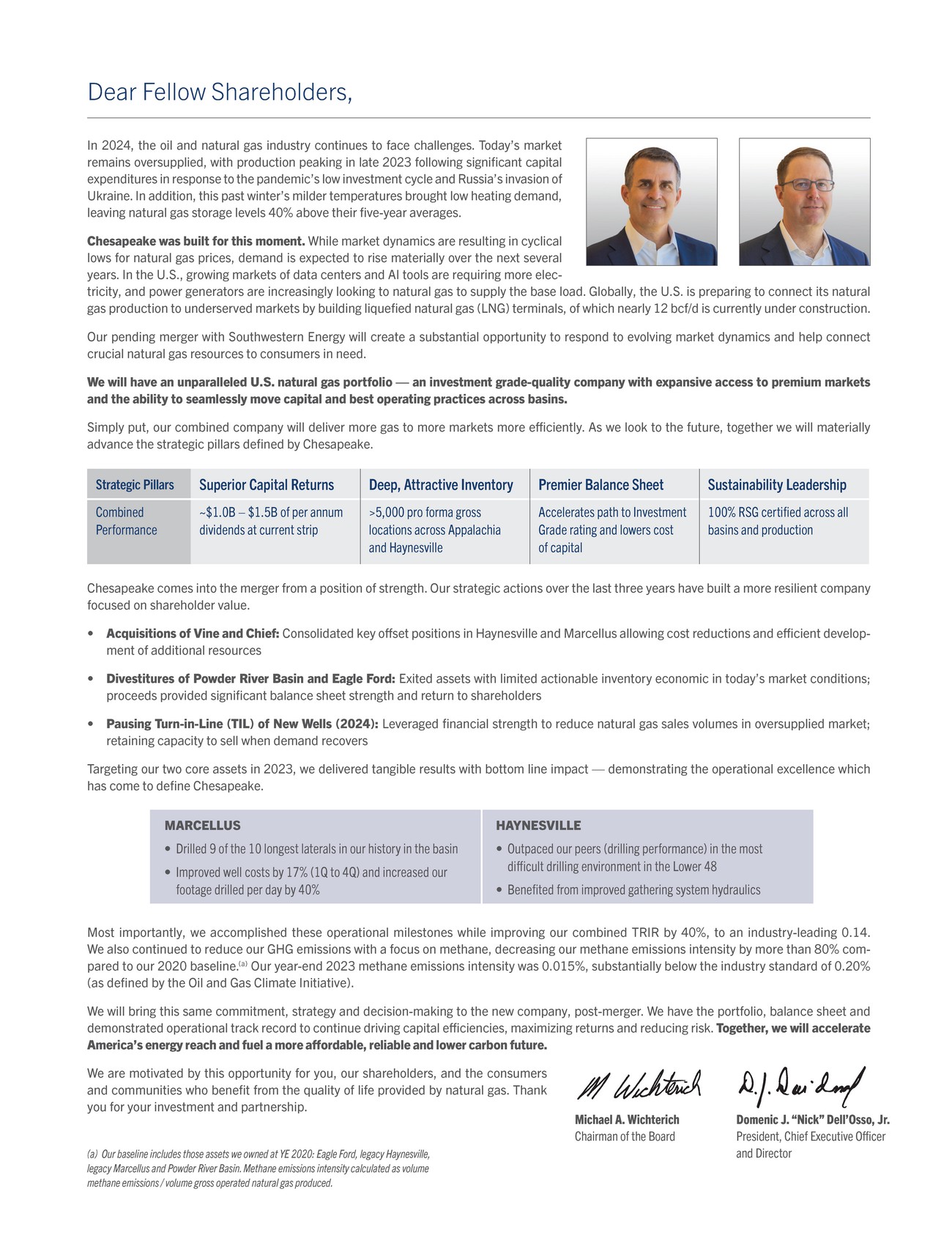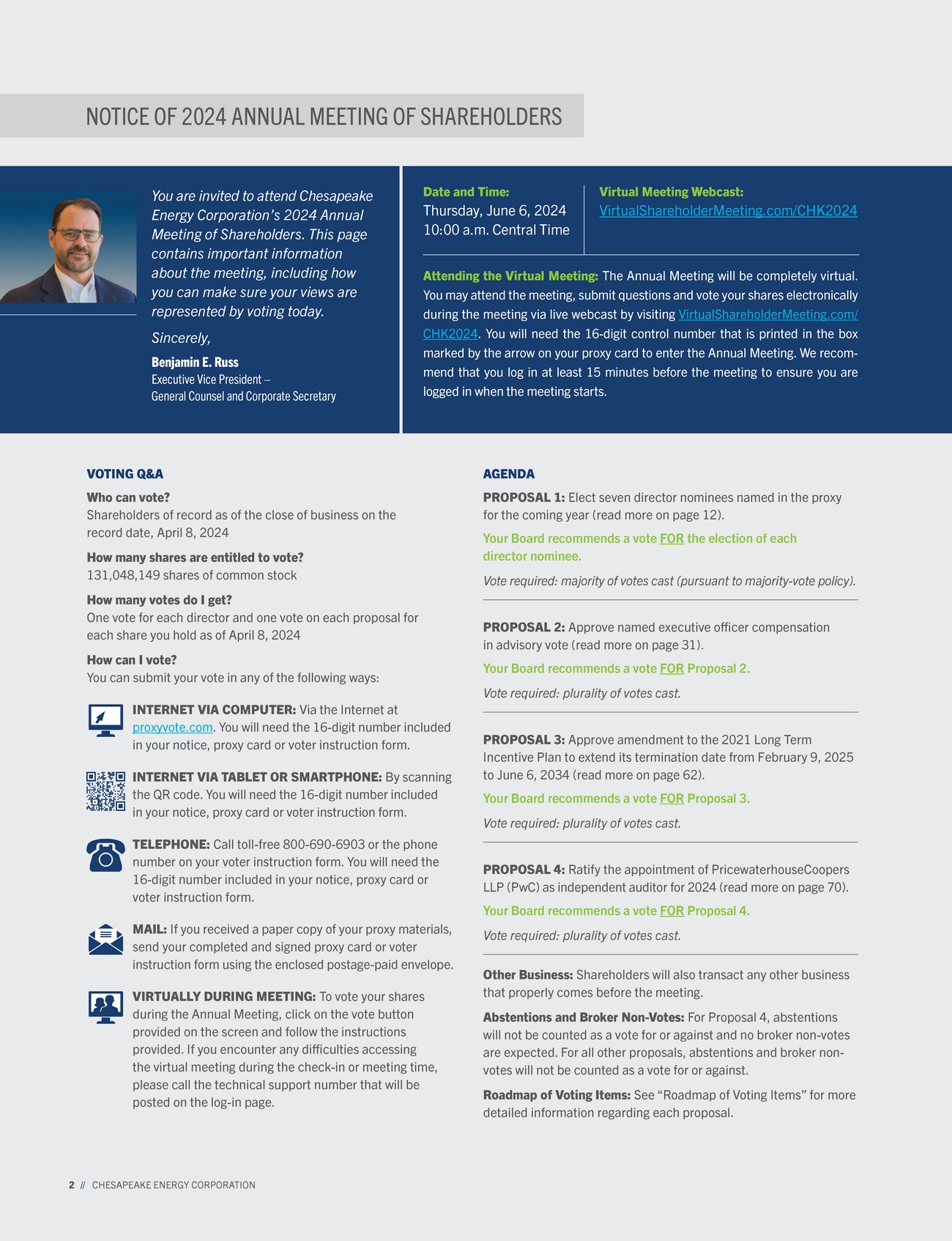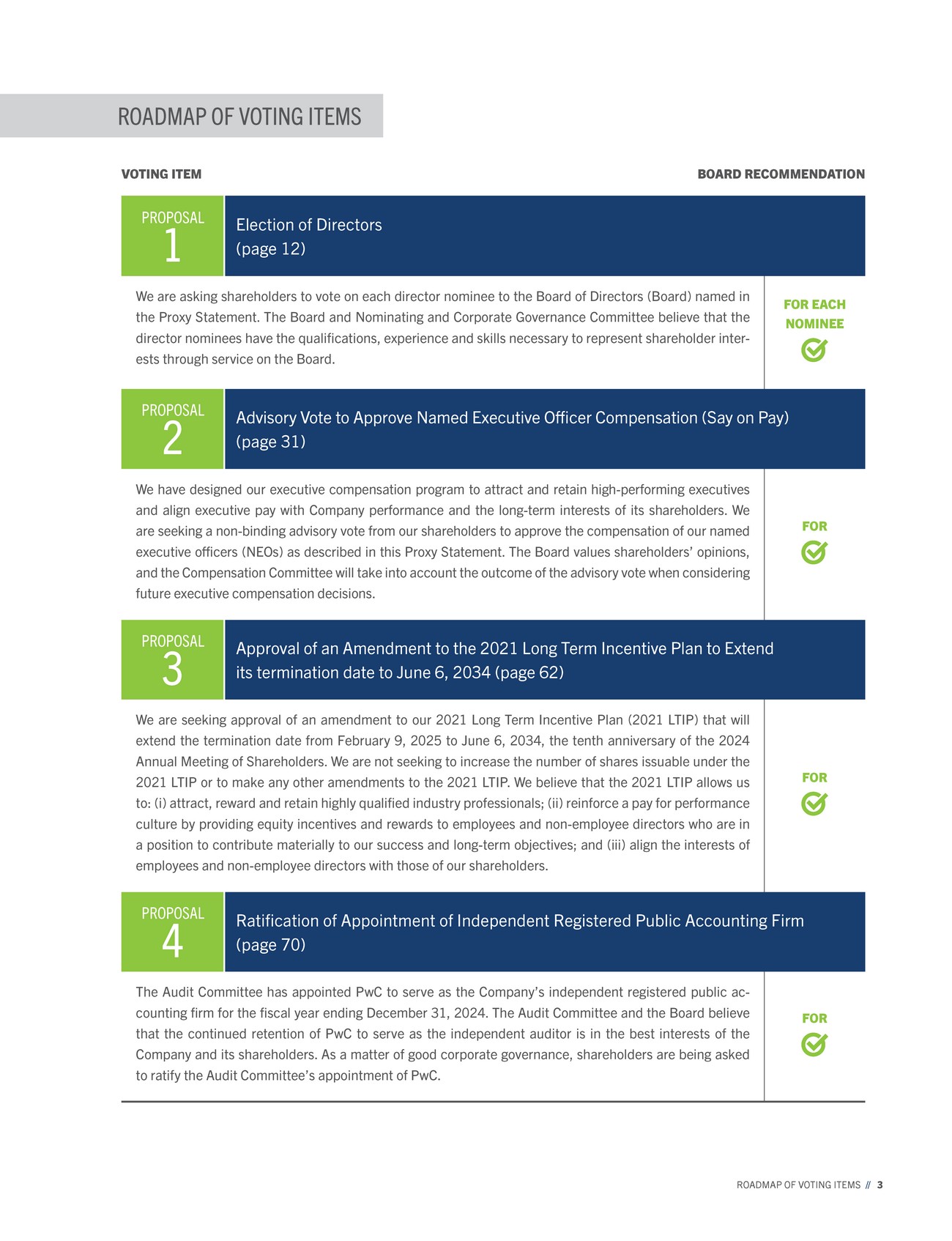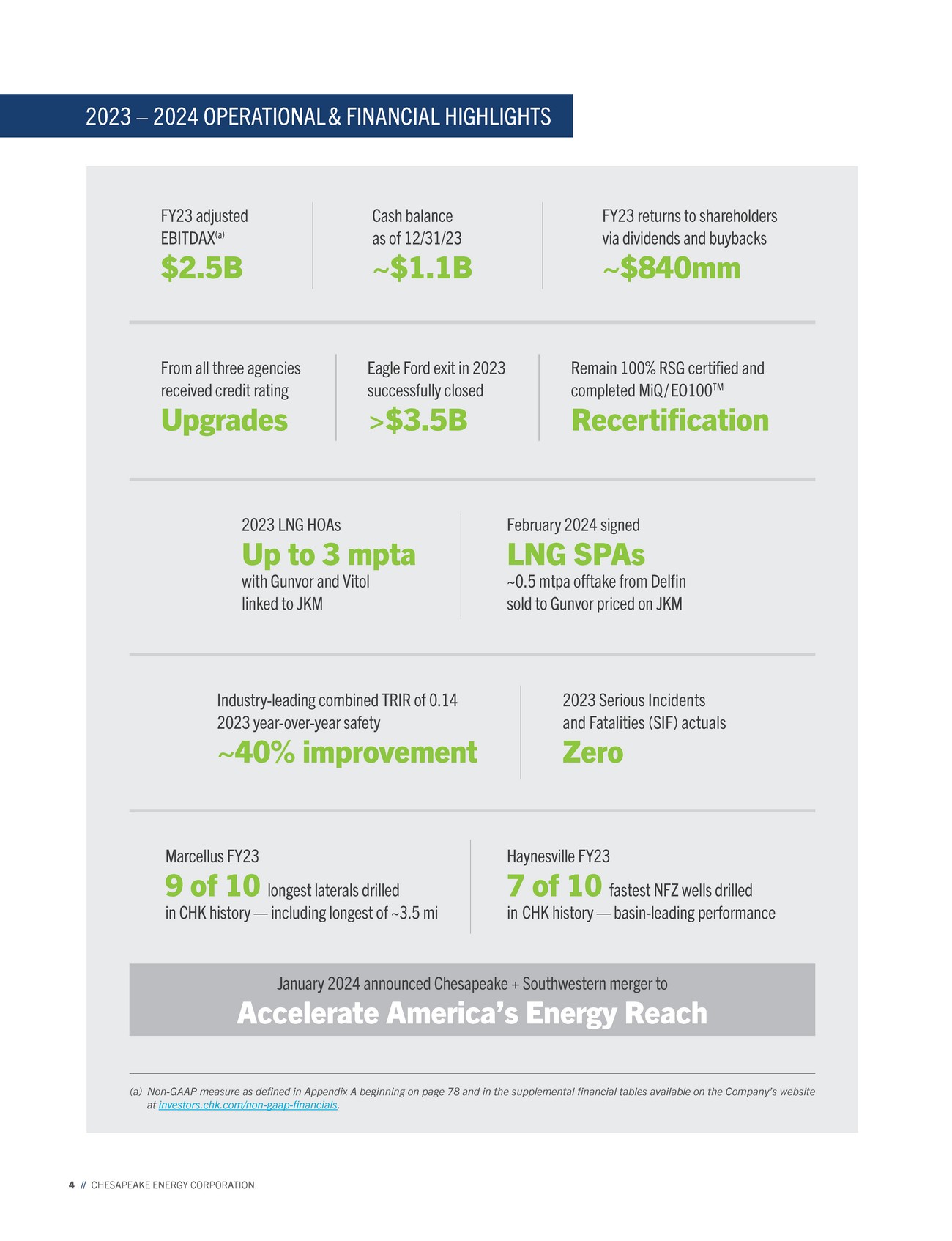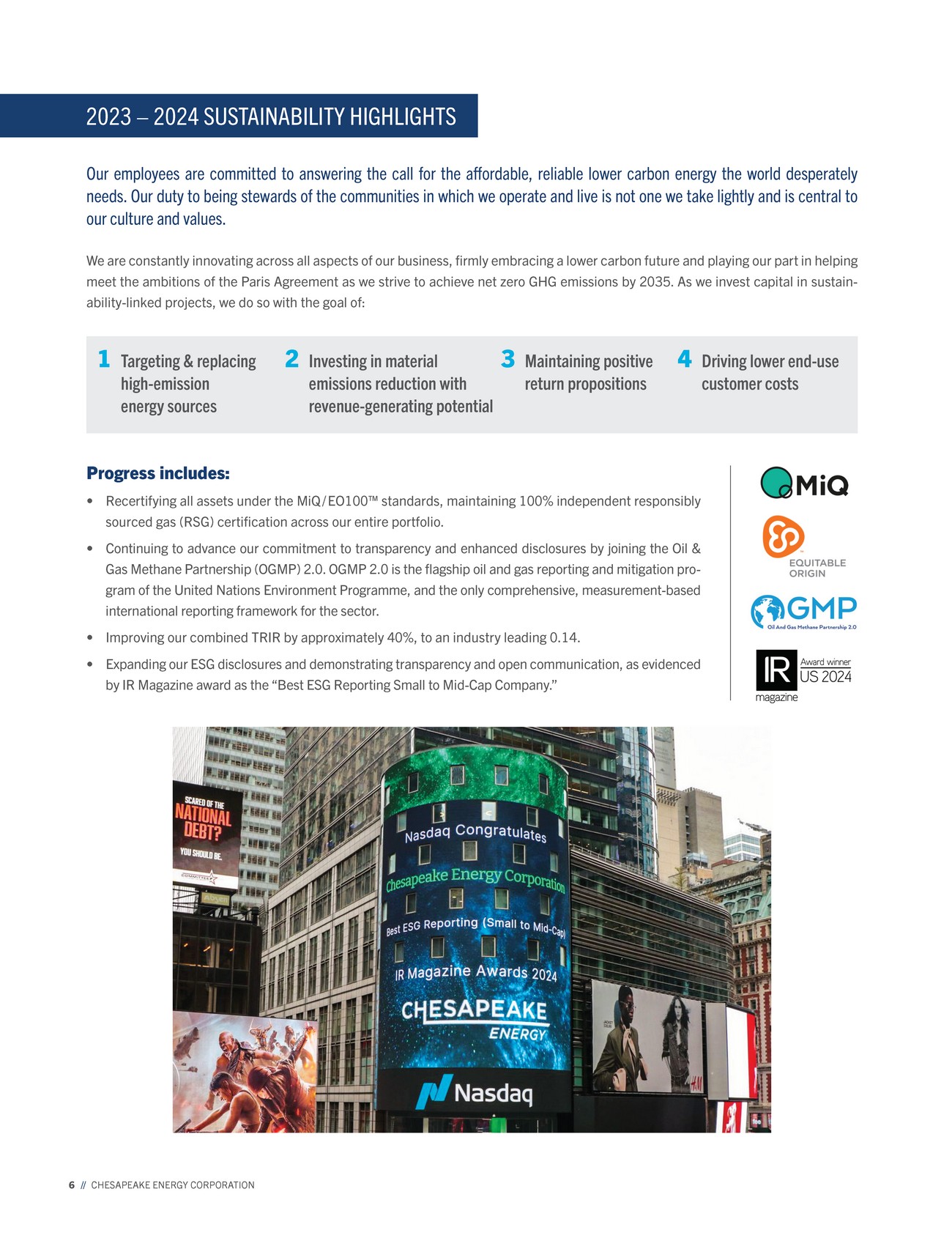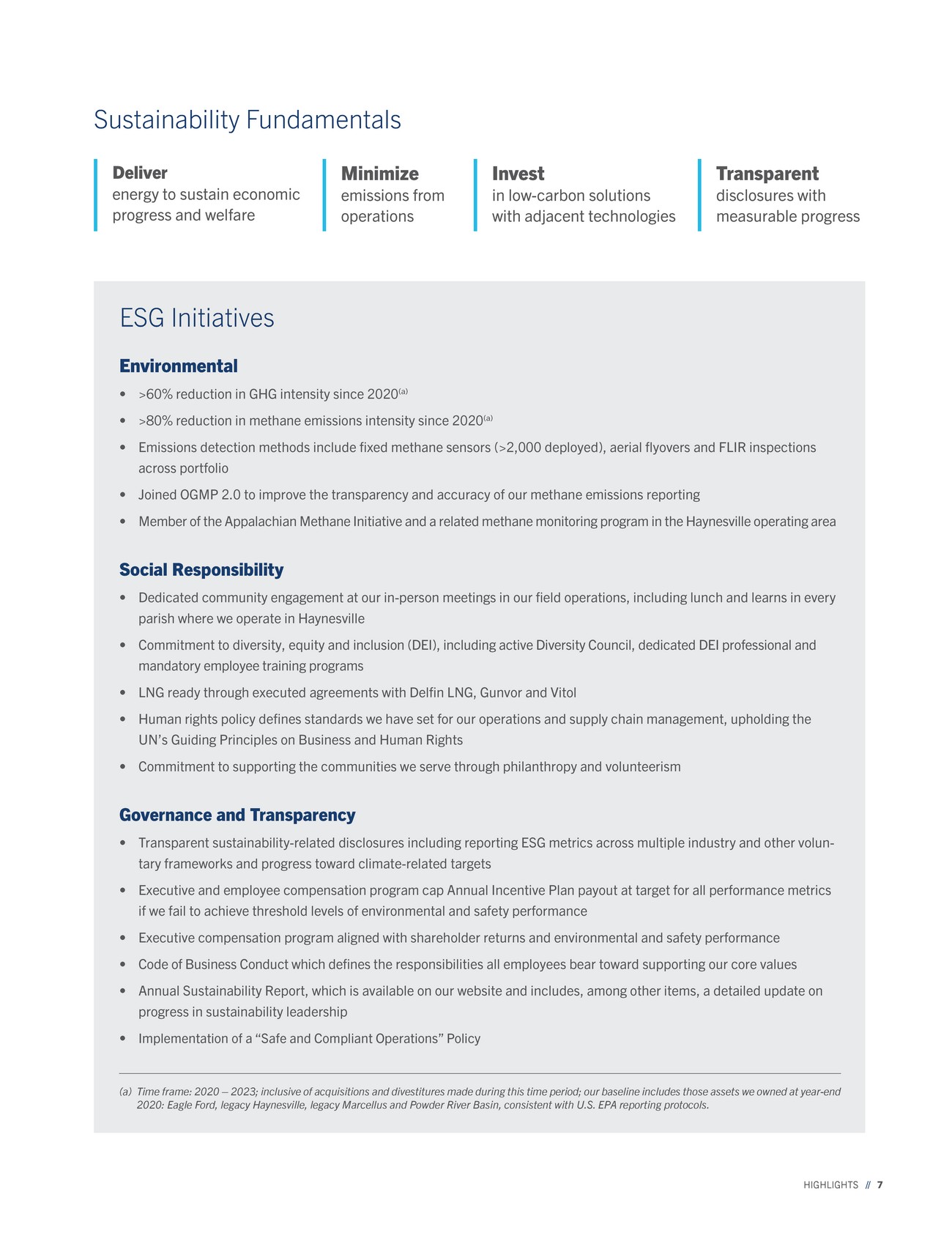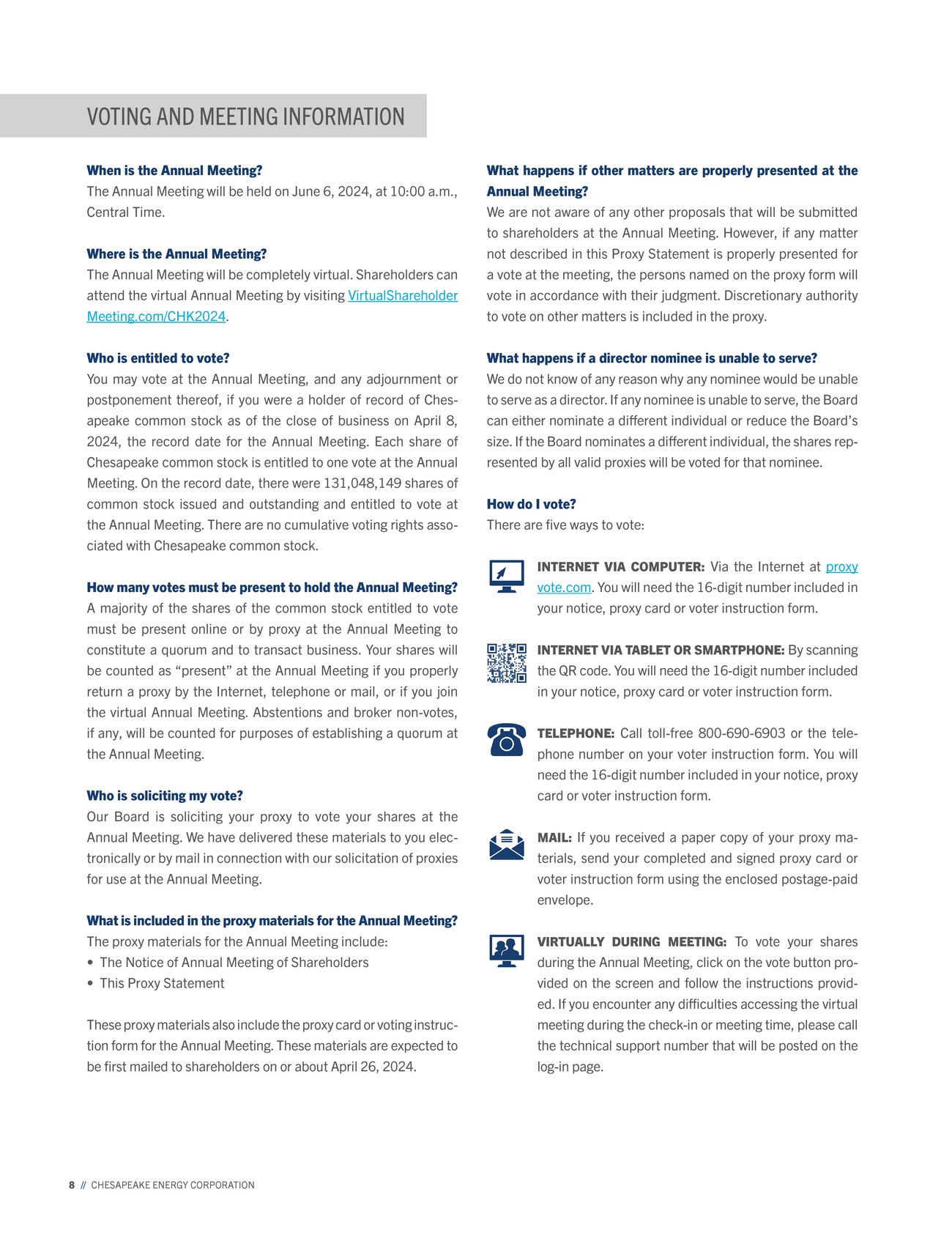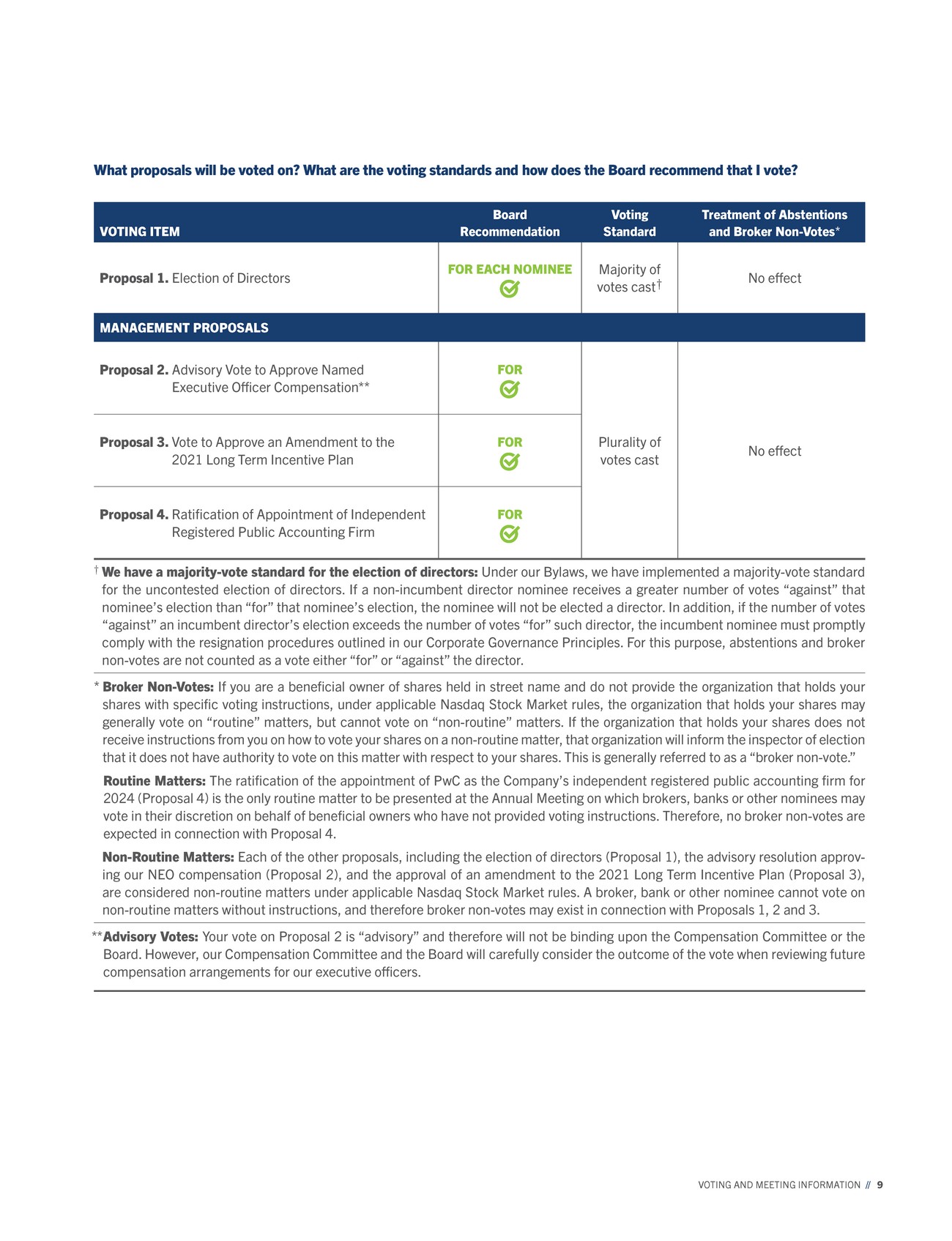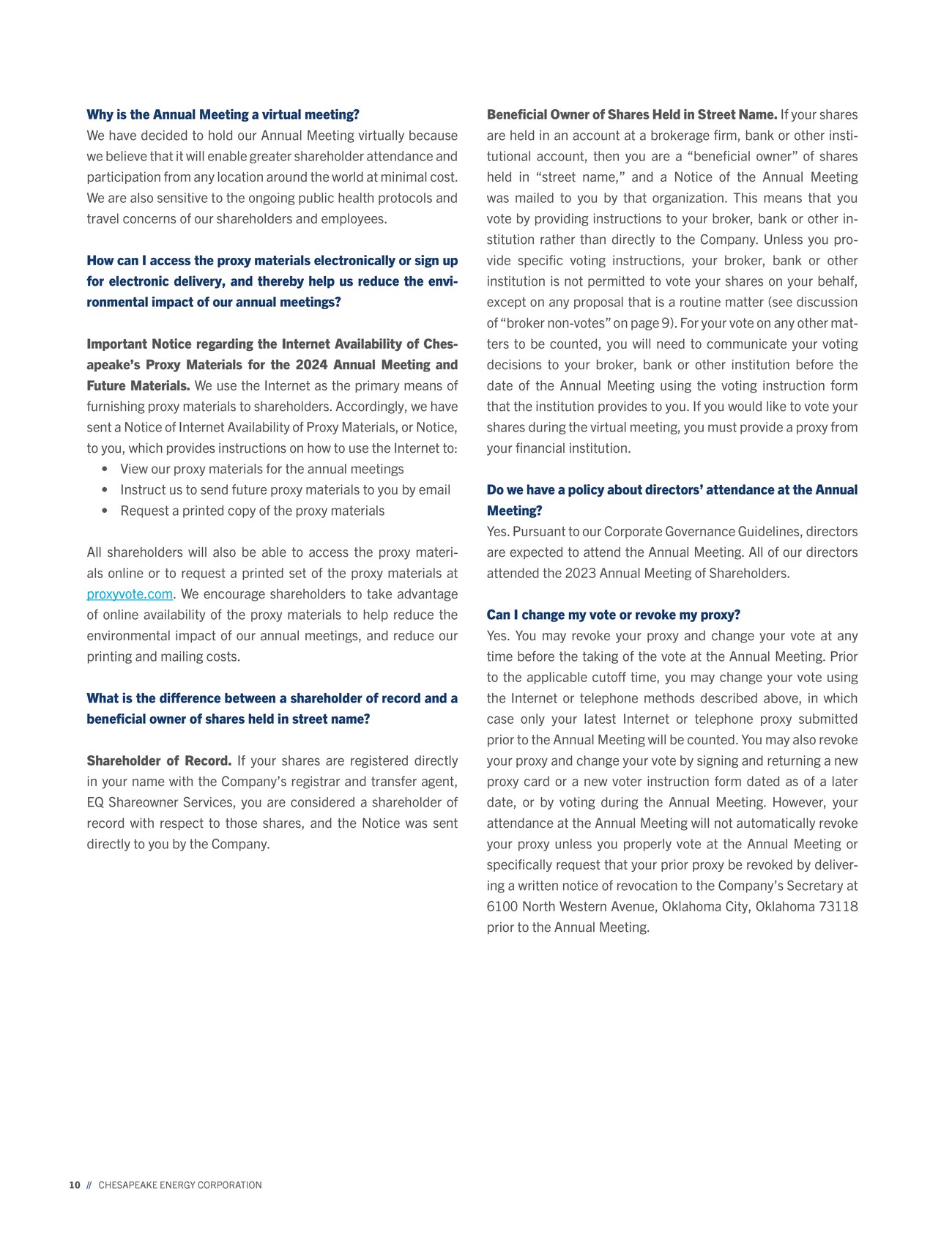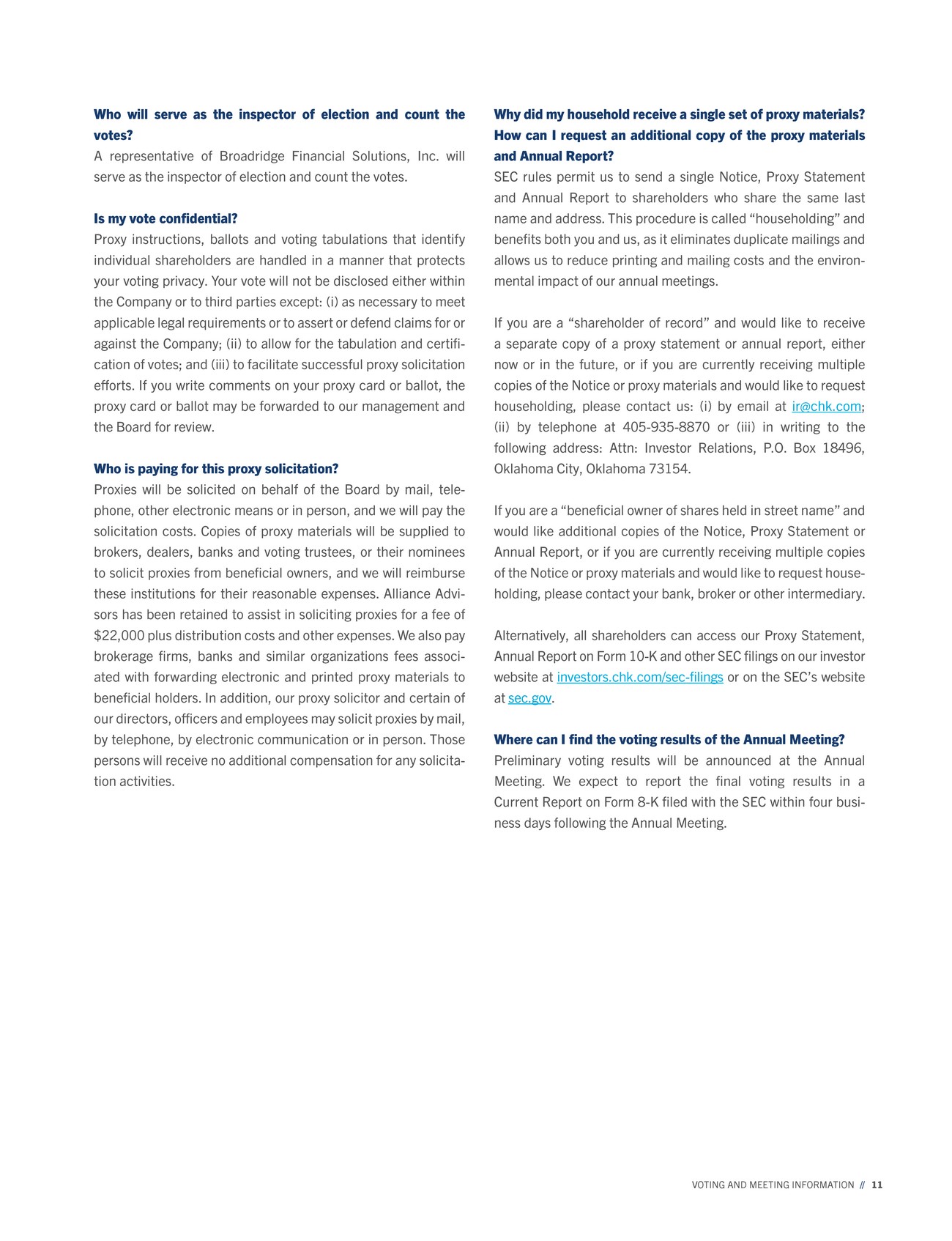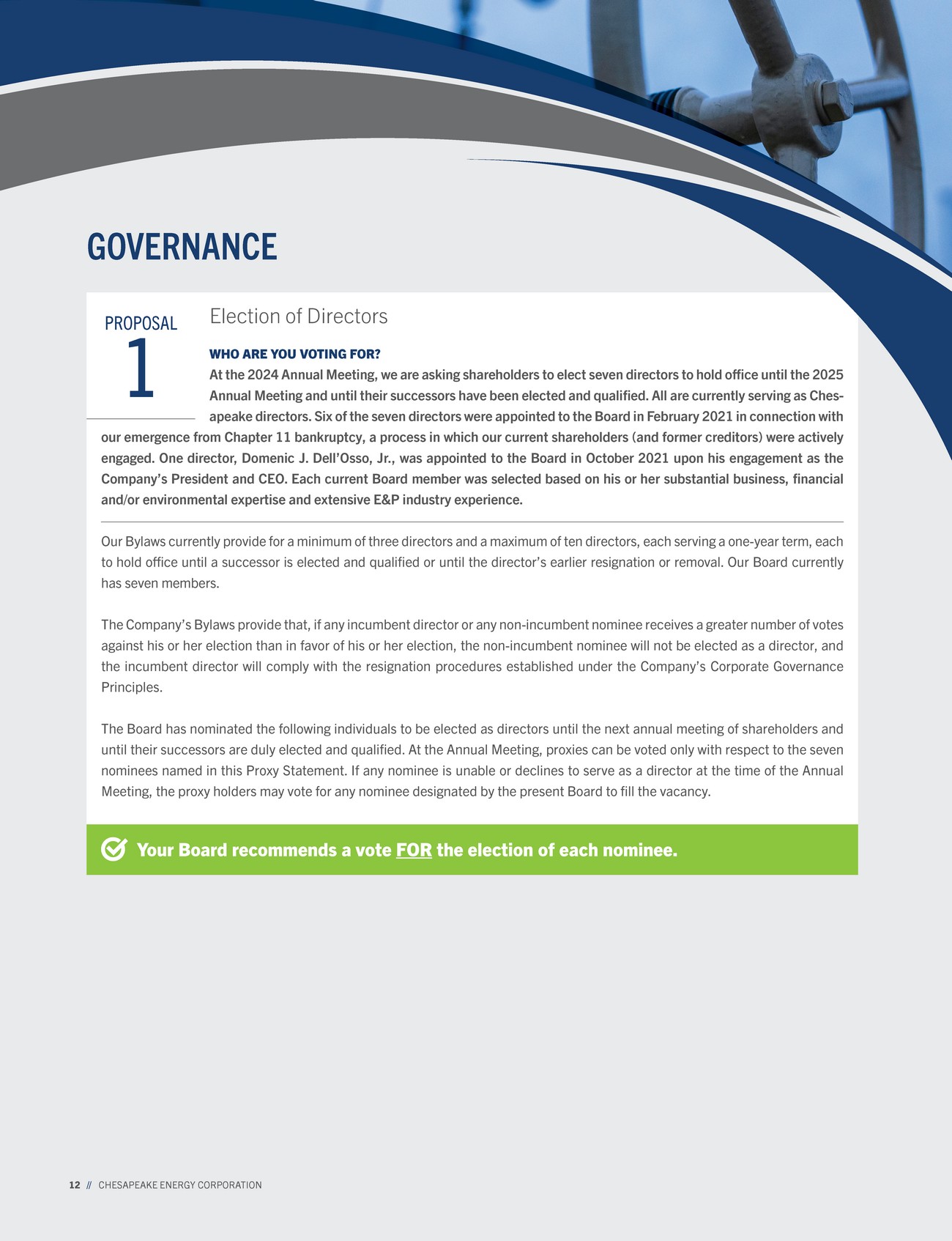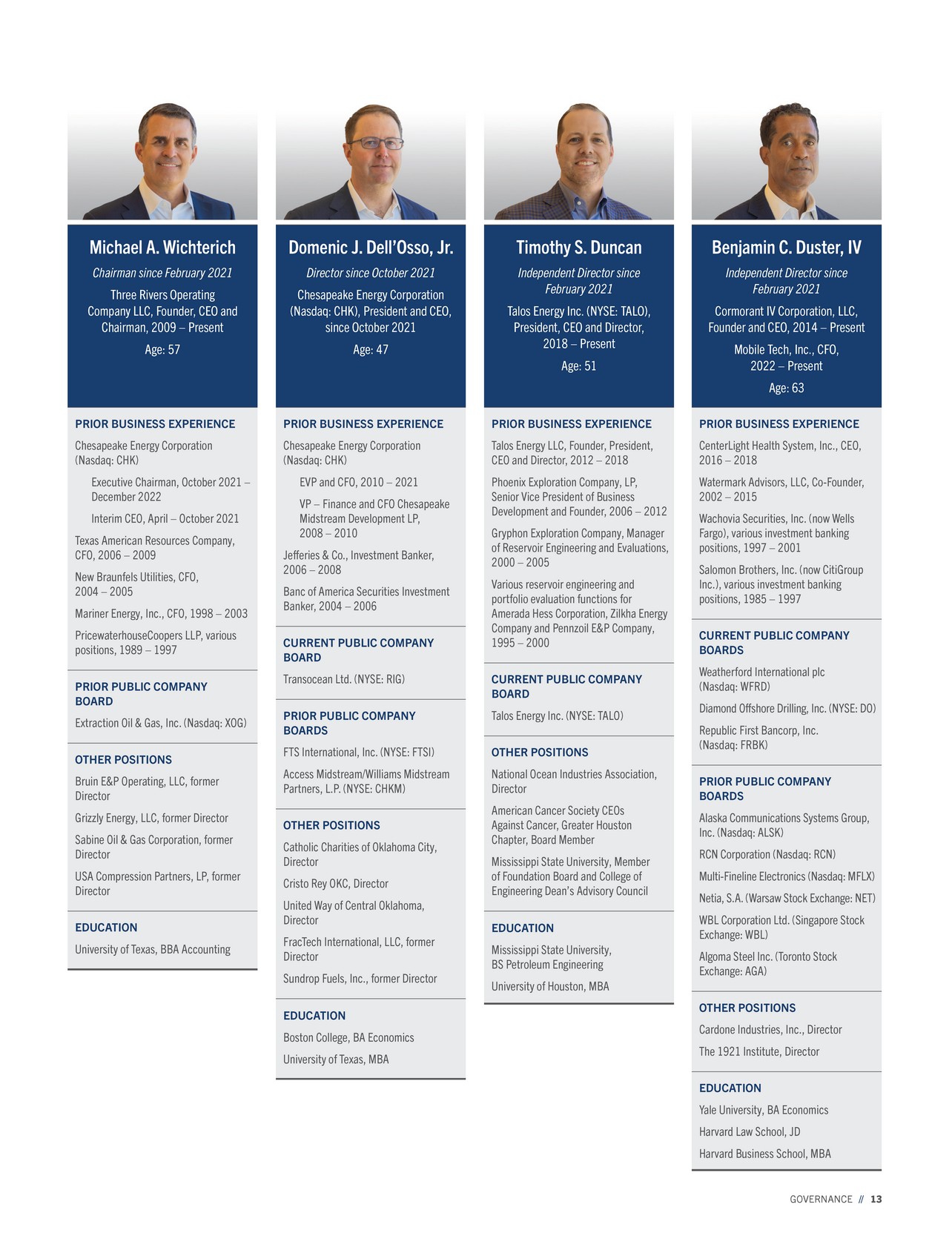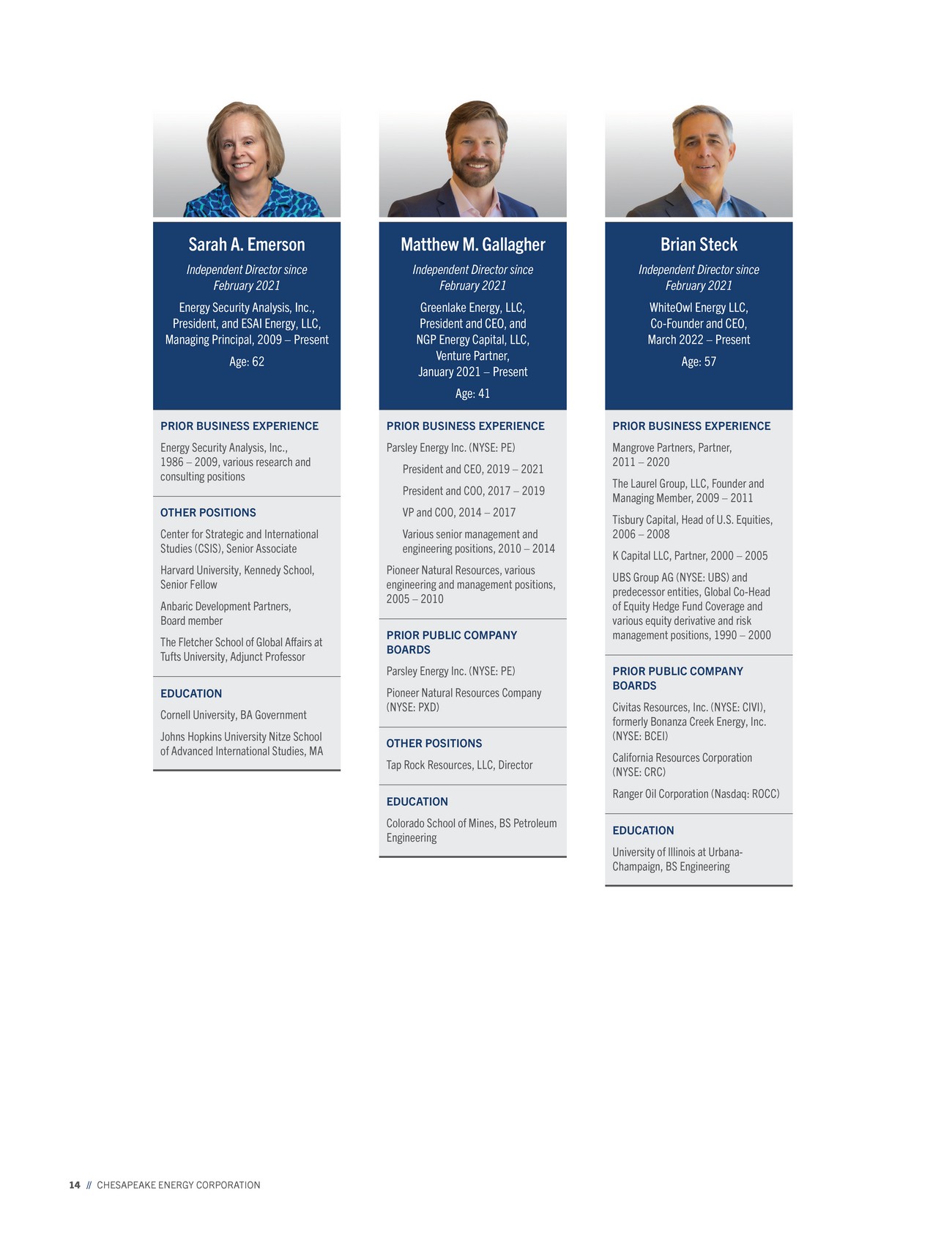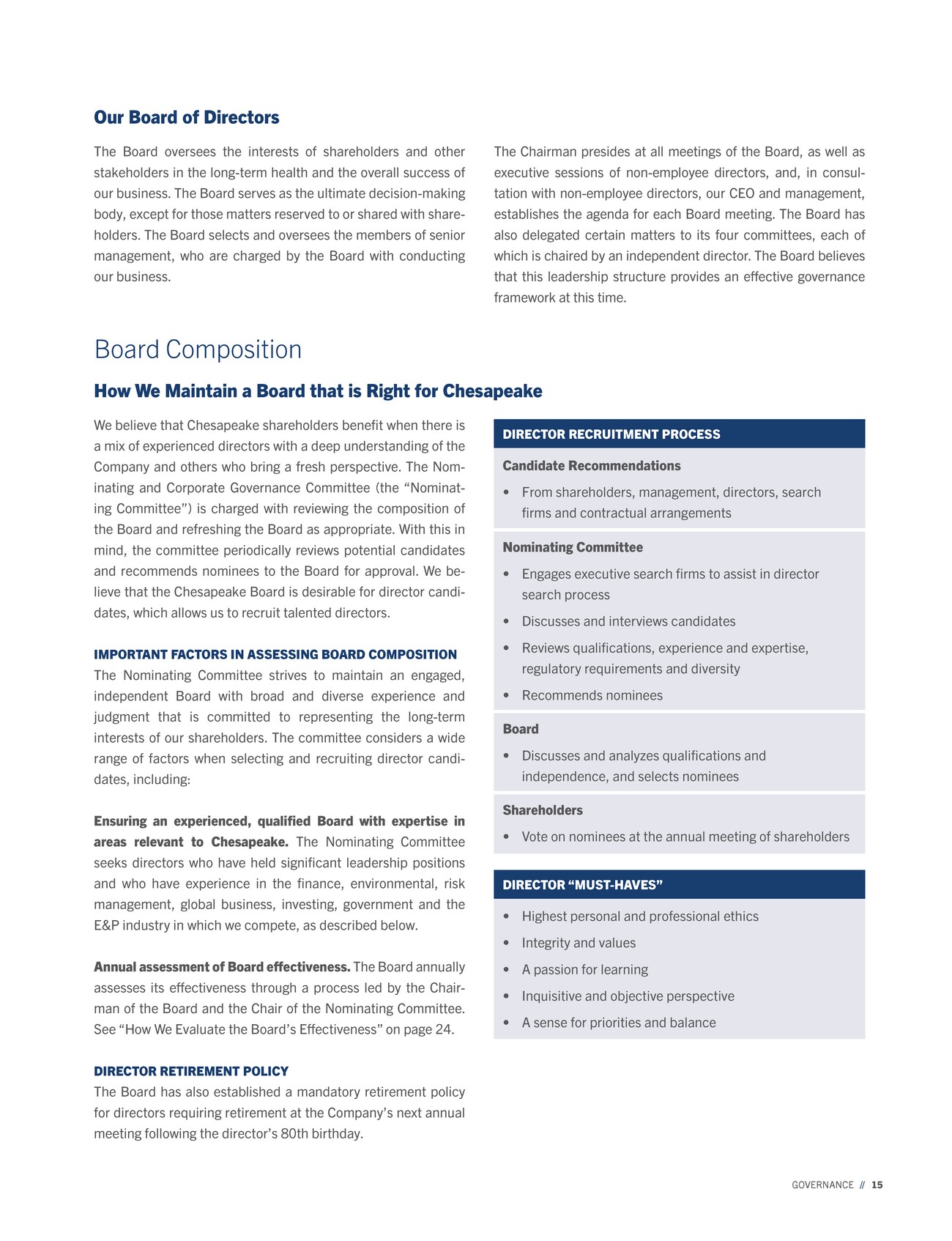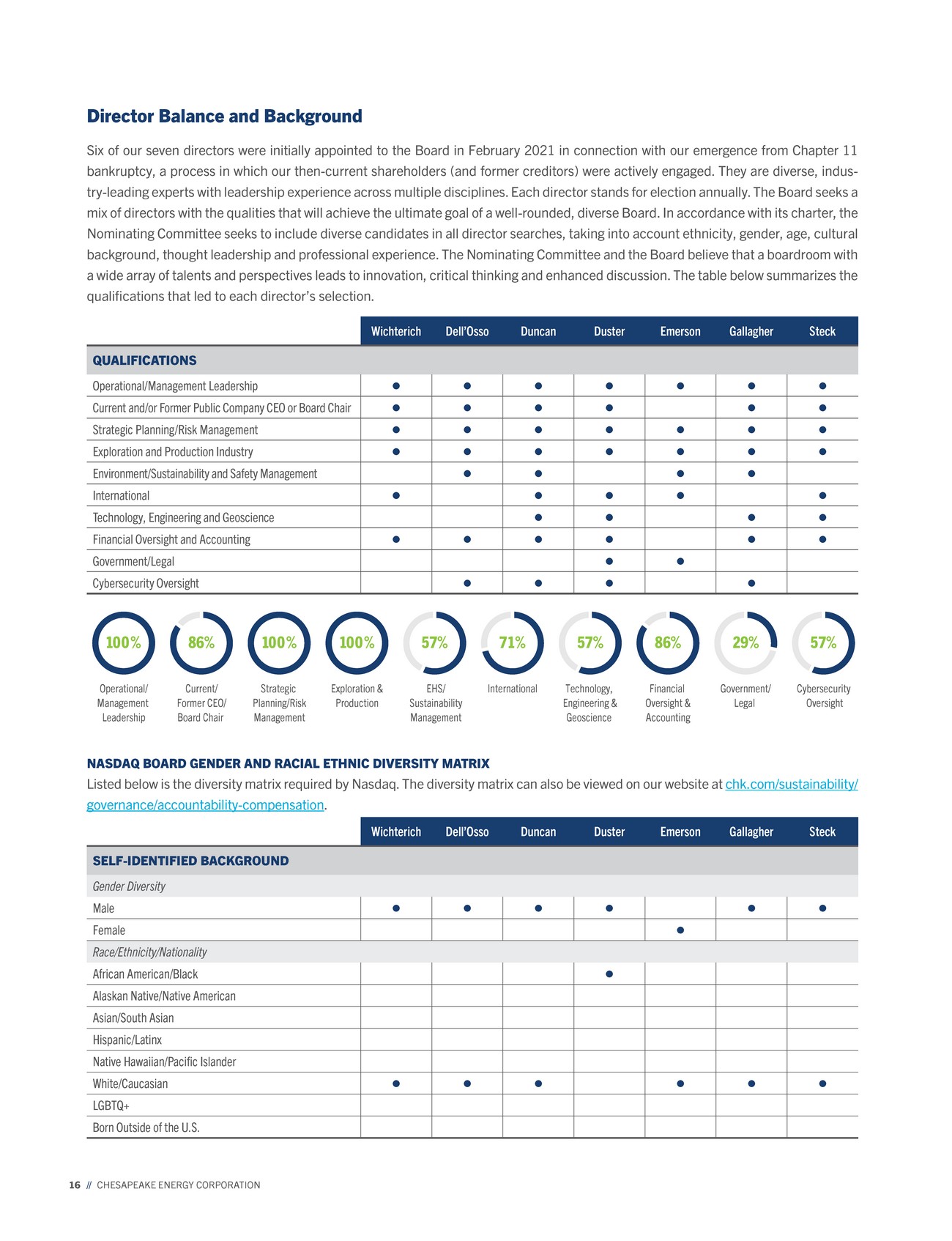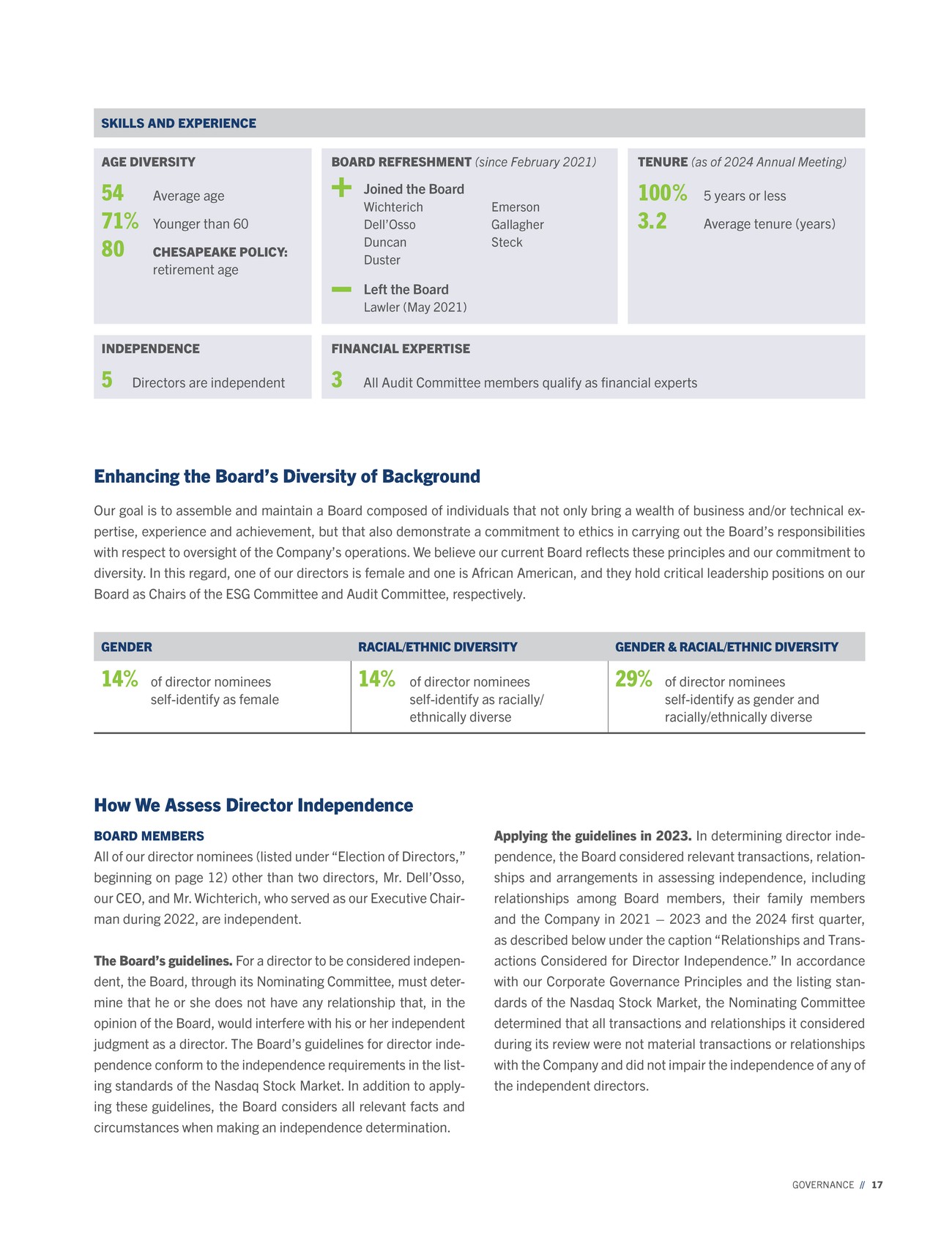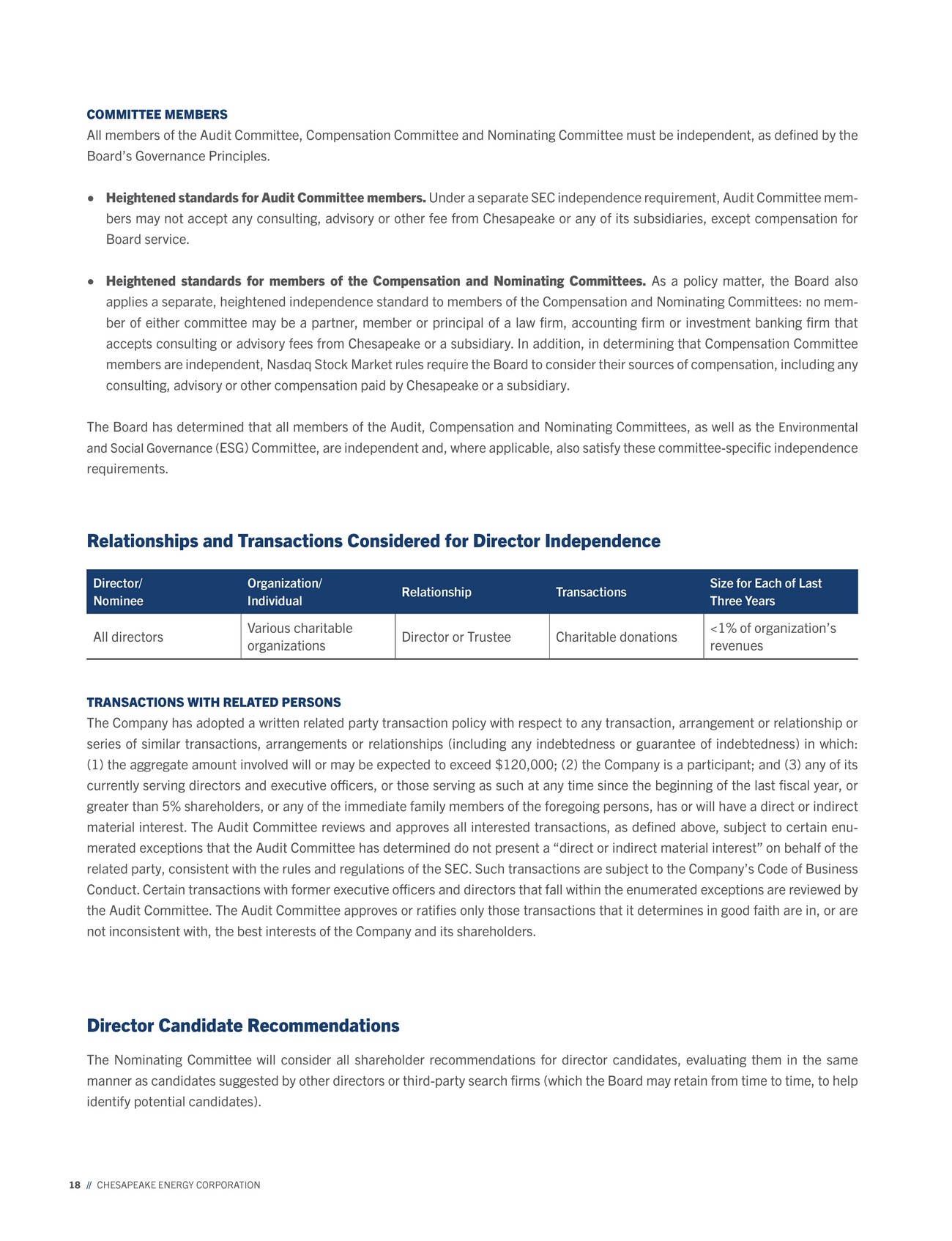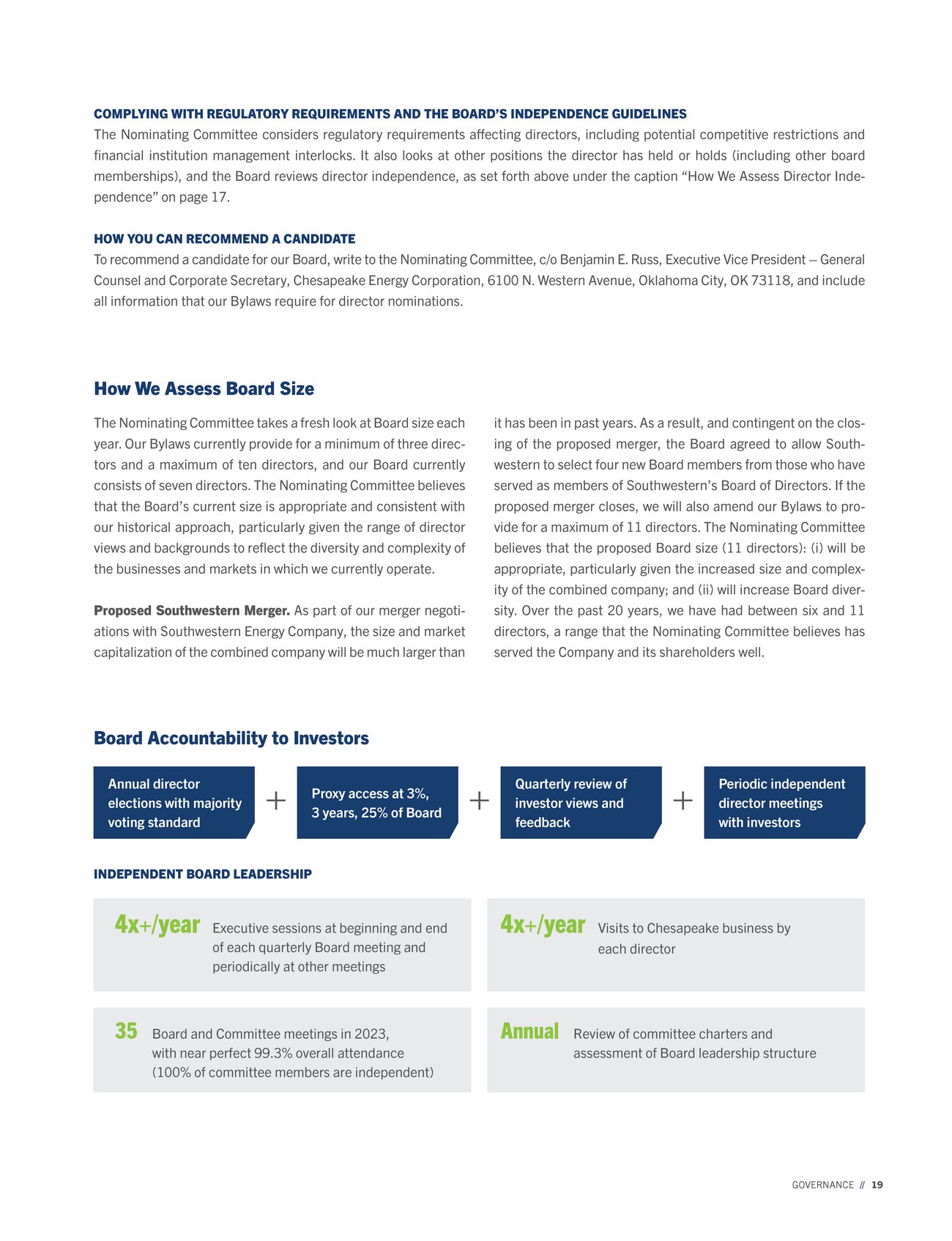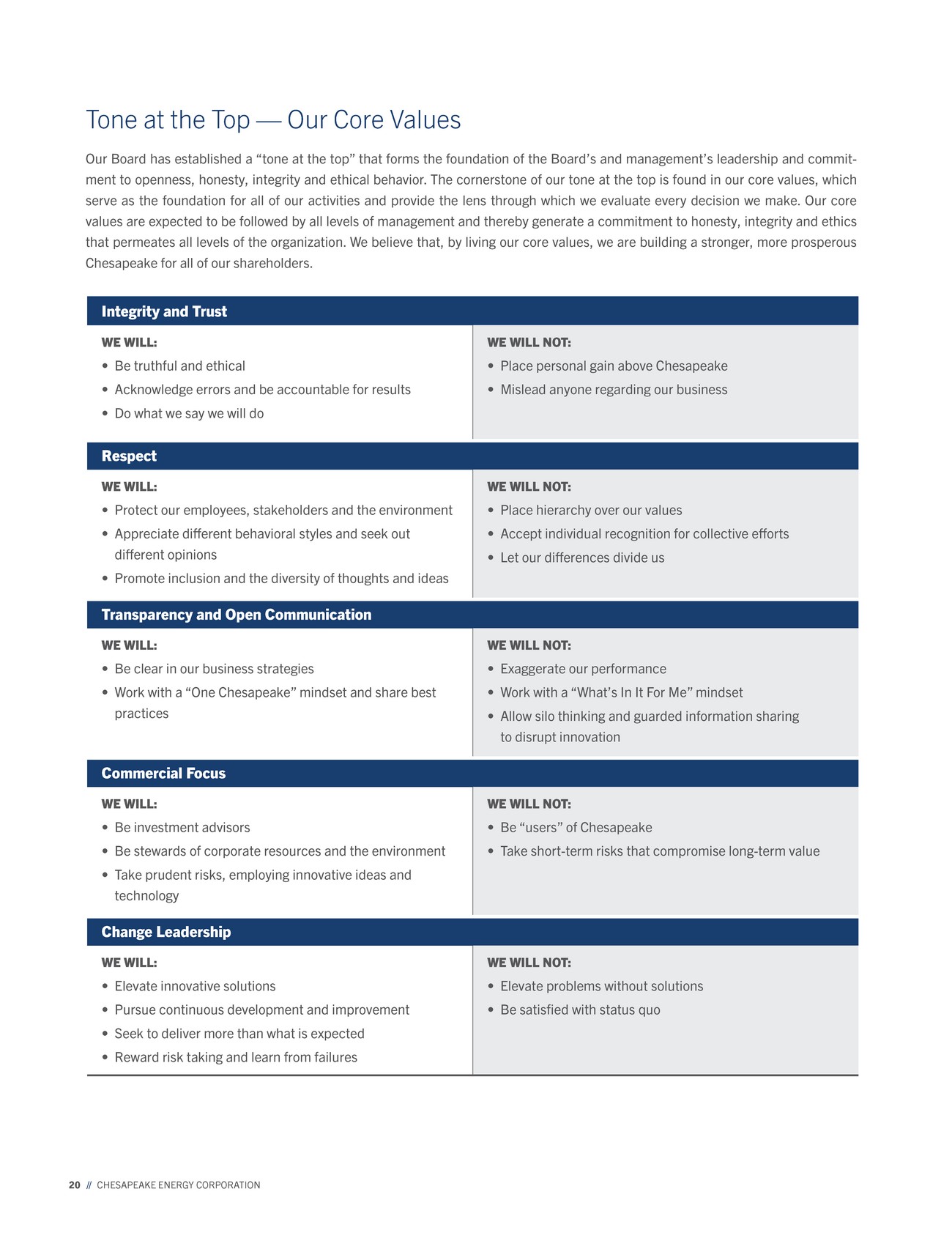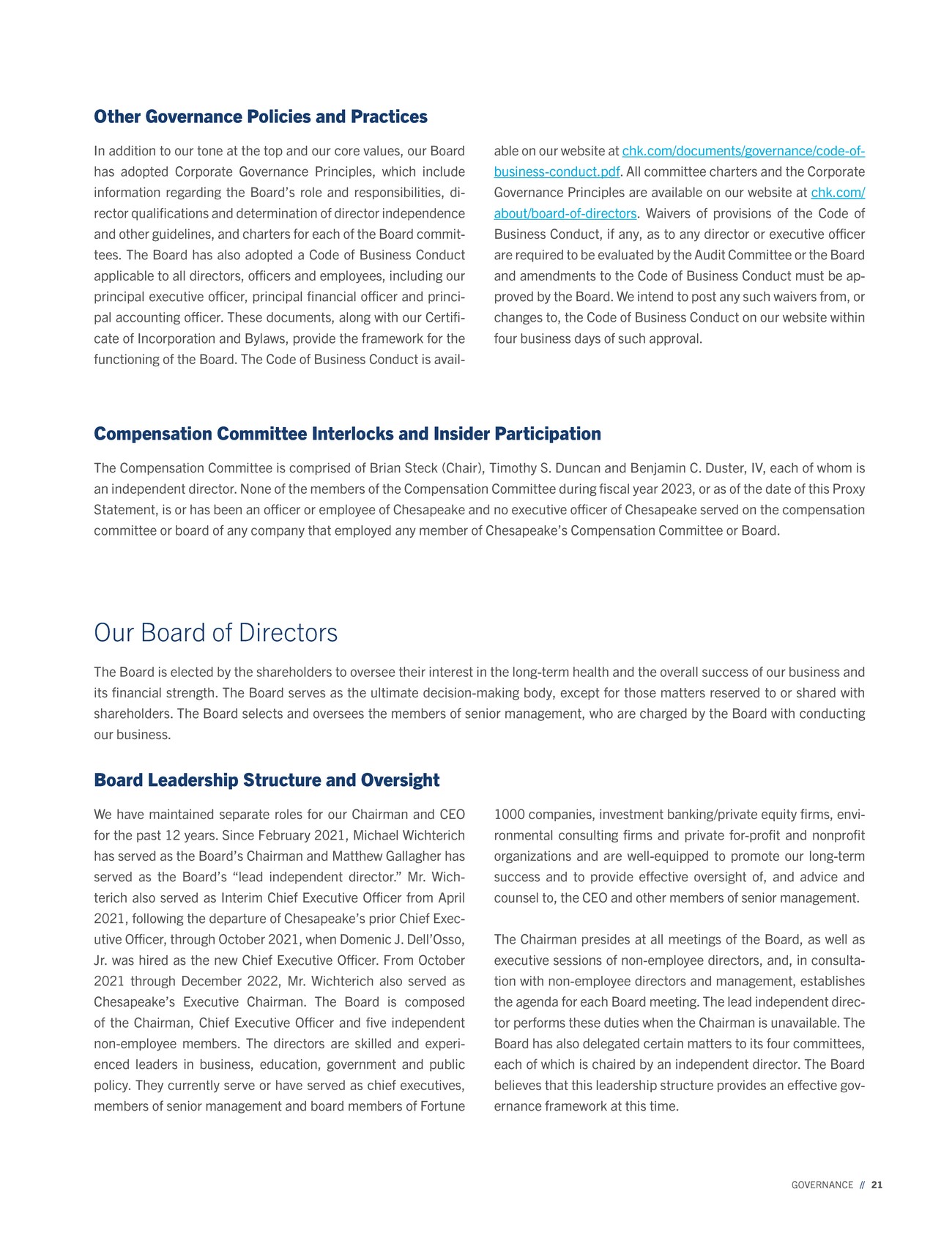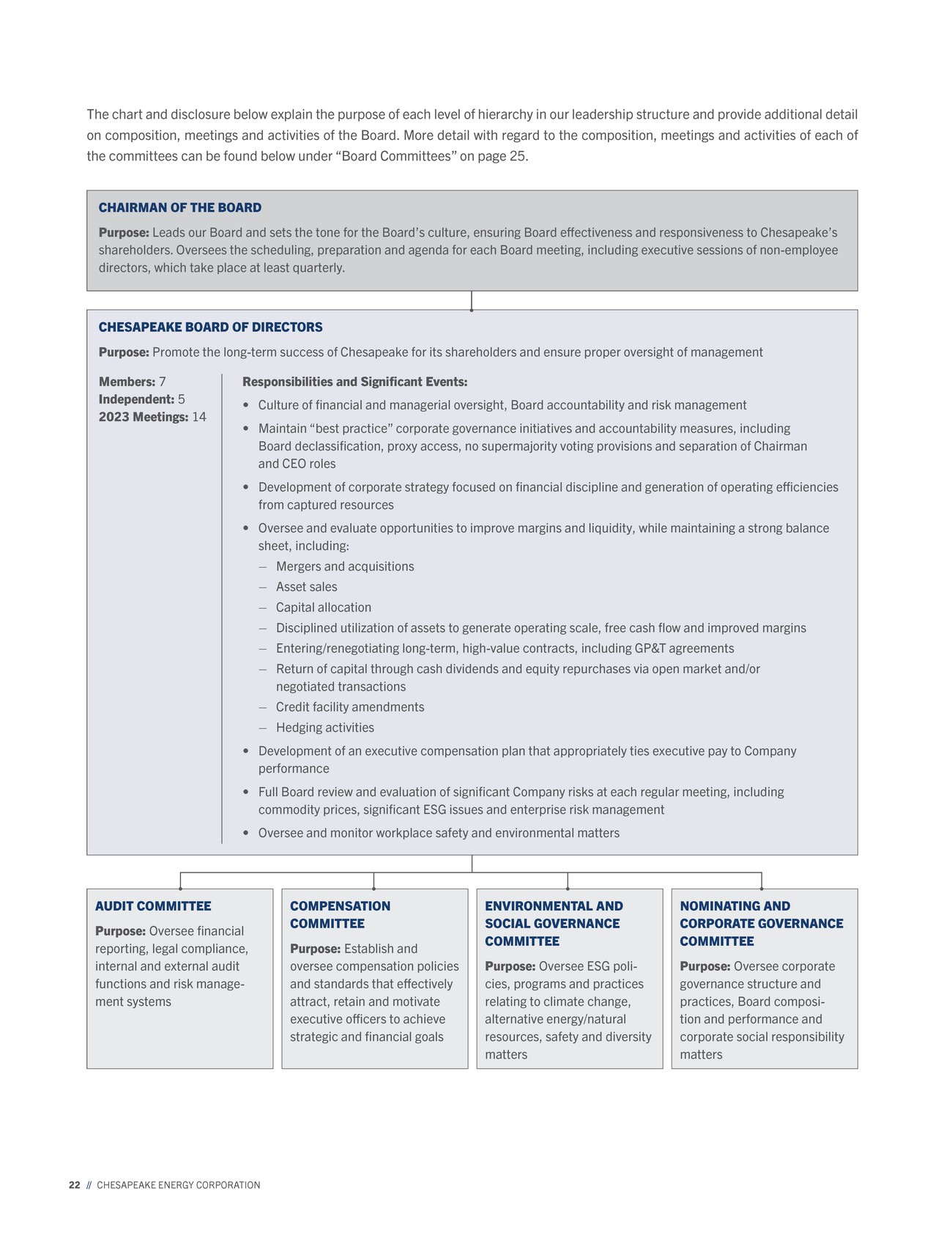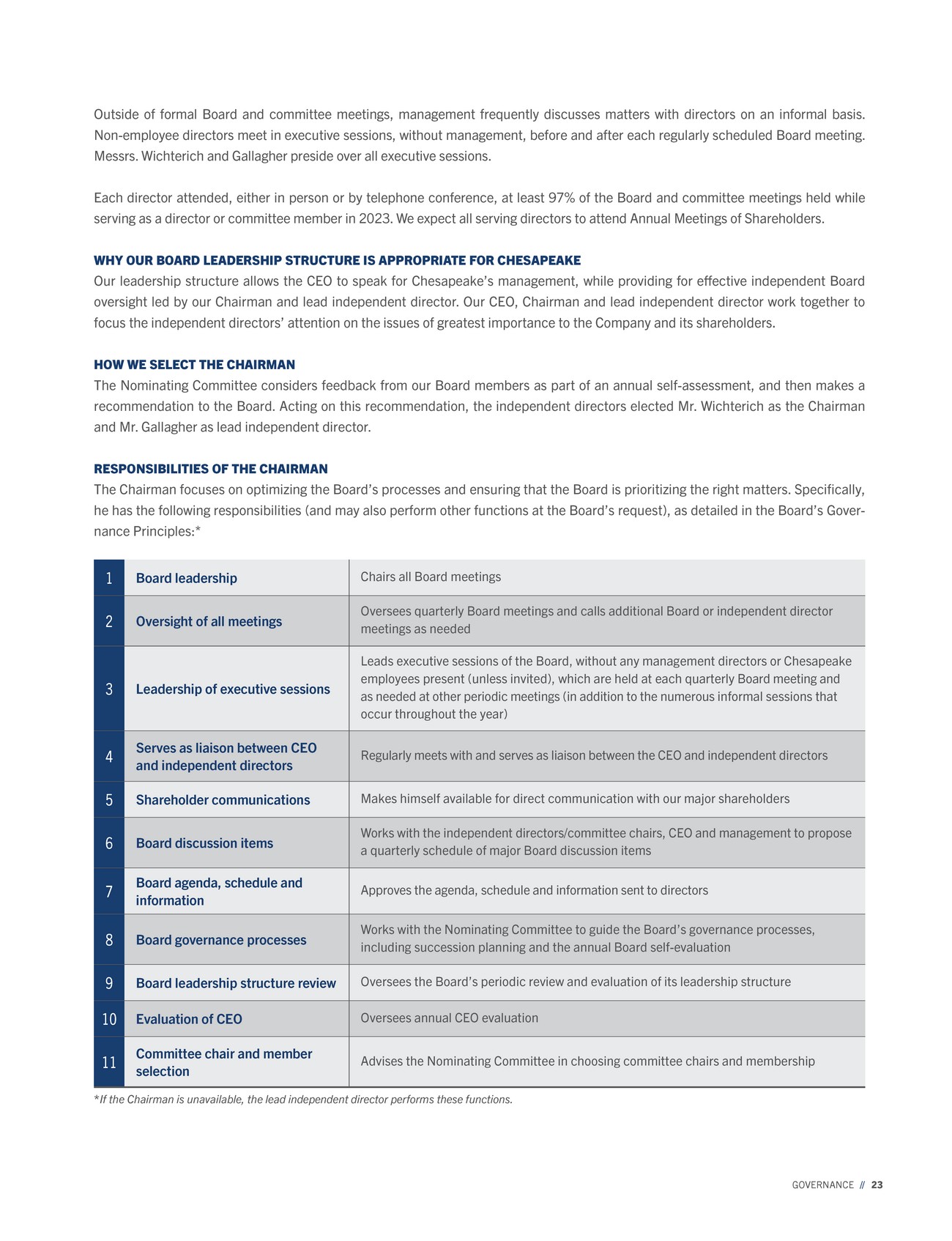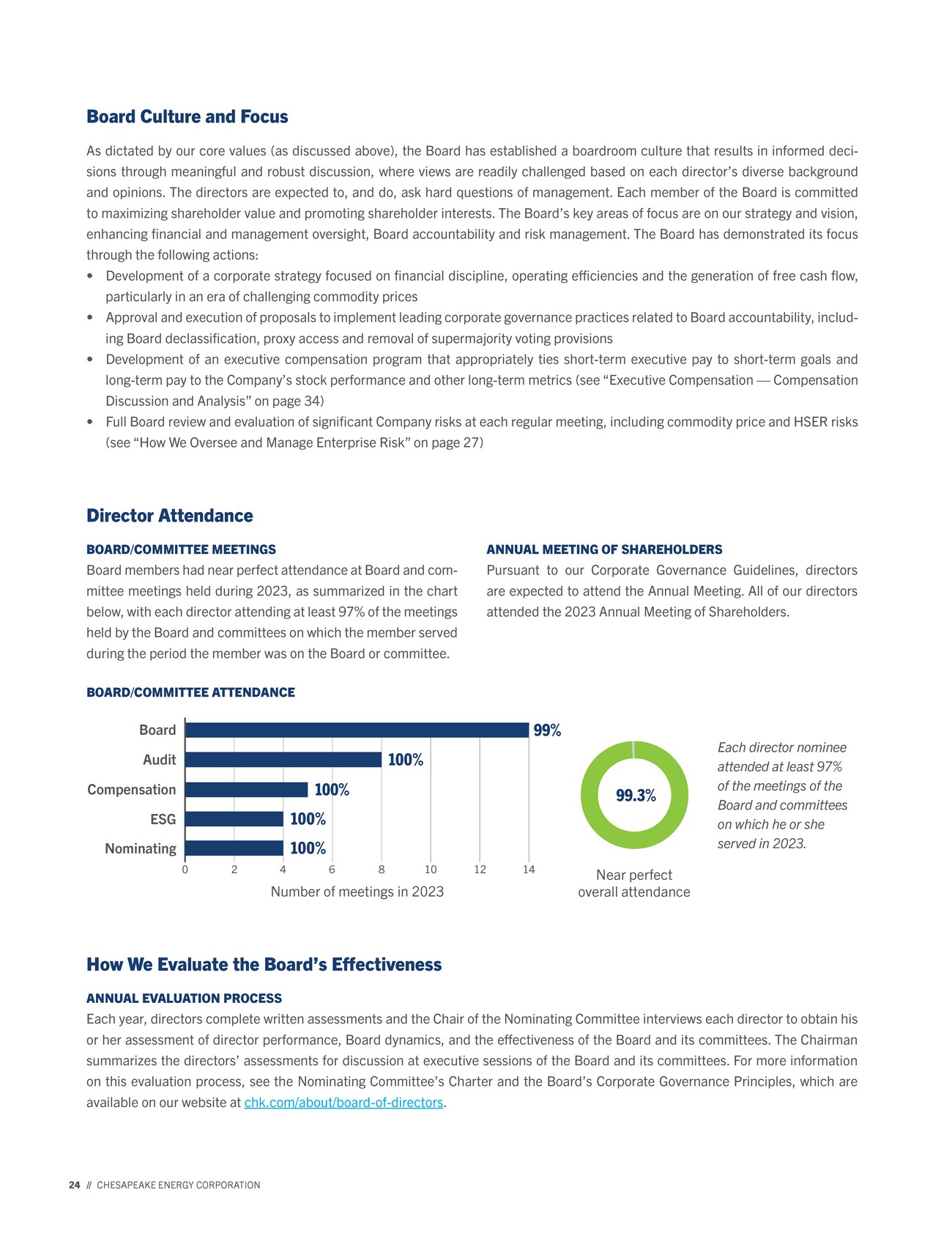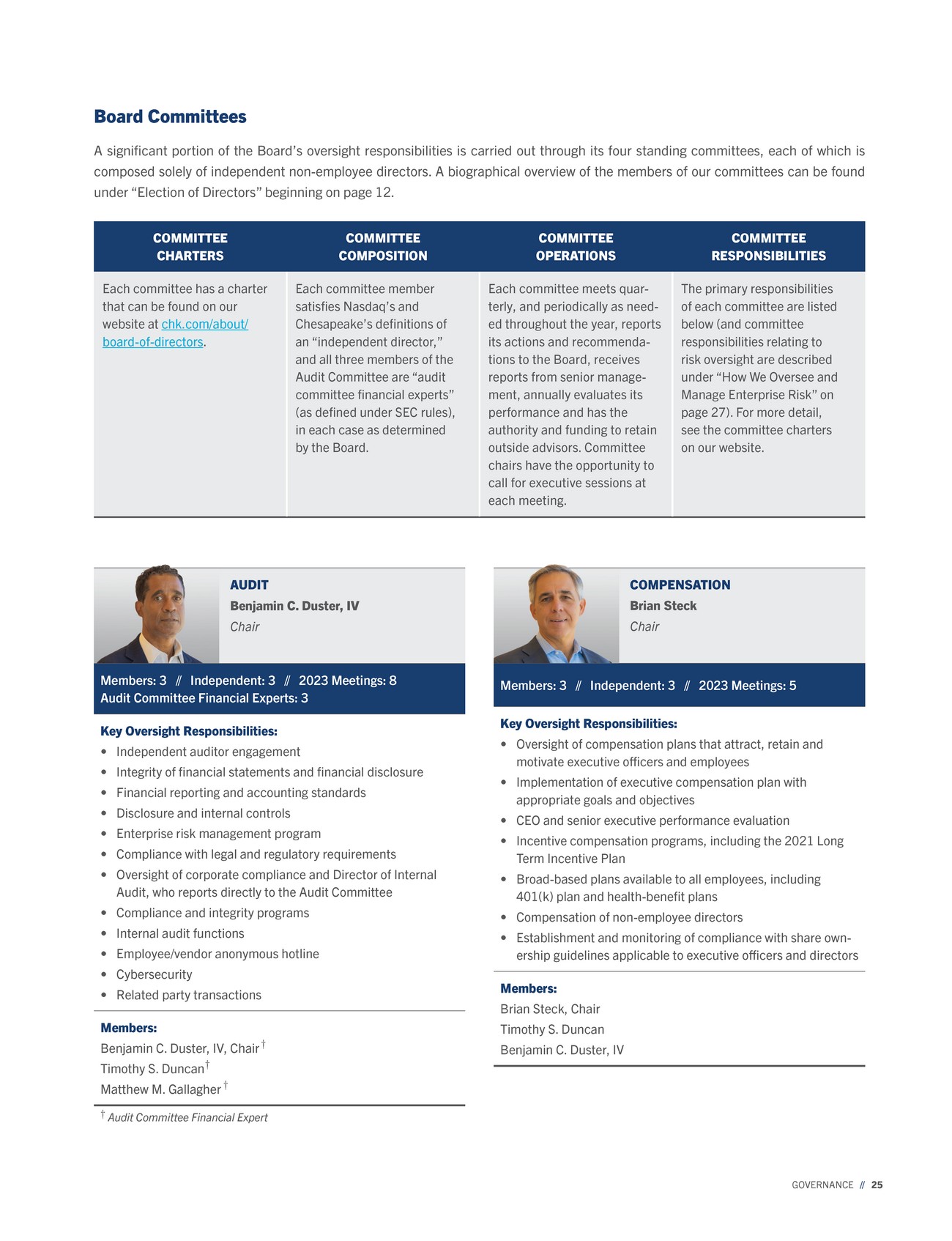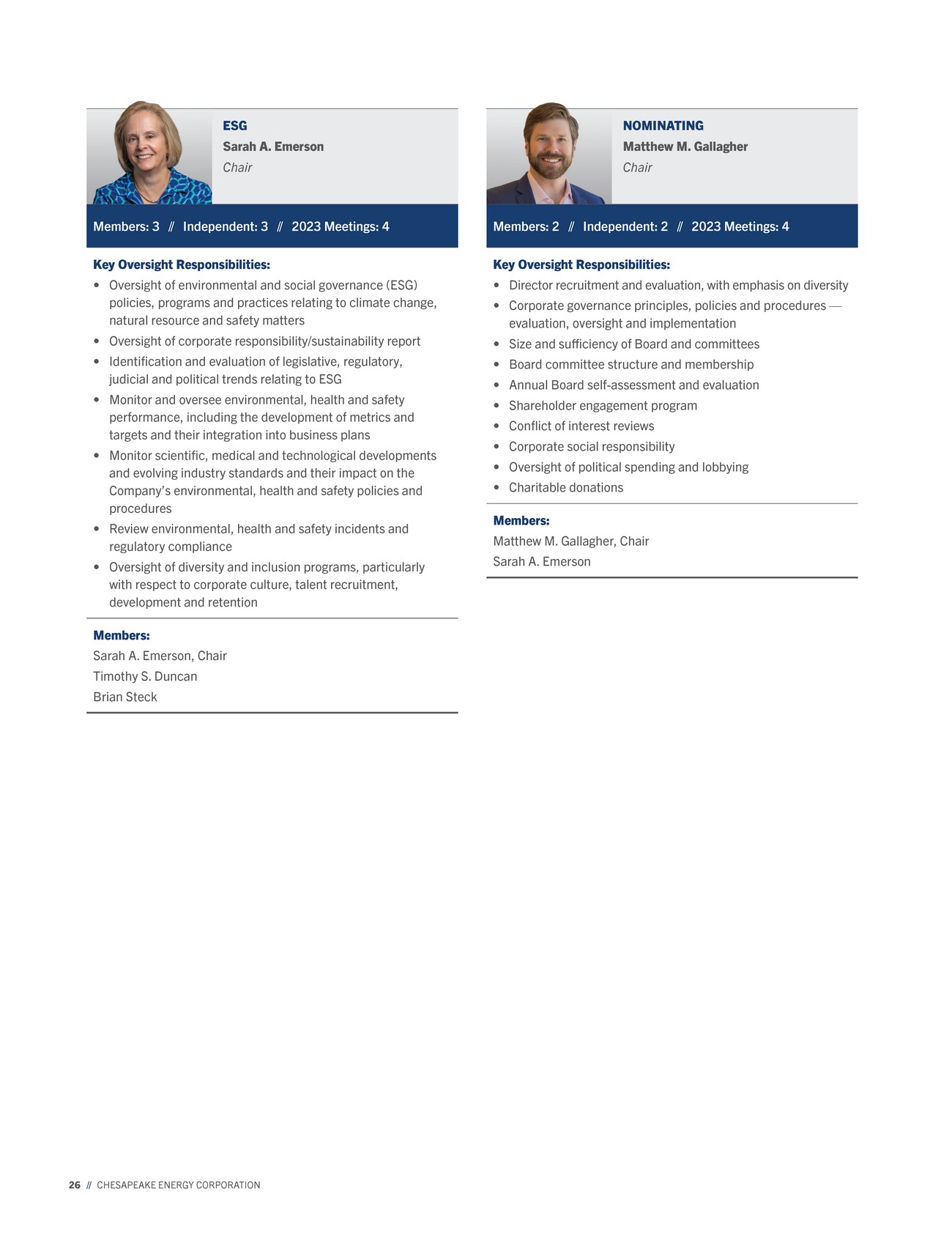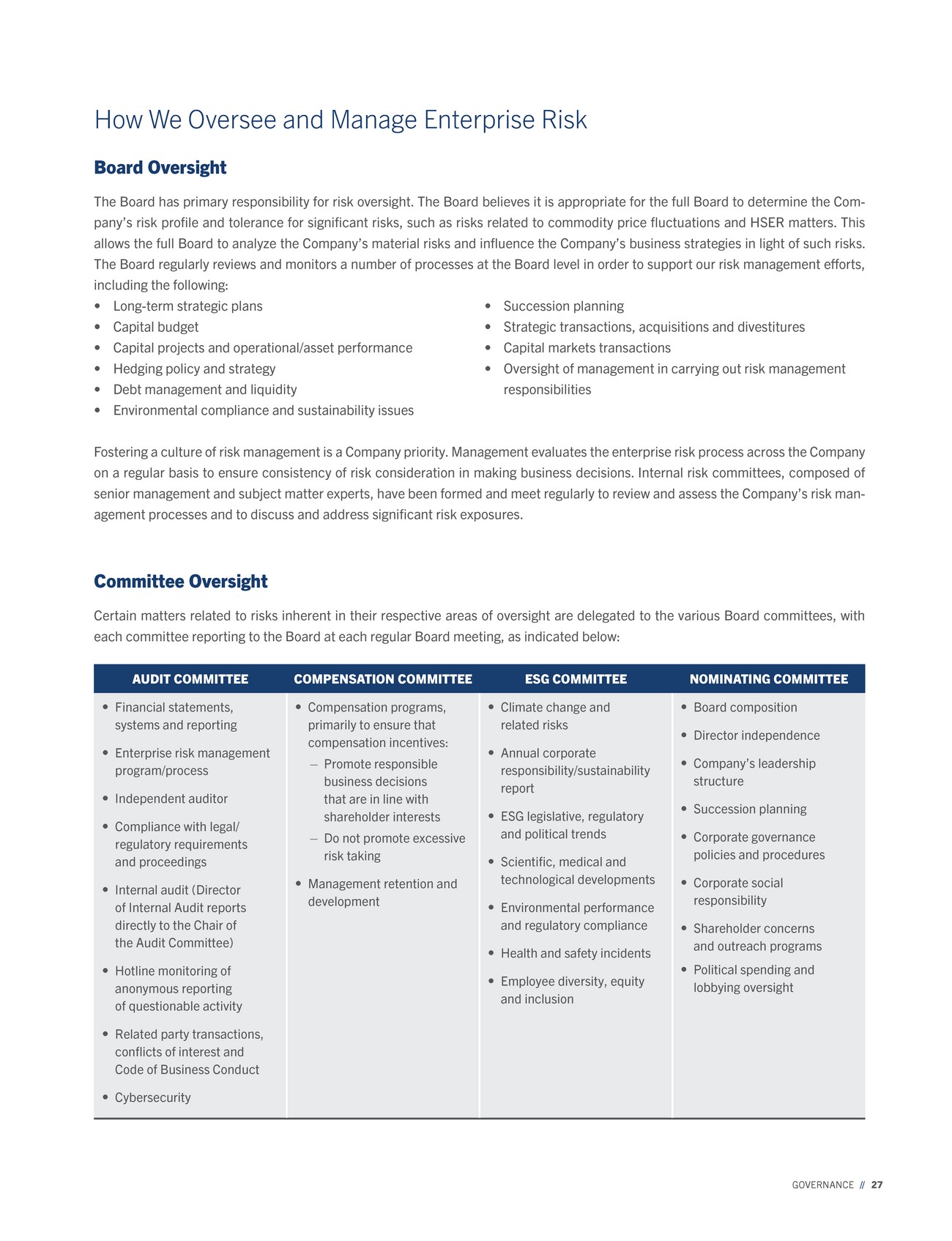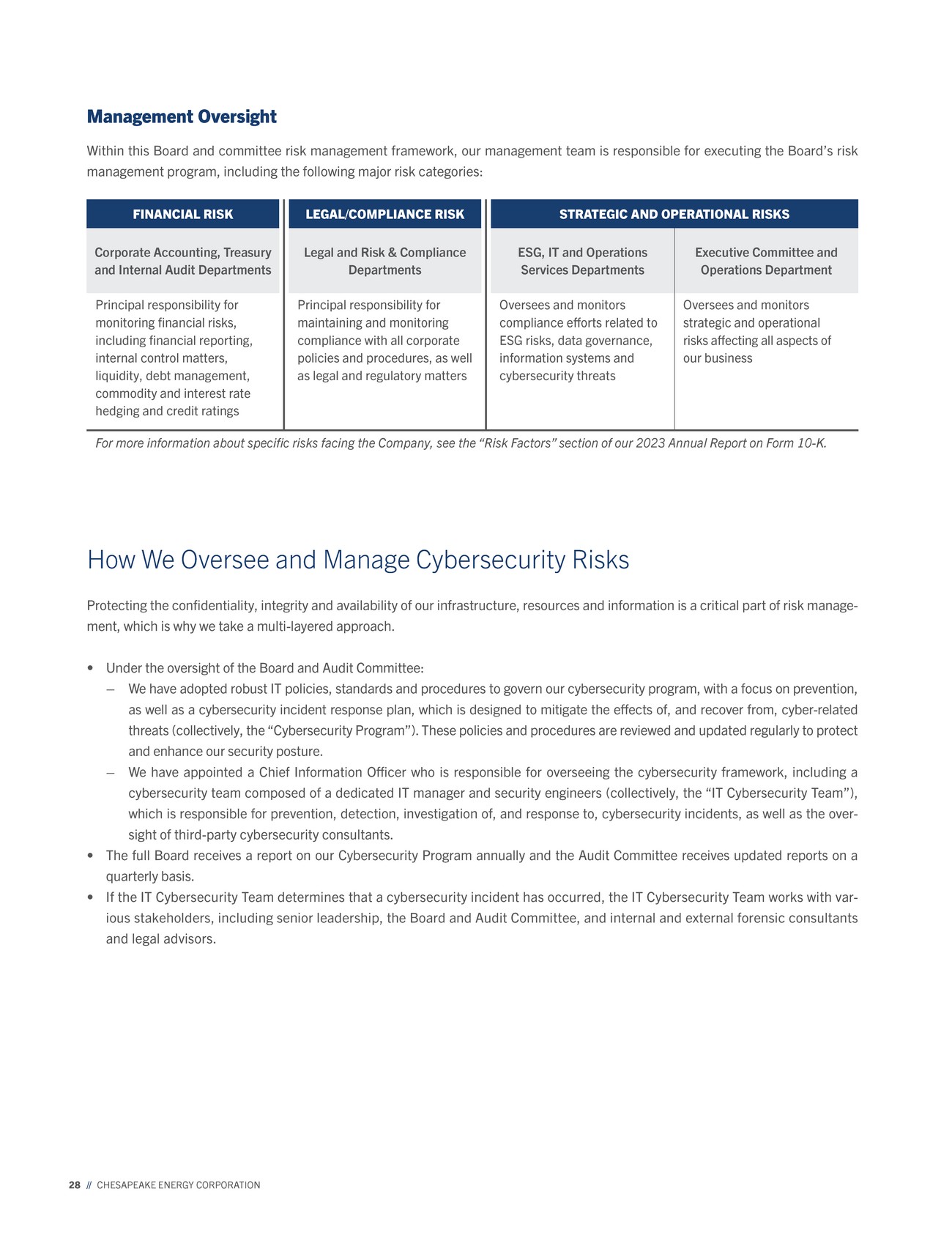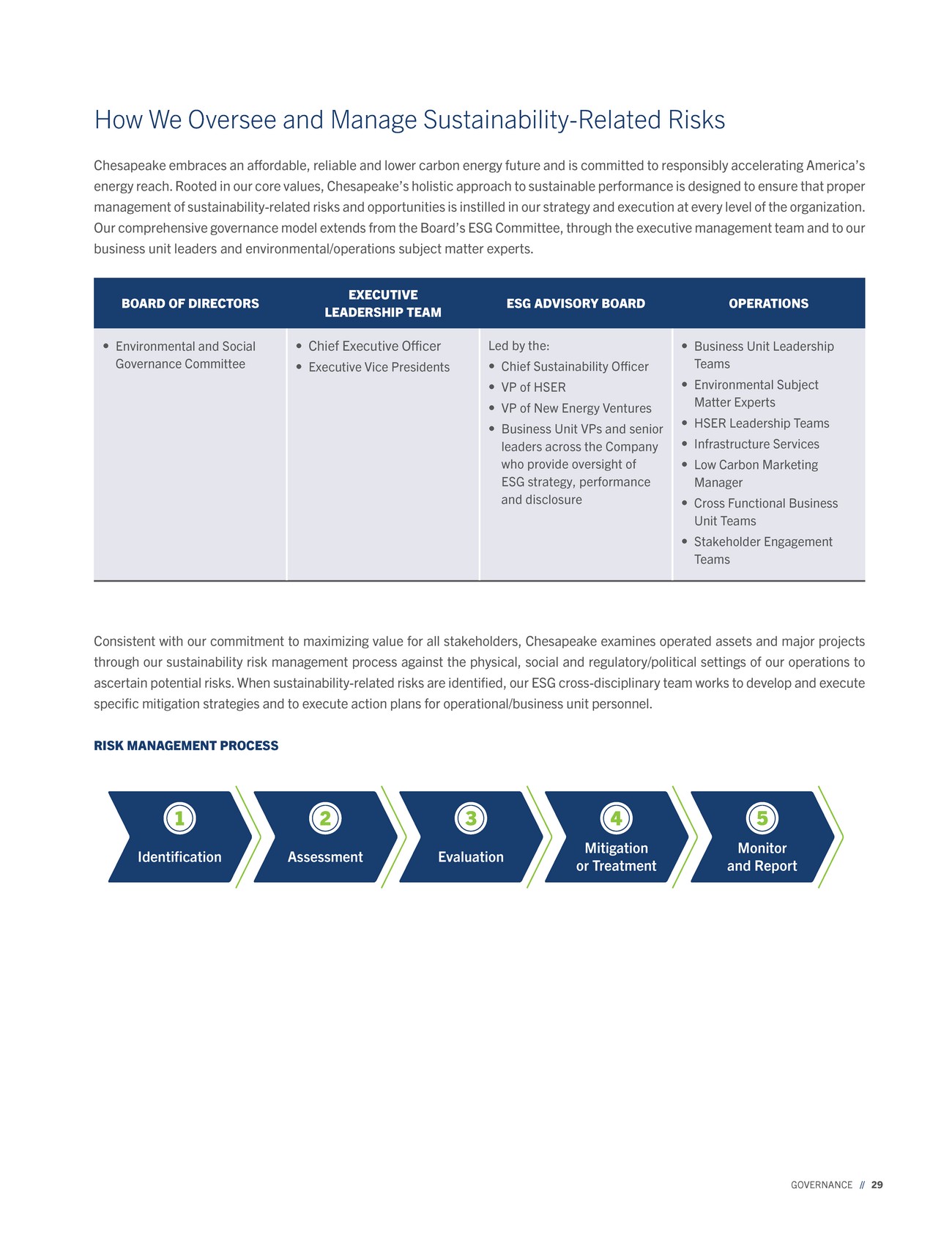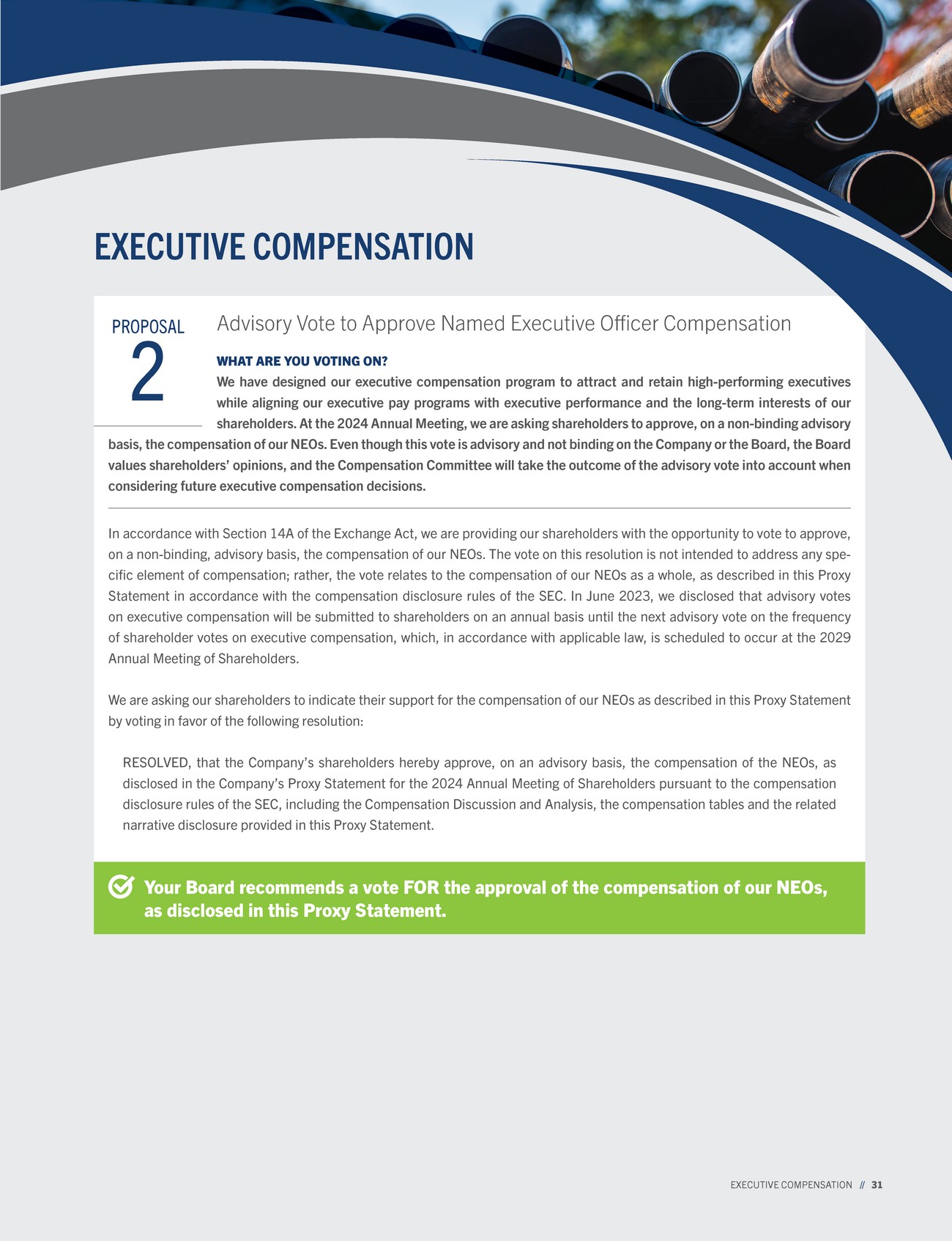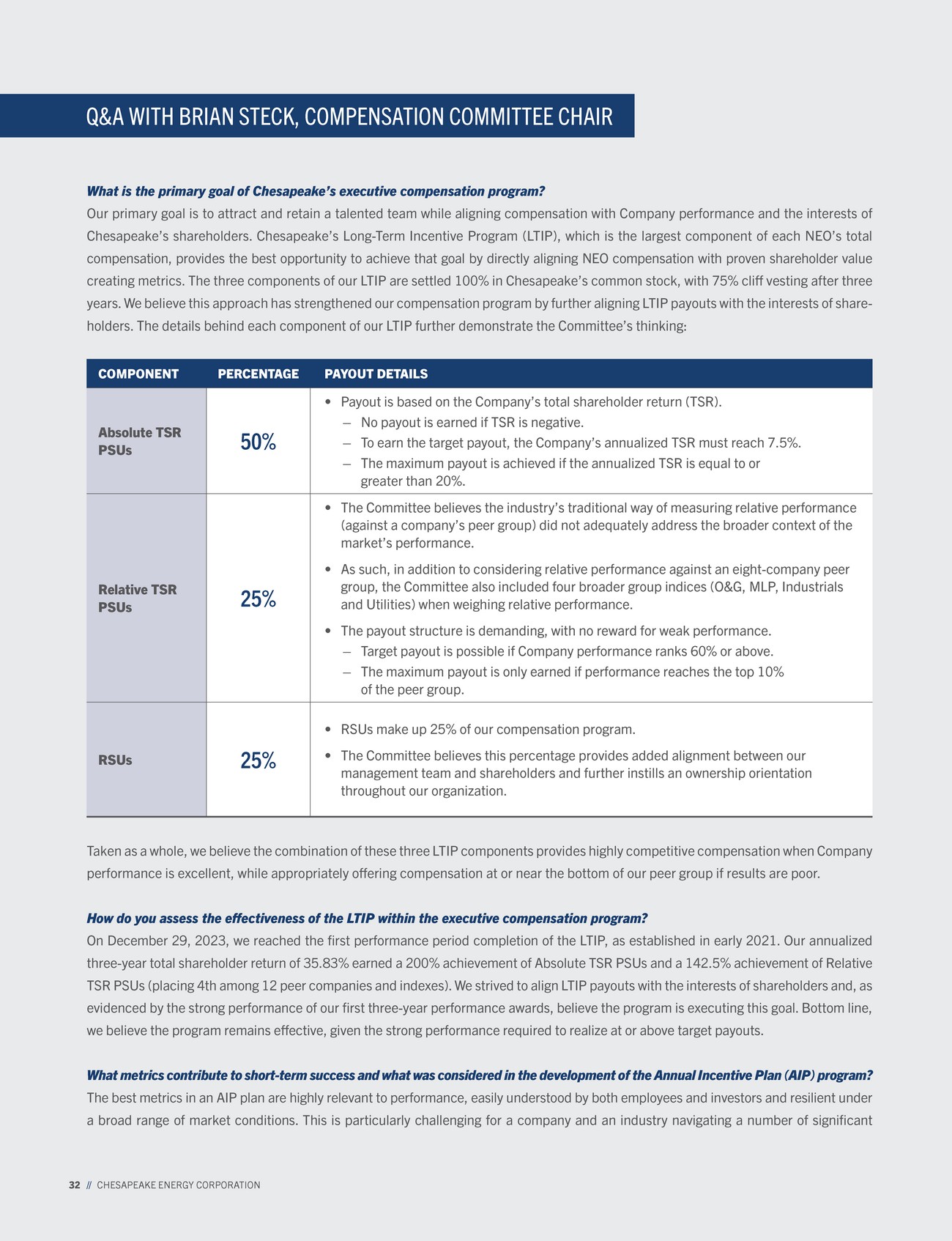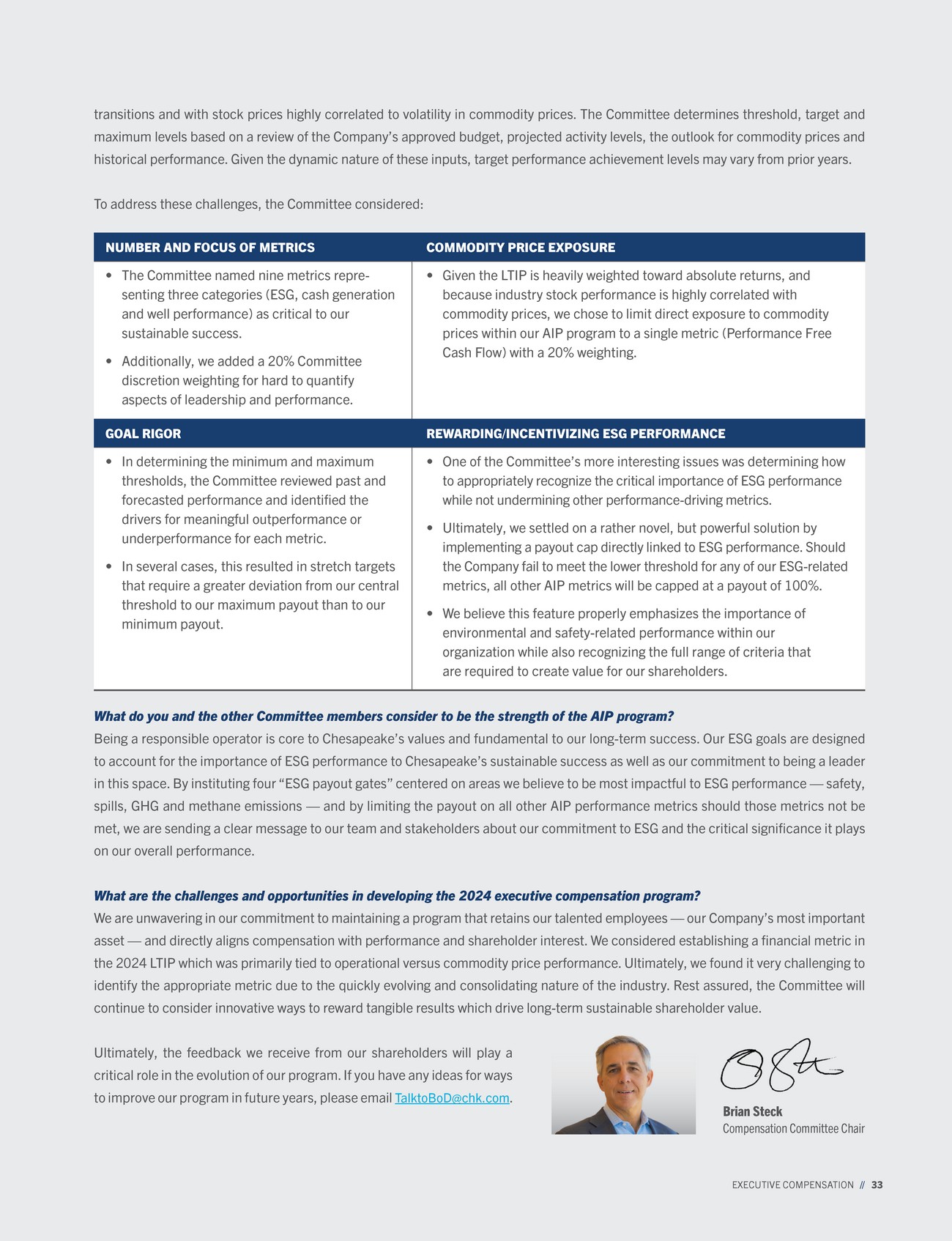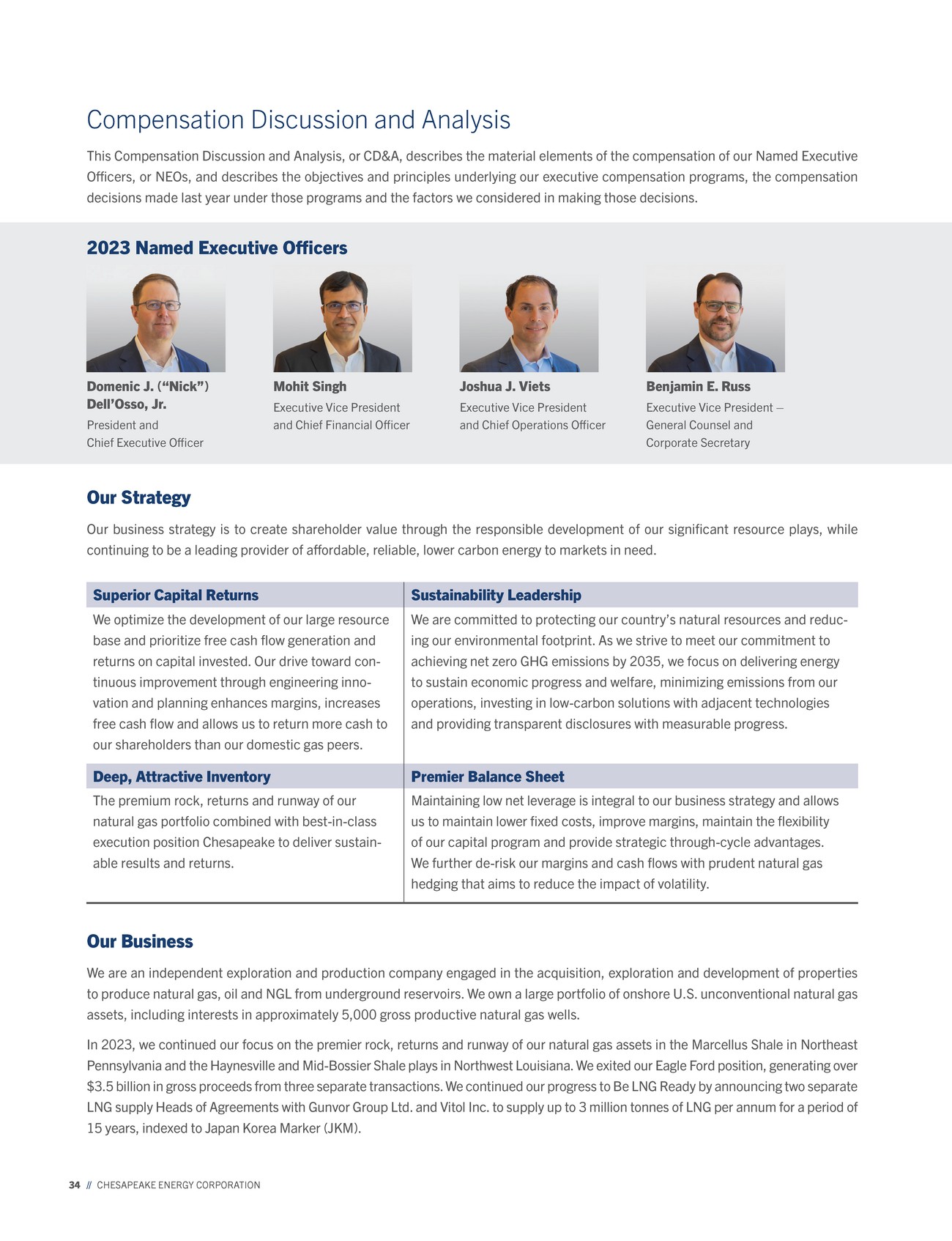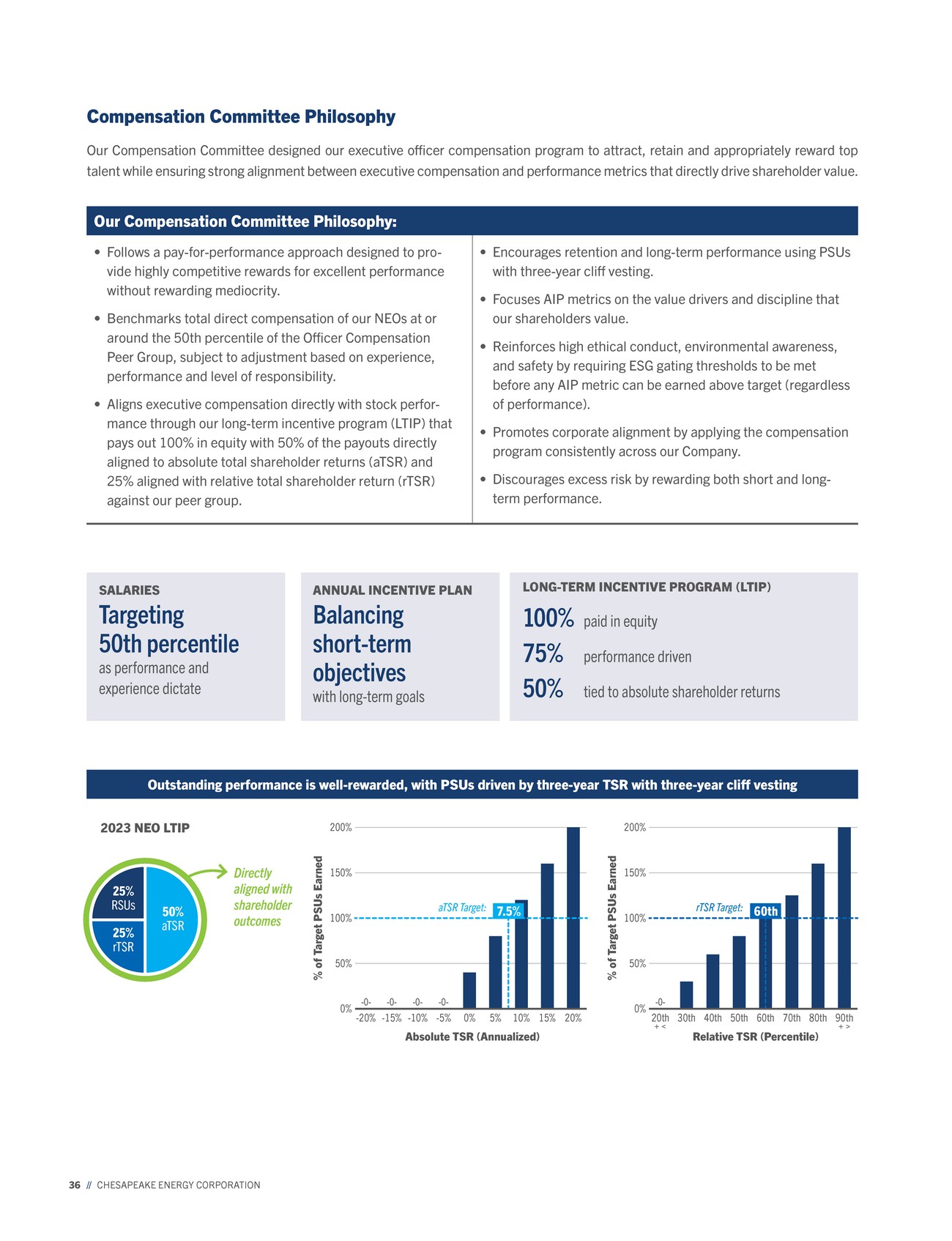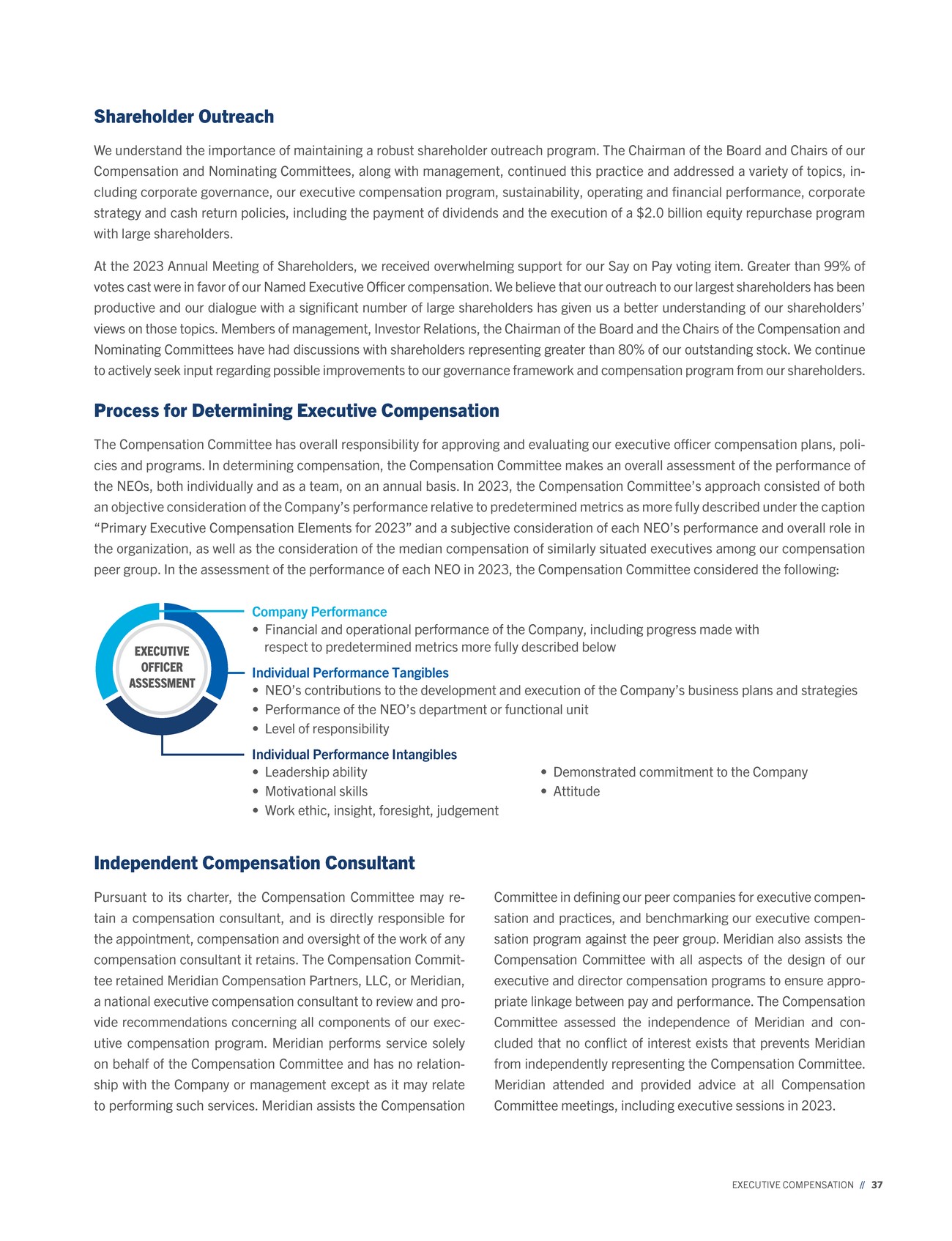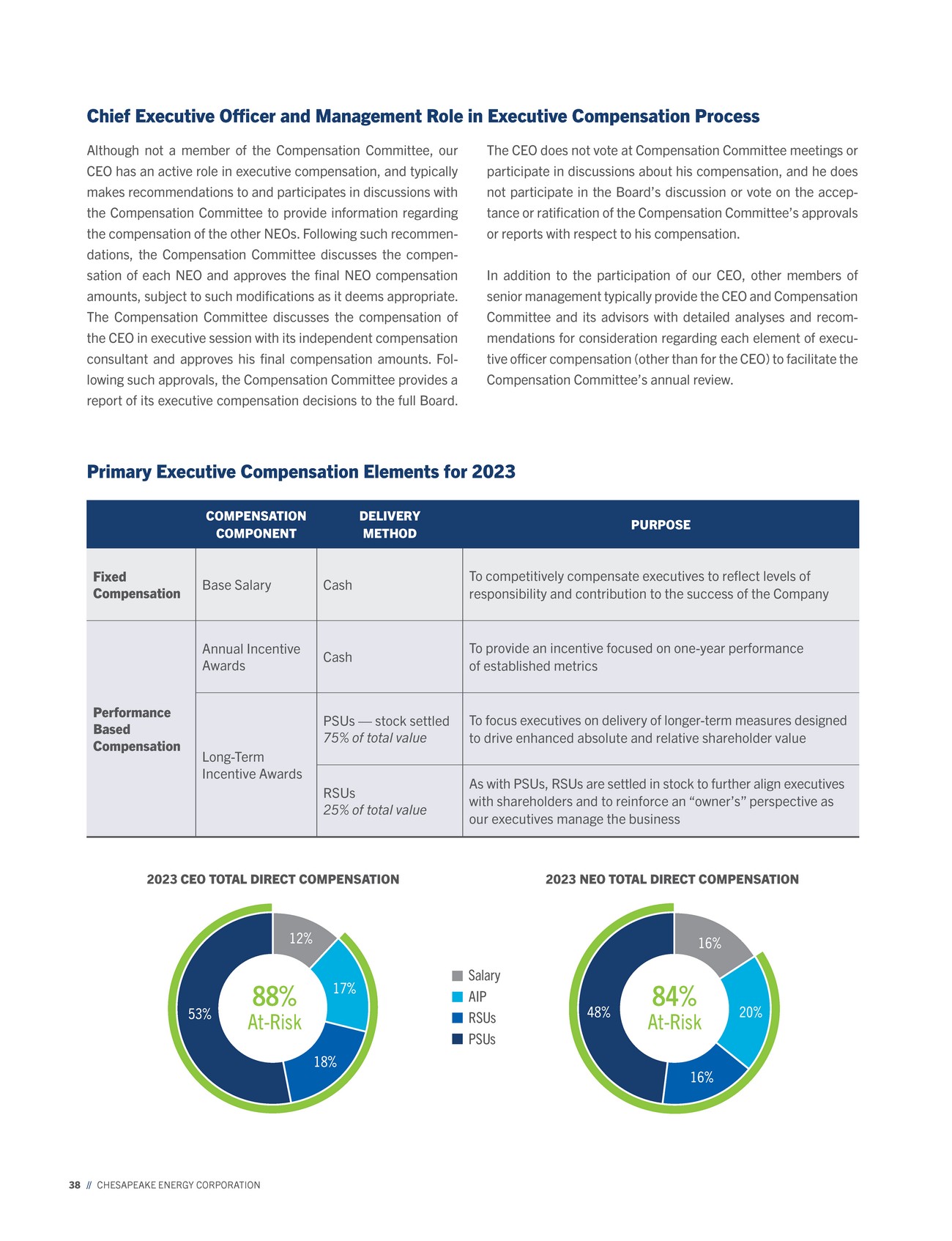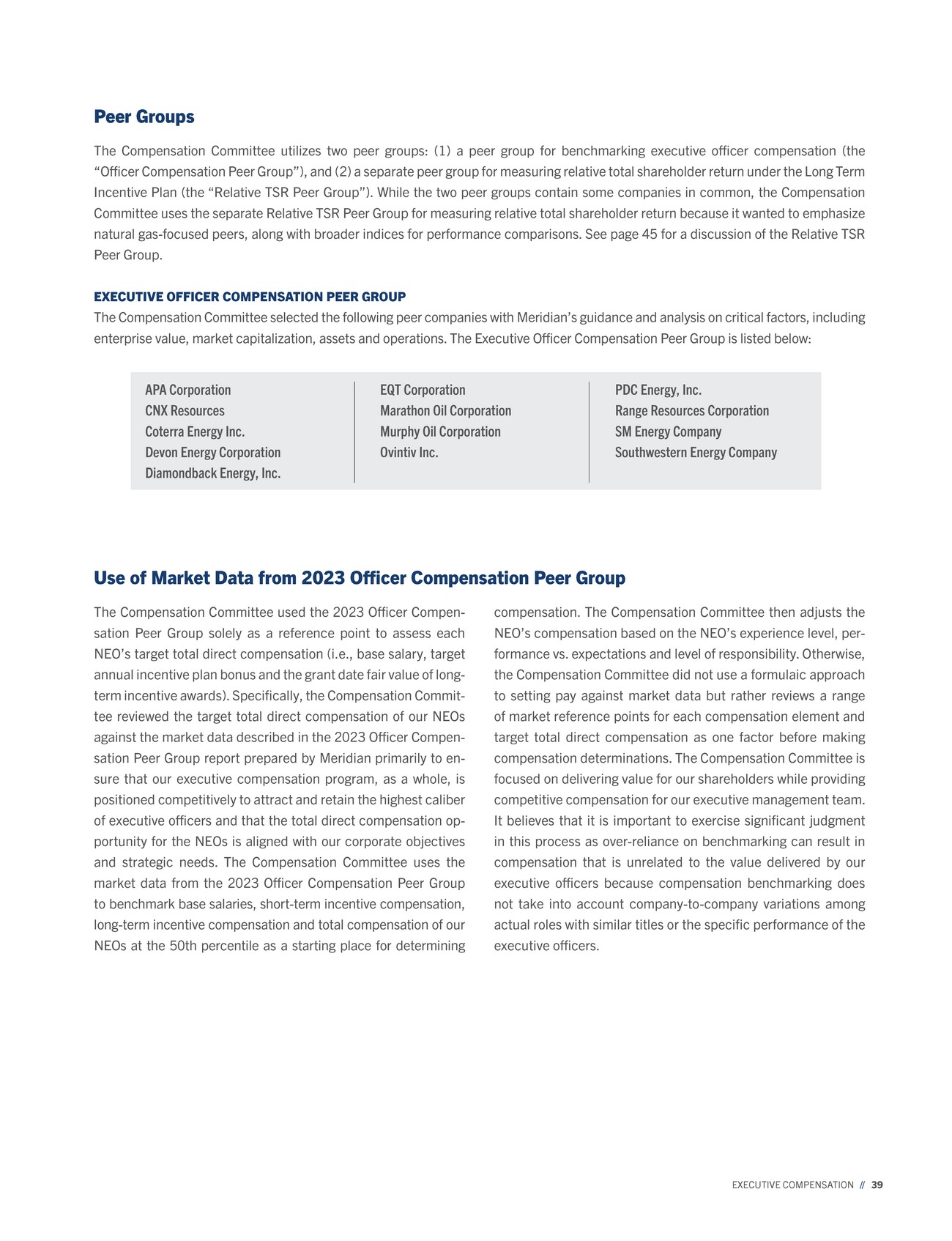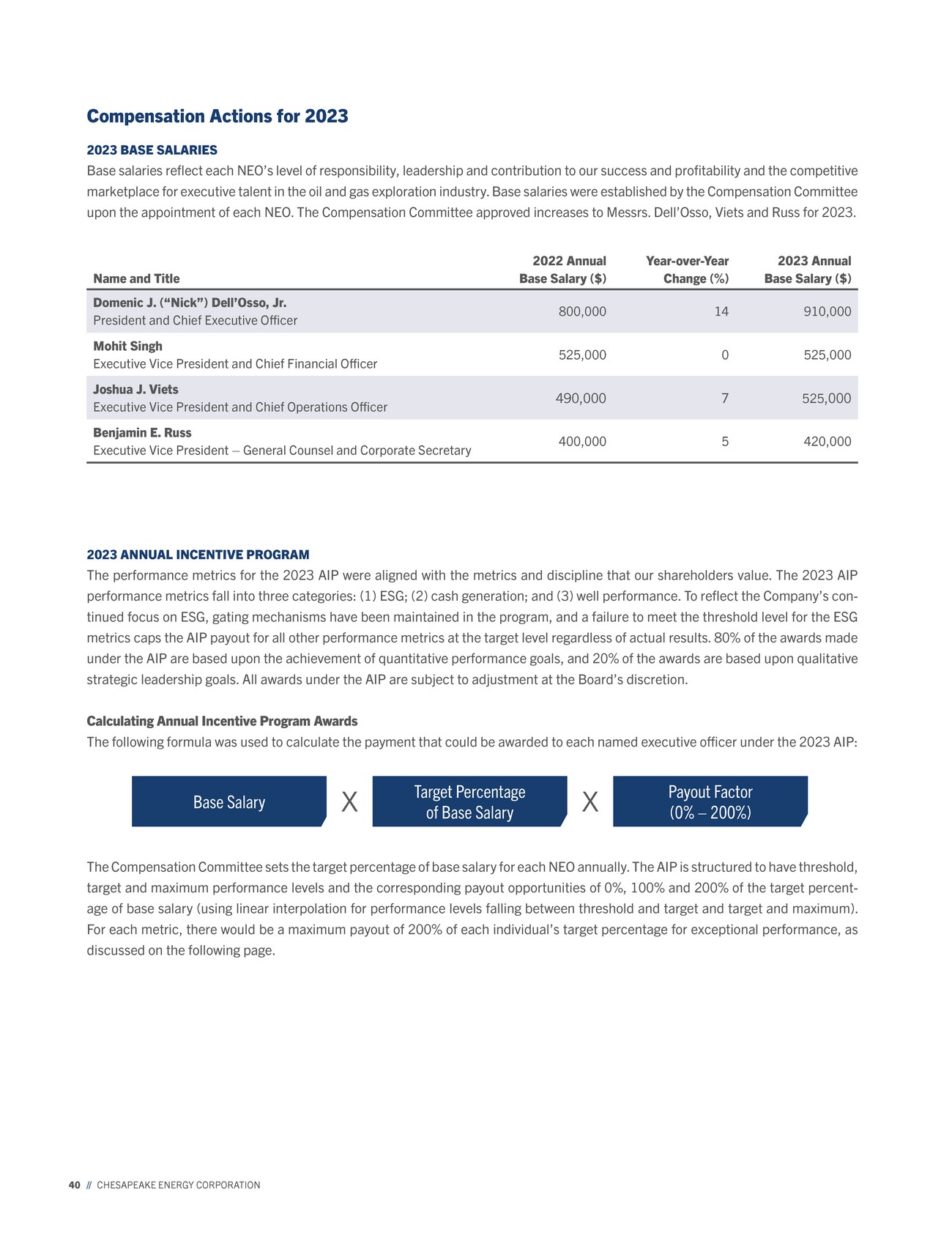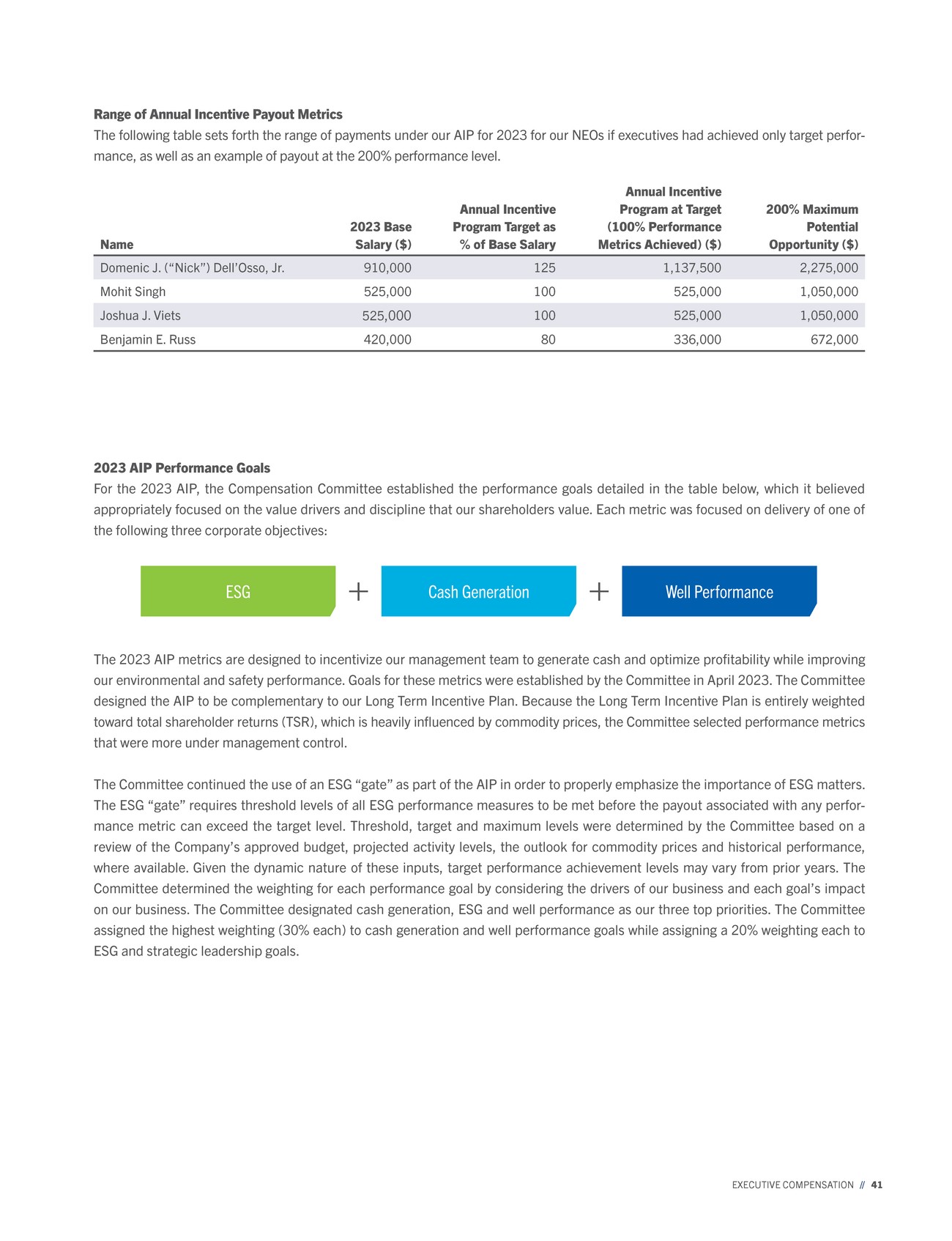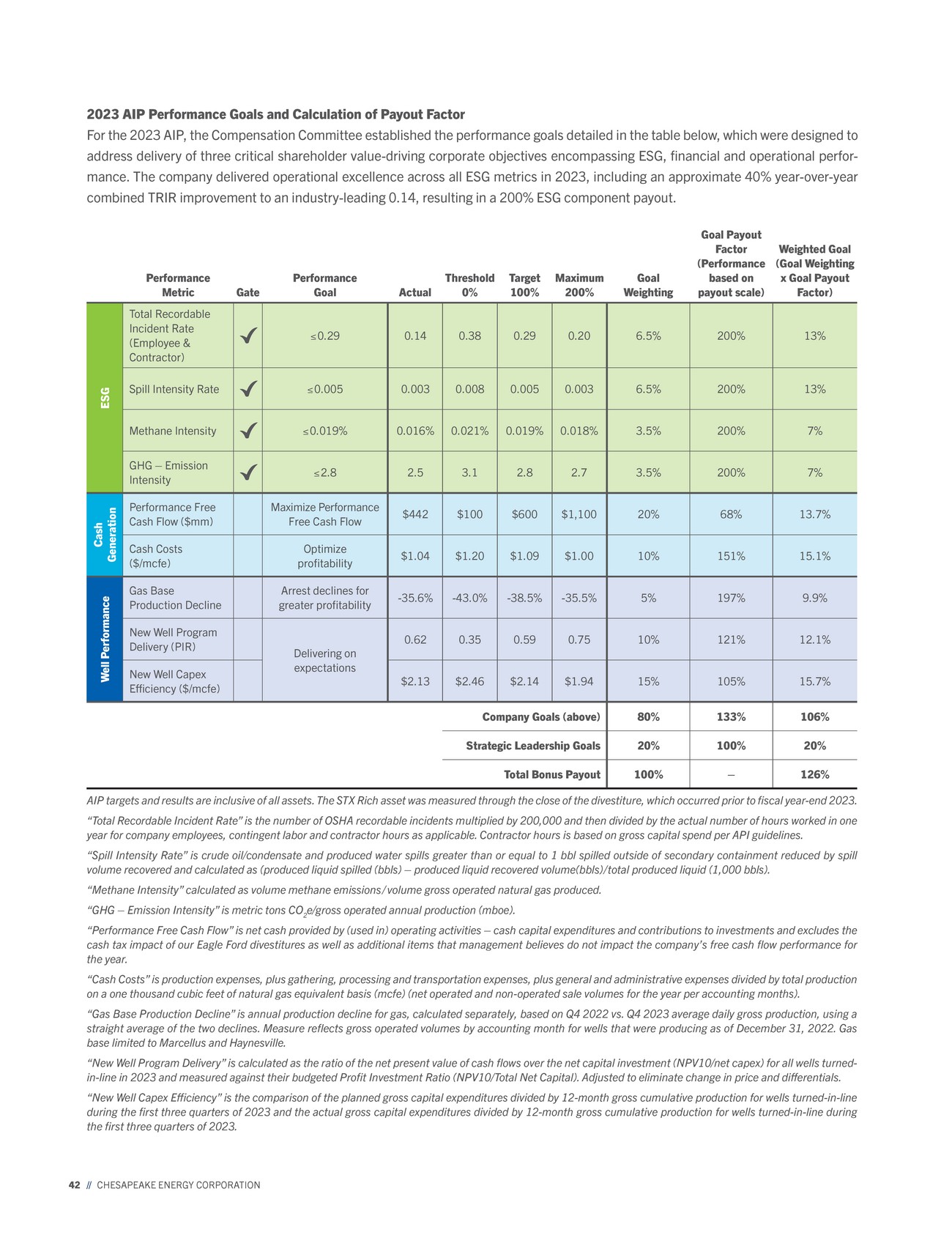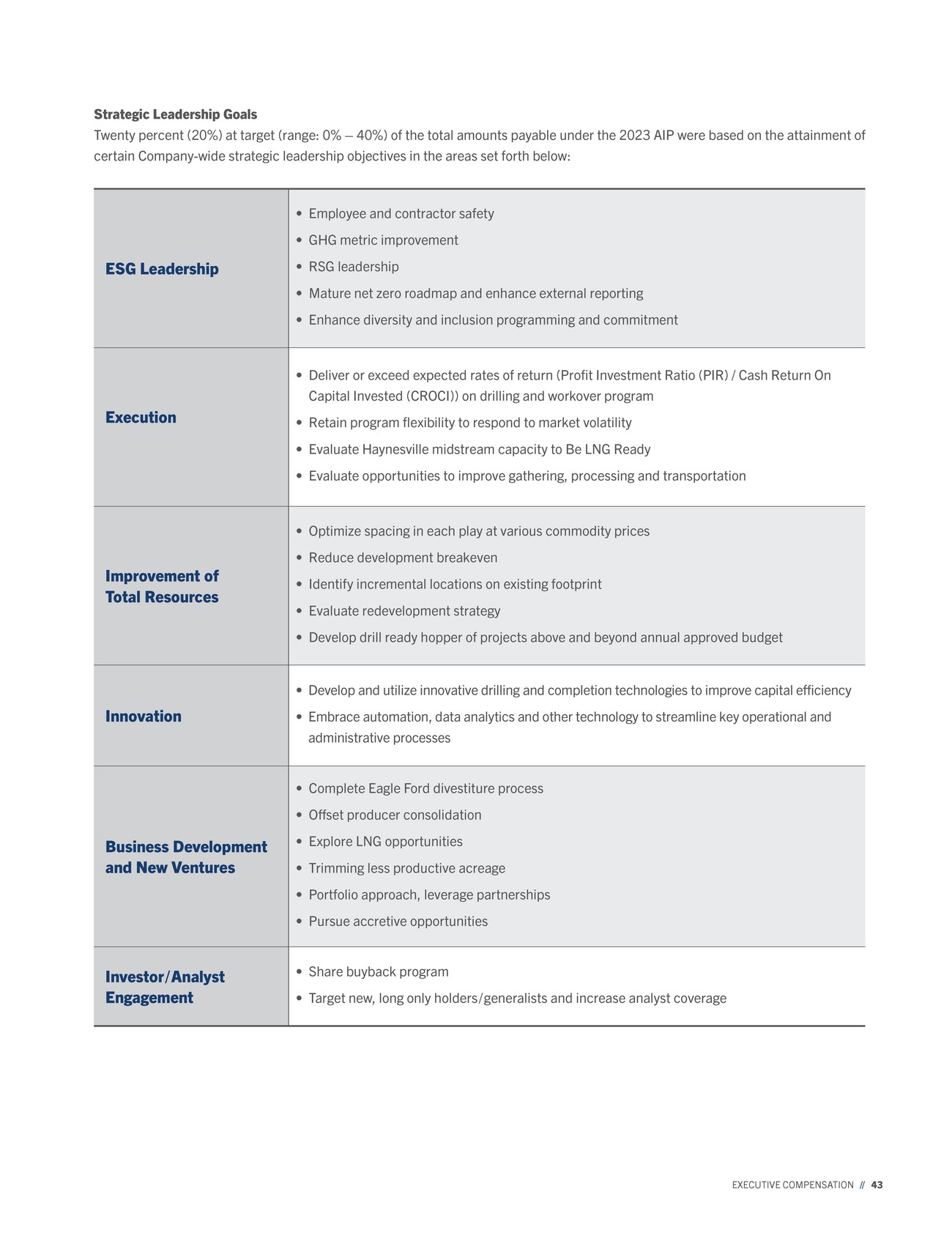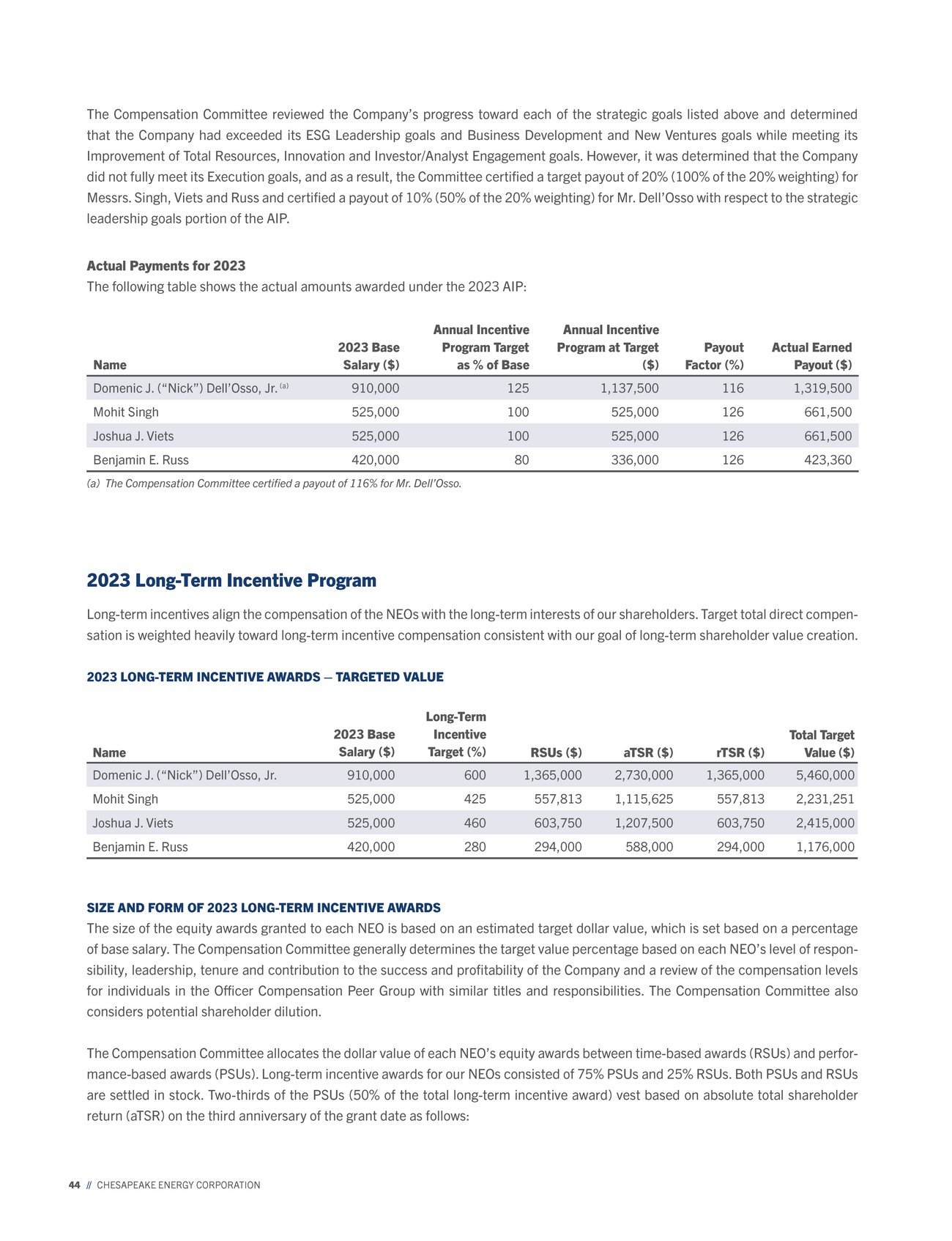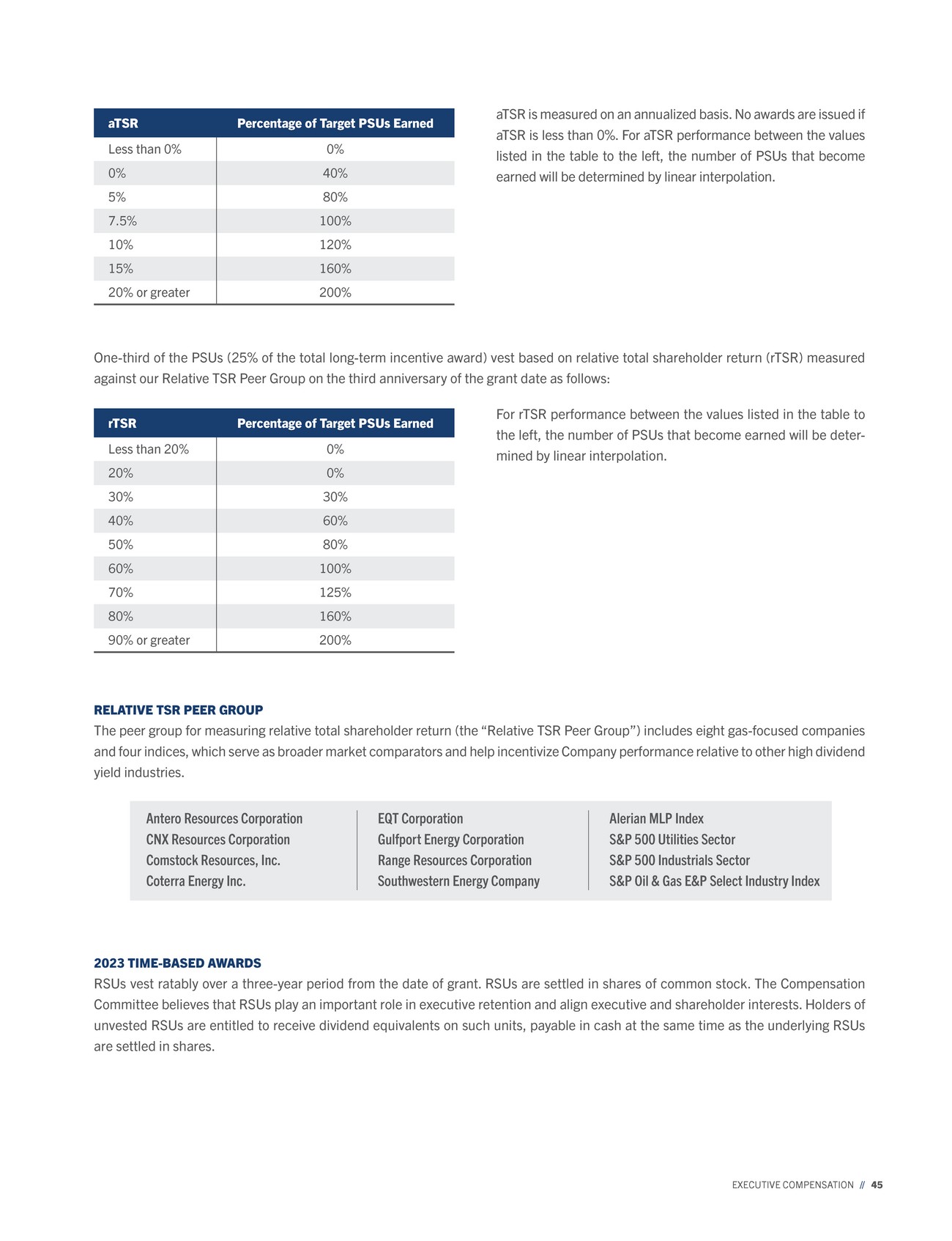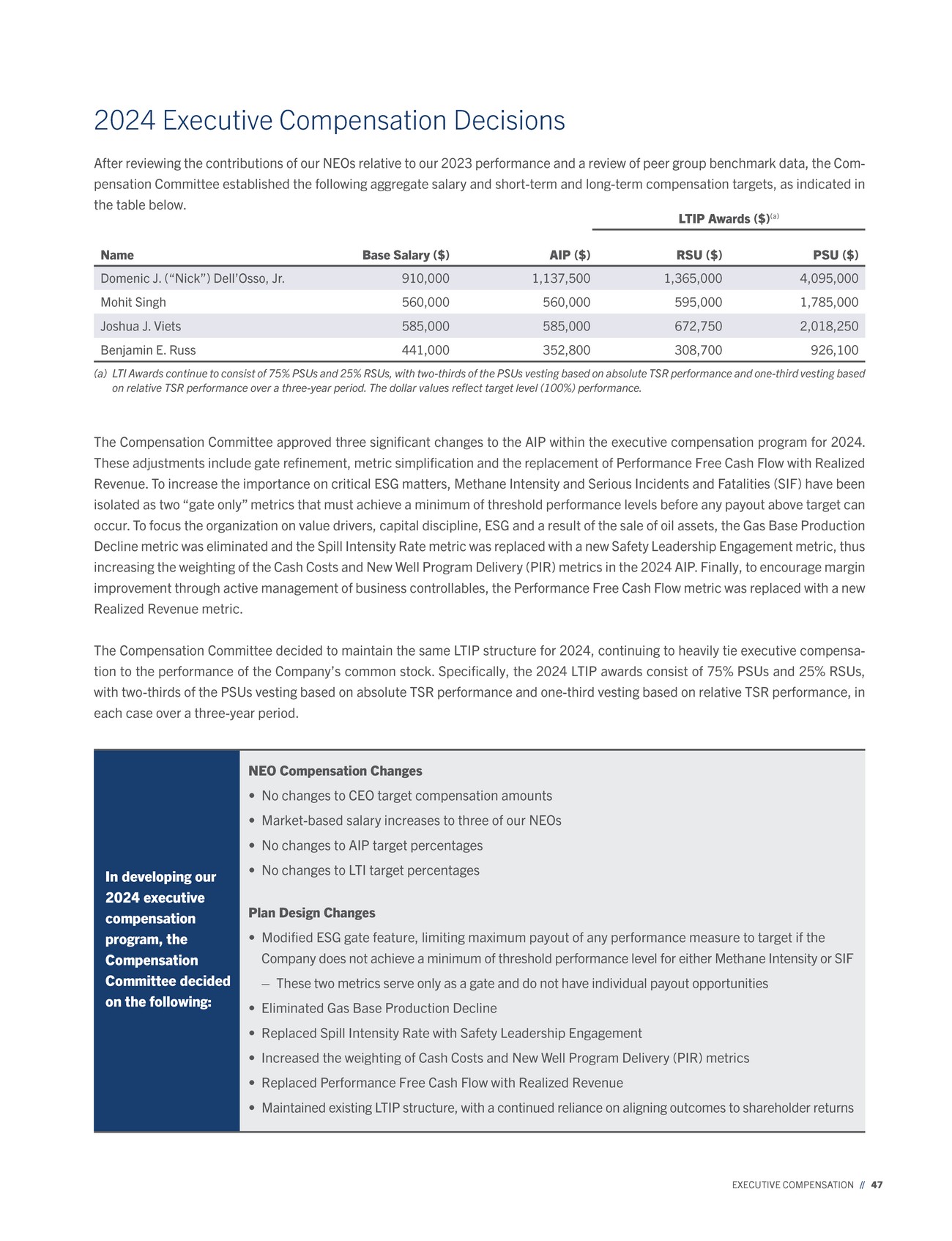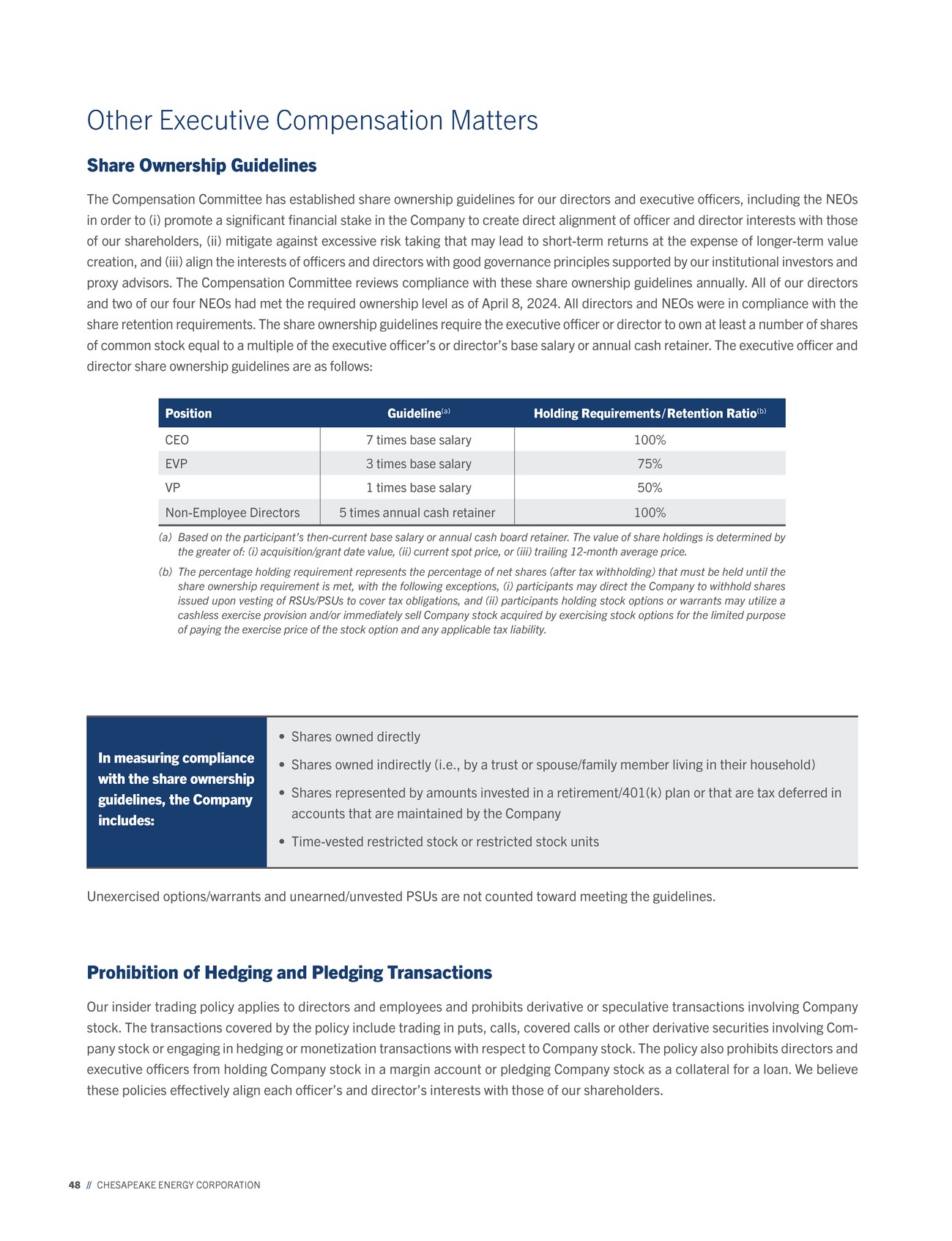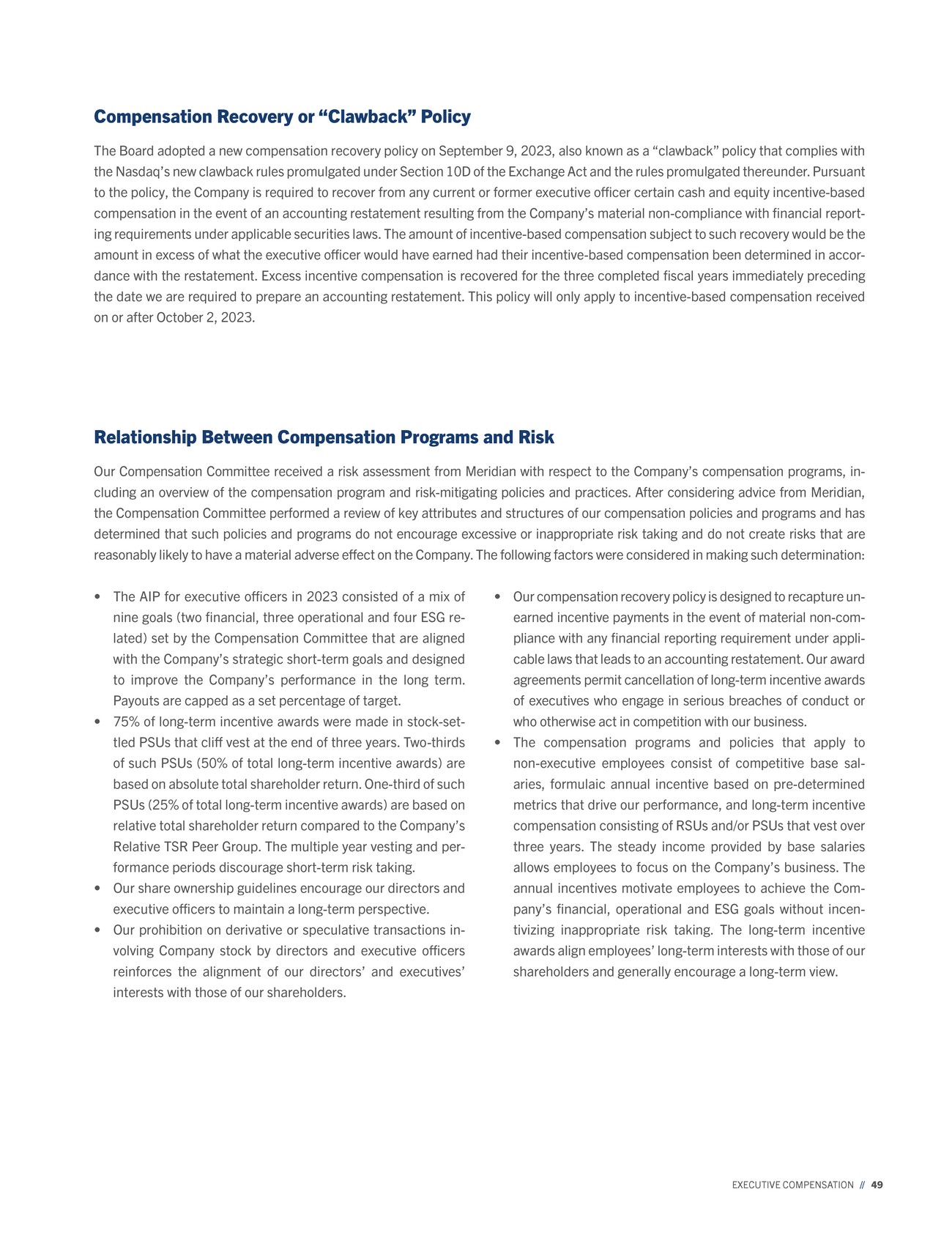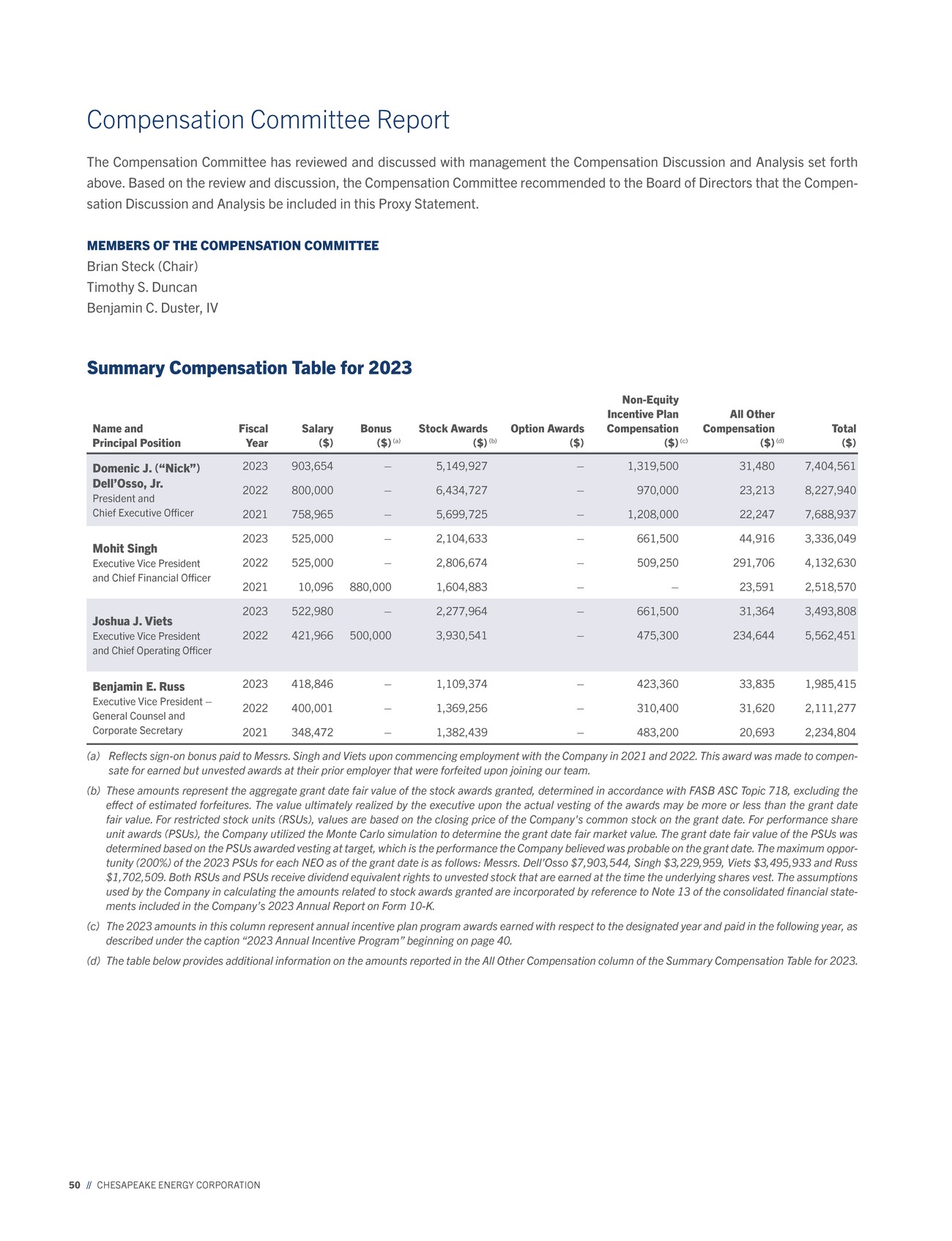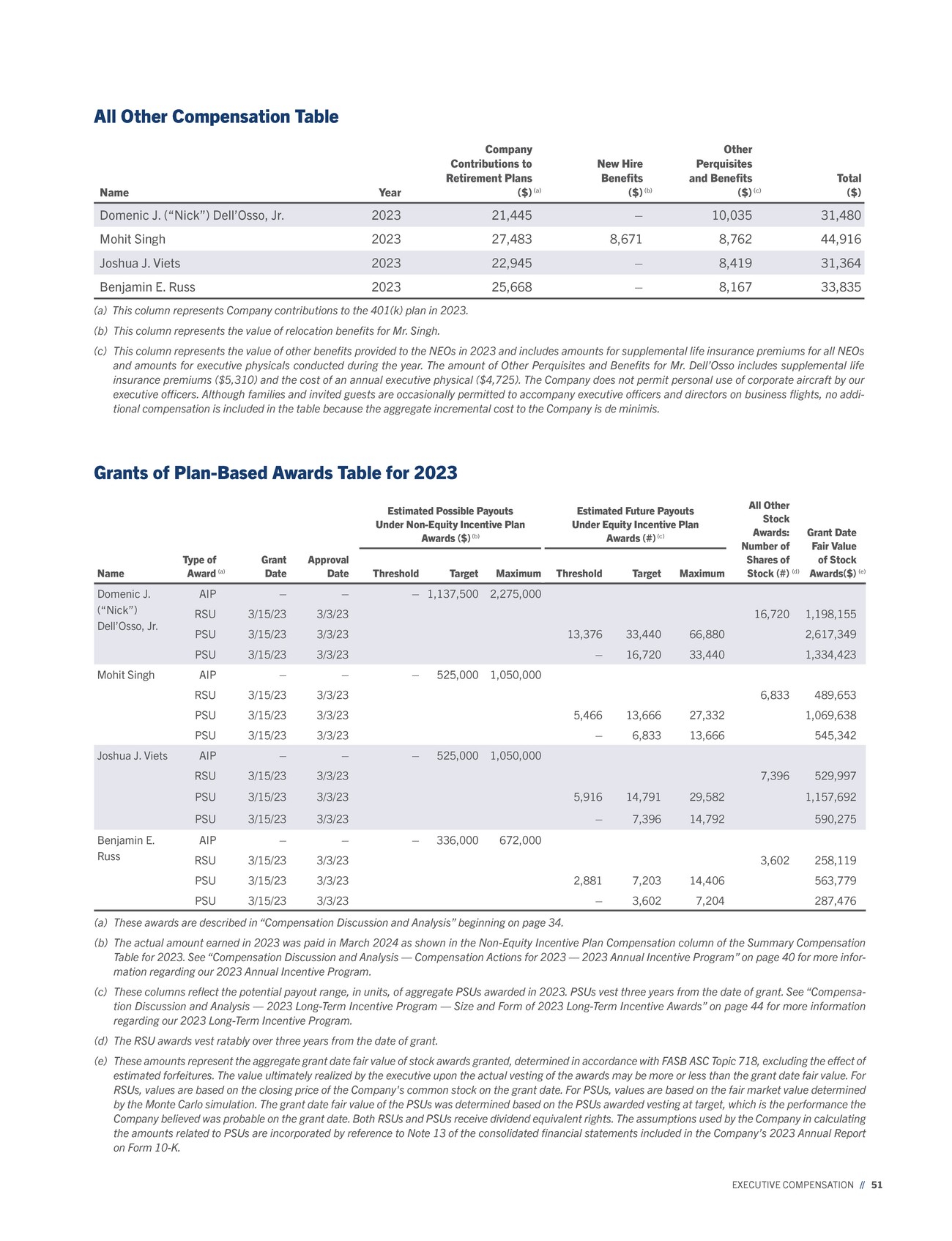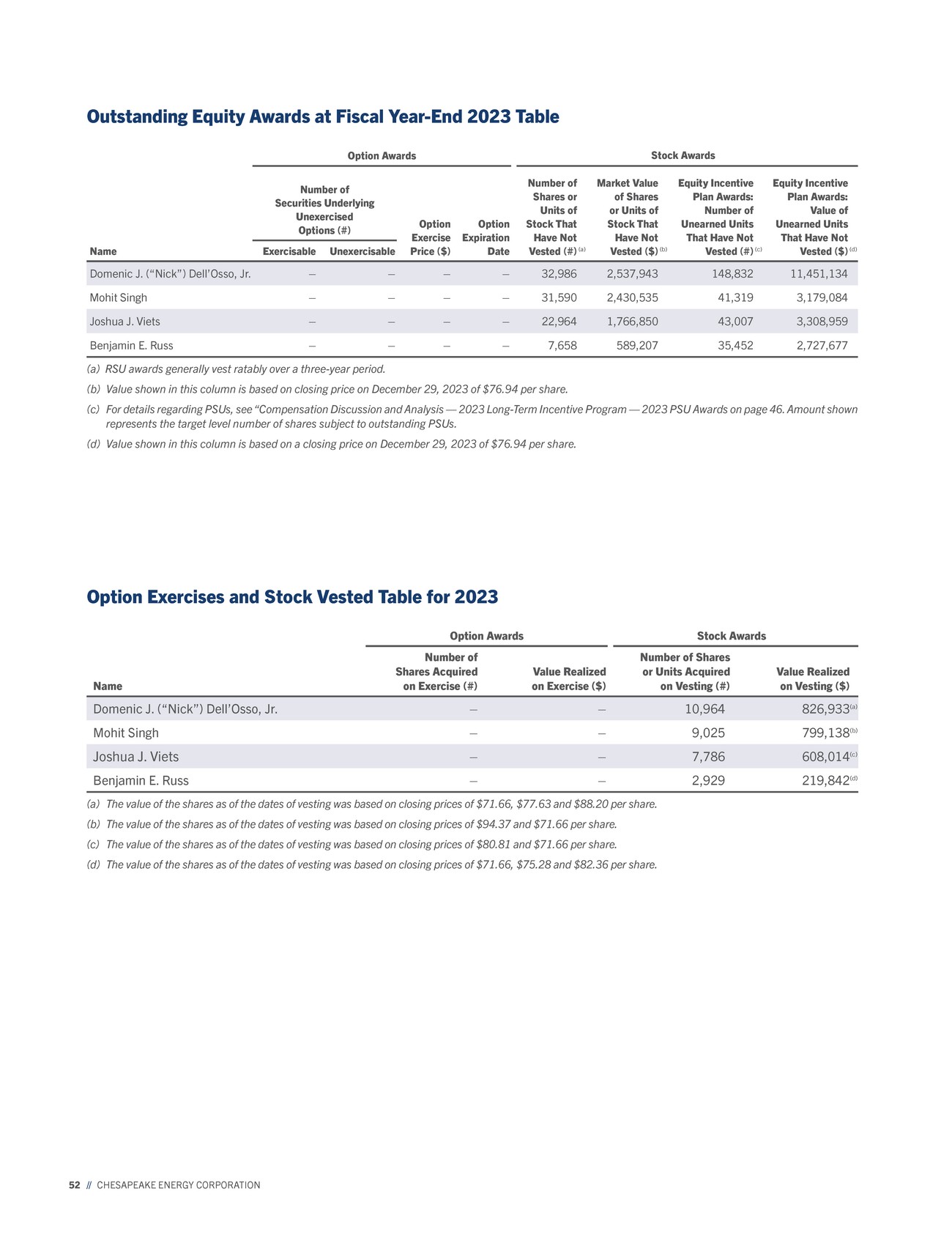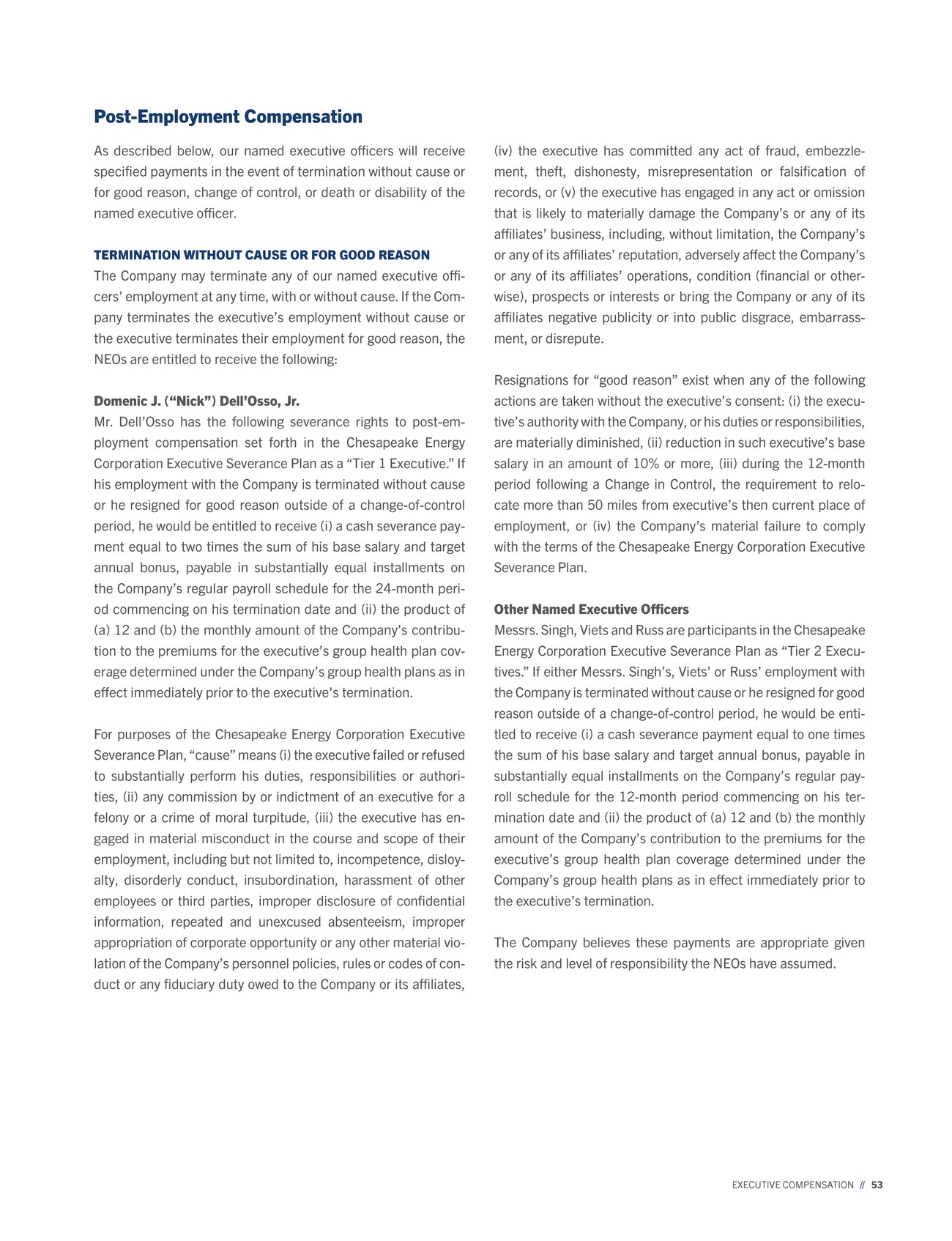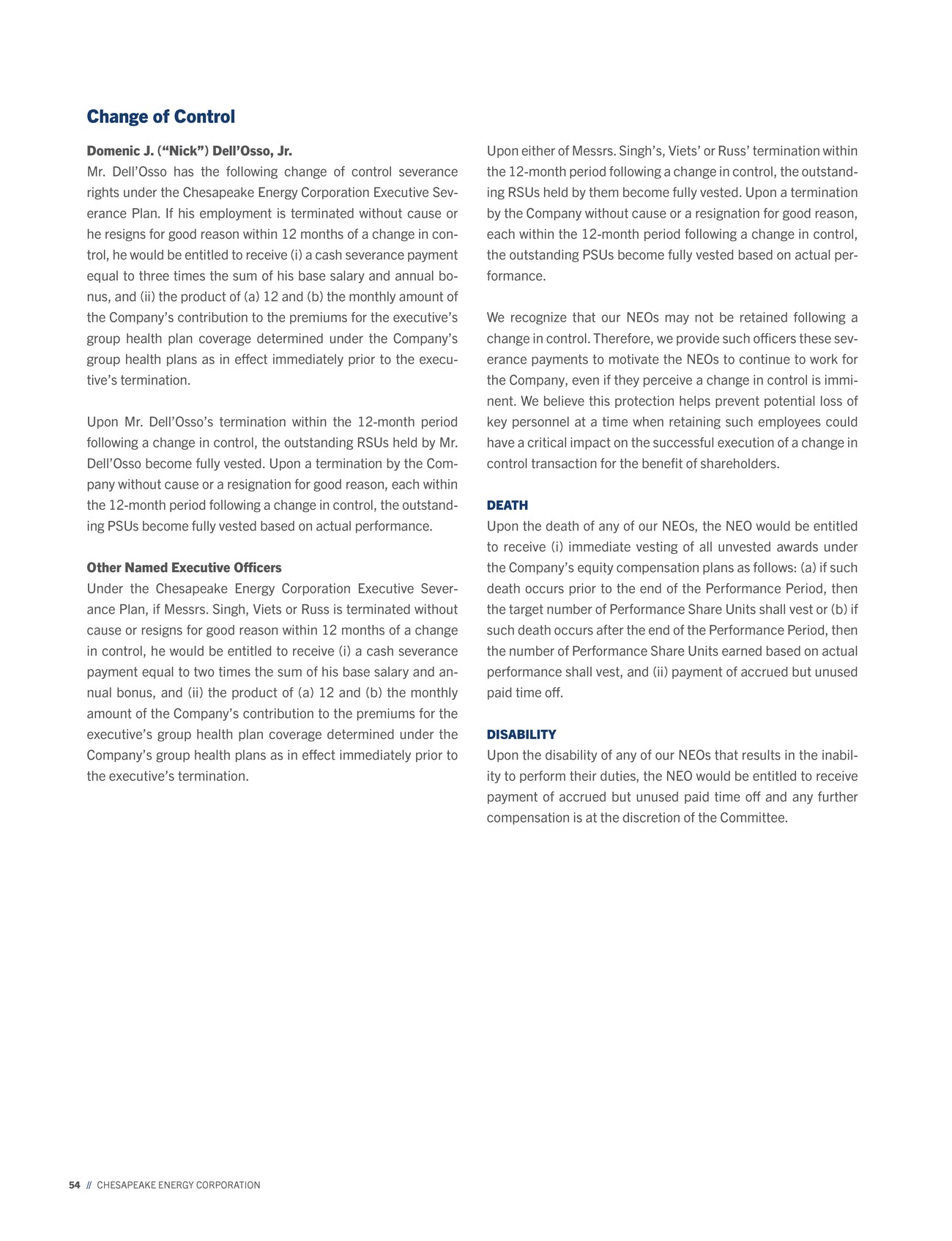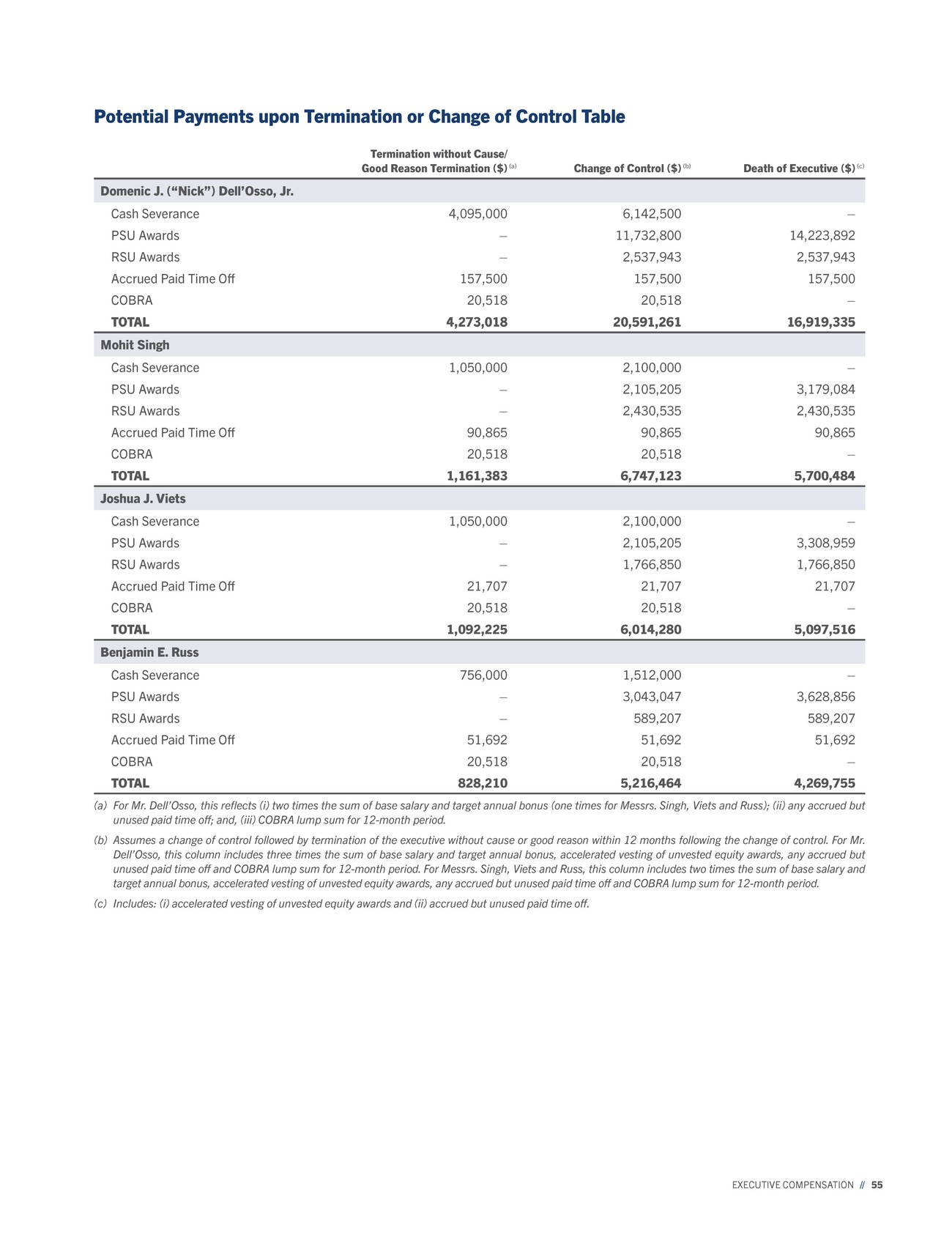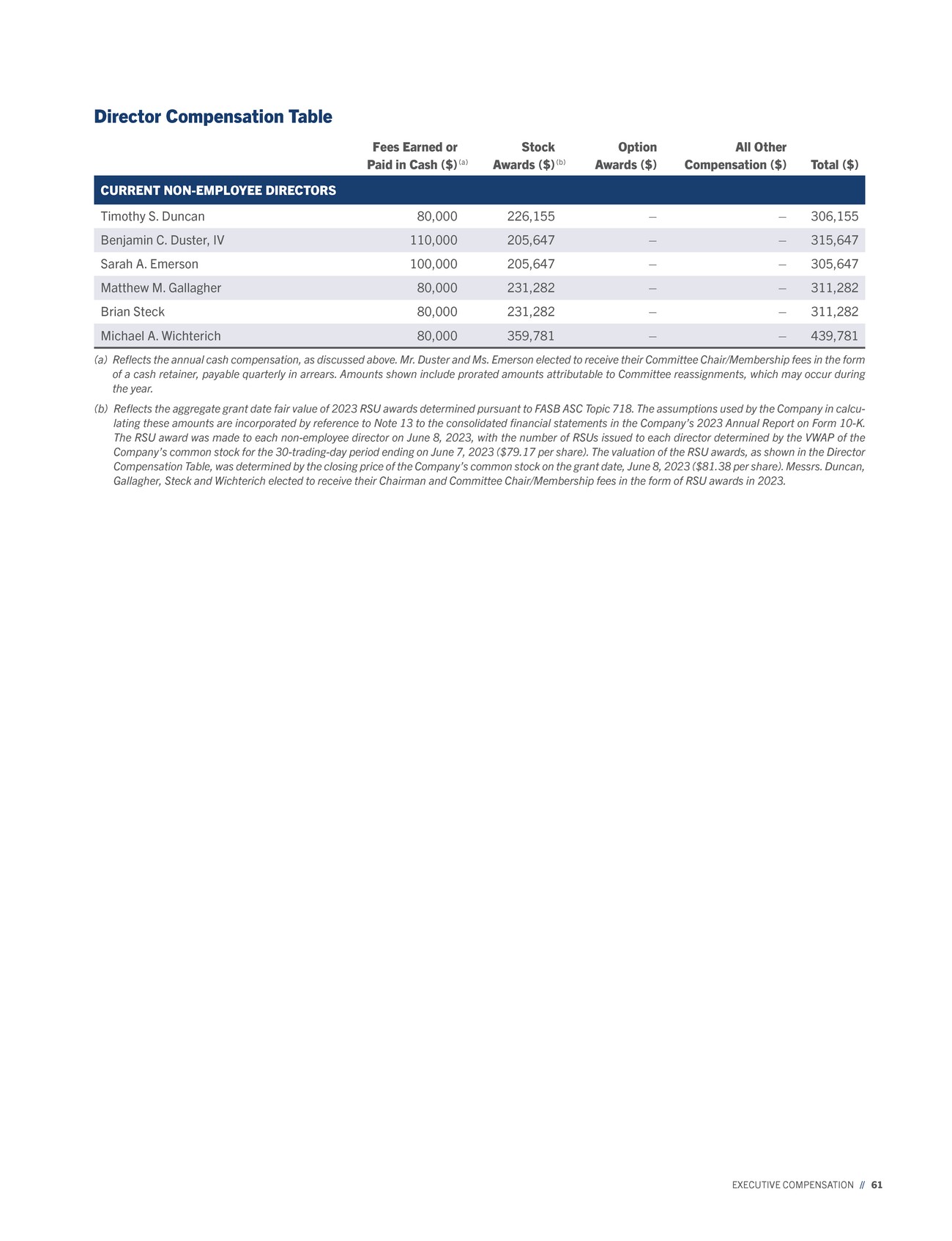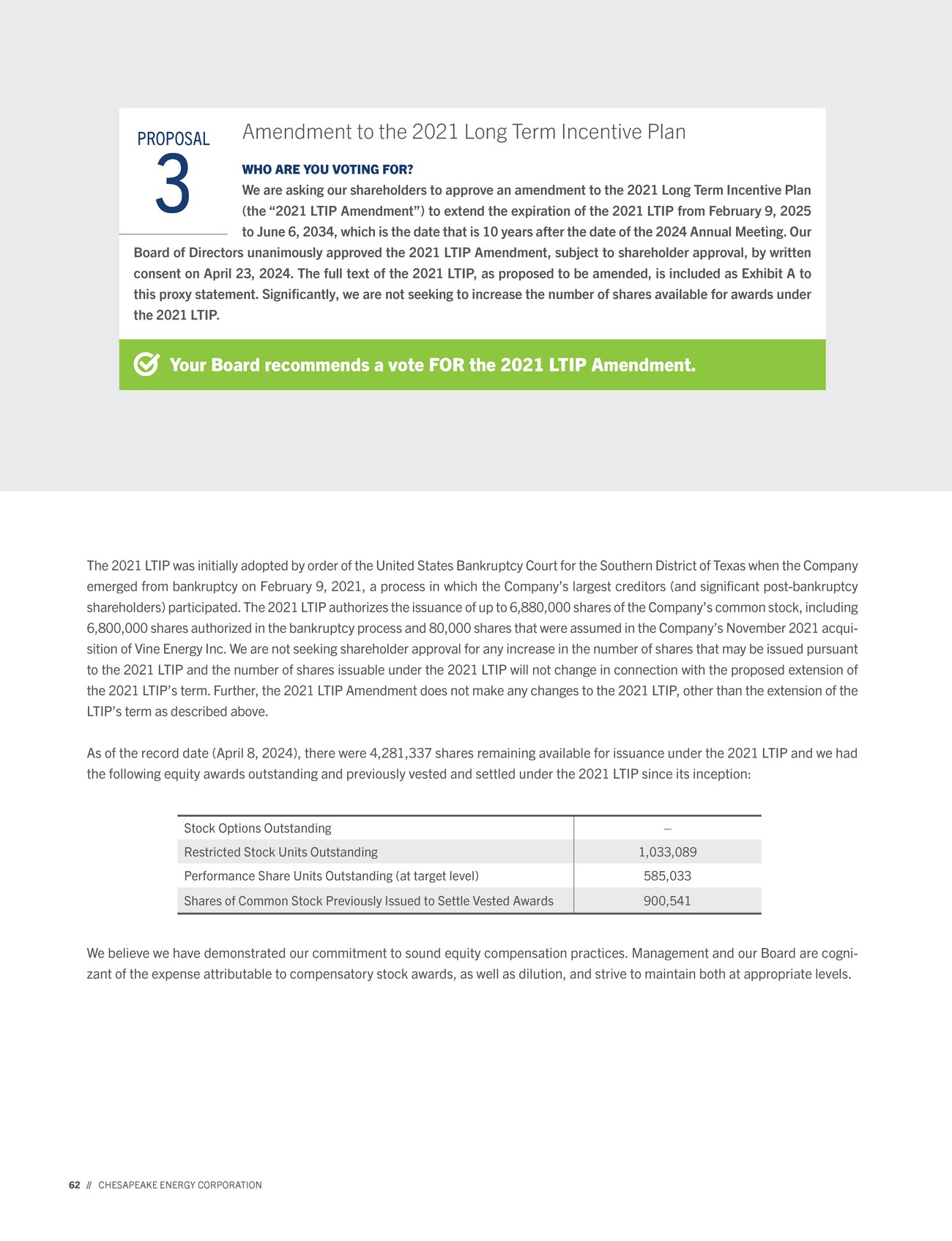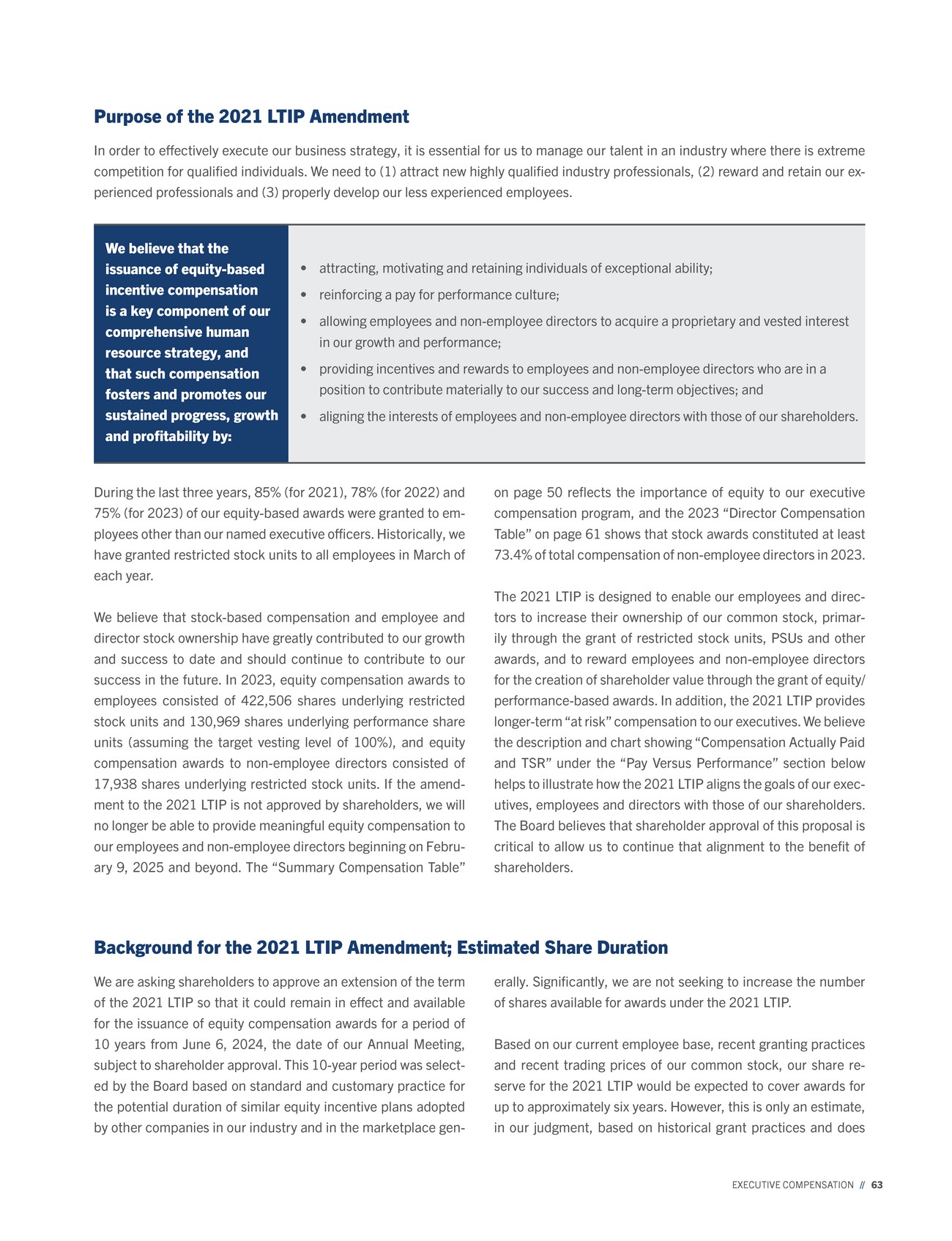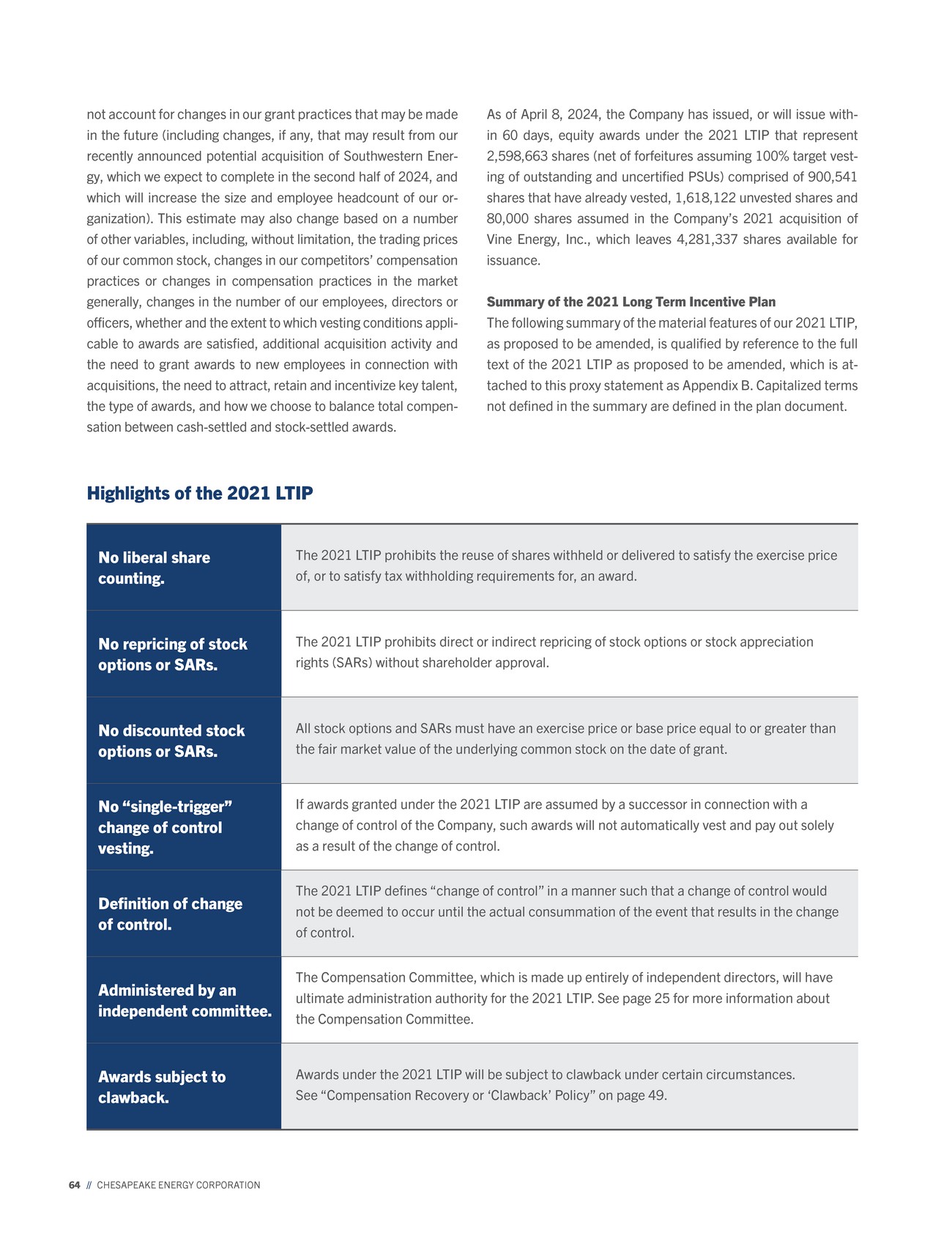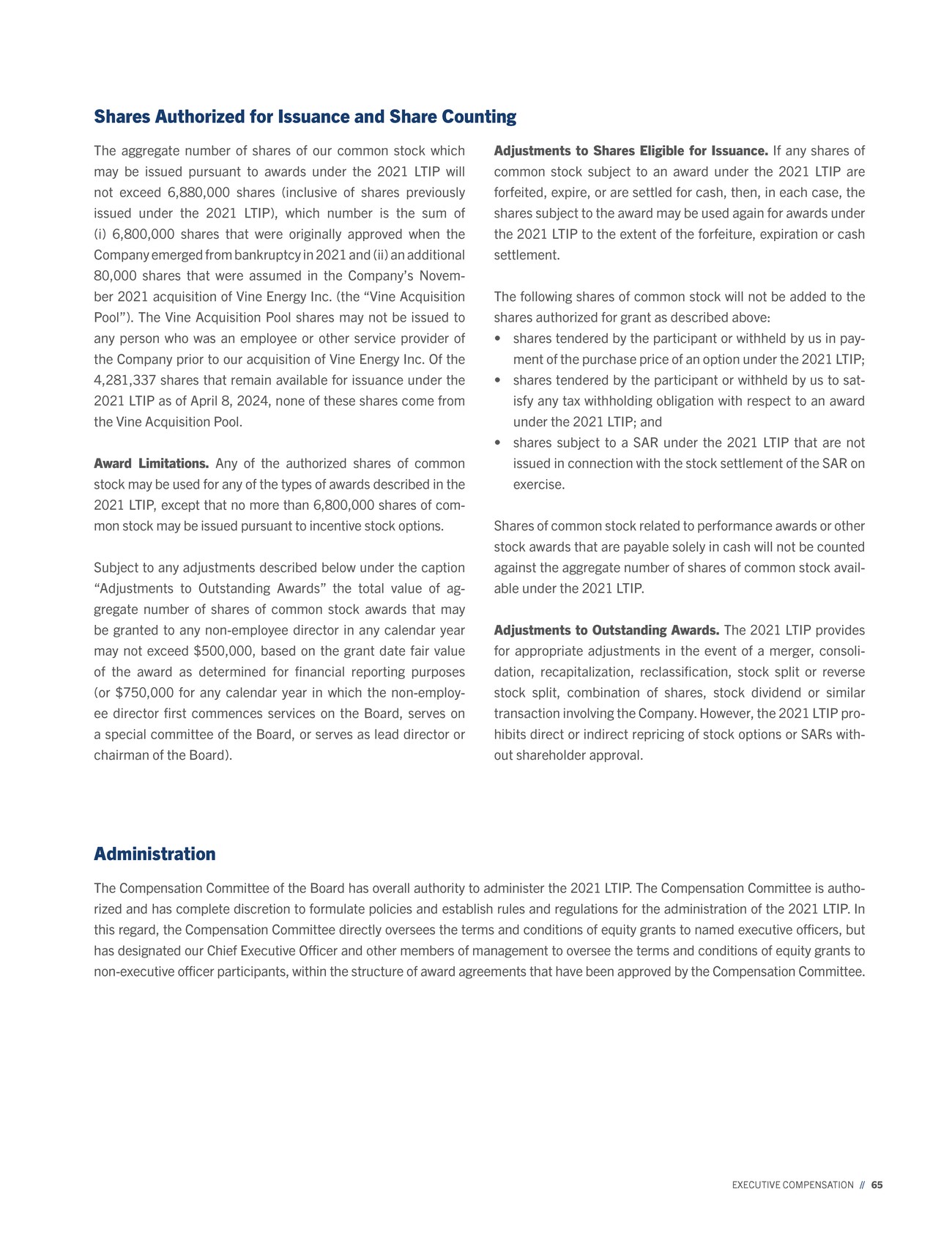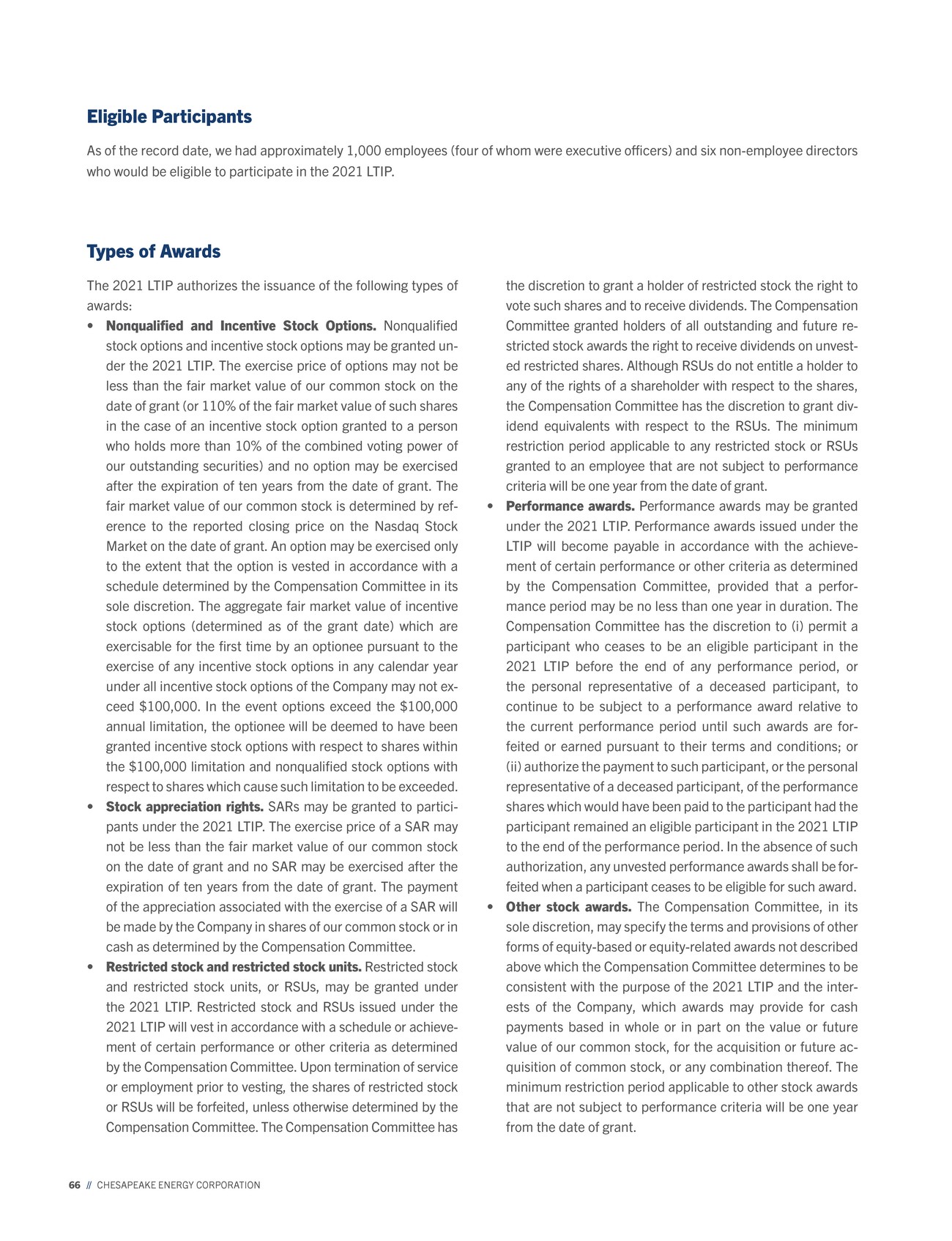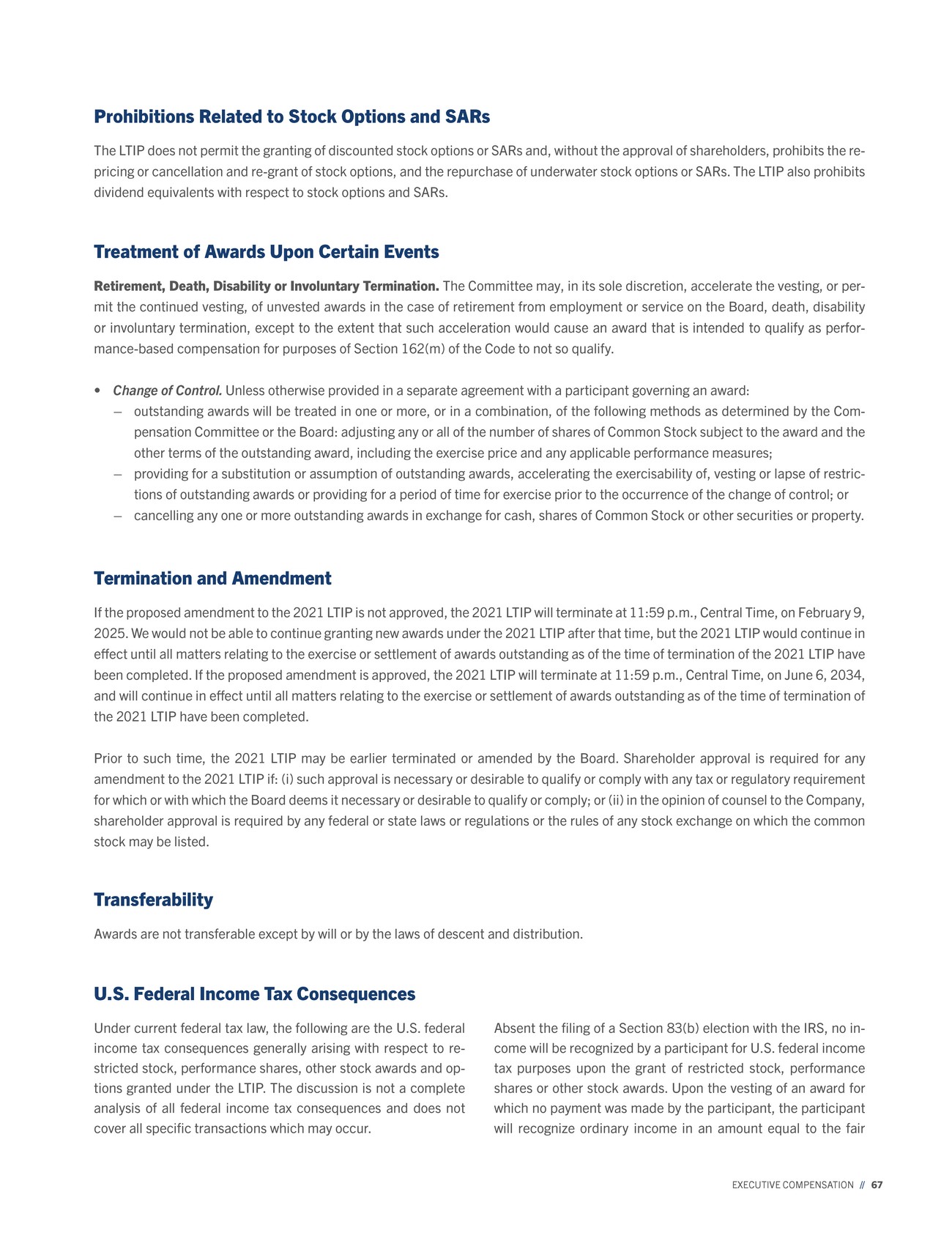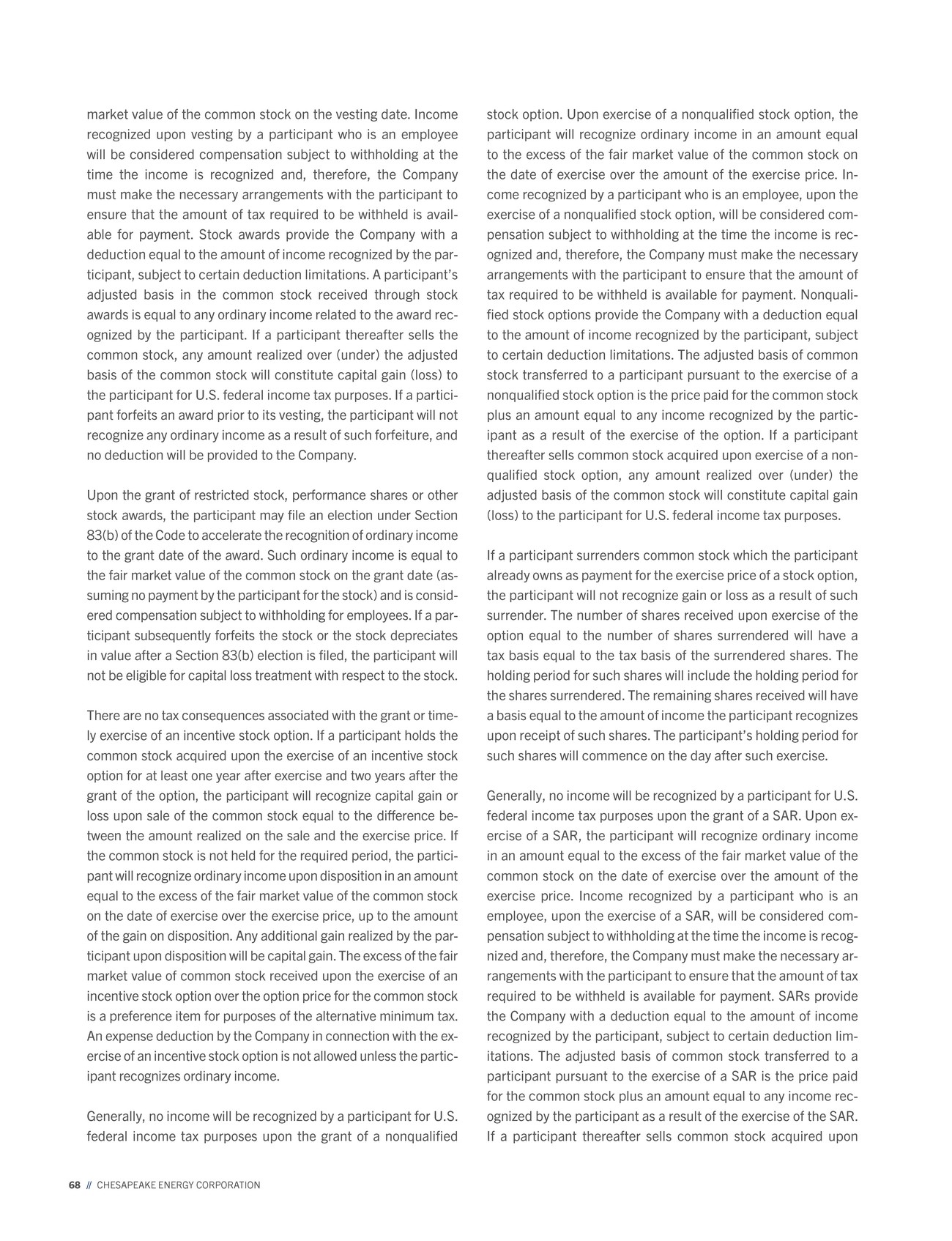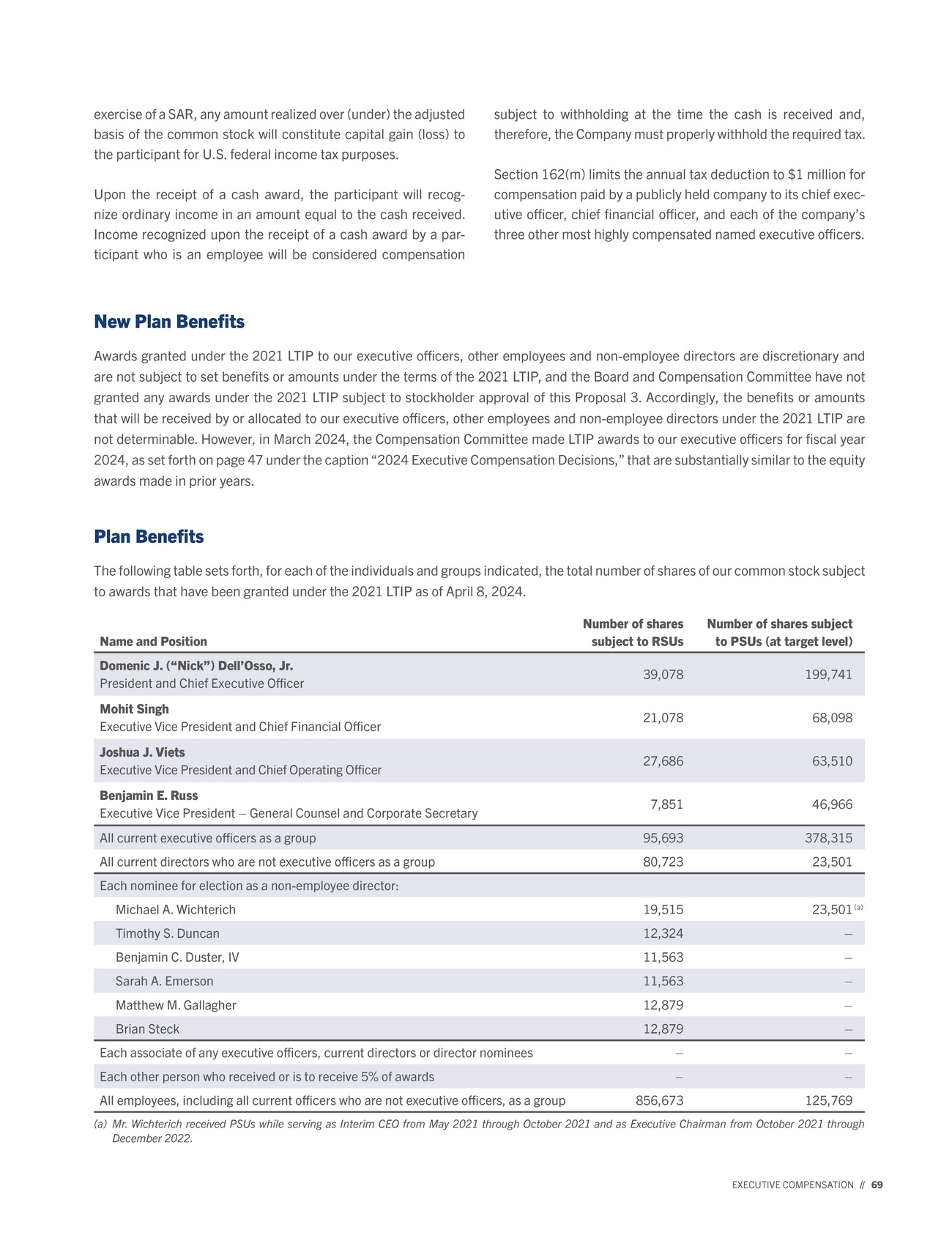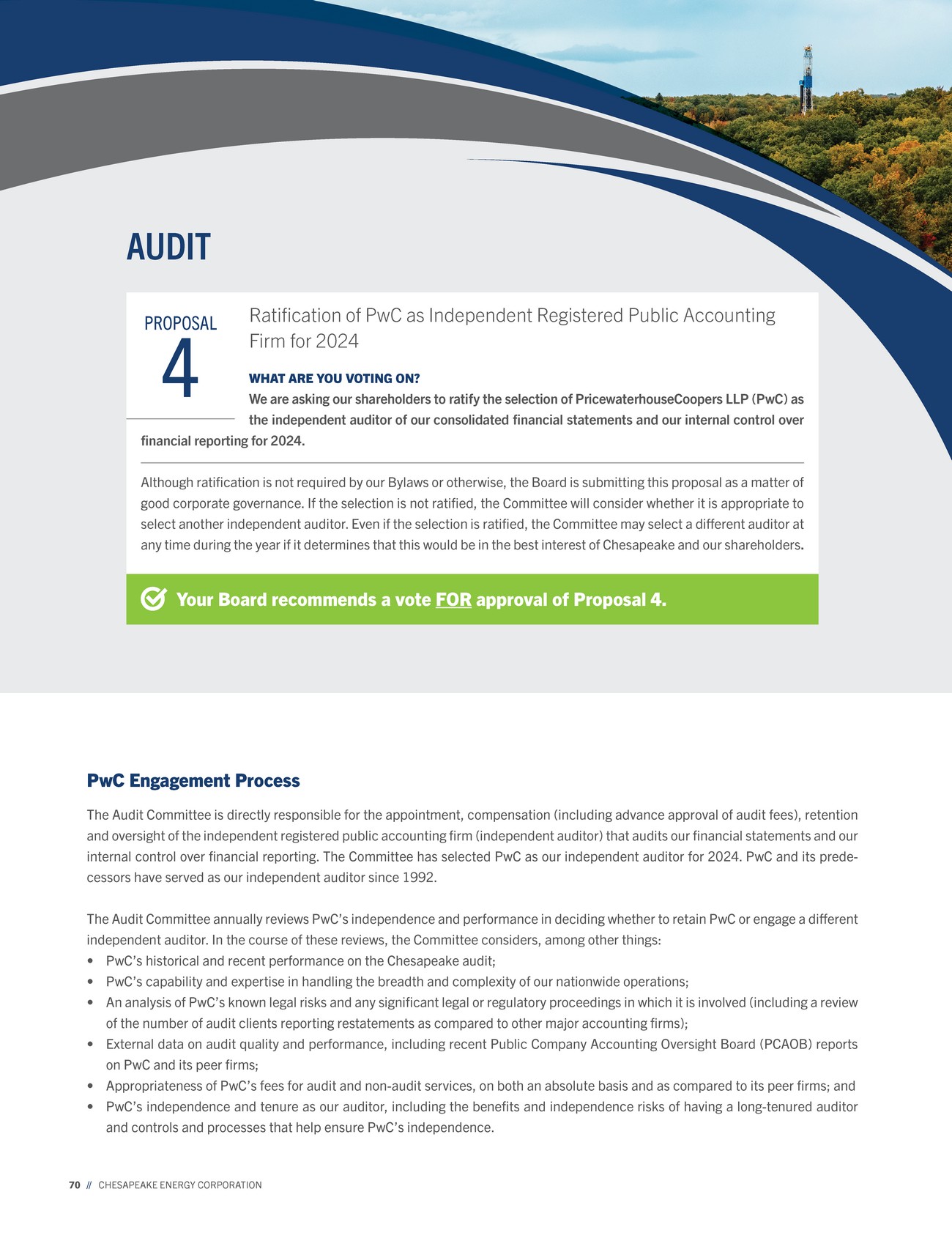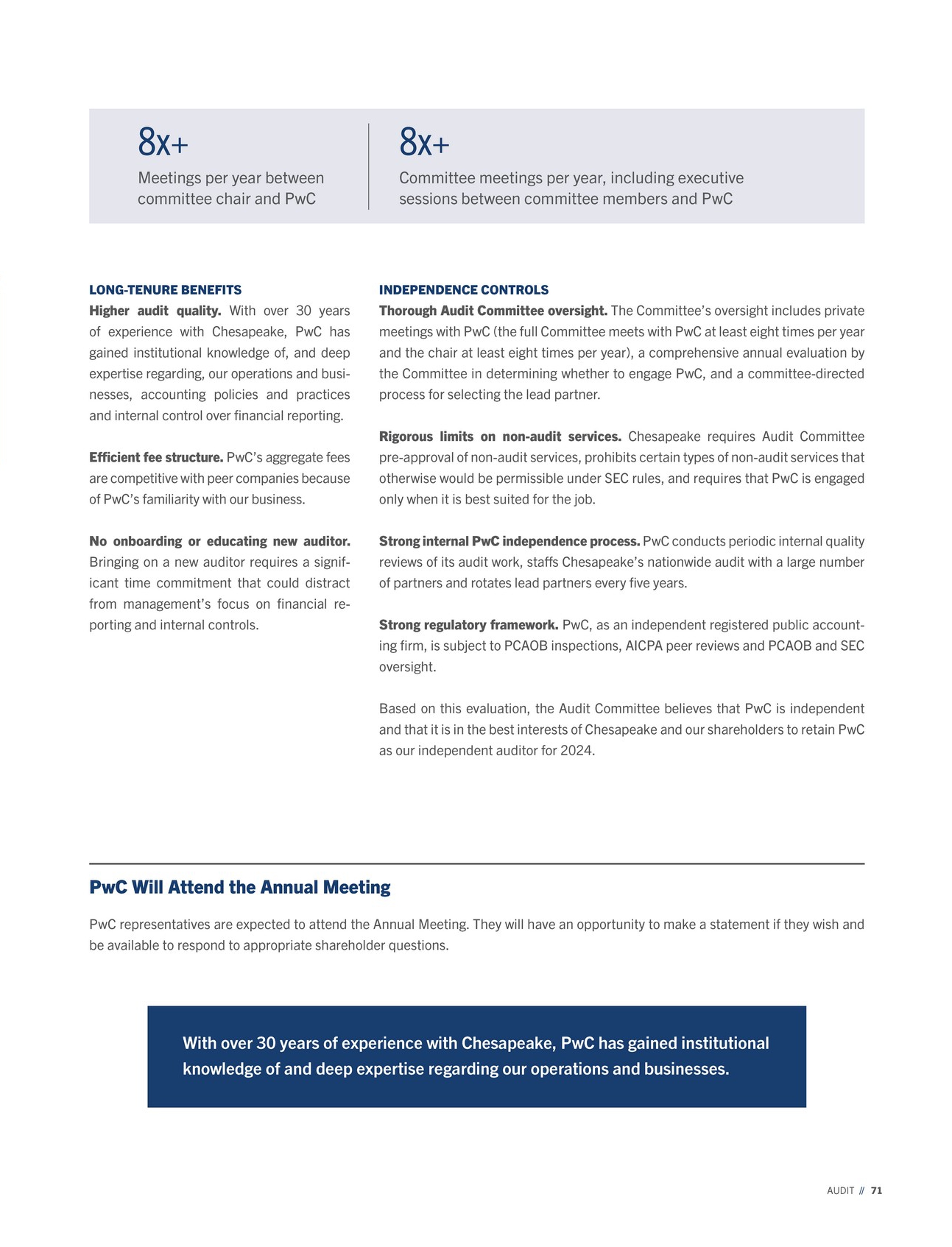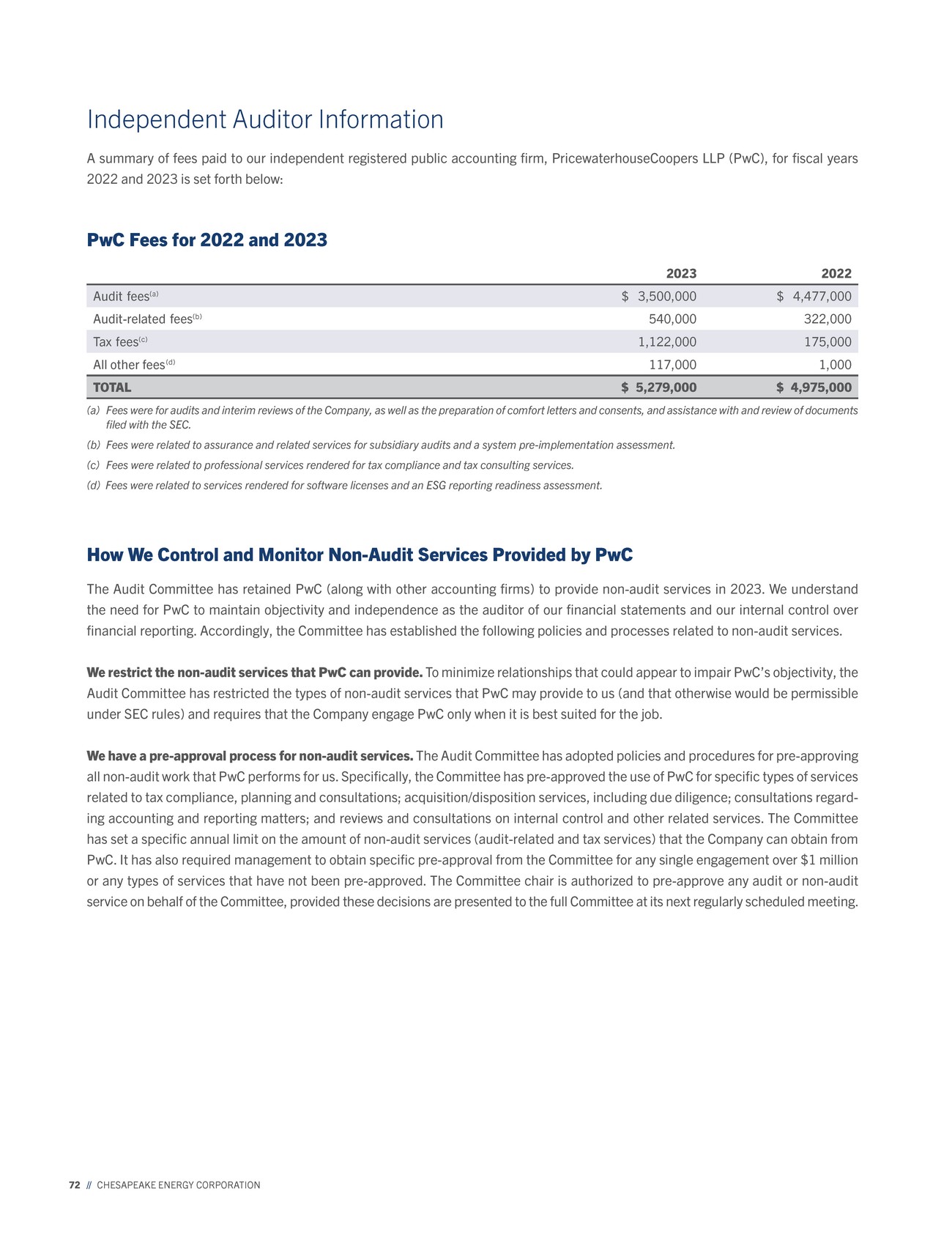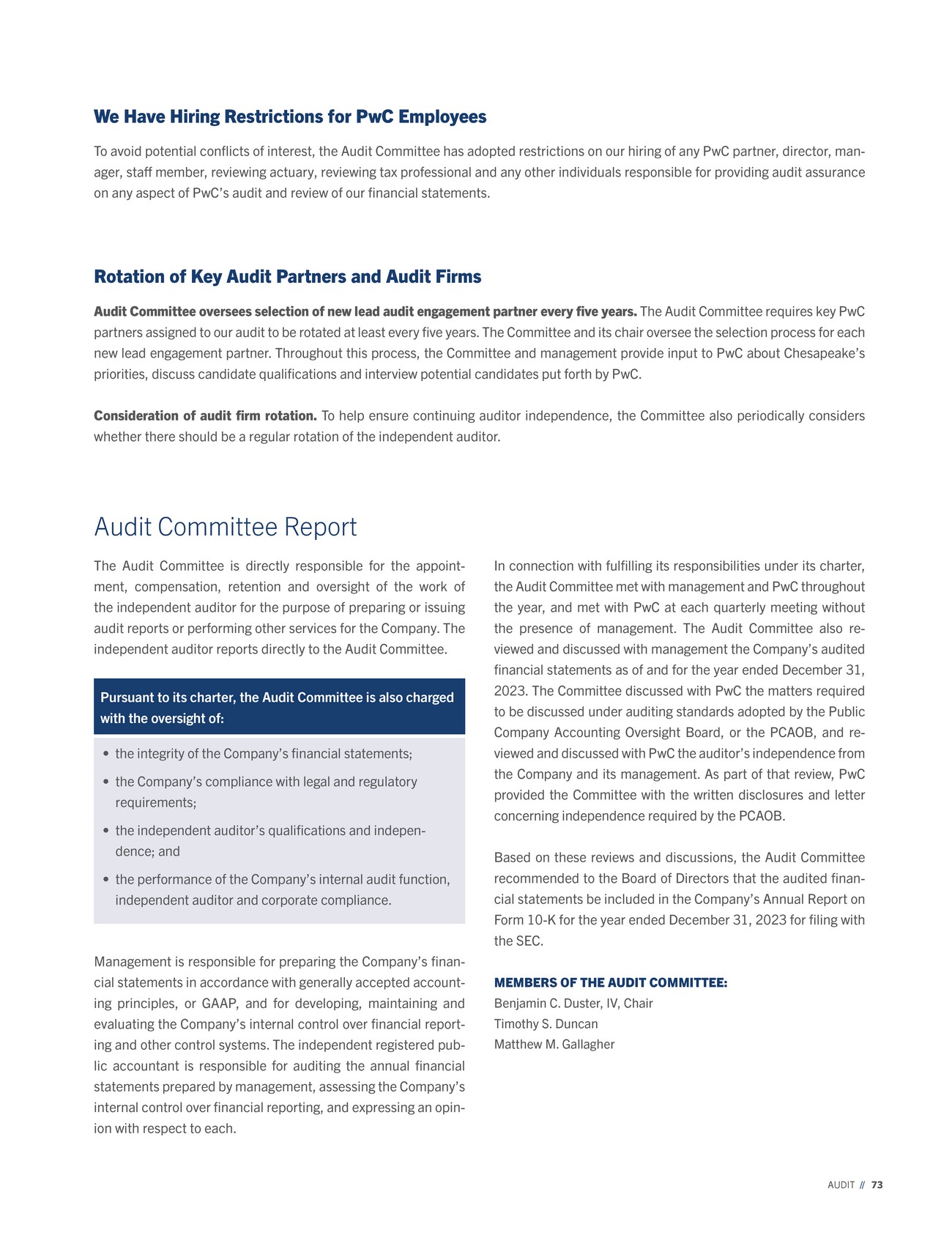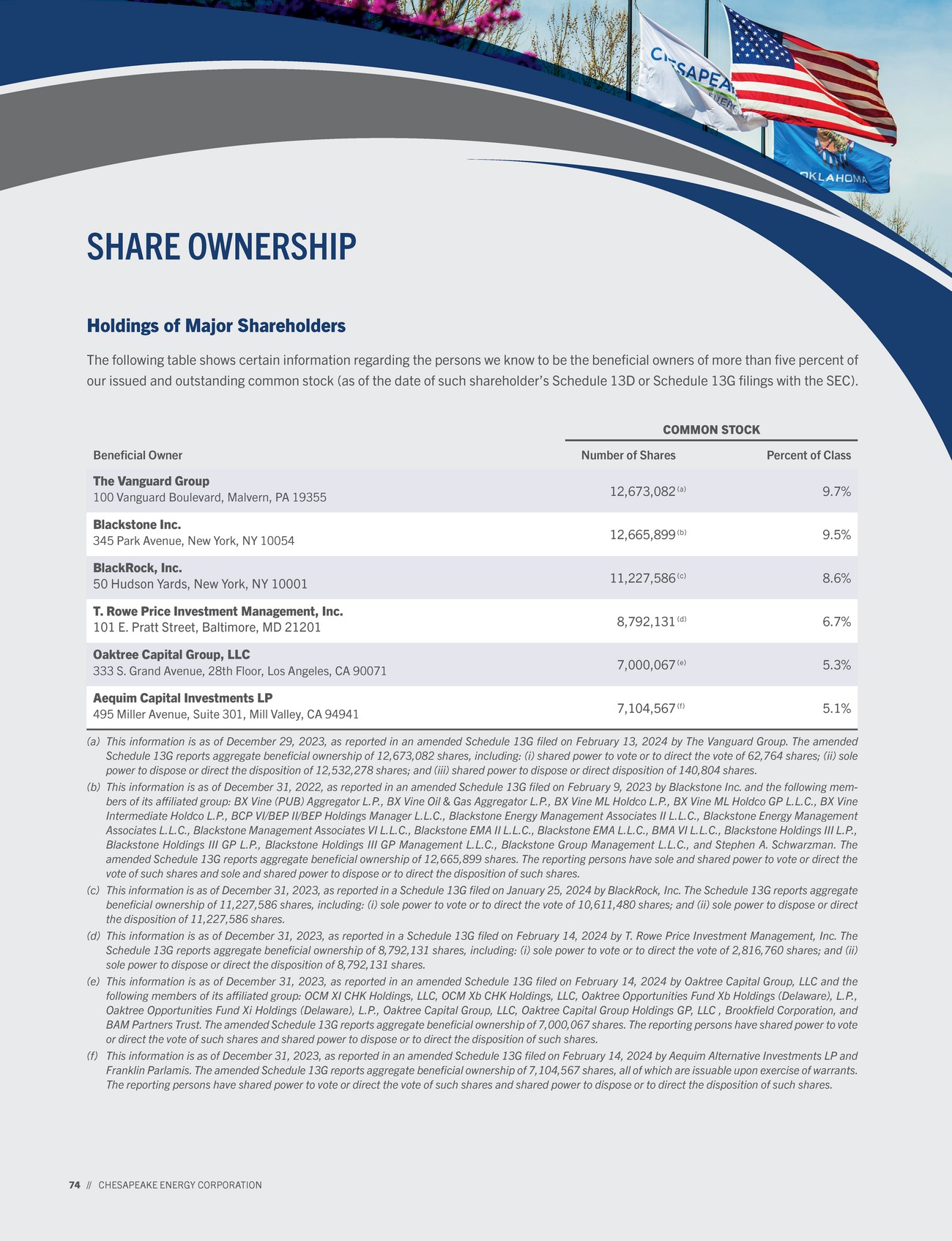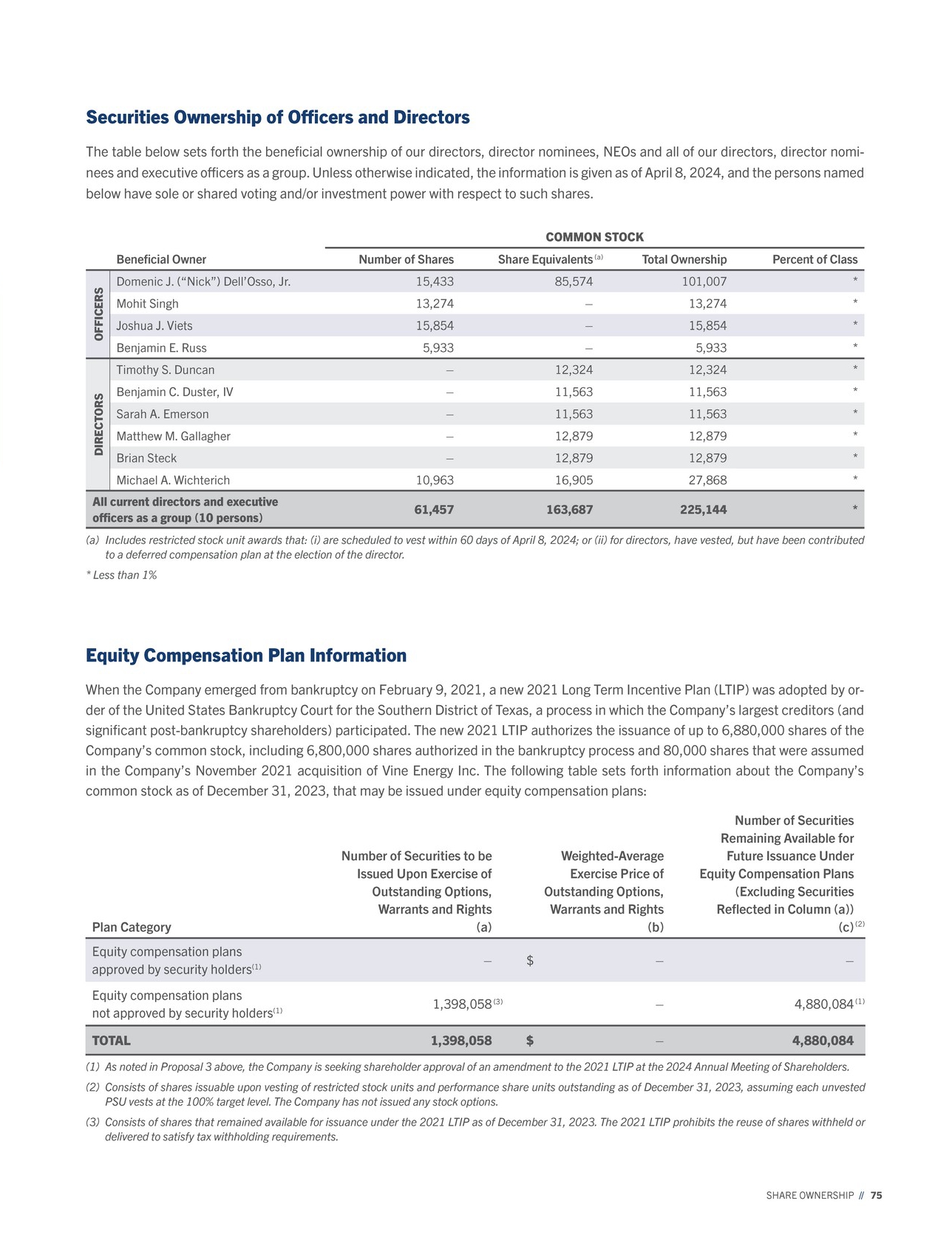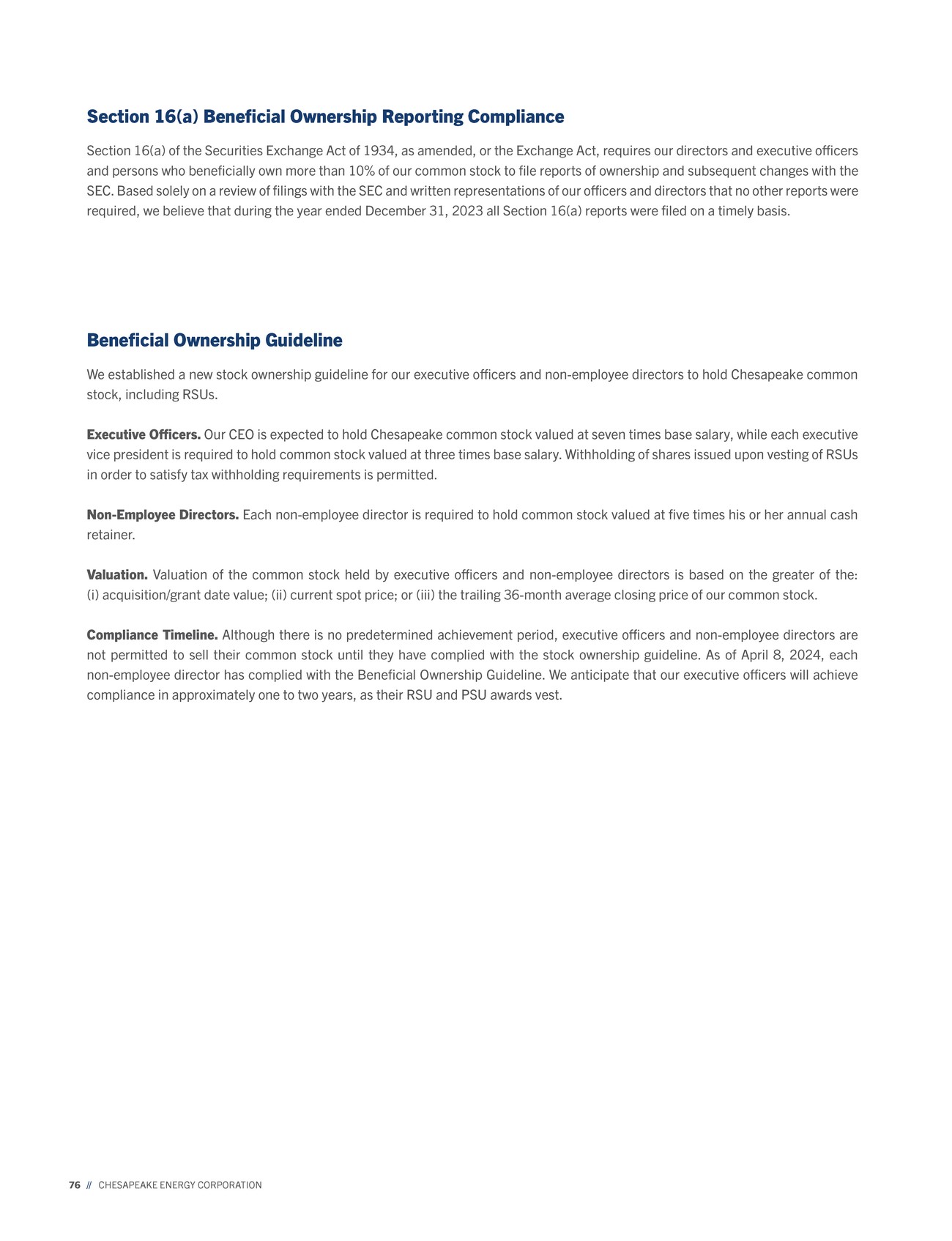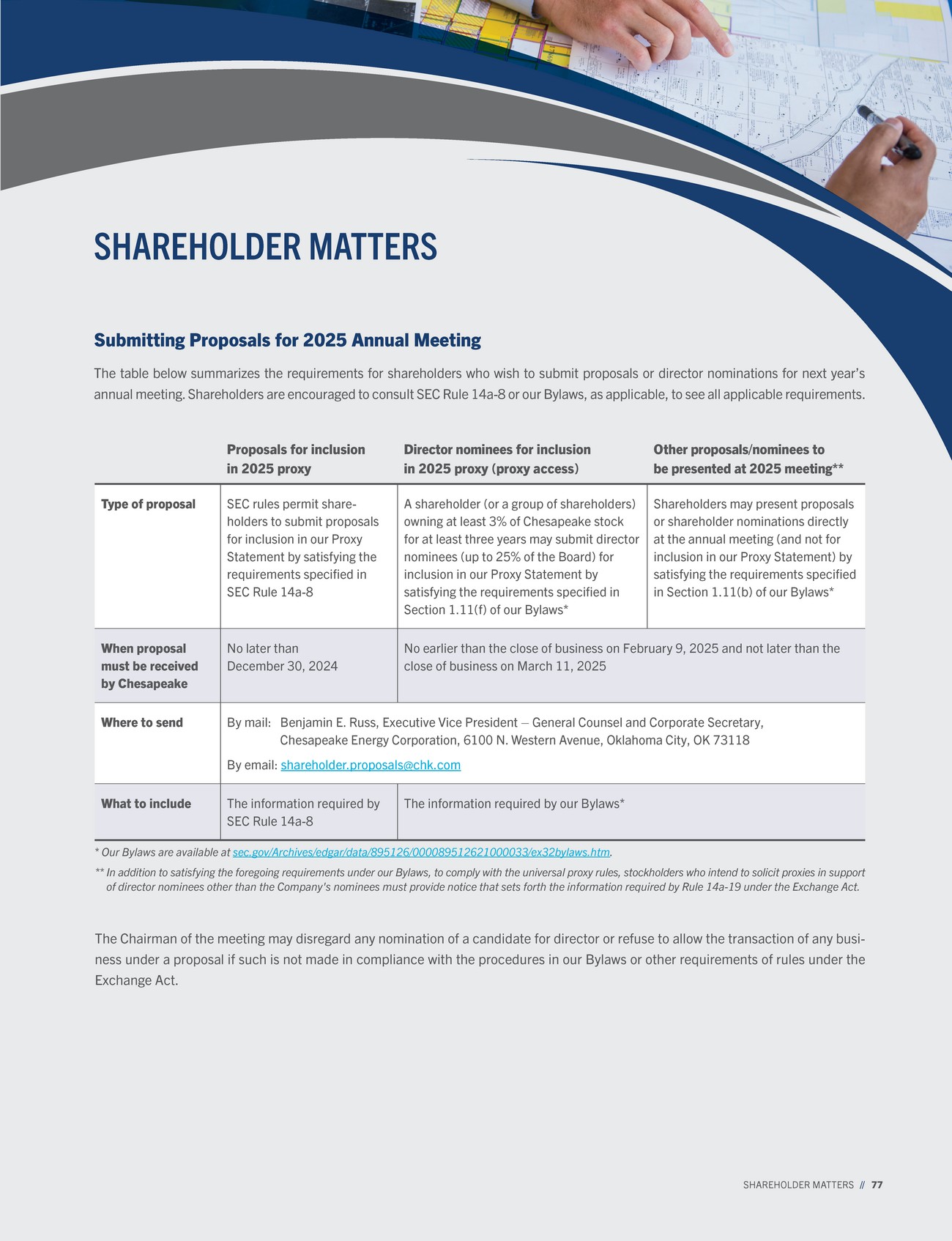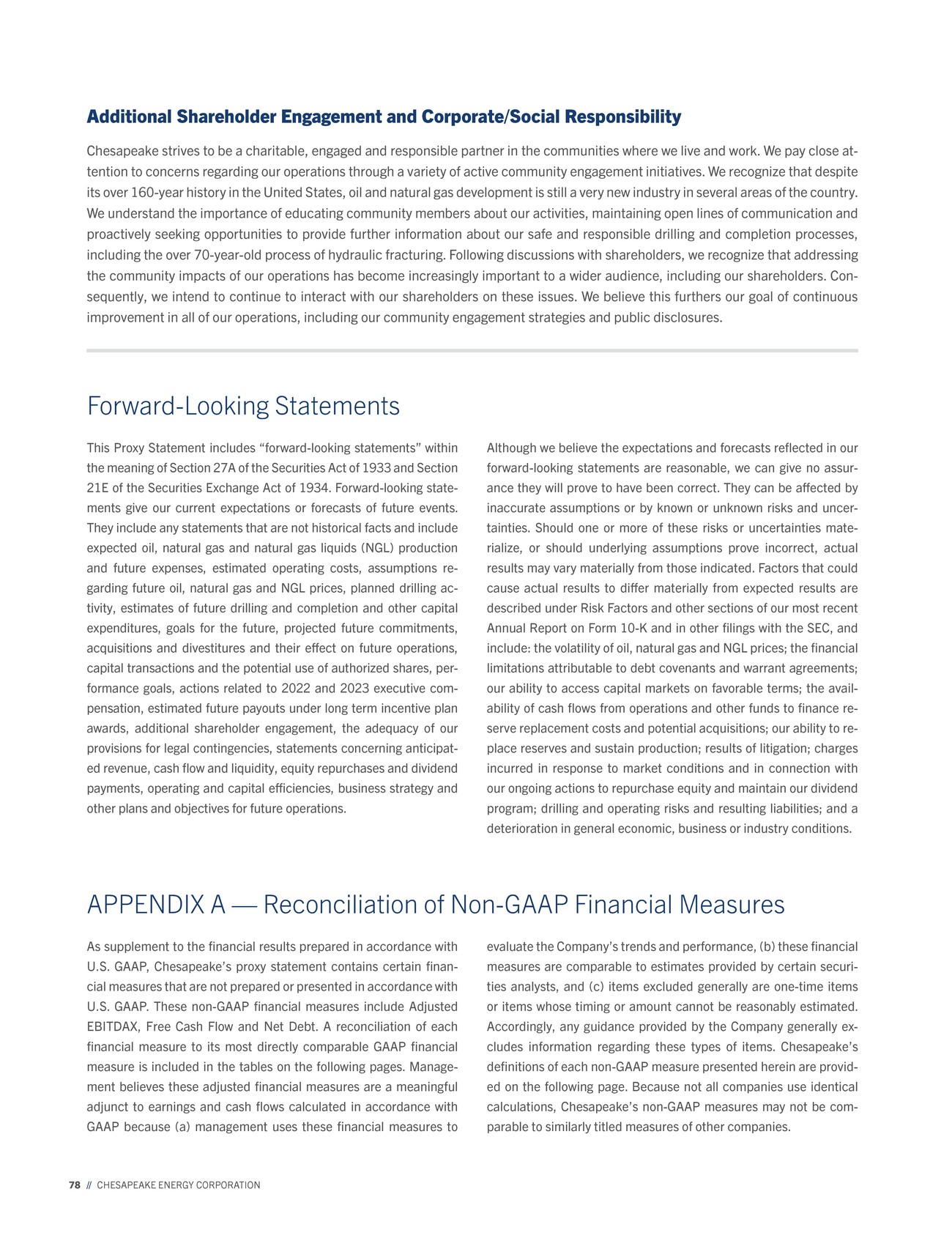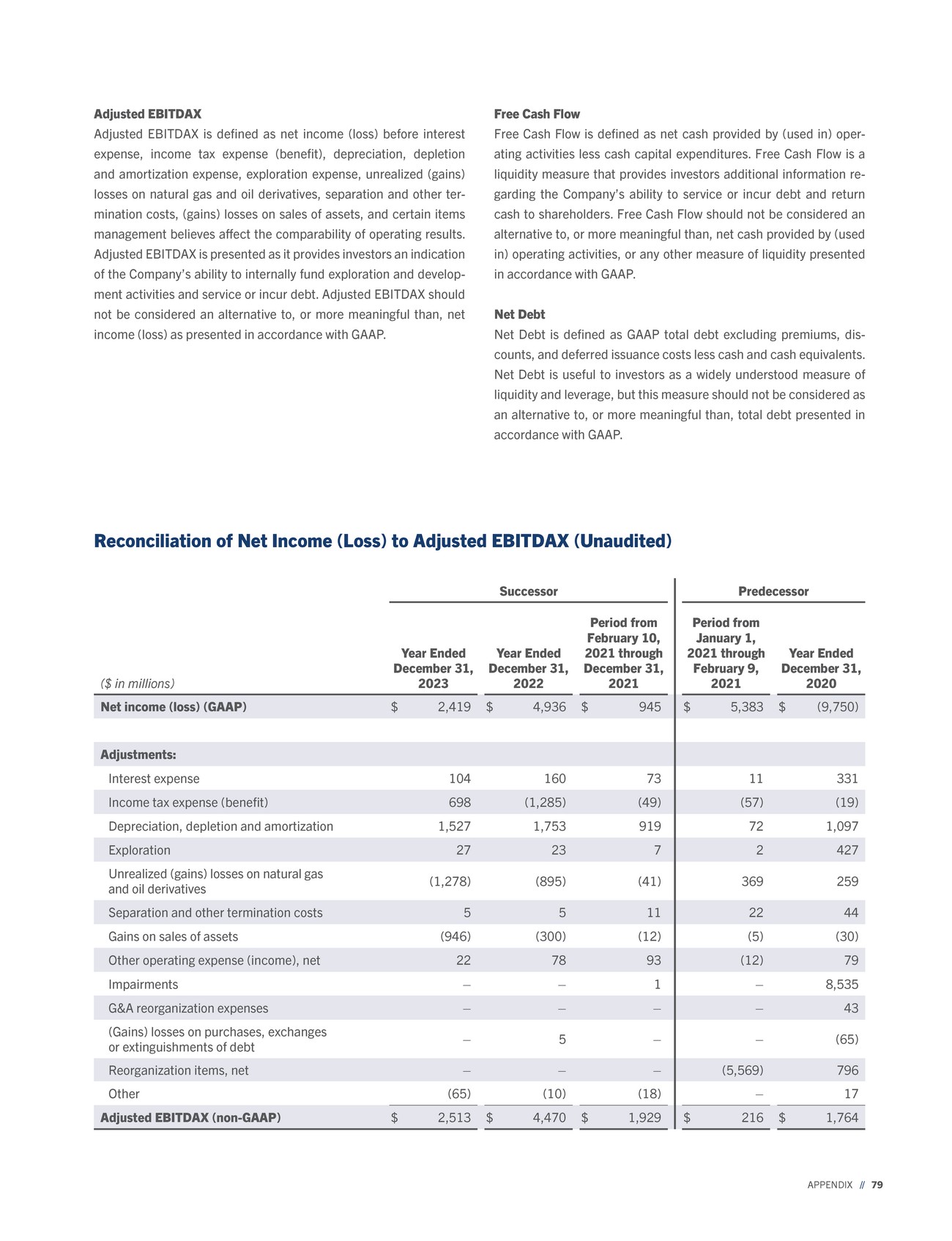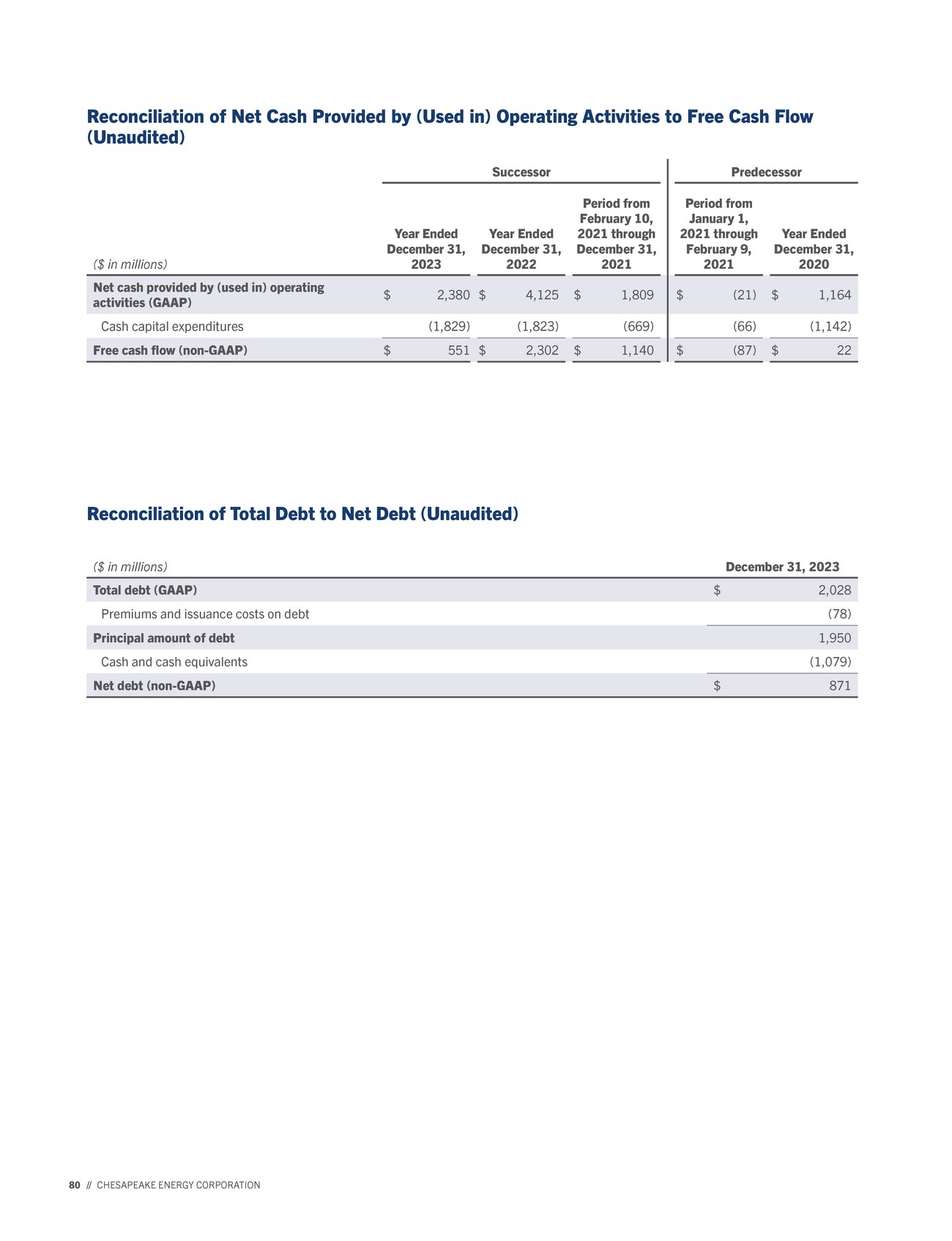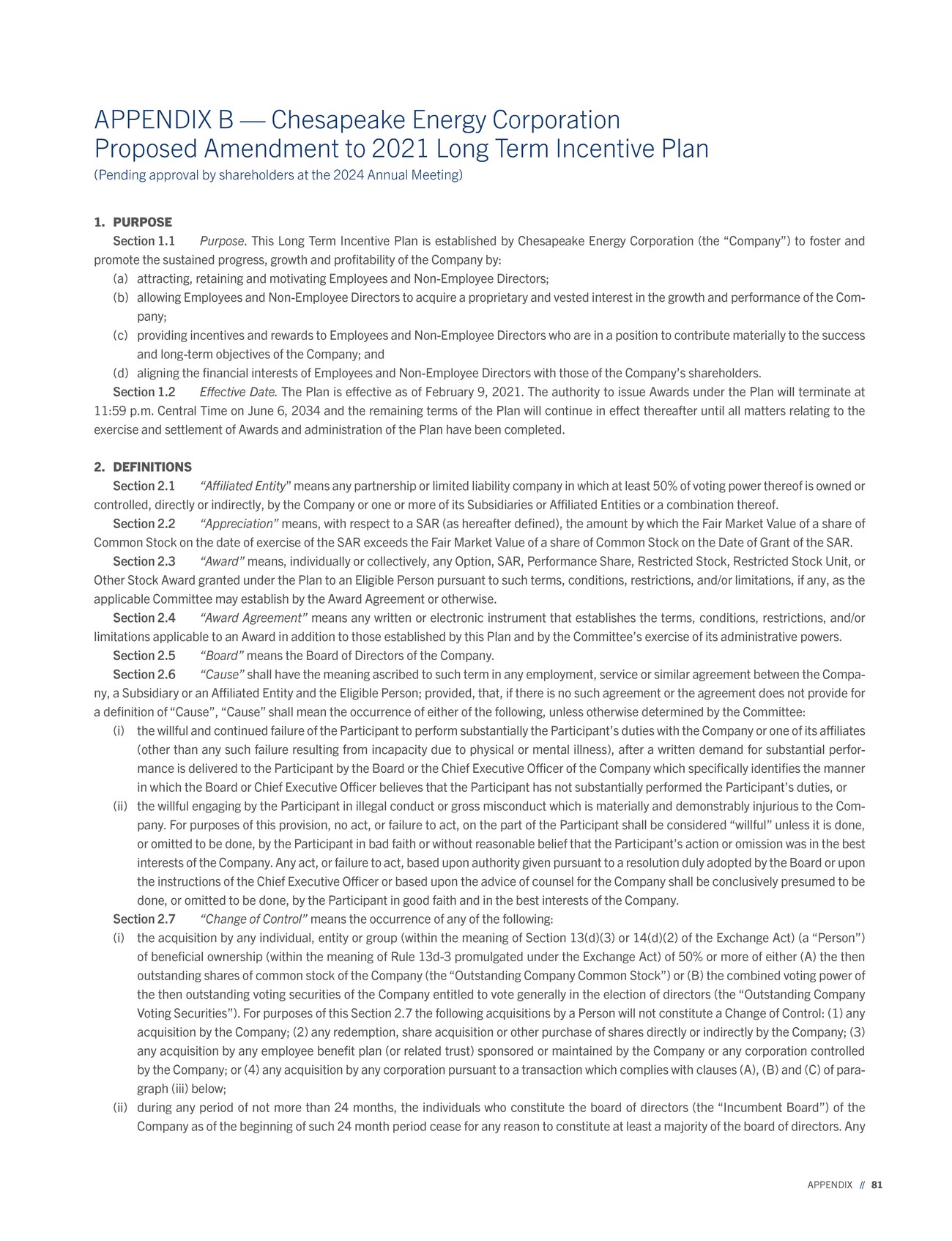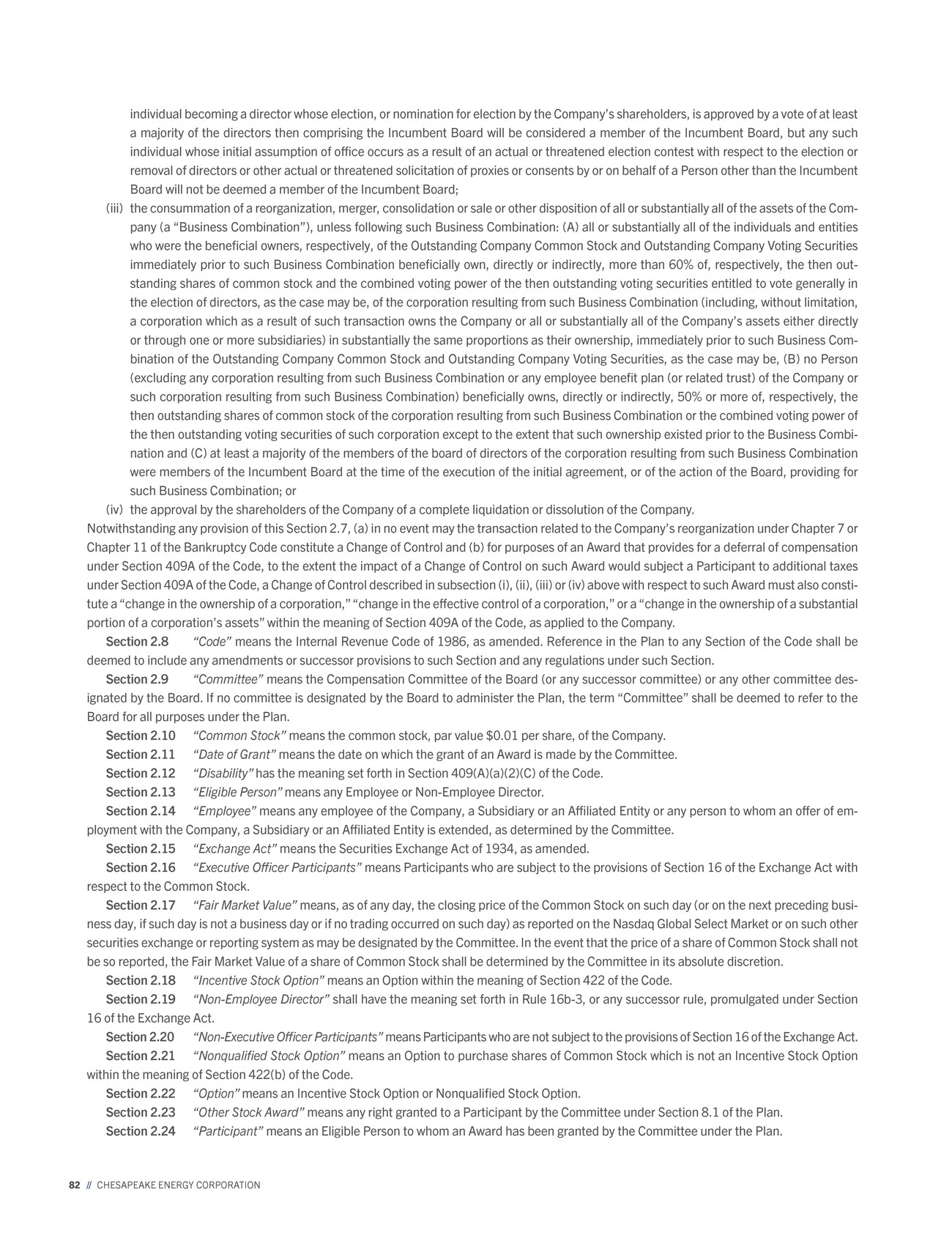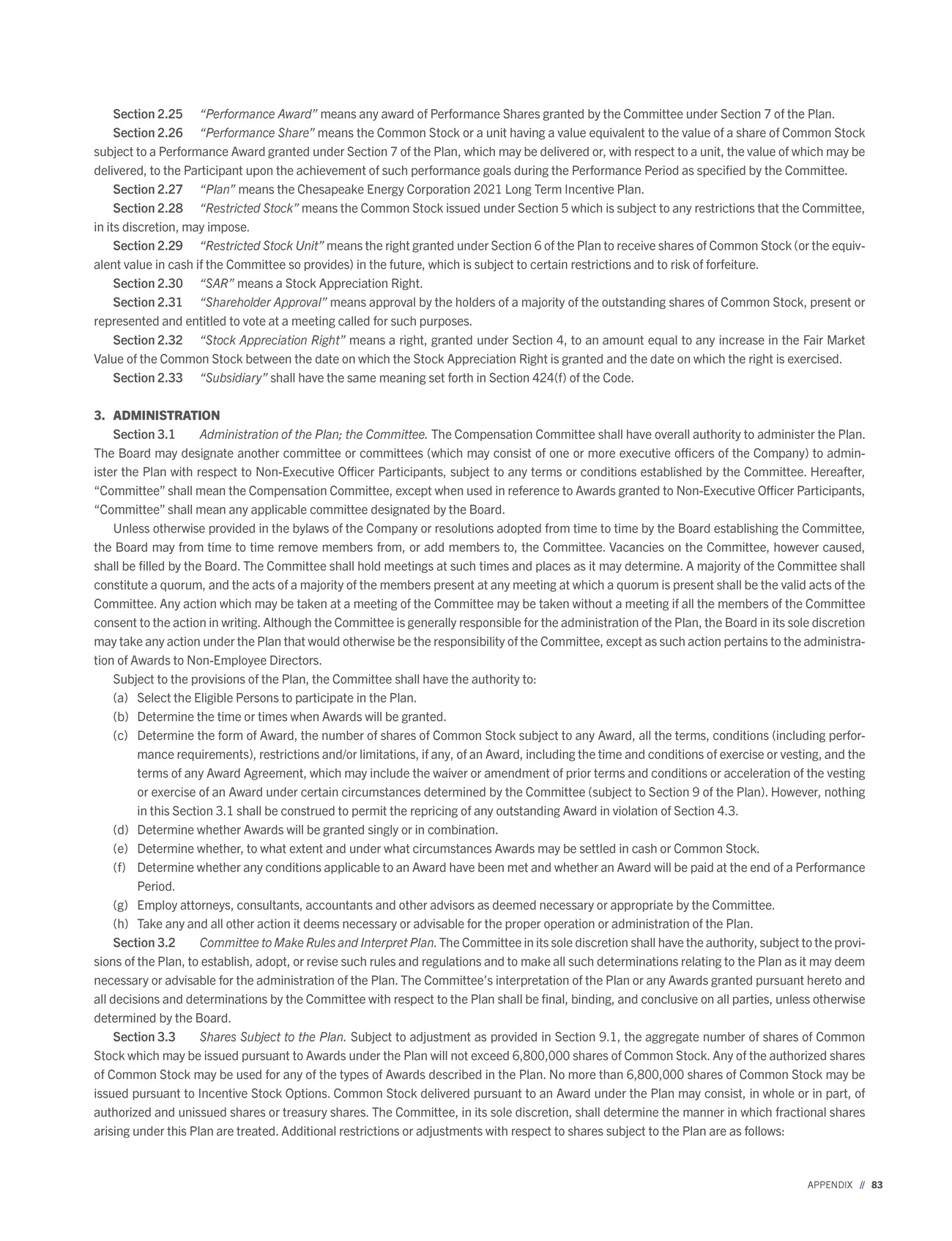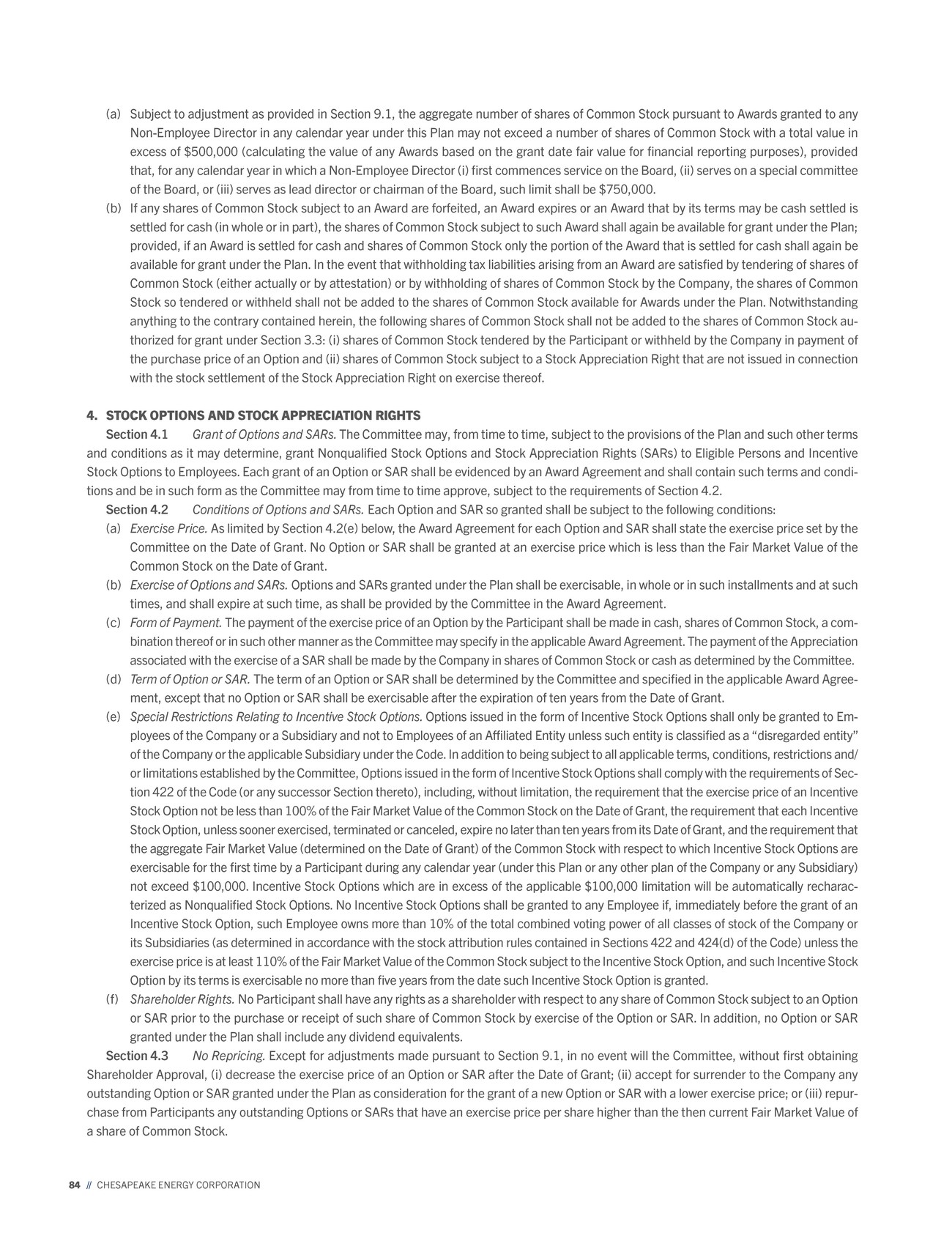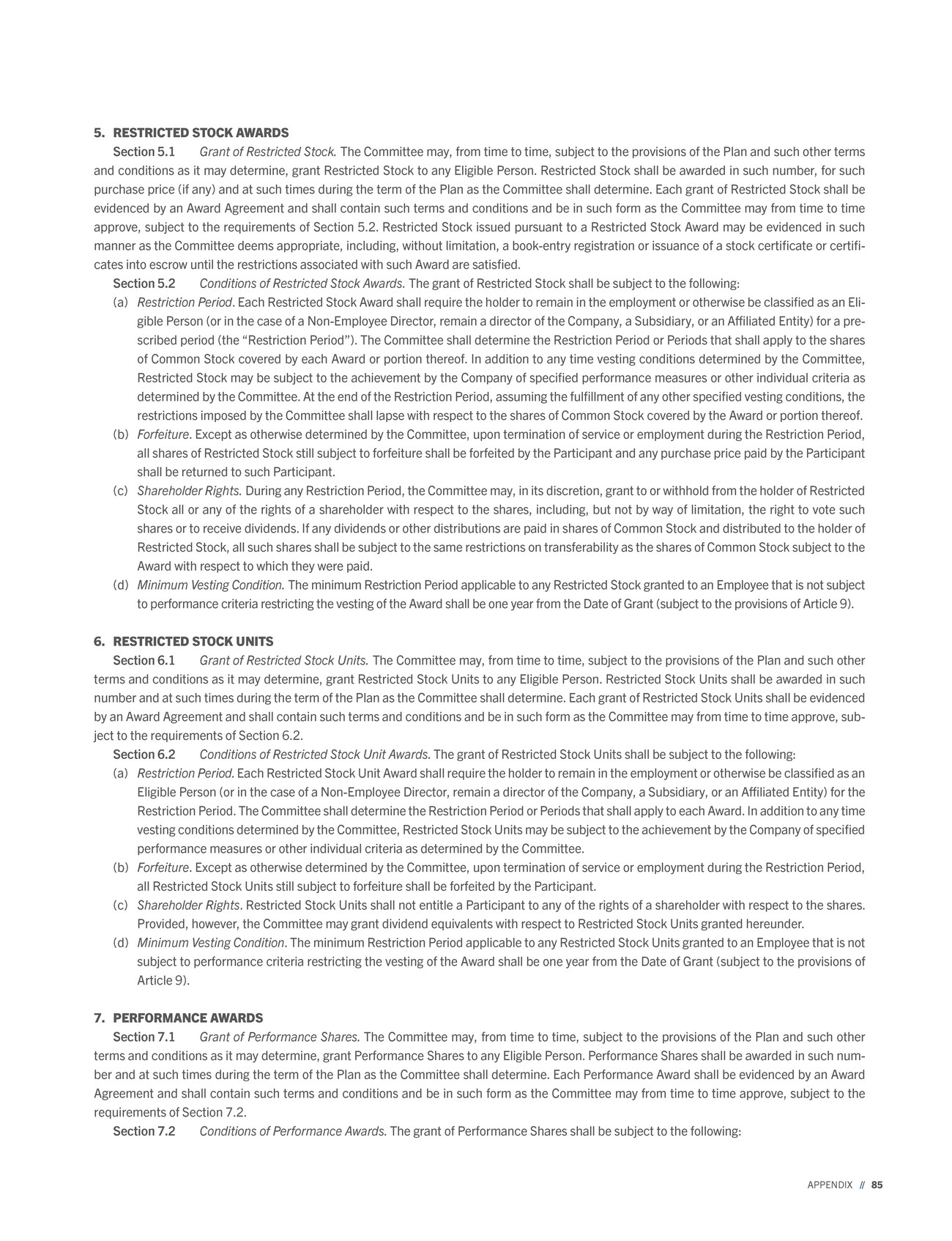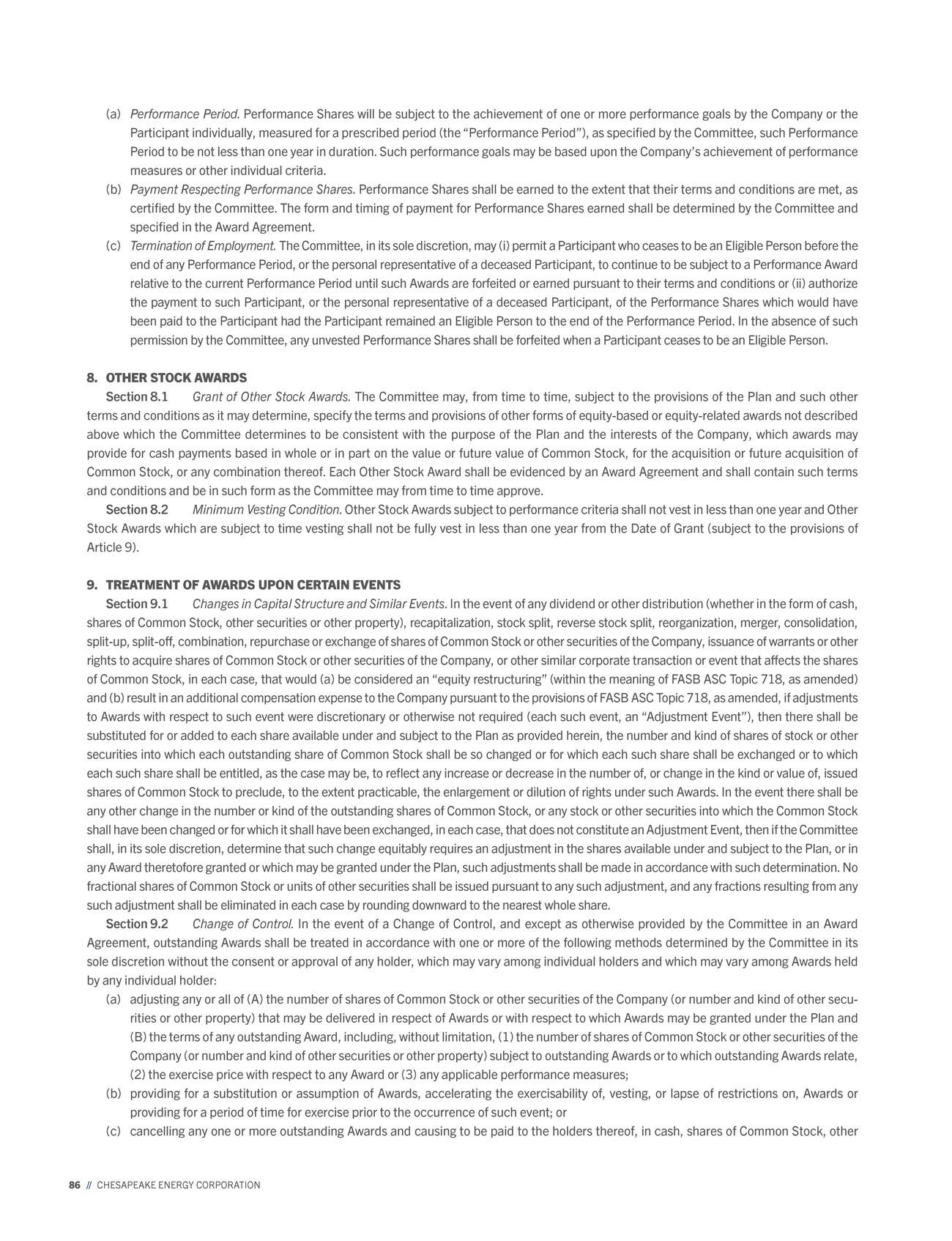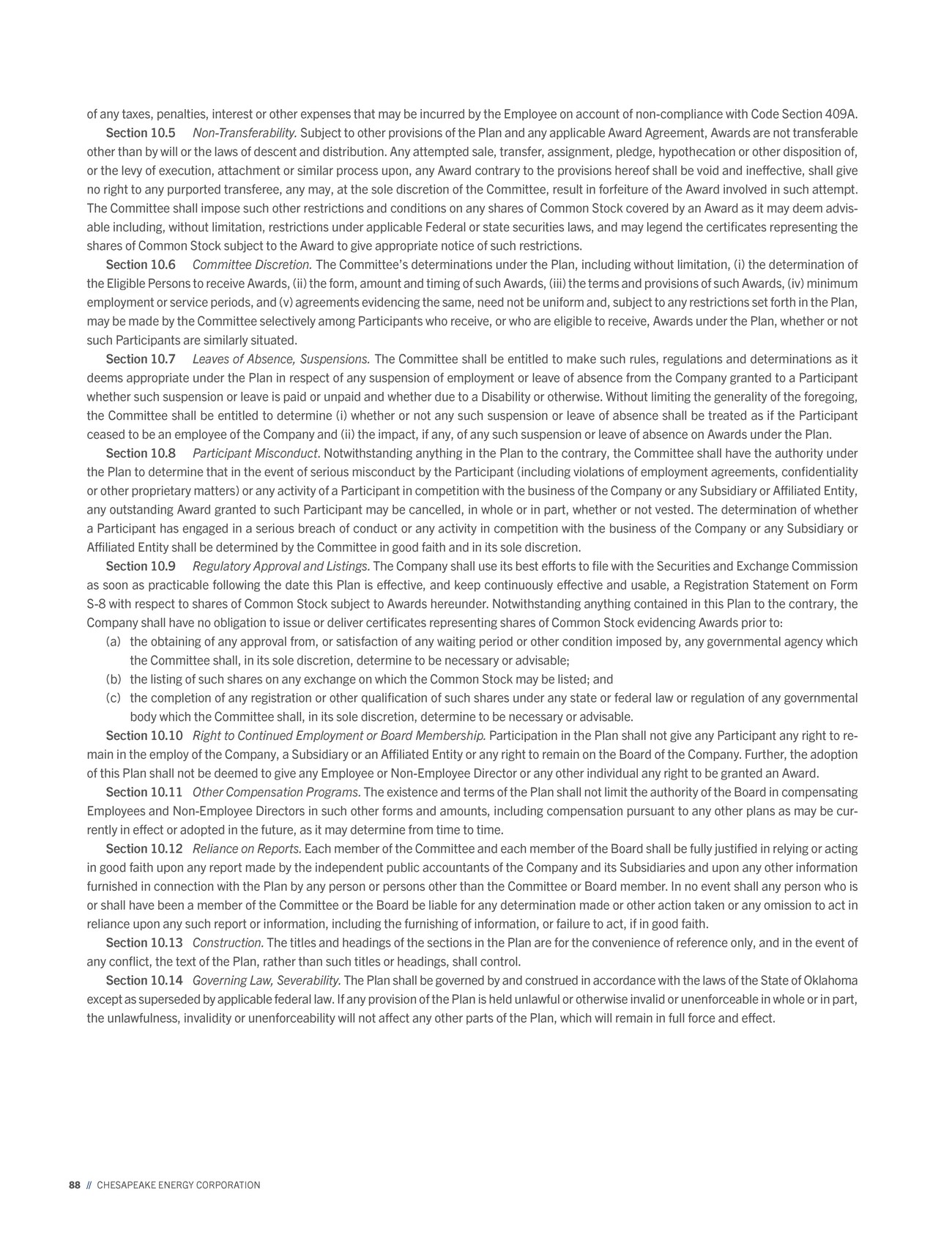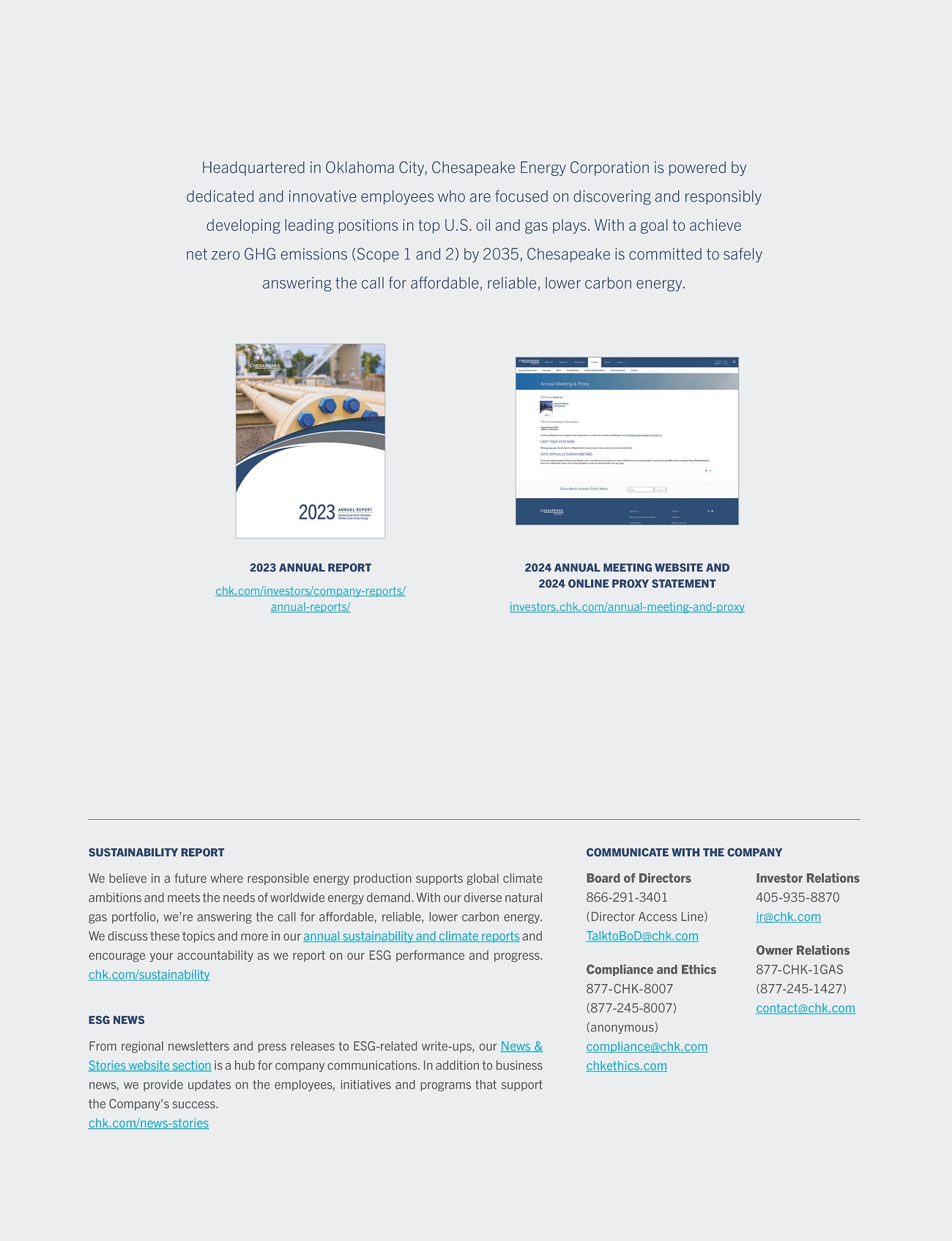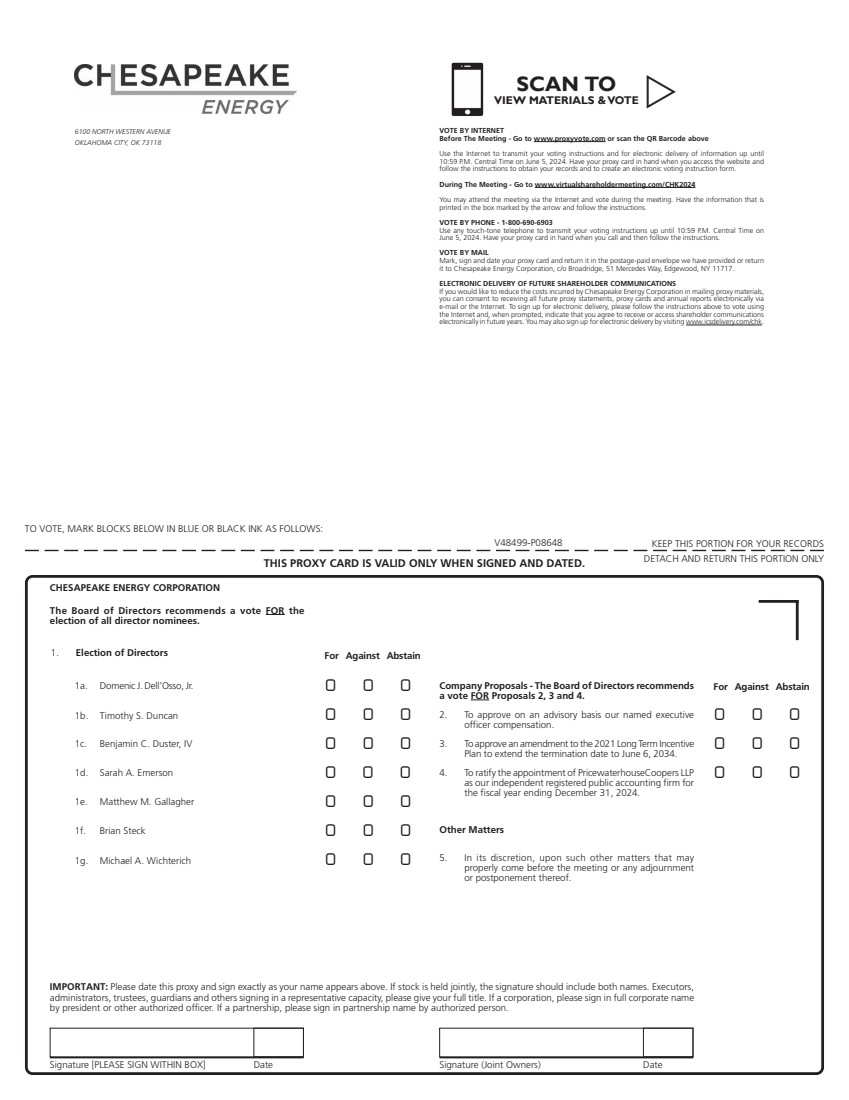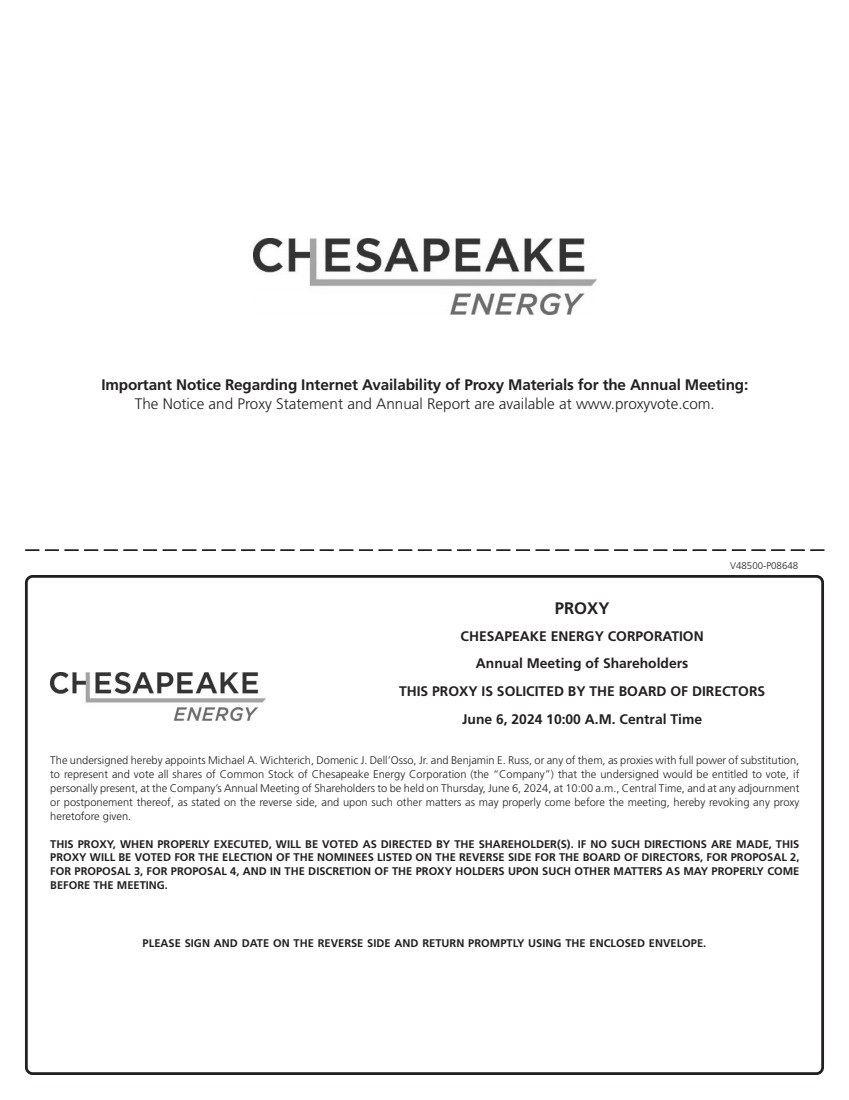United States
Securities and Exchange Commission
Washington, D.C. 20549
Proxy Statement Pursuant to Section 14(a)
of the Securities Exchange Act of 1934 (Amendment No. )
| ☑ Filed by the Registrant | ☐ Filed by a Party other than the Registrant |
| CHECK THE APPROPRIATE BOX: | |
| ☐ | Preliminary Proxy Statement |
| ☐ | Confidential, for Use of the Commission Only (as permitted by Rule 14a-6(e)(2)) |
| ☑ | Definitive Proxy Statement |
| ☐ | Definitive Additional Materials |
| ☐ | Soliciting Material under §.240.14a-12 |

(Name of Registrant as Specified In Its Charter)
(Name of Person(s) Filing Proxy Statement, if other than the Registrant)
| PAYMENT OF FILING FEE (CHECK ALL BOXES THAT APPLY): | |
| ☑ | No fee required |
| ☐ | Fee paid previously with preliminary materials |
| ☐ | Fee computed on table in exhibit required by Item 25(b) per Exchange Act Rules 14a-6(i)(1) and 0-11 |
| GUIDE TO CHESAPEAKE’S PROXY |
 | ONLINE
2024 PROXY STATEMENT investors.chk.com/annual-meeting-and- proxy ONLINE 2023 ANNUAL REPORT chk.com/investors/company-reports/ annual-reports First sent or made available on April 26, 2024 |
| In this Proxy Statement, we refer to Chesapeake Energy as the “Company,” “we,” “our,” “us,” “Chesapeake Energy” and “Chesapeake.” | |
| Chesapeake comes into the merger from a position of strength. Our strategic actions over the last three years have built a more resilient company focused on shareholder value. • Acquisitions of Vine and Chief: Consolidated key offset positions in Haynesville and Marcellus allowing cost reductions and efficient develop-ment of additional resources • Divestitures of Powder River Basin and Eagle Ford: Exited assets with limited actionable inventory economic in today’s market conditions; proceeds provided significant balance sheet strength and return to shareholders • Pausing Turn-in-Line (TIL) of New Wells (2024): Leveraged financial strength to reduce natural gas sales volumes in oversupplied market; retaining capacity to sell when demand recovers Targeting our two core assets in 2023, we delivered tangible results with bottom line impact — demonstrating the operational excellence which has come to define Chesapeake. Most importantly, we accomplished these operational milestones while improving our combined TRIR by 40%, to an industry-leading 0.14. We also continued to reduce our GHG emissions with a focus on methane, decreasing our methane emissions intensity by more than 80% com-pared to our 2020 baseline.(a) Our year-end 2023 methane emissions intensity was 0.015%, substantially below the industry standard of 0.20% (as defined by the Oil and Gas Climate Initiative). We will bring this same commitment, strategy and decision-making to the new company, post-merger. We have the portfolio, balance sheet and demonstrated operational track record to continue driving capital efficiencies, maximizing returns and reducing risk. Together, we will accelerate America’s energy reach and fuel a more affordable, reliable and lower carbon future. We are motivated by this opportunity for you, our shareholders, and the consumers and communities who benefit from the quality of life provided by natural gas. Thank you for your investment and partnership. In 2024, the oil and natural gas industry continues to face challenges. Today’s market remains oversupplied, with production peaking in late 2023 following significant capital expenditures in response to the pandemic’s low investment cycle and Russia’s invasion of Ukraine. In addition, this past winter’s milder temperatures brought low heating demand, leaving natural gas storage levels 40% above their five-year averages. Chesapeake was built for this moment. While market dynamics are resulting in cyclical lows for natural gas prices, demand is expected to rise materially over the next several years. In the U.S., growing markets of data centers and AI tools are requiring more elec-tricity, and power generators are increasingly looking to natural gas to supply the base load. Globally, the U.S. is preparing to connect its natural gas production to underserved markets by building liquefied natural gas (LNG) terminals, of which nearly 12 bcf/d is currently under construction. Our pending merger with Southwestern Energy will create a substantial opportunity to respond to evolving market dynamics and help connect crucial natural gas resources to consumers in need. We will have an unparalleled U.S. natural gas portfolio — an investment grade-quality company with expansive access to premium markets and the ability to seamlessly move capital and best operating practices across basins. Simply put, our combined company will deliver more gas to more markets more efficiently. As we look to the future, together we will materially advance the strategic pillars defined by Chesapeake. Dear Fellow Shareholders, Domenic J. “Nick” Dell’Osso, Jr. President, Chief Executive Officer and Director Michael A. Wichterich Chairman of the Board Strategic Pillars Superior Capital Returns Deep, Attractive Inventory Premier Balance Sheet Sustainability Leadership Combined Performance ~$1.0B – $1.5B of per annum dividends at current strip >5,000 pro forma gross locations across Appalachia and Haynesville Accelerates path to Investment Grade rating and lowers cost of capital 100% RSG certified across all basins and production MARCELLUS • Drilled 9 of the 10 longest laterals in our history in the basin • Improved well costs by 17% (1Q to 4Q) and increased our footage drilled per day by 40% HAYNESVILLE • Outpaced our peers (drilling performance) in the most difficult drilling environment in the Lower 48 • Benefited from improved gathering system hydraulics (a) Our baseline includes those assets we owned at YE 2020: Eagle Ford, legacy Haynesville, legacy Marcellus and Powder River Basin. Methane emissions intensity calculated as volume methane emissions / volume gross operated natural gas produced. |
| VOTING Q&A Who can vote? Shareholders of record as of the close of business on the record date, April 8, 2024 How many shares are entitled to vote? 131,048,149 shares of common stock How many votes do I get? One vote for each director and one vote on each proposal for each share you hold as of April 8, 2024 How can I vote? You can submit your vote in any of the following ways: INTERNET VIA COMPUTER: Via the Internet at proxyvote.com. You will need the 16-digit number included in your notice, proxy card or voter instruction form. INTERNET VIA TABLET OR SMARTPHONE: By scanning the QR code. You will need the 16-digit number included in your notice, proxy card or voter instruction form. TELEPHONE: Call toll-free 800-690-6903 or the phone number on your voter instruction form. You will need the 16-digit number included in your notice, proxy card or voter instruction form. MAIL: If you received a paper copy of your proxy materials, send your completed and signed proxy card or voter instruction form using the enclosed postage-paid envelope. VIRTUALLY DURING MEETING: To vote your shares during the Annual Meeting, click on the vote button provided on the screen and follow the instructions provided. If you encounter any difficulties accessing the virtual meeting during the check-in or meeting time, please call the technical support number that will be posted on the log-in page. 2 // CHESAPEAKE ENERGY CORPORATION AGENDA PROPOSAL 1: Elect seven director nominees named in the proxy for the coming year (read more on page 12). Your Board recommends a vote FOR the election of each director nominee. Vote required: majority of votes cast (pursuant to majority-vote policy). PROPOSAL 2: Approve named executive officer compensation in advisory vote (read more on page 31). Your Board recommends a vote FOR Proposal 2. Vote required: plurality of votes cast. PROPOSAL 3: Approve amendment to the 2021 Long Term Incentive Plan to extend its termination date from February 9, 2025 to June 6, 2034 (read more on page 62). Your Board recommends a vote FOR Proposal 3. Vote required: plurality of votes cast. PROPOSAL 4: Ratify the appointment of PricewaterhouseCoopers LLP (PwC) as independent auditor for 2024 (read more on page 70). Your Board recommends a vote FOR Proposal 4. Vote required: plurality of votes cast. Other Business: Shareholders will also transact any other business that properly comes before the meeting. Abstentions and Broker Non-Votes: For Proposal 4, abstentions will not be counted as a vote for or against and no broker non-votes are expected. For all other proposals, abstentions and broker non-votes will not be counted as a vote for or against. Roadmap of Voting Items: See “Roadmap of Voting Items” for more detailed information regarding each proposal. NOTICE OF 2024 ANNUAL MEETING OF SHAREHOLDERS You are invited to attend Chesapeake Energy Corporation’s 2024 Annual Meeting of Shareholders. This page contains important information about the meeting, including how you can make sure your views are represented by voting today. Sincerely, Benjamin E. Russ Executive Vice President – General Counsel and Corporate Secretary Date and Time: Thursday, June 6, 2024 10:00 a.m. Central Time Attending the Virtual Meeting: The Annual Meeting will be completely virtual. You may attend the meeting, submit questions and vote your shares electronically during the meeting via live webcast by visiting VirtualShareholderMeeting.com/ CHK2024. You will need the 16-digit control number that is printed in the box marked by the arrow on your proxy card to enter the Annual Meeting. We recom-mend that you log in at least 15 minutes before the meeting to ensure you are logged in when the meeting starts. Virtual Meeting Webcast: VirtualShareholderMeeting.com/CHK2024 |
| ROADMAP OF VOTING ITEMS PROPOSAL 1 Election of Directors (page 12) We are asking shareholders to vote on each director nominee to the Board of Directors (Board) named in the Proxy Statement. The Board and Nominating and Corporate Governance Committee believe that the director nominees have the qualifications, experience and skills necessary to represent shareholder inter-ests through service on the Board. FOR EACH NOMINEE PROPOSAL 2 Advisory Vote to Approve Named Executive Officer Compensation (Say on Pay) (page 31) We have designed our executive compensation program to attract and retain high-performing executives and align executive pay with Company performance and the long-term interests of its shareholders. We are seeking a non-binding advisory vote from our shareholders to approve the compensation of our named executive officers (NEOs) as described in this Proxy Statement. The Board values shareholders’ opinions, and the Compensation Committee will take into account the outcome of the advisory vote when considering future executive compensation decisions. FOR PROPOSAL 3 Approval of an Amendment to the 2021 Long Term Incentive Plan to Extend its termination date to June 6, 2034 (page 62) We are seeking approval of an amendment to our 2021 Long Term Incentive Plan (2021 LTIP) that will extend the termination date from February 9, 2025 to June 6, 2034, the tenth anniversary of the 2024 Annual Meeting of Shareholders. We are not seeking to increase the number of shares issuable under the 2021 LTIP or to make any other amendments to the 2021 LTIP. We believe that the 2021 LTIP allows us to: (i) attract, reward and retain highly qualified industry professionals; (ii) reinforce a pay for performance culture by providing equity incentives and rewards to employees and non-employee directors who are in a position to contribute materially to our success and long-term objectives; and (iii) align the interests of employees and non-employee directors with those of our shareholders. FOR PROPOSAL 4 Ratification of Appointment of Independent Registered Public Accounting Firm (page 70) The Audit Committee has appointed PwC to serve as the Company’s independent registered public ac-counting firm for the fiscal year ending December 31, 2024. The Audit Committee and the Board believe that the continued retention of PwC to serve as the independent auditor is in the best interests of the Company and its shareholders. As a matter of good corporate governance, shareholders are being asked to ratify the Audit Committee’s appointment of PwC. FOR ROADMAP OF VOTING ITEMS // 3 VOTING ITEM BOARD RECOMMENDATION |
| 4 // CHESAPEAKE ENERGY CORPORATION 2023 – 2024 OPERATIONAL & FINANCIAL HIGHLIGHTS January 2024 announced Chesapeake + Southwestern merger to Accelerate America’s Energy Reach Marcellus FY23 9 of 10 longest laterals drilled in CHK history — including longest of ~3.5 mi Haynesville FY23 7 of 10 fastest NFZ wells drilled in CHK history — basin-leading performance 2023 LNG HOAs Up to 3 mpta with Gunvor and Vitol linked to JKM February 2024 signed LNG SPAs ~0.5 mtpa offtake from Delfin sold to Gunvor priced on JKM From all three agencies received credit rating Upgrades Eagle Ford exit in 2023 successfully closed >$3.5B Remain 100% RSG certified and completed MiQ / EO100TM Recertification (a) Non-GAAP measure as defined in Appendix A beginning on page 78 and in the supplemental financial tables available on the Company’s website at investors.chk.com/non-gaap-financials. 2023 Serious Incidents and Fatalities (SIF) actuals Zero Industry-leading combined TRIR of 0.14 2023 year-over-year safety ~40% improvement FY23 adjusted EBITDAX(a) $2.5B Cash balance as of 12/31/23 ~$1.1B FY23 returns to shareholders via dividends and buybacks ~$840mm |
| Recertified portfolio-wide RSG and leading safety in combined TRIR Sustainability Leadership Consistent and measurable progress on our path to net zero ~$1.1B of cash(b) and hedge-the-wedge preserves financial strength Premier Balance Sheet Investment grade-quality balance sheet provides strategic through-cycle advantages ~15 years of inventory in each basin Deep, Attractive Inventory Premium rock, returns, runway with best-in-class execution 2023: 8.3% shareholder return yield vs. 3.9% peer average(a) Superior Capital Returns Most efficient operator, returning more cash to shareholders than domestic gas peers HIGHLIGHTS // 5 Delivering Our Strategic Pillars (a) Data from Factset actuals and estimates as of February 16, 2024; peers include AR, CNX, CRK, CTRA, EQT, RRC and SWN. Shareholder return equals base dividend, variable dividend and buybacks. Yield uses market cap as of year-end 2023. (b) As of December 31, 2023. (c) FOB – Free on board; DES – Delivered ex-ship; FID – Final investment decision. We Are LNG Ready Natural Gas Producer LNG Facility LNG FOB(c) Buyer LNG DES(c) Buyer LNG ReGas Natural Gas User LNG Value Chain CHESAPEAKE COUNTERPARTY Illustrative LNG Netback $/mmbtu $11 JKM Futures Deduct (Tolling, Shipping, Fuel, etc.) Realized Netback ($5 – $7) $4 – $6 Chesapeake’s Recent Progress • ~0.5 mtpa LNG Sale and Purchase Agreement (SPA) with offtake from Delfin at a Henry Hub linked price and subsequent sale to Gunvor at a Japan Korea Marker (JKM) linked price • Gunvor offtake head of agreement (HOA) for up to an additional 1.5 mtpa with JKM linked price exposure • Vitol offtake HOA for up to 1 mtpa with JKM linked price exposure • Equity partner and anchor shipper on Momentum’s NG3 (Haynesville to Gulf Coast pipeline) Nearly 12 bcf/d of financed/FID(c) LNG export demand by ~2028 |
| 6 // CHESAPEAKE ENERGY CORPORATION 2 Investing in material emissions reduction with revenue-generating potential 3 Maintaining positive return propositions 4 Driving lower end-use customer costs 1 Targeting & replacing high-emission energy sources Our employees are committed to answering the call for the affordable, reliable lower carbon energy the world desperately needs. Our duty to being stewards of the communities in which we operate and live is not one we take lightly and is central to our culture and values. We are constantly innovating across all aspects of our business, firmly embracing a lower carbon future and playing our part in helping meet the ambitions of the Paris Agreement as we strive to achieve net zero GHG emissions by 2035. As we invest capital in sustain-ability-linked projects, we do so with the goal of: 2023 – 2024 SUSTAINABILITY HIGHLIGHTS Progress includes: • Recertifying all assets under the MiQ/EO100™ standards, maintaining 100% independent responsibly sourced gas (RSG) certification across our entire portfolio. • Continuing to advance our commitment to transparency and enhanced disclosures by joining the Oil & Gas Methane Partnership (OGMP) 2.0. OGMP 2.0 is the flagship oil and gas reporting and mitigation pro-gram of the United Nations Environment Programme, and the only comprehensive, measurement-based international reporting framework for the sector. • Improving our combined TRIR by approximately 40%, to an industry leading 0.14. • Expanding our ESG disclosures and demonstrating transparency and open communication, as evidenced by IR Magazine award as the “Best ESG Reporting Small to Mid-Cap Company.” |
| HIGHLIGHTS // 7 Environmental • >60% reduction in GHG intensity since 2020(a) • >80% reduction in methane emissions intensity since 2020(a) • Emissions detection methods include fixed methane sensors (>2,000 deployed), aerial flyovers and FLIR inspections across portfolio • Joined OGMP 2.0 to improve the transparency and accuracy of our methane emissions reporting • Member of the Appalachian Methane Initiative and a related methane monitoring program in the Haynesville operating area Social Responsibility • Dedicated community engagement at our in-person meetings in our field operations, including lunch and learns in every parish where we operate in Haynesville • Commitment to diversity, equity and inclusion (DEI), including active Diversity Council, dedicated DEI professional and mandatory employee training programs • LNG ready through executed agreements with Delfin LNG, Gunvor and Vitol • Human rights policy defines standards we have set for our operations and supply chain management, upholding the UN’s Guiding Principles on Business and Human Rights • Commitment to supporting the communities we serve through philanthropy and volunteerism Governance and Transparency • Transparent sustainability-related disclosures including reporting ESG metrics across multiple industry and other volun-tary frameworks and progress toward climate-related targets • Executive and employee compensation program cap Annual Incentive Plan payout at target for all performance metrics if we fail to achieve threshold levels of environmental and safety performance • Executive compensation program aligned with shareholder returns and environmental and safety performance • Code of Business Conduct which defines the responsibilities all employees bear toward supporting our core values • Annual Sustainability Report, which is available on our website and includes, among other items, a detailed update on progress in sustainability leadership • Implementation of a “Safe and Compliant Operations” Policy ESG Initiatives Sustainability Fundamentals (a) Time frame: 2020 – 2023; inclusive of acquisitions and divestitures made during this time period; our baseline includes those assets we owned at year-end 2020: Eagle Ford, legacy Haynesville, legacy Marcellus and Powder River Basin, consistent with U.S. EPA reporting protocols. Deliver energy to sustain economic progress and welfare Minimize emissions from operations Invest in low-carbon solutions with adjacent technologies Transparent disclosures with measurable progress |
| 8 // CHESAPEAKE ENERGY CORPORATION When is the Annual Meeting? The Annual Meeting will be held on June 6, 2024, at 10:00 a.m., Central Time. Where is the Annual Meeting? The Annual Meeting will be completely virtual. Shareholders can attend the virtual Annual Meeting by visiting VirtualShareholder Meeting.com/CHK2024. Who is entitled to vote? You may vote at the Annual Meeting, and any adjournment or postponement thereof, if you were a holder of record of Ches-apeake common stock as of the close of business on April 8, 2024, the record date for the Annual Meeting. Each share of Chesapeake common stock is entitled to one vote at the Annual Meeting. On the record date, there were 131,048,149 shares of common stock issued and outstanding and entitled to vote at the Annual Meeting. There are no cumulative voting rights asso-ciated with Chesapeake common stock. How many votes must be present to hold the Annual Meeting? A majority of the shares of the common stock entitled to vote must be present online or by proxy at the Annual Meeting to constitute a quorum and to transact business. Your shares will be counted as “present” at the Annual Meeting if you properly return a proxy by the Internet, telephone or mail, or if you join the virtual Annual Meeting. Abstentions and broker non-votes, if any, will be counted for purposes of establishing a quorum at the Annual Meeting. Who is soliciting my vote? Our Board is soliciting your proxy to vote your shares at the Annual Meeting. We have delivered these materials to you elec-tronically or by mail in connection with our solicitation of proxies for use at the Annual Meeting. What is included in the proxy materials for the Annual Meeting? The proxy materials for the Annual Meeting include: • The Notice of Annual Meeting of Shareholders • This Proxy Statement These proxy materials also include the proxy card or voting instruc-tion form for the Annual Meeting. These materials are expected to be first mailed to shareholders on or about April 26, 2024. What happens if other matters are properly presented at the Annual Meeting? We are not aware of any other proposals that will be submitted to shareholders at the Annual Meeting. However, if any matter not described in this Proxy Statement is properly presented for a vote at the meeting, the persons named on the proxy form will vote in accordance with their judgment. Discretionary authority to vote on other matters is included in the proxy. What happens if a director nominee is unable to serve? We do not know of any reason why any nominee would be unable to serve as a director. If any nominee is unable to serve, the Board can either nominate a different individual or reduce the Board’s size. If the Board nominates a different individual, the shares rep-resented by all valid proxies will be voted for that nominee. How do I vote? There are five ways to vote: INTERNET VIA COMPUTER: Via the Internet at proxy vote.com. You will need the 16-digit number included in your notice, proxy card or voter instruction form. INTERNET VIA TABLET OR SMARTPHONE: By scanning the QR code. You will need the 16-digit number included in your notice, proxy card or voter instruction form. TELEPHONE: Call toll-free 800-690-6903 or the tele-phone number on your voter instruction form. You will need the 16-digit number included in your notice, proxy card or voter instruction form. MAIL: If you received a paper copy of your proxy ma-terials, send your completed and signed proxy card or voter instruction form using the enclosed postage-paid envelope. VIRTUALLY DURING MEETING: To vote your shares during the Annual Meeting, click on the vote button pro-vided on the screen and follow the instructions provid-ed. If you encounter any difficulties accessing the virtual meeting during the check-in or meeting time, please call the technical support number that will be posted on the log-in page. VOTING AND MEETING INFORMATION |
| VOTING AND MEETING INFORMATION // 9 What proposals will be voted on? What are the voting standards and how does the Board recommend that I vote? VOTING ITEM Board Recommendation Voting Standard Treatment of Abstentions and Broker Non-Votes* Proposal 1. Election of Directors FOR EACH NOMINEE Majority of votes cast† No effect MANAGEMENT PROPOSALS Proposal 2. Advisory Vote to Approve Named Executive Officer Compensation** FOR Plurality of votes cast No effect Proposal 3. Vote to Approve an Amendment to the 2021 Long Term Incentive Plan FOR Proposal 4. Ratification of Appointment of Independent Registered Public Accounting Firm FOR † We have a majority-vote standard for the election of directors: Under our Bylaws, we have implemented a majority-vote standard for the uncontested election of directors. If a non-incumbent director nominee receives a greater number of votes “against” that nominee’s election than “for” that nominee’s election, the nominee will not be elected a director. In addition, if the number of votes “against” an incumbent director’s election exceeds the number of votes “for” such director, the incumbent nominee must promptly comply with the resignation procedures outlined in our Corporate Governance Principles. For this purpose, abstentions and broker non-votes are not counted as a vote either “for” or “against” the director. * Broker Non-Votes: If you are a beneficial owner of shares held in street name and do not provide the organization that holds your shares with specific voting instructions, under applicable Nasdaq Stock Market rules, the organization that holds your shares may generally vote on “routine” matters, but cannot vote on “non-routine” matters. If the organization that holds your shares does not receive instructions from you on how to vote your shares on a non-routine matter, that organization will inform the inspector of election that it does not have authority to vote on this matter with respect to your shares. This is generally referred to as a “broker non-vote.” Routine Matters: The ratification of the appointment of PwC as the Company’s independent registered public accounting firm for 2024 (Proposal 4) is the only routine matter to be presented at the Annual Meeting on which brokers, banks or other nominees may vote in their discretion on behalf of beneficial owners who have not provided voting instructions. Therefore, no broker non-votes are expected in connection with Proposal 4. Non-Routine Matters: Each of the other proposals, including the election of directors (Proposal 1), the advisory resolution approv-ing our NEO compensation (Proposal 2), and the approval of an amendment to the 2021 Long Term Incentive Plan (Proposal 3), are considered non-routine matters under applicable Nasdaq Stock Market rules. A broker, bank or other nominee cannot vote on non-routine matters without instructions, and therefore broker non-votes may exist in connection with Proposals 1, 2 and 3. ** Advisory Votes: Your vote on Proposal 2 is “advisory” and therefore will not be binding upon the Compensation Committee or the Board. However, our Compensation Committee and the Board will carefully consider the outcome of the vote when reviewing future compensation arrangements for our executive officers. |
| 10 // CHESAPEAKE ENERGY CORPORATION Why is the Annual Meeting a virtual meeting? We have decided to hold our Annual Meeting virtually because we believe that it will enable greater shareholder attendance and participation from any location around the world at minimal cost. We are also sensitive to the ongoing public health protocols and travel concerns of our shareholders and employees. How can I access the proxy materials electronically or sign up for electronic delivery, and thereby help us reduce the envi-ronmental impact of our annual meetings? Important Notice regarding the Internet Availability of Ches-apeake’s Proxy Materials for the 2024 Annual Meeting and Future Materials. We use the Internet as the primary means of furnishing proxy materials to shareholders. Accordingly, we have sent a Notice of Internet Availability of Proxy Materials, or Notice, to you, which provides instructions on how to use the Internet to: • View our proxy materials for the annual meetings • Instruct us to send future proxy materials to you by email • Request a printed copy of the proxy materials All shareholders will also be able to access the proxy materi-als online or to request a printed set of the proxy materials at proxyvote.com. We encourage shareholders to take advantage of online availability of the proxy materials to help reduce the environmental impact of our annual meetings, and reduce our printing and mailing costs. What is the difference between a shareholder of record and a beneficial owner of shares held in street name? Shareholder of Record. If your shares are registered directly in your name with the Company’s registrar and transfer agent, EQ Shareowner Services, you are considered a shareholder of record with respect to those shares, and the Notice was sent directly to you by the Company. Beneficial Owner of Shares Held in Street Name. If your shares are held in an account at a brokerage firm, bank or other insti-tutional account, then you are a “beneficial owner” of shares held in “street name,” and a Notice of the Annual Meeting was mailed to you by that organization. This means that you vote by providing instructions to your broker, bank or other in-stitution rather than directly to the Company. Unless you pro-vide specific voting instructions, your broker, bank or other institution is not permitted to vote your shares on your behalf, except on any proposal that is a routine matter (see discussion of “broker non-votes” on page 9). For your vote on any other mat-ters to be counted, you will need to communicate your voting decisions to your broker, bank or other institution before the date of the Annual Meeting using the voting instruction form that the institution provides to you. If you would like to vote your shares during the virtual meeting, you must provide a proxy from your financial institution. Do we have a policy about directors’ attendance at the Annual Meeting? Yes. Pursuant to our Corporate Governance Guidelines, directors are expected to attend the Annual Meeting. All of our directors attended the 2023 Annual Meeting of Shareholders. Can I change my vote or revoke my proxy? Yes. You may revoke your proxy and change your vote at any time before the taking of the vote at the Annual Meeting. Prior to the applicable cutoff time, you may change your vote using the Internet or telephone methods described above, in which case only your latest Internet or telephone proxy submitted prior to the Annual Meeting will be counted. You may also revoke your proxy and change your vote by signing and returning a new proxy card or a new voter instruction form dated as of a later date, or by voting during the Annual Meeting. However, your attendance at the Annual Meeting will not automatically revoke your proxy unless you properly vote at the Annual Meeting or specifically request that your prior proxy be revoked by deliver-ing a written notice of revocation to the Company’s Secretary at 6100 North Western Avenue, Oklahoma City, Oklahoma 73118 prior to the Annual Meeting. |
| VOTING AND MEETING INFORMATION // 11 Why did my household receive a single set of proxy materials? How can I request an additional copy of the proxy materials and Annual Report? SEC rules permit us to send a single Notice, Proxy Statement and Annual Report to shareholders who share the same last name and address. This procedure is called “householding” and benefits both you and us, as it eliminates duplicate mailings and allows us to reduce printing and mailing costs and the environ-mental impact of our annual meetings. If you are a “shareholder of record” and would like to receive a separate copy of a proxy statement or annual report, either now or in the future, or if you are currently receiving multiple copies of the Notice or proxy materials and would like to request householding, please contact us: (i) by email at ir@chk.com; (ii) by telephone at 405-935-8870 or (iii) in writing to the following address: Attn: Investor Relations, P.O. Box 18496, Oklahoma City, Oklahoma 73154. If you are a “beneficial owner of shares held in street name” and would like additional copies of the Notice, Proxy Statement or Annual Report, or if you are currently receiving multiple copies of the Notice or proxy materials and would like to request house-holding, please contact your bank, broker or other intermediary. Alternatively, all shareholders can access our Proxy Statement, Annual Report on Form 10-K and other SEC filings on our investor website at investors.chk.com/sec-filings or on the SEC’s website at sec.gov. Where can I find the voting results of the Annual Meeting? Preliminary voting results will be announced at the Annual Meeting. We expect to report the final voting results in a Current Report on Form 8-K filed with the SEC within four busi-ness days following the Annual Meeting. Who will serve as the inspector of election and count the votes? A representative of Broadridge Financial Solutions, Inc. will serve as the inspector of election and count the votes. Is my vote confidential? Proxy instructions, ballots and voting tabulations that identify individual shareholders are handled in a manner that protects your voting privacy. Your vote will not be disclosed either within the Company or to third parties except: (i) as necessary to meet applicable legal requirements or to assert or defend claims for or against the Company; (ii) to allow for the tabulation and certifi-cation of votes; and (iii) to facilitate successful proxy solicitation efforts. If you write comments on your proxy card or ballot, the proxy card or ballot may be forwarded to our management and the Board for review. Who is paying for this proxy solicitation? Proxies will be solicited on behalf of the Board by mail, tele-phone, other electronic means or in person, and we will pay the solicitation costs. Copies of proxy materials will be supplied to brokers, dealers, banks and voting trustees, or their nominees to solicit proxies from beneficial owners, and we will reimburse these institutions for their reasonable expenses. Alliance Advi-sors has been retained to assist in soliciting proxies for a fee of $22,000 plus distribution costs and other expenses. We also pay brokerage firms, banks and similar organizations fees associ-ated with forwarding electronic and printed proxy materials to beneficial holders. In addition, our proxy solicitor and certain of our directors, officers and employees may solicit proxies by mail, by telephone, by electronic communication or in person. Those persons will receive no additional compensation for any solicita-tion activities. |
| 12 // CHESAPEAKE ENERGY CORPORATION Election of Directors WHO ARE YOU VOTING FOR? At the 2024 Annual Meeting, we are asking shareholders to elect seven directors to hold office until the 2025 Annual Meeting and until their successors have been elected and qualified. All are currently serving as Ches-apeake directors. Six of the seven directors were appointed to the Board in February 2021 in connection with our emergence from Chapter 11 bankruptcy, a process in which our current shareholders (and former creditors) were actively engaged. One director, Domenic J. Dell’Osso, Jr., was appointed to the Board in October 2021 upon his engagement as the Company’s President and CEO. Each current Board member was selected based on his or her substantial business, financial and/or environmental expertise and extensive E&P industry experience. Our Bylaws currently provide for a minimum of three directors and a maximum of ten directors, each serving a one-year term, each to hold office until a successor is elected and qualified or until the director’s earlier resignation or removal. Our Board currently has seven members. The Company’s Bylaws provide that, if any incumbent director or any non-incumbent nominee receives a greater number of votes against his or her election than in favor of his or her election, the non-incumbent nominee will not be elected as a director, and the incumbent director will comply with the resignation procedures established under the Company’s Corporate Governance Principles. The Board has nominated the following individuals to be elected as directors until the next annual meeting of shareholders and until their successors are duly elected and qualified. At the Annual Meeting, proxies can be voted only with respect to the seven nominees named in this Proxy Statement. If any nominee is unable or declines to serve as a director at the time of the Annual Meeting, the proxy holders may vote for any nominee designated by the present Board to fill the vacancy. Your Board recommends a vote FOR the election of each nominee. PROPOSAL 1 GOVERNANCE |
| Benjamin C. Duster, IV Independent Director since February 2021 Cormorant IV Corporation, LLC, Founder and CEO, 2014 – Present Mobile Tech, Inc., CFO, 2022 – Present Age: 63 PRIOR BUSINESS EXPERIENCE CenterLight Health System, Inc., CEO, 2016 – 2018 Watermark Advisors, LLC, Co-Founder, 2002 – 2015 Wachovia Securities, Inc. (now Wells Fargo), various investment banking positions, 1997 – 2001 Salomon Brothers, Inc. (now CitiGroup Inc.), various investment banking positions, 1985 – 1997 CURRENT PUBLIC COMPANY BOARDS Weatherford International plc (Nasdaq: WFRD) Diamond Offshore Drilling, Inc. (NYSE: DO) Republic First Bancorp, Inc. (Nasdaq: FRBK) PRIOR PUBLIC COMPANY BOARDS Alaska Communications Systems Group, Inc. (Nasdaq: ALSK) RCN Corporation (Nasdaq: RCN) Multi-Fineline Electronics (Nasdaq: MFLX) Netia, S.A. (Warsaw Stock Exchange: NET) WBL Corporation Ltd. (Singapore Stock Exchange: WBL) Algoma Steel Inc. (Toronto Stock Exchange: AGA) OTHER POSITIONS Cardone Industries, Inc., Director The 1921 Institute, Director EDUCATION Yale University, BA Economics Harvard Law School, JD Harvard Business School, MBA Timothy S. Duncan Independent Director since February 2021 Talos Energy Inc. (NYSE: TALO), President, CEO and Director, 2018 – Present Age: 51 PRIOR BUSINESS EXPERIENCE Talos Energy LLC, Founder, President, CEO and Director, 2012 – 2018 Phoenix Exploration Company, LP, Senior Vice President of Business Development and Founder, 2006 – 2012 Gryphon Exploration Company, Manager of Reservoir Engineering and Evaluations, 2000 – 2005 Various reservoir engineering and portfolio evaluation functions for Amerada Hess Corporation, Zilkha Energy Company and Pennzoil E&P Company, 1995 – 2000 CURRENT PUBLIC COMPANY BOARD Talos Energy Inc. (NYSE: TALO) OTHER POSITIONS National Ocean Industries Association, Director American Cancer Society CEOs Against Cancer, Greater Houston Chapter, Board Member Mississippi State University, Member of Foundation Board and College of Engineering Dean’s Advisory Council EDUCATION Mississippi State University, BS Petroleum Engineering University of Houston, MBA Domenic J. Dell’Osso, Jr. Director since October 2021 Chesapeake Energy Corporation (Nasdaq: CHK), President and CEO, since October 2021 Age: 47 PRIOR BUSINESS EXPERIENCE Chesapeake Energy Corporation (Nasdaq: CHK) EVP and CFO, 2010 – 2021 VP – Finance and CFO Chesapeake Midstream Development LP, 2008 – 2010 Jefferies & Co., Investment Banker, 2006 – 2008 Banc of America Securities Investment Banker, 2004 – 2006 CURRENT PUBLIC COMPANY BOARD Transocean Ltd. (NYSE: RIG) PRIOR PUBLIC COMPANY BOARDS FTS International, Inc. (NYSE: FTSI) Access Midstream/Williams Midstream Partners, L.P. (NYSE: CHKM) OTHER POSITIONS Catholic Charities of Oklahoma City, Director Cristo Rey OKC, Director United Way of Central Oklahoma, Director FracTech International, LLC, former Director Sundrop Fuels, Inc., former Director EDUCATION Boston College, BA Economics University of Texas, MBA GOVERNANCE // 13 Michael A. Wichterich Chairman since February 2021 Three Rivers Operating Company LLC, Founder, CEO and Chairman, 2009 – Present Age: 57 PRIOR BUSINESS EXPERIENCE Chesapeake Energy Corporation (Nasdaq: CHK) Executive Chairman, October 2021 – December 2022 Interim CEO, April – October 2021 Texas American Resources Company, CFO, 2006 – 2009 New Braunfels Utilities, CFO, 2004 – 2005 Mariner Energy, Inc., CFO, 1998 – 2003 PricewaterhouseCoopers LLP, various positions, 1989 – 1997 PRIOR PUBLIC COMPANY BOARD Extraction Oil & Gas, Inc. (Nasdaq: XOG) OTHER POSITIONS Bruin E&P Operating, LLC, former Director Grizzly Energy, LLC, former Director Sabine Oil & Gas Corporation, former Director USA Compression Partners, LP, former Director EDUCATION University of Texas, BBA Accounting |
| 14 // CHESAPEAKE ENERGY CORPORATION Sarah A. Emerson Independent Director since February 2021 Energy Security Analysis, Inc., President, and ESAI Energy, LLC, Managing Principal, 2009 – Present Age: 62 PRIOR BUSINESS EXPERIENCE Energy Security Analysis, Inc., 1986 – 2009, various research and consulting positions OTHER POSITIONS Center for Strategic and International Studies (CSIS), Senior Associate Harvard University, Kennedy School, Senior Fellow Anbaric Development Partners, Board member The Fletcher School of Global Affairs at Tufts University, Adjunct Professor EDUCATION Cornell University, BA Government Johns Hopkins University Nitze School of Advanced International Studies, MA Brian Steck Independent Director since February 2021 WhiteOwl Energy LLC, Co-Founder and CEO, March 2022 – Present Age: 57 PRIOR BUSINESS EXPERIENCE Mangrove Partners, Partner, 2011 – 2020 The Laurel Group, LLC, Founder and Managing Member, 2009 – 2011 Tisbury Capital, Head of U.S. Equities, 2006 – 2008 K Capital LLC, Partner, 2000 – 2005 UBS Group AG (NYSE: UBS) and predecessor entities, Global Co-Head of Equity Hedge Fund Coverage and various equity derivative and risk management positions, 1990 – 2000 PRIOR PUBLIC COMPANY BOARDS Civitas Resources, Inc. (NYSE: CIVI), formerly Bonanza Creek Energy, Inc. (NYSE: BCEI) California Resources Corporation (NYSE: CRC) Ranger Oil Corporation (Nasdaq: ROCC) EDUCATION University of Illinois at Urbana-Champaign, BS Engineering Matthew M. Gallagher Independent Director since February 2021 Greenlake Energy, LLC, President and CEO, and NGP Energy Capital, LLC, Venture Partner, January 2021 – Present Age: 41 PRIOR BUSINESS EXPERIENCE Parsley Energy Inc. (NYSE: PE) President and CEO, 2019 – 2021 President and COO, 2017 – 2019 VP and COO, 2014 – 2017 Various senior management and engineering positions, 2010 – 2014 Pioneer Natural Resources, various engineering and management positions, 2005 – 2010 PRIOR PUBLIC COMPANY BOARDS Parsley Energy Inc. (NYSE: PE) Pioneer Natural Resources Company (NYSE: PXD) OTHER POSITIONS Tap Rock Resources, LLC, Director EDUCATION Colorado School of Mines, BS Petroleum Engineering |
| GOVERNANCE // 15 How We Maintain a Board that is Right for Chesapeake Our Board of Directors Board Composition We believe that Chesapeake shareholders benefit when there is a mix of experienced directors with a deep understanding of the Company and others who bring a fresh perspective. The Nom-inating and Corporate Governance Committee (the “Nominat-ing Committee”) is charged with reviewing the composition of the Board and refreshing the Board as appropriate. With this in mind, the committee periodically reviews potential candidates and recommends nominees to the Board for approval. We be-lieve that the Chesapeake Board is desirable for director candi-dates, which allows us to recruit talented directors. IMPORTANT FACTORS IN ASSESSING BOARD COMPOSITION The Nominating Committee strives to maintain an engaged, independent Board with broad and diverse experience and judgment that is committed to representing the long-term interests of our shareholders. The committee considers a wide range of factors when selecting and recruiting director candi-dates, including: Ensuring an experienced, qualified Board with expertise in areas relevant to Chesapeake. The Nominating Committee seeks directors who have held significant leadership positions and who have experience in the finance, environmental, risk management, global business, investing, government and the E&P industry in which we compete, as described below. Annual assessment of Board effectiveness. The Board annually assesses its effectiveness through a process led by the Chair-man of the Board and the Chair of the Nominating Committee. See “How We Evaluate the Board’s Effectiveness” on page 24. DIRECTOR RETIREMENT POLICY The Board has also established a mandatory retirement policy for directors requiring retirement at the Company’s next annual meeting following the director’s 80th birthday. The Board oversees the interests of shareholders and other stakeholders in the long-term health and the overall success of our business. The Board serves as the ultimate decision-making body, except for those matters reserved to or shared with share-holders. The Board selects and oversees the members of senior management, who are charged by the Board with conducting our business. DIRECTOR RECRUITMENT PROCESS Candidate Recommendations • From shareholders, management, directors, search firms and contractual arrangements Nominating Committee • Engages executive search firms to assist in director search process • Discusses and interviews candidates • Reviews qualifications, experience and expertise, regulatory requirements and diversity • Recommends nominees Board • Discusses and analyzes qualifications and independence, and selects nominees Shareholders • Vote on nominees at the annual meeting of shareholders DIRECTOR “MUST-HAVES” • Highest personal and professional ethics • Integrity and values • A passion for learning • Inquisitive and objective perspective • A sense for priorities and balance The Chairman presides at all meetings of the Board, as well as executive sessions of non-employee directors, and, in consul-tation with non-employee directors, our CEO and management, establishes the agenda for each Board meeting. The Board has also delegated certain matters to its four committees, each of which is chaired by an independent director. The Board believes that this leadership structure provides an effective governance framework at this time. |
| 16 // CHESAPEAKE ENERGY CORPORATION Director Balance and Background Six of our seven directors were initially appointed to the Board in February 2021 in connection with our emergence from Chapter 11 bankruptcy, a process in which our then-current shareholders (and former creditors) were actively engaged. They are diverse, indus-try-leading experts with leadership experience across multiple disciplines. Each director stands for election annually. The Board seeks a mix of directors with the qualities that will achieve the ultimate goal of a well-rounded, diverse Board. In accordance with its charter, the Nominating Committee seeks to include diverse candidates in all director searches, taking into account ethnicity, gender, age, cultural background, thought leadership and professional experience. The Nominating Committee and the Board believe that a boardroom with a wide array of talents and perspectives leads to innovation, critical thinking and enhanced discussion. The table below summarizes the qualifications that led to each director’s selection. Wichterich Dell’Osso Duncan Duster Emerson Gallagher Steck QUALIFICATIONS Operational/Management Leadership • • • • • • • Current and/or Former Public Company CEO or Board Chair • • • • • • Strategic Planning/Risk Management • • • • • • • Exploration and Production Industry • • • • • • • Environment/Sustainability and Safety Management • • • • International • • • • • Technology, Engineering and Geoscience • • • • Financial Oversight and Accounting • • • • • • Government/Legal • • Cybersecurity Oversight • • • • Wichterich Dell’Osso Duncan Duster Emerson Gallagher Steck SELF-IDENTIFIED BACKGROUND Gender Diversity Male • • • • • • Female • Race/Ethnicity/Nationality African American/Black • Alaskan Native/Native American Asian/South Asian Hispanic/Latinx Native Hawaiian/Pacific Islander White/Caucasian • • • • • • LGBTQ+ Born Outside of the U.S. Operational/ Management Leadership 100% Exploration & Production 100% 57% EHS/ Sustainability Management 57% Cybersecurity Oversight International 71% Government/ Legal 29% Current/ Former CEO/ Board Chair 86% Technology, Engineering & Geoscience 57% Strategic Planning/Risk Management 100% Financial Oversight & Accounting 86% NASDAQ BOARD GENDER AND RACIAL ETHNIC DIVERSITY MATRIX Listed below is the diversity matrix required by Nasdaq. The diversity matrix can also be viewed on our website at chk.com/sustainability/ governance/accountability-compensation. |
| GOVERNANCE // 17 SKILLS AND EXPERIENCE INDEPENDENCE 5 Directors are independent FINANCIAL EXPERTISE 3 All Audit Committee members qualify as financial experts TENURE (as of 2024 Annual Meeting) 100% 5 years or less 3.2 Average tenure (years) AGE DIVERSITY 54 Average age 71% Younger than 60 80 CHESAPEAKE POLICY: retirement age Joined the Board Wichterich Dell’Osso Duncan Duster Emerson Gallagher Steck Left the Board Lawler (May 2021) BOARD REFRESHMENT (since February 2021) Enhancing the Board’s Diversity of Background Our goal is to assemble and maintain a Board composed of individuals that not only bring a wealth of business and/or technical ex-pertise, experience and achievement, but that also demonstrate a commitment to ethics in carrying out the Board’s responsibilities with respect to oversight of the Company’s operations. We believe our current Board reflects these principles and our commitment to diversity. In this regard, one of our directors is female and one is African American, and they hold critical leadership positions on our Board as Chairs of the ESG Committee and Audit Committee, respectively. GENDER RACIAL/ETHNIC DIVERSITY GENDER & RACIAL/ETHNIC DIVERSITY 14% of director nominees self-identify as female 14% of director nominees self-identify as racially/ ethnically diverse 29% of director nominees self-identify as gender and racially/ethnically diverse BOARD MEMBERS All of our director nominees (listed under “Election of Directors,” beginning on page 12) other than two directors, Mr. Dell’Osso, our CEO, and Mr. Wichterich, who served as our Executive Chair-man during 2022, are independent. The Board’s guidelines. For a director to be considered indepen-dent, the Board, through its Nominating Committee, must deter-mine that he or she does not have any relationship that, in the opinion of the Board, would interfere with his or her independent judgment as a director. The Board’s guidelines for director inde-pendence conform to the independence requirements in the list-ing standards of the Nasdaq Stock Market. In addition to apply-ing these guidelines, the Board considers all relevant facts and circumstances when making an independence determination. How We Assess Director Independence Applying the guidelines in 2023. In determining director inde-pendence, the Board considered relevant transactions, relation-ships and arrangements in assessing independence, including relationships among Board members, their family members and the Company in 2021 – 2023 and the 2024 first quarter, as described below under the caption “Relationships and Trans-actions Considered for Director Independence.” In accordance with our Corporate Governance Principles and the listing stan-dards of the Nasdaq Stock Market, the Nominating Committee determined that all transactions and relationships it considered during its review were not material transactions or relationships with the Company and did not impair the independence of any of the independent directors. |
| 18 // CHESAPEAKE ENERGY CORPORATION Director Candidate Recommendations The Nominating Committee will consider all shareholder recommendations for director candidates, evaluating them in the same manner as candidates suggested by other directors or third-party search firms (which the Board may retain from time to time, to help identify potential candidates). TRANSACTIONS WITH RELATED PERSONS The Company has adopted a written related party transaction policy with respect to any transaction, arrangement or relationship or series of similar transactions, arrangements or relationships (including any indebtedness or guarantee of indebtedness) in which: (1) the aggregate amount involved will or may be expected to exceed $120,000; (2) the Company is a participant; and (3) any of its currently serving directors and executive officers, or those serving as such at any time since the beginning of the last fiscal year, or greater than 5% shareholders, or any of the immediate family members of the foregoing persons, has or will have a direct or indirect material interest. The Audit Committee reviews and approves all interested transactions, as defined above, subject to certain enu-merated exceptions that the Audit Committee has determined do not present a “direct or indirect material interest” on behalf of the related party, consistent with the rules and regulations of the SEC. Such transactions are subject to the Company’s Code of Business Conduct. Certain transactions with former executive officers and directors that fall within the enumerated exceptions are reviewed by the Audit Committee. The Audit Committee approves or ratifies only those transactions that it determines in good faith are in, or are not inconsistent with, the best interests of the Company and its shareholders. Director/ Nominee Organization/ Individual Relationship Transactions Size for Each of Last Three Years All directors Various charitable organizations Director or Trustee Charitable donations <1% of organization’s revenues Relationships and Transactions Considered for Director Independence COMMITTEE MEMBERS All members of the Audit Committee, Compensation Committee and Nominating Committee must be independent, as defined by the Board’s Governance Principles. • Heightened standards for Audit Committee members. Under a separate SEC independence requirement, Audit Committee mem-bers may not accept any consulting, advisory or other fee from Chesapeake or any of its subsidiaries, except compensation for Board service. • Heightened standards for members of the Compensation and Nominating Committees. As a policy matter, the Board also applies a separate, heightened independence standard to members of the Compensation and Nominating Committees: no mem-ber of either committee may be a partner, member or principal of a law firm, accounting firm or investment banking firm that accepts consulting or advisory fees from Chesapeake or a subsidiary. In addition, in determining that Compensation Committee members are independent, Nasdaq Stock Market rules require the Board to consider their sources of compensation, including any consulting, advisory or other compensation paid by Chesapeake or a subsidiary. The Board has determined that all members of the Audit, Compensation and Nominating Committees, as well as the Environmental and Social Governance (ESG) Committee, are independent and, where applicable, also satisfy these committee-specific independence requirements. |
| GOVERNANCE // 19 How We Assess Board Size The Nominating Committee takes a fresh look at Board size each year. Our Bylaws currently provide for a minimum of three direc-tors and a maximum of ten directors, and our Board currently consists of seven directors. The Nominating Committee believes that the Board’s current size is appropriate and consistent with our historical approach, particularly given the range of director views and backgrounds to reflect the diversity and complexity of the businesses and markets in which we currently operate. Proposed Southwestern Merger. As part of our merger negoti-ations with Southwestern Energy Company, the size and market capitalization of the combined company will be much larger than it has been in past years. As a result, and contingent on the clos-ing of the proposed merger, the Board agreed to allow South-western to select four new Board members from those who have served as members of Southwestern’s Board of Directors. If the proposed merger closes, we will also amend our Bylaws to pro-vide for a maximum of 11 directors. The Nominating Committee believes that the proposed Board size (11 directors): (i) will be appropriate, particularly given the increased size and complex-ity of the combined company; and (ii) will increase Board diver-sity. Over the past 20 years, we have had between six and 11 directors, a range that the Nominating Committee believes has served the Company and its shareholders well. Board Accountability to Investors INDEPENDENT BOARD LEADERSHIP Annual director elections with majority voting standard Proxy access at 3%, 3 years, 25% of Board Quarterly review of investor views and feedback Periodic independent director meetings with investors + + + 4x+/year Executive sessions at beginning and end of each quarterly Board meeting and periodically at other meetings 4x+/year Visits to Chesapeake business by each director 35 Board and Committee meetings in 2023, with near perfect 99.3% overall attendance (100% of committee members are independent) Annual Review of committee charters and assessment of Board leadership structure COMPLYING WITH REGULATORY REQUIREMENTS AND THE BOARD’S INDEPENDENCE GUIDELINES The Nominating Committee considers regulatory requirements affecting directors, including potential competitive restrictions and financial institution management interlocks. It also looks at other positions the director has held or holds (including other board memberships), and the Board reviews director independence, as set forth above under the caption “How We Assess Director Inde-pendence” on page 17. HOW YOU CAN RECOMMEND A CANDIDATE To recommend a candidate for our Board, write to the Nominating Committee, c/o Benjamin E. Russ, Executive Vice President – General Counsel and Corporate Secretary, Chesapeake Energy Corporation, 6100 N. Western Avenue, Oklahoma City, OK 73118, and include all information that our Bylaws require for director nominations. |
| 20 // CHESAPEAKE ENERGY CORPORATION Tone at the Top — Our Core Values Our Board has established a “tone at the top” that forms the foundation of the Board’s and management’s leadership and commit-ment to openness, honesty, integrity and ethical behavior. The cornerstone of our tone at the top is found in our core values, which serve as the foundation for all of our activities and provide the lens through which we evaluate every decision we make. Our core values are expected to be followed by all levels of management and thereby generate a commitment to honesty, integrity and ethics that permeates all levels of the organization. We believe that, by living our core values, we are building a stronger, more prosperous Chesapeake for all of our shareholders. Integrity and Trust WE WILL: • Be truthful and ethical • Acknowledge errors and be accountable for results • Do what we say we will do WE WILL NOT: • Place personal gain above Chesapeake • Mislead anyone regarding our business Respect WE WILL: • Protect our employees, stakeholders and the environment • Appreciate different behavioral styles and seek out different opinions • Promote inclusion and the diversity of thoughts and ideas WE WILL NOT: • Place hierarchy over our values • Accept individual recognition for collective efforts • Let our differences divide us Transparency and Open Communication WE WILL: • Be clear in our business strategies • Work with a “One Chesapeake” mindset and share best practices WE WILL NOT: • Exaggerate our performance • Work with a “What’s In It For Me” mindset • Allow silo thinking and guarded information sharing to disrupt innovation Commercial Focus WE WILL: • Be investment advisors • Be stewards of corporate resources and the environment • Take prudent risks, employing innovative ideas and technology WE WILL NOT: • Be “users” of Chesapeake • Take short-term risks that compromise long-term value Change Leadership WE WILL: • Elevate innovative solutions • Pursue continuous development and improvement • Seek to deliver more than what is expected • Reward risk taking and learn from failures WE WILL NOT: • Elevate problems without solutions • Be satisfied with status quo |
| GOVERNANCE // 21 Our Board of Directors The Board is elected by the shareholders to oversee their interest in the long-term health and the overall success of our business and its financial strength. The Board serves as the ultimate decision-making body, except for those matters reserved to or shared with shareholders. The Board selects and oversees the members of senior management, who are charged by the Board with conducting our business. We have maintained separate roles for our Chairman and CEO for the past 12 years. Since February 2021, Michael Wichterich has served as the Board’s Chairman and Matthew Gallagher has served as the Board’s “lead independent director.” Mr. Wich-terich also served as Interim Chief Executive Officer from April 2021, following the departure of Chesapeake’s prior Chief Exec-utive Officer, through October 2021, when Domenic J. Dell’Osso, Jr. was hired as the new Chief Executive Officer. From October 2021 through December 2022, Mr. Wichterich also served as Chesapeake’s Executive Chairman. The Board is composed of the Chairman, Chief Executive Officer and five independent non-employee members. The directors are skilled and experi-enced leaders in business, education, government and public policy. They currently serve or have served as chief executives, members of senior management and board members of Fortune Board Leadership Structure and Oversight 1000 companies, investment banking/private equity firms, envi-ronmental consulting firms and private for-profit and nonprofit organizations and are well-equipped to promote our long-term success and to provide effective oversight of, and advice and counsel to, the CEO and other members of senior management. The Chairman presides at all meetings of the Board, as well as executive sessions of non-employee directors, and, in consulta-tion with non-employee directors and management, establishes the agenda for each Board meeting. The lead independent direc-tor performs these duties when the Chairman is unavailable. The Board has also delegated certain matters to its four committees, each of which is chaired by an independent director. The Board believes that this leadership structure provides an effective gov-ernance framework at this time. In addition to our tone at the top and our core values, our Board has adopted Corporate Governance Principles, which include information regarding the Board’s role and responsibilities, di-rector qualifications and determination of director independence and other guidelines, and charters for each of the Board commit-tees. The Board has also adopted a Code of Business Conduct applicable to all directors, officers and employees, including our principal executive officer, principal financial officer and princi-pal accounting officer. These documents, along with our Certifi-cate of Incorporation and Bylaws, provide the framework for the functioning of the Board. The Code of Business Conduct is avail-Other Governance Policies and Practices able on our website at chk.com/documents/governance/code-of-business-conduct.pdf. All committee charters and the Corporate Governance Principles are available on our website at chk.com/ about/board-of-directors. Waivers of provisions of the Code of Business Conduct, if any, as to any director or executive officer are required to be evaluated by the Audit Committee or the Board and amendments to the Code of Business Conduct must be ap-proved by the Board. We intend to post any such waivers from, or changes to, the Code of Business Conduct on our website within four business days of such approval. The Compensation Committee is comprised of Brian Steck (Chair), Timothy S. Duncan and Benjamin C. Duster, IV, each of whom is an independent director. None of the members of the Compensation Committee during fiscal year 2023, or as of the date of this Proxy Statement, is or has been an officer or employee of Chesapeake and no executive officer of Chesapeake served on the compensation committee or board of any company that employed any member of Chesapeake’s Compensation Committee or Board. Compensation Committee Interlocks and Insider Participation |
| 22 // CHESAPEAKE ENERGY CORPORATION The chart and disclosure below explain the purpose of each level of hierarchy in our leadership structure and provide additional detail on composition, meetings and activities of the Board. More detail with regard to the composition, meetings and activities of each of the committees can be found below under “Board Committees” on page 25. AUDIT COMMITTEE Purpose: Oversee financial reporting, legal compliance, internal and external audit functions and risk manage-ment systems COMPENSATION COMMITTEE Purpose: Establish and oversee compensation policies and standards that effectively attract, retain and motivate executive officers to achieve strategic and financial goals ENVIRONMENTAL AND SOCIAL GOVERNANCE COMMITTEE Purpose: Oversee ESG poli-cies, programs and practices relating to climate change, alternative energy/natural resources, safety and diversity matters NOMINATING AND CORPORATE GOVERNANCE COMMITTEE Purpose: Oversee corporate governance structure and practices, Board composi-tion and performance and corporate social responsibility matters CHESAPEAKE BOARD OF DIRECTORS Purpose: Promote the long-term success of Chesapeake for its shareholders and ensure proper oversight of management CHAIRMAN OF THE BOARD Purpose: Leads our Board and sets the tone for the Board’s culture, ensuring Board effectiveness and responsiveness to Chesapeake’s shareholders. Oversees the scheduling, preparation and agenda for each Board meeting, including executive sessions of non-employee directors, which take place at least quarterly. Members: 7 Independent: 5 2023 Meetings: 14 Responsibilities and Significant Events: • Culture of financial and managerial oversight, Board accountability and risk management • Maintain “best practice” corporate governance initiatives and accountability measures, including Board declassification, proxy access, no supermajority voting provisions and separation of Chairman and CEO roles • Development of corporate strategy focused on financial discipline and generation of operating efficiencies from captured resources • Oversee and evaluate opportunities to improve margins and liquidity, while maintaining a strong balance sheet, including: – Mergers and acquisitions – Asset sales – Capital allocation – Disciplined utilization of assets to generate operating scale, free cash flow and improved margins – Entering/renegotiating long-term, high-value contracts, including GP&T agreements – Return of capital through cash dividends and equity repurchases via open market and/or negotiated transactions – Credit facility amendments – Hedging activities • Development of an executive compensation plan that appropriately ties executive pay to Company performance • Full Board review and evaluation of significant Company risks at each regular meeting, including commodity prices, significant ESG issues and enterprise risk management • Oversee and monitor workplace safety and environmental matters |
| GOVERNANCE // 23 Outside of formal Board and committee meetings, management frequently discusses matters with directors on an informal basis. Non-employee directors meet in executive sessions, without management, before and after each regularly scheduled Board meeting. Messrs. Wichterich and Gallagher preside over all executive sessions. Each director attended, either in person or by telephone conference, at least 97% of the Board and committee meetings held while serving as a director or committee member in 2023. We expect all serving directors to attend Annual Meetings of Shareholders. WHY OUR BOARD LEADERSHIP STRUCTURE IS APPROPRIATE FOR CHESAPEAKE Our leadership structure allows the CEO to speak for Chesapeake’s management, while providing for effective independent Board oversight led by our Chairman and lead independent director. Our CEO, Chairman and lead independent director work together to focus the independent directors’ attention on the issues of greatest importance to the Company and its shareholders. HOW WE SELECT THE CHAIRMAN The Nominating Committee considers feedback from our Board members as part of an annual self-assessment, and then makes a recommendation to the Board. Acting on this recommendation, the independent directors elected Mr. Wichterich as the Chairman and Mr. Gallagher as lead independent director. RESPONSIBILITIES OF THE CHAIRMAN The Chairman focuses on optimizing the Board’s processes and ensuring that the Board is prioritizing the right matters. Specifically, he has the following responsibilities (and may also perform other functions at the Board’s request), as detailed in the Board’s Gover-nance Principles:* 1 Board leadership Chairs all Board meetings 2 Oversight of all meetings Oversees quarterly Board meetings and calls additional Board or independent director meetings as needed 3 Leadership of executive sessions Leads executive sessions of the Board, without any management directors or Chesapeake employees present (unless invited), which are held at each quarterly Board meeting and as needed at other periodic meetings (in addition to the numerous informal sessions that occur throughout the year) 4 Serves as liaison between CEO and independent directors Regularly meets with and serves as liaison between the CEO and independent directors 5 Shareholder communications Makes himself available for direct communication with our major shareholders 6 Board discussion items Works with the independent directors/committee chairs, CEO and management to propose a quarterly schedule of major Board discussion items 7 Board agenda, schedule and information Approves the agenda, schedule and information sent to directors 8 Board governance processes Works with the Nominating Committee to guide the Board’s governance processes, including succession planning and the annual Board self-evaluation 9 Board leadership structure review Oversees the Board’s periodic review and evaluation of its leadership structure 10 Evaluation of CEO Oversees annual CEO evaluation 11 Committee chair and member selection Advises the Nominating Committee in choosing committee chairs and membership *If the Chairman is unavailable, the lead independent director performs these functions. |
| 24 // CHESAPEAKE ENERGY CORPORATION BOARD/COMMITTEE MEETINGS Board members had near perfect attendance at Board and com-mittee meetings held during 2023, as summarized in the chart below, with each director attending at least 97% of the meetings held by the Board and committees on which the member served during the period the member was on the Board or committee. Director Attendance ANNUAL MEETING OF SHAREHOLDERS Pursuant to our Corporate Governance Guidelines, directors are expected to attend the Annual Meeting. All of our directors attended the 2023 Annual Meeting of Shareholders. As dictated by our core values (as discussed above), the Board has established a boardroom culture that results in informed deci-sions through meaningful and robust discussion, where views are readily challenged based on each director’s diverse background and opinions. The directors are expected to, and do, ask hard questions of management. Each member of the Board is committed to maximizing shareholder value and promoting shareholder interests. The Board’s key areas of focus are on our strategy and vision, enhancing financial and management oversight, Board accountability and risk management. The Board has demonstrated its focus through the following actions: • Development of a corporate strategy focused on financial discipline, operating efficiencies and the generation of free cash flow, particularly in an era of challenging commodity prices • Approval and execution of proposals to implement leading corporate governance practices related to Board accountability, includ-ing Board declassification, proxy access and removal of supermajority voting provisions • Development of an executive compensation program that appropriately ties short-term executive pay to short-term goals and long-term pay to the Company’s stock performance and other long-term metrics (see “Executive Compensation — Compensation Discussion and Analysis” on page 34) • Full Board review and evaluation of significant Company risks at each regular meeting, including commodity price and HSER risks (see “How We Oversee and Manage Enterprise Risk” on page 27) Board Culture and Focus How We Evaluate the Board’s Effectiveness ANNUAL EVALUATION PROCESS Each year, directors complete written assessments and the Chair of the Nominating Committee interviews each director to obtain his or her assessment of director performance, Board dynamics, and the effectiveness of the Board and its committees. The Chairman summarizes the directors’ assessments for discussion at executive sessions of the Board and its committees. For more information on this evaluation process, see the Nominating Committee’s Charter and the Board’s Corporate Governance Principles, which are available on our website at chk.com/about/board-of-directors. 0 2 6 10 12 14 Board Audit Compensation ESG Number of meetings in 2023 Near perfect overall attendance Nominating 99% 100% 100% 100% 4 8 100% 99.3% 0 2 6 10 12 14 Board Audit Compensation ESG Number of meetings in 2023 Near perfect overall attendance Nominating 99% 100% 100% 100% 4 8 100% 99.3% BOARD/COMMITTEE ATTENDANCE Each director nominee attended at least 97% of the meetings of the Board and committees on which he or she served in 2023. |
| GOVERNANCE // 25 COMMITTEE CHARTERS COMMITTEE COMPOSITION COMMITTEE OPERATIONS COMMITTEE RESPONSIBILITIES Each committee has a charter that can be found on our website at chk.com/about/ board-of-directors. Each committee member satisfies Nasdaq’s and Chesapeake’s definitions of an “independent director,” and all three members of the Audit Committee are “audit committee financial experts” (as defined under SEC rules), in each case as determined by the Board. Each committee meets quar-terly, and periodically as need-ed throughout the year, reports its actions and recommenda-tions to the Board, receives reports from senior manage-ment, annually evaluates its performance and has the authority and funding to retain outside advisors. Committee chairs have the opportunity to call for executive sessions at each meeting. The primary responsibilities of each committee are listed below (and committee responsibilities relating to risk oversight are described under “How We Oversee and Manage Enterprise Risk” on page 27). For more detail, see the committee charters on our website. A significant portion of the Board’s oversight responsibilities is carried out through its four standing committees, each of which is composed solely of independent non-employee directors. A biographical overview of the members of our committees can be found under “Election of Directors” beginning on page 12. Board Committees AUDIT Benjamin C. Duster, IV Chair Members: 3 // Independent: 3 // 2023 Meetings: 8 Audit Committee Financial Experts: 3 Key Oversight Responsibilities: • Independent auditor engagement • Integrity of financial statements and financial disclosure • Financial reporting and accounting standards • Disclosure and internal controls • Enterprise risk management program • Compliance with legal and regulatory requirements • Oversight of corporate compliance and Director of Internal Audit, who reports directly to the Audit Committee • Compliance and integrity programs • Internal audit functions • Employee/vendor anonymous hotline • Cybersecurity • Related party transactions Members: Benjamin C. Duster, IV, Chair † Timothy S. Duncan † Matthew M. Gallagher † † Audit Committee Financial Expert COMPENSATION Brian Steck Chair Members: 3 // Independent: 3 // 2023 Meetings: 5 Key Oversight Responsibilities: • Oversight of compensation plans that attract, retain and motivate executive officers and employees • Implementation of executive compensation plan with appropriate goals and objectives • CEO and senior executive performance evaluation • Incentive compensation programs, including the 2021 Long Term Incentive Plan • Broad-based plans available to all employees, including 401(k) plan and health-benefit plans • Compensation of non-employee directors • Establishment and monitoring of compliance with share own-ership guidelines applicable to executive officers and directors Members: Brian Steck, Chair Timothy S. Duncan Benjamin C. Duster, IV |
| 26 // CHESAPEAKE ENERGY CORPORATION NOMINATING Matthew M. Gallagher Chair Members: 2 // Independent: 2 // 2023 Meetings: 4 Key Oversight Responsibilities: • Director recruitment and evaluation, with emphasis on diversity • Corporate governance principles, policies and procedures — evaluation, oversight and implementation • Size and sufficiency of Board and committees • Board committee structure and membership • Annual Board self-assessment and evaluation • Shareholder engagement program • Conflict of interest reviews • Corporate social responsibility • Oversight of political spending and lobbying • Charitable donations Members: Matthew M. Gallagher, Chair Sarah A. Emerson ESG Sarah A. Emerson Chair Members: 3 // Independent: 3 // 2023 Meetings: 4 Key Oversight Responsibilities: • Oversight of environmental and social governance (ESG) policies, programs and practices relating to climate change, natural resource and safety matters • Oversight of corporate responsibility/sustainability report • Identification and evaluation of legislative, regulatory, judicial and political trends relating to ESG • Monitor and oversee environmental, health and safety performance, including the development of metrics and targets and their integration into business plans • Monitor scientific, medical and technological developments and evolving industry standards and their impact on the Company’s environmental, health and safety policies and procedures • Review environmental, health and safety incidents and regulatory compliance • Oversight of diversity and inclusion programs, particularly with respect to corporate culture, talent recruitment, development and retention Members: Sarah A. Emerson, Chair Timothy S. Duncan Brian Steck |
| GOVERNANCE // 27 Committee Oversight Certain matters related to risks inherent in their respective areas of oversight are delegated to the various Board committees, with each committee reporting to the Board at each regular Board meeting, as indicated below: AUDIT COMMITTEE COMPENSATION COMMITTEE ESG COMMITTEE NOMINATING COMMITTEE • Financial statements, systems and reporting • Enterprise risk management program/process • Independent auditor • Compliance with legal/ regulatory requirements and proceedings • Internal audit (Director of Internal Audit reports directly to the Chair of the Audit Committee) • Hotline monitoring of anonymous reporting of questionable activity • Related party transactions, conflicts of interest and Code of Business Conduct • Cybersecurity • Compensation programs, primarily to ensure that compensation incentives: – Promote responsible business decisions that are in line with shareholder interests – Do not promote excessive risk taking • Management retention and development • Climate change and related risks • Annual corporate responsibility/sustainability report • ESG legislative, regulatory and political trends • Scientific, medical and technological developments • Environmental performance and regulatory compliance • Health and safety incidents • Employee diversity, equity and inclusion • Board composition • Director independence • Company’s leadership structure • Succession planning • Corporate governance policies and procedures • Corporate social responsibility • Shareholder concerns and outreach programs • Political spending and lobbying oversight How We Oversee and Manage Enterprise Risk Board Oversight The Board has primary responsibility for risk oversight. The Board believes it is appropriate for the full Board to determine the Com-pany’s risk profile and tolerance for significant risks, such as risks related to commodity price fluctuations and HSER matters. This allows the full Board to analyze the Company’s material risks and influence the Company’s business strategies in light of such risks. The Board regularly reviews and monitors a number of processes at the Board level in order to support our risk management efforts, including the following: • Long-term strategic plans • Capital budget • Capital projects and operational/asset performance • Hedging policy and strategy • Debt management and liquidity • Environmental compliance and sustainability issues • Succession planning • Strategic transactions, acquisitions and divestitures • Capital markets transactions • Oversight of management in carrying out risk management responsibilities Fostering a culture of risk management is a Company priority. Management evaluates the enterprise risk process across the Company on a regular basis to ensure consistency of risk consideration in making business decisions. Internal risk committees, composed of senior management and subject matter experts, have been formed and meet regularly to review and assess the Company’s risk man-agement processes and to discuss and address significant risk exposures. |
| 28 // CHESAPEAKE ENERGY CORPORATION Management Oversight Within this Board and committee risk management framework, our management team is responsible for executing the Board’s risk management program, including the following major risk categories: FINANCIAL RISK LEGAL/COMPLIANCE RISK STRATEGIC AND OPERATIONAL RISKS Corporate Accounting, Treasury and Internal Audit Departments Legal and Risk & Compliance Departments ESG, IT and Operations Services Departments Executive Committee and Operations Department Principal responsibility for monitoring financial risks, including financial reporting, internal control matters, liquidity, debt management, commodity and interest rate hedging and credit ratings Principal responsibility for maintaining and monitoring compliance with all corporate policies and procedures, as well as legal and regulatory matters Oversees and monitors compliance efforts related to ESG risks, data governance, information systems and cybersecurity threats Oversees and monitors strategic and operational risks affecting all aspects of our business For more information about specific risks facing the Company, see the “Risk Factors” section of our 2023 Annual Report on Form 10-K. How We Oversee and Manage Cybersecurity Risks Protecting the confidentiality, integrity and availability of our infrastructure, resources and information is a critical part of risk manage-ment, which is why we take a multi-layered approach. • Under the oversight of the Board and Audit Committee: – We have adopted robust IT policies, standards and procedures to govern our cybersecurity program, with a focus on prevention, as well as a cybersecurity incident response plan, which is designed to mitigate the effects of, and recover from, cyber-related threats (collectively, the “Cybersecurity Program”). These policies and procedures are reviewed and updated regularly to protect and enhance our security posture. – We have appointed a Chief Information Officer who is responsible for overseeing the cybersecurity framework, including a cybersecurity team composed of a dedicated IT manager and security engineers (collectively, the “IT Cybersecurity Team”), which is responsible for prevention, detection, investigation of, and response to, cybersecurity incidents, as well as the over-sight of third-party cybersecurity consultants. • The full Board receives a report on our Cybersecurity Program annually and the Audit Committee receives updated reports on a quarterly basis. • If the IT Cybersecurity Team determines that a cybersecurity incident has occurred, the IT Cybersecurity Team works with var-ious stakeholders, including senior leadership, the Board and Audit Committee, and internal and external forensic consultants and legal advisors. |
| GOVERNANCE // 29 How We Oversee and Manage Sustainability-Related Risks Chesapeake embraces an affordable, reliable and lower carbon energy future and is committed to responsibly accelerating America’s energy reach. Rooted in our core values, Chesapeake’s holistic approach to sustainable performance is designed to ensure that proper management of sustainability-related risks and opportunities is instilled in our strategy and execution at every level of the organization. Our comprehensive governance model extends from the Board’s ESG Committee, through the executive management team and to our business unit leaders and environmental/operations subject matter experts. Consistent with our commitment to maximizing value for all stakeholders, Chesapeake examines operated assets and major projects through our sustainability risk management process against the physical, social and regulatory/political settings of our operations to ascertain potential risks. When sustainability-related risks are identified, our ESG cross-disciplinary team works to develop and execute specific mitigation strategies and to execute action plans for operational/business unit personnel. RISK MANAGEMENT PROCESS BOARD OF DIRECTORS EXECUTIVE LEADERSHIP TEAM ESG ADVISORY BOARD OPERATIONS • Environmental and Social Governance Committee • Chief Executive Officer • Executive Vice Presidents Led by the: • Chief Sustainability Officer • VP of HSER • VP of New Energy Ventures • Business Unit VPs and senior leaders across the Company who provide oversight of ESG strategy, performance and disclosure • Business Unit Leadership Teams • Environmental Subject Matter Experts • HSER Leadership Teams • Infrastructure Services • Low Carbon Marketing Manager • Cross Functional Business Unit Teams • Stakeholder Engagement Teams Identification Assessment Evaluation Mitigation or Treatment Monitor and Report |
| 30 // CHESAPEAKE ENERGY CORPORATION How You Can Communicate with the Board Shareholders and other interested parties may communicate with the Board, either individually or as a group (including only indepen-dent directors), through one of the processes below, also outlined on the Company’s website at chk.com/about/board-of-directors. MAIL Chesapeake Energy Corporation Board of Directors c/o Ben Russ, Executive Vice President – General Counsel and Corporate Secretary P.O. Box 18496 Oklahoma City, OK 73154 PHONE 866-291-3401 Director Access Line EMAIL TalktoBoD@chk.com Investor Outreach We Have a Robust Investor Engagement Program We conduct extensive governance reviews and investor outreach throughout the year. This ensures that management and the Board understand and consider the issues that matter most to our shareholders and enables Chesapeake to address them effectively. HOW THE BOARD RECEIVES DIRECT FEEDBACK FROM MAJOR INSTITUTIONAL INVESTORS We invite major institutional investors to meet periodically with Chesapeake’s independent directors. This complements manage-ment’s investor outreach program and allows directors to directly solicit and receive investors’ views on Chesapeake’s strategy and performance. ANNUAL MEETING OF SHAREHOLDERS WINTER Review feedback from fall meetings with Board members and use it to consider governance and compensation changes and enhance proxy disclosures, when applicable FALL Conduct telephonic meetings between management and our largest investors to assess which topics are of priority SPRING Conduct follow-up conversations with our largest investors to address important annual meeting issues SUMMER Review shareholder votes at our most recent annual meeting and current trends in corporate governance |
| Advisory Vote to Approve Named Executive Officer Compensation WHAT ARE YOU VOTING ON? We have designed our executive compensation program to attract and retain high-performing executives while aligning our executive pay programs with executive performance and the long-term interests of our shareholders. At the 2024 Annual Meeting, we are asking shareholders to approve, on a non-binding advisory basis, the compensation of our NEOs. Even though this vote is advisory and not binding on the Company or the Board, the Board values shareholders’ opinions, and the Compensation Committee will take the outcome of the advisory vote into account when considering future executive compensation decisions. In accordance with Section 14A of the Exchange Act, we are providing our shareholders with the opportunity to vote to approve, on a non-binding, advisory basis, the compensation of our NEOs. The vote on this resolution is not intended to address any spe-cific element of compensation; rather, the vote relates to the compensation of our NEOs as a whole, as described in this Proxy Statement in accordance with the compensation disclosure rules of the SEC. In June 2023, we disclosed that advisory votes on executive compensation will be submitted to shareholders on an annual basis until the next advisory vote on the frequency of shareholder votes on executive compensation, which, in accordance with applicable law, is scheduled to occur at the 2029 Annual Meeting of Shareholders. We are asking our shareholders to indicate their support for the compensation of our NEOs as described in this Proxy Statement by voting in favor of the following resolution: RESOLVED, that the Company’s shareholders hereby approve, on an advisory basis, the compensation of the NEOs, as disclosed in the Company’s Proxy Statement for the 2024 Annual Meeting of Shareholders pursuant to the compensation disclosure rules of the SEC, including the Compensation Discussion and Analysis, the compensation tables and the related narrative disclosure provided in this Proxy Statement. Your Board recommends a vote FOR the approval of the compensation of our NEOs, as disclosed in this Proxy Statement. PROPOSAL 2 EXECUTIVE COMPENSATION // 31 EXECUTIVE COMPENSATION |
| 32 // CHESAPEAKE ENERGY CORPORATION What is the primary goal of Chesapeake’s executive compensation program? Our primary goal is to attract and retain a talented team while aligning compensation with Company performance and the interests of Chesapeake’s shareholders. Chesapeake’s Long-Term Incentive Program (LTIP), which is the largest component of each NEO’s total compensation, provides the best opportunity to achieve that goal by directly aligning NEO compensation with proven shareholder value creating metrics. The three components of our LTIP are settled 100% in Chesapeake’s common stock, with 75% cliff vesting after three years. We believe this approach has strengthened our compensation program by further aligning LTIP payouts with the interests of share-holders. The details behind each component of our LTIP further demonstrate the Committee’s thinking: Taken as a whole, we believe the combination of these three LTIP components provides highly competitive compensation when Company performance is excellent, while appropriately offering compensation at or near the bottom of our peer group if results are poor. How do you assess the effectiveness of the LTIP within the executive compensation program? On December 29, 2023, we reached the first performance period completion of the LTIP, as established in early 2021. Our annualized three-year total shareholder return of 35.83% earned a 200% achievement of Absolute TSR PSUs and a 142.5% achievement of Relative TSR PSUs (placing 4th among 12 peer companies and indexes). We strived to align LTIP payouts with the interests of shareholders and, as evidenced by the strong performance of our first three-year performance awards, believe the program is executing this goal. Bottom line, we believe the program remains effective, given the strong performance required to realize at or above target payouts. What metrics contribute to short-term success and what was considered in the development of the Annual Incentive Plan (AIP) program? The best metrics in an AIP plan are highly relevant to performance, easily understood by both employees and investors and resilient under a broad range of market conditions. This is particularly challenging for a company and an industry navigating a number of significant COMPONENT PERCENTAGE PAYOUT DETAILS Absolute TSR PSUs 50% • Payout is based on the Company’s total shareholder return (TSR). – No payout is earned if TSR is negative. – To earn the target payout, the Company’s annualized TSR must reach 7.5%. – The maximum payout is achieved if the annualized TSR is equal to or greater than 20%. Relative TSR PSUs 25% • The Committee believes the industry’s traditional way of measuring relative performance (against a company’s peer group) did not adequately address the broader context of the market’s performance. • As such, in addition to considering relative performance against an eight-company peer group, the Committee also included four broader group indices (O&G, MLP, Industrials and Utilities) when weighing relative performance. • The payout structure is demanding, with no reward for weak performance. – Target payout is possible if Company performance ranks 60% or above. – The maximum payout is only earned if performance reaches the top 10% of the peer group. RSUs 25% • RSUs make up 25% of our compensation program. • The Committee believes this percentage provides added alignment between our management team and shareholders and further instills an ownership orientation throughout our organization. Q&A WITH BRIAN STECK, COMPENSATION COMMITTEE CHAIR |
| EXECUTIVE COMPENSATION // 33 NUMBER AND FOCUS OF METRICS COMMODITY PRICE EXPOSURE • The Committee named nine metrics repre-senting three categories (ESG, cash generation and well performance) as critical to our sustainable success. • Additionally, we added a 20% Committee discretion weighting for hard to quantify aspects of leadership and performance. • Given the LTIP is heavily weighted toward absolute returns, and because industry stock performance is highly correlated with commodity prices, we chose to limit direct exposure to commodity prices within our AIP program to a single metric (Performance Free Cash Flow) with a 20% weighting. GOAL RIGOR REWARDING/INCENTIVIZING ESG PERFORMANCE • In determining the minimum and maximum thresholds, the Committee reviewed past and forecasted performance and identified the drivers for meaningful outperformance or underperformance for each metric. • In several cases, this resulted in stretch targets that require a greater deviation from our central threshold to our maximum payout than to our minimum payout. • One of the Committee’s more interesting issues was determining how to appropriately recognize the critical importance of ESG performance while not undermining other performance-driving metrics. • Ultimately, we settled on a rather novel, but powerful solution by implementing a payout cap directly linked to ESG performance. Should the Company fail to meet the lower threshold for any of our ESG-related metrics, all other AIP metrics will be capped at a payout of 100%. • We believe this feature properly emphasizes the importance of environmental and safety-related performance within our organization while also recognizing the full range of criteria that are required to create value for our shareholders. What do you and the other Committee members consider to be the strength of the AIP program? Being a responsible operator is core to Chesapeake’s values and fundamental to our long-term success. Our ESG goals are designed to account for the importance of ESG performance to Chesapeake’s sustainable success as well as our commitment to being a leader in this space. By instituting four “ESG payout gates” centered on areas we believe to be most impactful to ESG performance — safety, spills, GHG and methane emissions — and by limiting the payout on all other AIP performance metrics should those metrics not be met, we are sending a clear message to our team and stakeholders about our commitment to ESG and the critical significance it plays on our overall performance. What are the challenges and opportunities in developing the 2024 executive compensation program? We are unwavering in our commitment to maintaining a program that retains our talented employees — our Company’s most important asset — and directly aligns compensation with performance and shareholder interest. We considered establishing a financial metric in the 2024 LTIP which was primarily tied to operational versus commodity price performance. Ultimately, we found it very challenging to identify the appropriate metric due to the quickly evolving and consolidating nature of the industry. Rest assured, the Committee will continue to consider innovative ways to reward tangible results which drive long-term sustainable shareholder value. Ultimately, the feedback we receive from our shareholders will play a critical role in the evolution of our program. If you have any ideas for ways to improve our program in future years, please email TalktoBoD@chk.com. transitions and with stock prices highly correlated to volatility in commodity prices. The Committee determines threshold, target and maximum levels based on a review of the Company’s approved budget, projected activity levels, the outlook for commodity prices and historical performance. Given the dynamic nature of these inputs, target performance achievement levels may vary from prior years. To address these challenges, the Committee considered: Brian Steck Compensation Committee Chair |
| 34 // CHESAPEAKE ENERGY CORPORATION Superior Capital Returns Sustainability Leadership We optimize the development of our large resource base and prioritize free cash flow generation and returns on capital invested. Our drive toward con-tinuous improvement through engineering inno-vation and planning enhances margins, increases free cash flow and allows us to return more cash to our shareholders than our domestic gas peers. We are committed to protecting our country’s natural resources and reduc-ing our environmental footprint. As we strive to meet our commitment to achieving net zero GHG emissions by 2035, we focus on delivering energy to sustain economic progress and welfare, minimizing emissions from our operations, investing in low-carbon solutions with adjacent technologies and providing transparent disclosures with measurable progress. Deep, Attractive Inventory Premier Balance Sheet The premium rock, returns and runway of our natural gas portfolio combined with best-in-class execution position Chesapeake to deliver sustain-able results and returns. Maintaining low net leverage is integral to our business strategy and allows us to maintain lower fixed costs, improve margins, maintain the flexibility of our capital program and provide strategic through-cycle advantages. We further de-risk our margins and cash flows with prudent natural gas hedging that aims to reduce the impact of volatility. Compensation Discussion and Analysis This Compensation Discussion and Analysis, or CD&A, describes the material elements of the compensation of our Named Executive Officers, or NEOs, and describes the objectives and principles underlying our executive compensation programs, the compensation decisions made last year under those programs and the factors we considered in making those decisions. Our Strategy Our business strategy is to create shareholder value through the responsible development of our significant resource plays, while continuing to be a leading provider of affordable, reliable, lower carbon energy to markets in need. Our Business We are an independent exploration and production company engaged in the acquisition, exploration and development of properties to produce natural gas, oil and NGL from underground reservoirs. We own a large portfolio of onshore U.S. unconventional natural gas assets, including interests in approximately 5,000 gross productive natural gas wells. In 2023, we continued our focus on the premier rock, returns and runway of our natural gas assets in the Marcellus Shale in Northeast Pennsylvania and the Haynesville and Mid-Bossier Shale plays in Northwest Louisiana. We exited our Eagle Ford position, generating over $3.5 billion in gross proceeds from three separate transactions. We continued our progress to Be LNG Ready by announcing two separate LNG supply Heads of Agreements with Gunvor Group Ltd. and Vitol Inc. to supply up to 3 million tonnes of LNG per annum for a period of 15 years, indexed to Japan Korea Marker (JKM). 2023 Named Executive Officers Domenic J. (“Nick”) Dell’Osso, Jr. President and Chief Executive Officer Mohit Singh Executive Vice President and Chief Financial Officer Joshua J. Viets Executive Vice President and Chief Operations Officer Benjamin E. Russ Executive Vice President – General Counsel and Corporate Secretary |
| EXECUTIVE COMPENSATION // 35 2023 Performance Highlights Net debt-to-EBITDAX(a) 0.35x Cash balance as of 12/31/23 ~$1.1B Adjusted EBITDAX(a) $2.5B Successfully closed >$3.5B Eagle Ford exit Net zero GHG emissions by 2035 Completed MiQ/EO100TM Recertification remain 100% RSG certified ~40% improvement YOY to an industry-leading combined TRIR of 0.14 (a) Non-GAAP measure as defined in Appendix A beginning on page 78 and in the supplemental financial tables available on the Company’s website at investors. chk.com/non-gaap-financials. Cash returned to shareholders ~$840mm via dividends and buybacks Additionally, on January 10, 2024, Chesapeake and Southwestern Energy Company entered into an all-stock merger agreement. South-western is an independent energy company engaged in development, exploration and production activities, including related marketing activities, within its operating areas in the Marcellus and Haynesville shale plays. Pursuant to the terms of the merger agreement, at the effective time of the Southwestern Merger, each eligible share of Southwestern common stock issued and outstanding immediately prior to the effective time will be automatically converted into the right to receive 0.0867 of a share of Chesapeake’s common stock. Our Board of Directors and the Board of Directors of Southwestern both approved the merger agreement. Subject to the approval of our shareholders and Southwestern shareholders, regulatory approvals and the satisfaction or waiver of other customary closing conditions, the Southwestern Merger is targeted to close in the second half of 2024. Recertified portfolio-wide RSG and leading safety in combined TRIR Sustainability Leadership Consistent and measurable progress on our path to net zero ~$1.1B of cash(b) and hedge-the-wedge preserves financial strength Premier Balance Sheet Investment grade-quality balance sheet provides strategic through-cycle advantages ~15 years of inventory in each basin Deep, Attractive Inventory Premium rock, returns, runway with best-in-class execution 2023: 8.3% shareholder return yield vs. 3.9% peer average(a) Superior Capital Returns Most efficient operator, returning more cash to shareholders than domestic gas peers Delivering Our Strategic Pillars (a) Data from Factset actuals and estimates as of February 16, 2024; peers include AR, CNX, CRK, CTRA, EQT, RRC and SWN. Shareholder return equals base dividend, variable dividend and buybacks. Yield uses market cap as of year-end 2023. (b) As of December 31, 2023. |
| 36 // CHESAPEAKE ENERGY CORPORATION Compensation Committee Philosophy Our Compensation Committee designed our executive officer compensation program to attract, retain and appropriately reward top talent while ensuring strong alignment between executive compensation and performance metrics that directly drive shareholder value. Our Compensation Committee Philosophy: • Follows a pay-for-performance approach designed to pro-vide highly competitive rewards for excellent performance without rewarding mediocrity. • Benchmarks total direct compensation of our NEOs at or around the 50th percentile of the Officer Compensation Peer Group, subject to adjustment based on experience, performance and level of responsibility. • Aligns executive compensation directly with stock perfor-mance through our long-term incentive program (LTIP) that pays out 100% in equity with 50% of the payouts directly aligned to absolute total shareholder returns (aTSR) and 25% aligned with relative total shareholder return (rTSR) against our peer group. • Encourages retention and long-term performance using PSUs with three-year cliff vesting. • Focuses AIP metrics on the value drivers and discipline that our shareholders value. • Reinforces high ethical conduct, environmental awareness, and safety by requiring ESG gating thresholds to be met before any AIP metric can be earned above target (regardless of performance). • Promotes corporate alignment by applying the compensation program consistently across our Company. • Discourages excess risk by rewarding both short and long-term performance. SALARIES Targeting 50th percentile as performance and experience dictate ANNUAL INCENTIVE PLAN Balancing short-term objectives with long-term goals LONG-TERM INCENTIVE PROGRAM (LTIP) 100% paid in equity 75% performance driven 50% tied to absolute shareholder returns 0% 50% 100% 150% 200% 0% 50% 100% 150% 200% -15% 0% 5% 10% 15% 20% -0- -10% -0- -5% -0- -0- -20% % of Target PSUs Earned % of Target PSUs Earned Absolute TSR (Annualized) 90th + > 30th 40th 50th 60th 70th 80th -0- 20th + < Relative TSR (Percentile) aTSR Target: 7.5% rTSR Target: 60th Outstanding performance is well-rewarded, with PSUs driven by three-year TSR with three-year cliff vesting Directly aligned with shareholder outcomes Includes both CEO and NEOs 2022 NEO LTIP 25% RSUs 25% rTSR 50% aTSR 2023 NEO LTIP |
| EXECUTIVE COMPENSATION // 37 Shareholder Outreach We understand the importance of maintaining a robust shareholder outreach program. The Chairman of the Board and Chairs of our Compensation and Nominating Committees, along with management, continued this practice and addressed a variety of topics, in-cluding corporate governance, our executive compensation program, sustainability, operating and financial performance, corporate strategy and cash return policies, including the payment of dividends and the execution of a $2.0 billion equity repurchase program with large shareholders. At the 2023 Annual Meeting of Shareholders, we received overwhelming support for our Say on Pay voting item. Greater than 99% of votes cast were in favor of our Named Executive Officer compensation. We believe that our outreach to our largest shareholders has been productive and our dialogue with a significant number of large shareholders has given us a better understanding of our shareholders’ views on those topics. Members of management, Investor Relations, the Chairman of the Board and the Chairs of the Compensation and Nominating Committees have had discussions with shareholders representing greater than 80% of our outstanding stock. We continue to actively seek input regarding possible improvements to our governance framework and compensation program from our shareholders. Process for Determining Executive Compensation The Compensation Committee has overall responsibility for approving and evaluating our executive officer compensation plans, poli-cies and programs. In determining compensation, the Compensation Committee makes an overall assessment of the performance of the NEOs, both individually and as a team, on an annual basis. In 2023, the Compensation Committee’s approach consisted of both an objective consideration of the Company’s performance relative to predetermined metrics as more fully described under the caption “Primary Executive Compensation Elements for 2023” and a subjective consideration of each NEO’s performance and overall role in the organization, as well as the consideration of the median compensation of similarly situated executives among our compensation peer group. In the assessment of the performance of each NEO in 2023, the Compensation Committee considered the following: Company Performance • Financial and operational performance of the Company, including progress made with respect to predetermined metrics more fully described below Individual Performance Tangibles • NEO’s contributions to the development and execution of the Company’s business plans and strategies • Performance of the NEO’s department or functional unit • Level of responsibility Individual Performance Intangibles • Leadership ability • Demonstrated commitment to the Company • Motivational skills • Attitude • Work ethic, insight, foresight, judgement EXECUTIVE OFFICER ASSESSMENT Pursuant to its charter, the Compensation Committee may re-tain a compensation consultant, and is directly responsible for the appointment, compensation and oversight of the work of any compensation consultant it retains. The Compensation Commit-tee retained Meridian Compensation Partners, LLC, or Meridian, a national executive compensation consultant to review and pro-vide recommendations concerning all components of our exec-utive compensation program. Meridian performs service solely on behalf of the Compensation Committee and has no relation-ship with the Company or management except as it may relate to performing such services. Meridian assists the Compensation Committee in defining our peer companies for executive compen-sation and practices, and benchmarking our executive compen-sation program against the peer group. Meridian also assists the Compensation Committee with all aspects of the design of our executive and director compensation programs to ensure appro-priate linkage between pay and performance. The Compensation Committee assessed the independence of Meridian and con-cluded that no conflict of interest exists that prevents Meridian from independently representing the Compensation Committee. Meridian attended and provided advice at all Compensation Committee meetings, including executive sessions in 2023. Independent Compensation Consultant |
| 38 // CHESAPEAKE ENERGY CORPORATION Although not a member of the Compensation Committee, our CEO has an active role in executive compensation, and typically makes recommendations to and participates in discussions with the Compensation Committee to provide information regarding the compensation of the other NEOs. Following such recommen-dations, the Compensation Committee discusses the compen-sation of each NEO and approves the final NEO compensation amounts, subject to such modifications as it deems appropriate. The Compensation Committee discusses the compensation of the CEO in executive session with its independent compensation consultant and approves his final compensation amounts. Fol-lowing such approvals, the Compensation Committee provides a report of its executive compensation decisions to the full Board. Chief Executive Officer and Management Role in Executive Compensation Process The CEO does not vote at Compensation Committee meetings or participate in discussions about his compensation, and he does not participate in the Board’s discussion or vote on the accep-tance or ratification of the Compensation Committee’s approvals or reports with respect to his compensation. In addition to the participation of our CEO, other members of senior management typically provide the CEO and Compensation Committee and its advisors with detailed analyses and recom-mendations for consideration regarding each element of execu-tive officer compensation (other than for the CEO) to facilitate the Compensation Committee’s annual review. Primary Executive Compensation Elements for 2023 COMPENSATION COMPONENT DELIVERY METHOD PURPOSE Fixed Compensation Base Salary Cash To competitively compensate executives to reflect levels of responsibility and contribution to the success of the Company Performance Based Compensation Annual Incentive Awards Cash To provide an incentive focused on one-year performance of established metrics Long-Term Incentive Awards PSUs — stock settled 75% of total value To focus executives on delivery of longer-term measures designed to drive enhanced absolute and relative shareholder value RSUs 25% of total value As with PSUs, RSUs are settled in stock to further align executives with shareholders and to reinforce an “owner’s” perspective as our executives manage the business Salary AIP RSUs PSUs 88% At-Risk 84% At-Risk 12% 17% 18% 53% 16% 20% 16% 48% 2023 CEO TOTAL DIRECT COMPENSATION 2023 NEO TOTAL DIRECT COMPENSATION |
| EXECUTIVE COMPENSATION // 39 The Compensation Committee utilizes two peer groups: (1) a peer group for benchmarking executive officer compensation (the “Officer Compensation Peer Group”), and (2) a separate peer group for measuring relative total shareholder return under the Long Term Incentive Plan (the “Relative TSR Peer Group”). While the two peer groups contain some companies in common, the Compensation Committee uses the separate Relative TSR Peer Group for measuring relative total shareholder return because it wanted to emphasize natural gas-focused peers, along with broader indices for performance comparisons. See page 45 for a discussion of the Relative TSR Peer Group. EXECUTIVE OFFICER COMPENSATION PEER GROUP The Compensation Committee selected the following peer companies with Meridian’s guidance and analysis on critical factors, including enterprise value, market capitalization, assets and operations. The Executive Officer Compensation Peer Group is listed below: Peer Groups The Compensation Committee used the 2023 Officer Compen-sation Peer Group solely as a reference point to assess each NEO’s target total direct compensation (i.e., base salary, target annual incentive plan bonus and the grant date fair value of long-term incentive awards). Specifically, the Compensation Commit-tee reviewed the target total direct compensation of our NEOs against the market data described in the 2023 Officer Compen-sation Peer Group report prepared by Meridian primarily to en-sure that our executive compensation program, as a whole, is positioned competitively to attract and retain the highest caliber of executive officers and that the total direct compensation op-portunity for the NEOs is aligned with our corporate objectives and strategic needs. The Compensation Committee uses the market data from the 2023 Officer Compensation Peer Group to benchmark base salaries, short-term incentive compensation, long-term incentive compensation and total compensation of our NEOs at the 50th percentile as a starting place for determining Use of Market Data from 2023 Officer Compensation Peer Group compensation. The Compensation Committee then adjusts the NEO’s compensation based on the NEO’s experience level, per-formance vs. expectations and level of responsibility. Otherwise, the Compensation Committee did not use a formulaic approach to setting pay against market data but rather reviews a range of market reference points for each compensation element and target total direct compensation as one factor before making compensation determinations. The Compensation Committee is focused on delivering value for our shareholders while providing competitive compensation for our executive management team. It believes that it is important to exercise significant judgment in this process as over-reliance on benchmarking can result in compensation that is unrelated to the value delivered by our executive officers because compensation benchmarking does not take into account company-to-company variations among actual roles with similar titles or the specific performance of the executive officers. APA Corporation CNX Resources Coterra Energy Inc. Devon Energy Corporation Diamondback Energy, Inc. EQT Corporation Marathon Oil Corporation Murphy Oil Corporation Ovintiv Inc. PDC Energy, Inc. Range Resources Corporation SM Energy Company Southwestern Energy Company |
| 40 // CHESAPEAKE ENERGY CORPORATION 2023 ANNUAL INCENTIVE PROGRAM The performance metrics for the 2023 AIP were aligned with the metrics and discipline that our shareholders value. The 2023 AIP performance metrics fall into three categories: (1) ESG; (2) cash generation; and (3) well performance. To reflect the Company’s con-tinued focus on ESG, gating mechanisms have been maintained in the program, and a failure to meet the threshold level for the ESG metrics caps the AIP payout for all other performance metrics at the target level regardless of actual results. 80% of the awards made under the AIP are based upon the achievement of quantitative performance goals, and 20% of the awards are based upon qualitative strategic leadership goals. All awards under the AIP are subject to adjustment at the Board’s discretion. Calculating Annual Incentive Program Awards The following formula was used to calculate the payment that could be awarded to each named executive officer under the 2023 AIP: The Compensation Committee sets the target percentage of base salary for each NEO annually. The AIP is structured to have threshold, target and maximum performance levels and the corresponding payout opportunities of 0%, 100% and 200% of the target percent-age of base salary (using linear interpolation for performance levels falling between threshold and target and target and maximum). For each metric, there would be a maximum payout of 200% of each individual’s target percentage for exceptional performance, as discussed on the following page. Name and Title 2022 Annual Base Salary ($) Year-over-Year Change (%) 2023 Annual Base Salary ($) Domenic J. (“Nick”) Dell’Osso, Jr. President and Chief Executive Officer 800,000 14 910,000 Mohit Singh Executive Vice President and Chief Financial Officer 525,000 0 525,000 Joshua J. Viets Executive Vice President and Chief Operations Officer 490,000 7 525,000 Benjamin E. Russ Executive Vice President – General Counsel and Corporate Secretary 400,000 5 420,000 2023 BASE SALARIES Base salaries reflect each NEO’s level of responsibility, leadership and contribution to our success and profitability and the competitive marketplace for executive talent in the oil and gas exploration industry. Base salaries were established by the Compensation Committee upon the appointment of each NEO. The Compensation Committee approved increases to Messrs. Dell’Osso, Viets and Russ for 2023. Compensation Actions for 2023 Base Salary Target Percentage of Base Salary Payout Factor x x (0% – 200%) |
| EXECUTIVE COMPENSATION // 41 Name 2023 Base Salary ($) Annual Incentive Program Target as % of Base Salary Annual Incentive Program at Target (100% Performance Metrics Achieved) ($) 200% Maximum Potential Opportunity ($) Domenic J. (“Nick”) Dell’Osso, Jr. 910,000 125 1,137,500 2,275,000 Mohit Singh 525,000 100 525,000 1,050,000 Joshua J. Viets 525,000 100 525,000 1,050,000 Benjamin E. Russ 420,000 80 336,000 672,000 2023 AIP Performance Goals For the 2023 AIP, the Compensation Committee established the performance goals detailed in the table below, which it believed appropriately focused on the value drivers and discipline that our shareholders value. Each metric was focused on delivery of one of the following three corporate objectives: The 2023 AIP metrics are designed to incentivize our management team to generate cash and optimize profitability while improving our environmental and safety performance. Goals for these metrics were established by the Committee in April 2023. The Committee designed the AIP to be complementary to our Long Term Incentive Plan. Because the Long Term Incentive Plan is entirely weighted toward total shareholder returns (TSR), which is heavily influenced by commodity prices, the Committee selected performance metrics that were more under management control. The Committee continued the use of an ESG “gate” as part of the AIP in order to properly emphasize the importance of ESG matters. The ESG “gate” requires threshold levels of all ESG performance measures to be met before the payout associated with any perfor-mance metric can exceed the target level. Threshold, target and maximum levels were determined by the Committee based on a review of the Company’s approved budget, projected activity levels, the outlook for commodity prices and historical performance, where available. Given the dynamic nature of these inputs, target performance achievement levels may vary from prior years. The Committee determined the weighting for each performance goal by considering the drivers of our business and each goal’s impact on our business. The Committee designated cash generation, ESG and well performance as our three top priorities. The Committee assigned the highest weighting (30% each) to cash generation and well performance goals while assigning a 20% weighting each to ESG and strategic leadership goals. Range of Annual Incentive Payout Metrics The following table sets forth the range of payments under our AIP for 2023 for our NEOs if executives had achieved only target perfor-mance, as well as an example of payout at the 200% performance level. ESG + Cash Generation + Well Performance |
| 42 // CHESAPEAKE ENERGY CORPORATION Performance Metric Gate Performance Goal Actual Threshold 0% Target 100% Maximum 200% Goal Weighting Goal Payout Factor (Performance based on payout scale) Weighted Goal (Goal Weighting x Goal Payout Factor) ESG Total Recordable Incident Rate (Employee & Contractor) ≤0.29 0.14 0.38 0.29 0.20 6.5% 200% 13% Spill Intensity Rate ≤0.005 0.003 0.008 0.005 0.003 6.5% 200% 13% Methane Intensity ≤0.019% 0.016% 0.021% 0.019% 0.018% 3.5% 200% 7% GHG – Emission Intensity ≤2.8 2.5 3.1 2.8 2.7 3.5% 200% 7% Cash Generation Performance Free Cash Flow ($mm) Maximize Performance Free Cash Flow $442 $100 $600 $1,100 20% 68% 13.7% Cash Costs ($/mcfe) Optimize profitability $1.04 $1.20 $1.09 $1.00 10% 151% 15.1% Well Performance Gas Base Production Decline Arrest declines for greater profitability -35.6% -43.0% -38.5% -35.5% 5% 197% 9.9% New Well Program Delivery (PIR) Delivering on expectations 0.62 0.35 0.59 0.75 10% 121% 12.1% New Well Capex Efficiency ($/mcfe) $2.13 $2.46 $2.14 $1.94 15% 105% 15.7% Company Goals (above) 80% 133% 106% Strategic Leadership Goals 20% 100% 20% Total Bonus Payout 100% – 126% AIP targets and results are inclusive of all assets. The STX Rich asset was measured through the close of the divestiture, which occurred prior to fiscal year-end 2023. “Total Recordable Incident Rate” is the number of OSHA recordable incidents multiplied by 200,000 and then divided by the actual number of hours worked in one year for company employees, contingent labor and contractor hours as applicable. Contractor hours is based on gross capital spend per API guidelines. “Spill Intensity Rate” is crude oil/condensate and produced water spills greater than or equal to 1 bbl spilled outside of secondary containment reduced by spill volume recovered and calculated as (produced liquid spilled (bbls) – produced liquid recovered volume(bbls)/total produced liquid (1,000 bbls). “Methane Intensity” calculated as volume methane emissions / volume gross operated natural gas produced. “GHG – Emission Intensity” is metric tons CO2e/gross operated annual production (mboe). “Performance Free Cash Flow” is net cash provided by (used in) operating activities – cash capital expenditures and contributions to investments and excludes the cash tax impact of our Eagle Ford divestitures as well as additional items that management believes do not impact the company’s free cash flow performance for the year. “Cash Costs” is production expenses, plus gathering, processing and transportation expenses, plus general and administrative expenses divided by total production on a one thousand cubic feet of natural gas equivalent basis (mcfe) (net operated and non-operated sale volumes for the year per accounting months). “Gas Base Production Decline” is annual production decline for gas, calculated separately, based on Q4 2022 vs. Q4 2023 average daily gross production, using a straight average of the two declines. Measure reflects gross operated volumes by accounting month for wells that were producing as of December 31, 2022. Gas base limited to Marcellus and Haynesville. “New Well Program Delivery” is calculated as the ratio of the net present value of cash flows over the net capital investment (NPV10/net capex) for all wells turned-in-line in 2023 and measured against their budgeted Profit Investment Ratio (NPV10/Total Net Capital). Adjusted to eliminate change in price and differentials. “New Well Capex Efficiency” is the comparison of the planned gross capital expenditures divided by 12-month gross cumulative production for wells turned-in-line during the first three quarters of 2023 and the actual gross capital expenditures divided by 12-month gross cumulative production for wells turned-in-line during the first three quarters of 2023. 2023 AIP Performance Goals and Calculation of Payout Factor For the 2023 AIP, the Compensation Committee established the performance goals detailed in the table below, which were designed to address delivery of three critical shareholder value-driving corporate objectives encompassing ESG, financial and operational perfor-mance. The company delivered operational excellence across all ESG metrics in 2023, including an approximate 40% year-over-year combined TRIR improvement to an industry-leading 0.14, resulting in a 200% ESG component payout. |
| EXECUTIVE COMPENSATION // 43 ESG Leadership • Employee and contractor safety • GHG metric improvement • RSG leadership • Mature net zero roadmap and enhance external reporting • Enhance diversity and inclusion programming and commitment Execution • Deliver or exceed expected rates of return (Profit Investment Ratio (PIR) / Cash Return On Capital Invested (CROCI)) on drilling and workover program • Retain program flexibility to respond to market volatility • Evaluate Haynesville midstream capacity to Be LNG Ready • Evaluate opportunities to improve gathering, processing and transportation Improvement of Total Resources • Optimize spacing in each play at various commodity prices • Reduce development breakeven • Identify incremental locations on existing footprint • Evaluate redevelopment strategy • Develop drill ready hopper of projects above and beyond annual approved budget Innovation • Develop and utilize innovative drilling and completion technologies to improve capital efficiency • Embrace automation, data analytics and other technology to streamline key operational and administrative processes Business Development and New Ventures • Complete Eagle Ford divestiture process • Offset producer consolidation • Explore LNG opportunities • Trimming less productive acreage • Portfolio approach, leverage partnerships • Pursue accretive opportunities Investor/Analyst Engagement • Share buyback program • Target new, long only holders / generalists and increase analyst coverage Strategic Leadership Goals Twenty percent (20%) at target (range: 0% – 40%) of the total amounts payable under the 2023 AIP were based on the attainment of certain Company-wide strategic leadership objectives in the areas set forth below: |
| 44 // CHESAPEAKE ENERGY CORPORATION Actual Payments for 2023 The following table shows the actual amounts awarded under the 2023 AIP: Name 2023 Base Salary ($) Annual Incentive Program Target as % of Base Annual Incentive Program at Target ($) Payout Factor (%) Actual Earned Payout ($) Domenic J. (“Nick”) Dell’Osso, Jr. (a) 910,000 125 1,137,500 116 1,319,500 Mohit Singh 525,000 100 525,000 126 661,500 Joshua J. Viets 525,000 100 525,000 126 661,500 Benjamin E. Russ 420,000 80 336,000 126 423,360 (a) The Compensation Committee certified a payout of 116% for Mr. Dell’Osso. 2023 Long-Term Incentive Program Long-term incentives align the compensation of the NEOs with the long-term interests of our shareholders. Target total direct compen-sation is weighted heavily toward long-term incentive compensation consistent with our goal of long-term shareholder value creation. 2023 LONG-TERM INCENTIVE AWARDS – TARGETED VALUE SIZE AND FORM OF 2023 LONG-TERM INCENTIVE AWARDS The size of the equity awards granted to each NEO is based on an estimated target dollar value, which is set based on a percentage of base salary. The Compensation Committee generally determines the target value percentage based on each NEO’s level of respon-sibility, leadership, tenure and contribution to the success and profitability of the Company and a review of the compensation levels for individuals in the Officer Compensation Peer Group with similar titles and responsibilities. The Compensation Committee also considers potential shareholder dilution. The Compensation Committee allocates the dollar value of each NEO’s equity awards between time-based awards (RSUs) and perfor-mance-based awards (PSUs). Long-term incentive awards for our NEOs consisted of 75% PSUs and 25% RSUs. Both PSUs and RSUs are settled in stock. Two-thirds of the PSUs (50% of the total long-term incentive award) vest based on absolute total shareholder return (aTSR) on the third anniversary of the grant date as follows: The Compensation Committee reviewed the Company’s progress toward each of the strategic goals listed above and determined that the Company had exceeded its ESG Leadership goals and Business Development and New Ventures goals while meeting its Improvement of Total Resources, Innovation and Investor/Analyst Engagement goals. However, it was determined that the Company did not fully meet its Execution goals, and as a result, the Committee certified a target payout of 20% (100% of the 20% weighting) for Messrs. Singh, Viets and Russ and certified a payout of 10% (50% of the 20% weighting) for Mr. Dell’Osso with respect to the strategic leadership goals portion of the AIP. Name 2023 Base Salary ($) Long-Term Incentive Target (%) RSUs ($) aTSR ($) rTSR ($) Total Target Value ($) Domenic J. (“Nick”) Dell’Osso, Jr. 910,000 600 1,365,000 2,730,000 1,365,000 5,460,000 Mohit Singh 525,000 425 557,813 1,115,625 557,813 2,231,251 Joshua J. Viets 525,000 460 603,750 1,207,500 603,750 2,415,000 Benjamin E. Russ 420,000 280 294,000 588,000 294,000 1,176,000 |
| EXECUTIVE COMPENSATION // 45 aTSR Percentage of Target PSUs Earned Less than 0% 0% 0% 40% 5% 80% 7.5% 100% 10% 120% 15% 160% 20% or greater 200% rTSR Percentage of Target PSUs Earned Less than 20% 0% 20% 0% 30% 30% 40% 60% 50% 80% 60% 100% 70% 125% 80% 160% 90% or greater 200% aTSR is measured on an annualized basis. No awards are issued if aTSR is less than 0%. For aTSR performance between the values listed in the table to the left, the number of PSUs that become earned will be determined by linear interpolation. For rTSR performance between the values listed in the table to the left, the number of PSUs that become earned will be deter-mined by linear interpolation. One-third of the PSUs (25% of the total long-term incentive award) vest based on relative total shareholder return (rTSR) measured against our Relative TSR Peer Group on the third anniversary of the grant date as follows: 2023 TIME-BASED AWARDS RSUs vest ratably over a three-year period from the date of grant. RSUs are settled in shares of common stock. The Compensation Committee believes that RSUs play an important role in executive retention and align executive and shareholder interests. Holders of unvested RSUs are entitled to receive dividend equivalents on such units, payable in cash at the same time as the underlying RSUs are settled in shares. RELATIVE TSR PEER GROUP The peer group for measuring relative total shareholder return (the “Relative TSR Peer Group”) includes eight gas-focused companies and four indices, which serve as broader market comparators and help incentivize Company performance relative to other high dividend yield industries. Antero Resources Corporation CNX Resources Corporation Comstock Resources, Inc. Coterra Energy Inc. EQT Corporation Gulfport Energy Corporation Range Resources Corporation Southwestern Energy Company Alerian MLP Index S&P 500 Utilities Sector S&P 500 Industrials Sector S&P Oil & Gas E&P Select Industry Index |
| 46 // CHESAPEAKE ENERGY CORPORATION LTIP Payout Scenarios: Greater focus on absolute performance(a) Relative TSR Peer Group(c)(d) Realized LTI Value as a % of Target (includes price appreciation)(b) Leverage of Long-Term Incentive Plan Design at Various Performance Levels 300% 270% 240% 210% 180% 150% 120% 90% 60% 30% 0% Scenario 1 (rTSR 25%, aTSR -5%) Scenario 2 (rTSR 75%, aTSR -5%) Scenario 3 (rTSR 60%, aTSR 5%) Scenario 4 (rTSR 25%, aTSR 20%) Scenario 5 (rTSR 75%, aTSR 20%) Designed to provide highly competitive long-term compensation for excellent performance without rewarding mediocrity Peer group includes four indices to ensure broader market relevance Antero Resources Corporation CNX Resources Corporation Comstock Resources, Inc. Coterra Energy Inc. EQT Corporation Gulfport Energy Corporation Range Resources Corporation Southwestern Energy Company Alerian MLP Index S&P 500 Utilities Sector S&P 500 Industrials Sector S&P Oil & Gas E&P Select Industry Index (a) Absolute TSR on an annualized basis. (b) Payout estimates the change in total LTI value over a three-year vesting period including the impact of payout leverage for performance-based awards and stock price change. (c) Peer groups approved in March 2023. (d) If, during the first 18 months of the relative TSR performance period, any peer group member is acquired, then it shall be replaced by the first/next company on a predetermined rank-ordered replacement list. If, during the last 18 months of the Performance Period, any Peer Group Member is involved in a merger or acquisition, then such peer company TSR will be locked-in as greater or less than that for the Company, in each case measured as of the date of the announce-ment of such merger/acquisition. We also provide compensation in the form of benefits and perquisites to the NEOs, including health and welfare insurance benefits, matching contributions under the Company’s 401(k) plan and other non-elective Company contributions. We provide up to 6% matching of eligible compensation that is deferred, up to the Internal Revenue Code limit for each respective year in which the eligible employee participates in the 401(k) plan. The foregoing benefits and perquisites are provided to all employees or large groups of senior level em-ployees. The Company does not permit personal use of corporate aircraft by executive officers or directors. Although family members and invited guests are occasionally permitted to accompany executive officers and directors on business flights, the aggregate incremental costs to the Company is de minimis. See “All Other Compensation Table” on page 51 for more information. Other Compensation 2023 PSU AWARDS The Compensation Committee believes that PSUs tied to absolute and relative TSR are the best way to align our long-term incentive compensation with the goal of increasing shareholder value. The 2023 PSUs are subject to cliff vesting on the third-year anniversary of the grant date. The final value and number of shares of Company common stock issued in settlement of the PSUs will depend on our performance measured against the objective performance goal (aTSR or rTSR) for each type of PSU. The Compensation Committee established the performance goals in March 2023 based on rigorous modeling and testing of a variety of design constructs with the objective of arriving at a mix of absolute and relative TSR metrics and goals that would (i) deliver relatively substantial payouts for strong absolute TSR that also outperformed the market on a relative basis, and (ii) deliver relatively weaker payouts, or no payouts, for low TSR outcomes, compared to other design constructs within the E&P industry. The Committee also decided to use TSR as the primary PSU metric as a complement to the short-term incentive metrics that are based on other financial and operational goals. Holders of PSUs are entitled to receive dividend equivalents on such units, payable in cash at the same time as the underlying PSUs are settled in shares |
| EXECUTIVE COMPENSATION // 47 2024 Executive Compensation Decisions After reviewing the contributions of our NEOs relative to our 2023 performance and a review of peer group benchmark data, the Com-pensation Committee established the following aggregate salary and short-term and long-term compensation targets, as indicated in the table below. The Compensation Committee approved three significant changes to the AIP within the executive compensation program for 2024. These adjustments include gate refinement, metric simplification and the replacement of Performance Free Cash Flow with Realized Revenue. To increase the importance on critical ESG matters, Methane Intensity and Serious Incidents and Fatalities (SIF) have been isolated as two “gate only” metrics that must achieve a minimum of threshold performance levels before any payout above target can occur. To focus the organization on value drivers, capital discipline, ESG and a result of the sale of oil assets, the Gas Base Production Decline metric was eliminated and the Spill Intensity Rate metric was replaced with a new Safety Leadership Engagement metric, thus increasing the weighting of the Cash Costs and New Well Program Delivery (PIR) metrics in the 2024 AIP. Finally, to encourage margin improvement through active management of business controllables, the Performance Free Cash Flow metric was replaced with a new Realized Revenue metric. The Compensation Committee decided to maintain the same LTIP structure for 2024, continuing to heavily tie executive compensa-tion to the performance of the Company’s common stock. Specifically, the 2024 LTIP awards consist of 75% PSUs and 25% RSUs, with two-thirds of the PSUs vesting based on absolute TSR performance and one-third vesting based on relative TSR performance, in each case over a three-year period. LTIP Awards ($)(a) Name Base Salary ($) AIP ($) RSU ($) PSU ($) Domenic J. (“Nick”) Dell’Osso, Jr. 910,000 1,137,500 1,365,000 4,095,000 Mohit Singh 560,000 560,000 595,000 1,785,000 Joshua J. Viets 585,000 585,000 672,750 2,018,250 Benjamin E. Russ 441,000 352,800 308,700 926,100 (a) LTI Awards continue to consist of 75% PSUs and 25% RSUs, with two-thirds of the PSUs vesting based on absolute TSR performance and one-third vesting based on relative TSR performance over a three-year period. The dollar values reflect target level (100%) performance. In developing our 2024 executive compensation program, the Compensation Committee decided on the following: NEO Compensation Changes • No changes to CEO target compensation amounts • Market-based salary increases to three of our NEOs • No changes to AIP target percentages • No changes to LTI target percentages Plan Design Changes • Modified ESG gate feature, limiting maximum payout of any performance measure to target if the Company does not achieve a minimum of threshold performance level for either Methane Intensity or SIF – These two metrics serve only as a gate and do not have individual payout opportunities • Eliminated Gas Base Production Decline • Replaced Spill Intensity Rate with Safety Leadership Engagement • Increased the weighting of Cash Costs and New Well Program Delivery (PIR) metrics • Replaced Performance Free Cash Flow with Realized Revenue • Maintained existing LTIP structure, with a continued reliance on aligning outcomes to shareholder returns |
| 48 // CHESAPEAKE ENERGY CORPORATION In measuring compliance with the share ownership guidelines, the Company includes: • Shares owned directly • Shares owned indirectly (i.e., by a trust or spouse/family member living in their household) • Shares represented by amounts invested in a retirement/401(k) plan or that are tax deferred in accounts that are maintained by the Company • Time-vested restricted stock or restricted stock units Other Executive Compensation Matters Share Ownership Guidelines The Compensation Committee has established share ownership guidelines for our directors and executive officers, including the NEOs in order to (i) promote a significant financial stake in the Company to create direct alignment of officer and director interests with those of our shareholders, (ii) mitigate against excessive risk taking that may lead to short-term returns at the expense of longer-term value creation, and (iii) align the interests of officers and directors with good governance principles supported by our institutional investors and proxy advisors. The Compensation Committee reviews compliance with these share ownership guidelines annually. All of our directors and two of our four NEOs had met the required ownership level as of April 8, 2024. All directors and NEOs were in compliance with the share retention requirements. The share ownership guidelines require the executive officer or director to own at least a number of shares of common stock equal to a multiple of the executive officer’s or director’s base salary or annual cash retainer. The executive officer and director share ownership guidelines are as follows: Unexercised options/warrants and unearned/unvested PSUs are not counted toward meeting the guidelines. Position Guideline(a) Holding Requirements/Retention Ratio(b) CEO 7 times base salary 100% EVP 3 times base salary 75% VP 1 times base salary 50% Non-Employee Directors 5 times annual cash retainer 100% (a) Based on the participant’s then-current base salary or annual cash board retainer. The value of share holdings is determined by the greater of: (i) acquisition/grant date value, (ii) current spot price, or (iii) trailing 12-month average price. (b) The percentage holding requirement represents the percentage of net shares (after tax withholding) that must be held until the share ownership requirement is met, with the following exceptions, (i) participants may direct the Company to withhold shares issued upon vesting of RSUs/PSUs to cover tax obligations, and (ii) participants holding stock options or warrants may utilize a cashless exercise provision and/or immediately sell Company stock acquired by exercising stock options for the limited purpose of paying the exercise price of the stock option and any applicable tax liability. Our insider trading policy applies to directors and employees and prohibits derivative or speculative transactions involving Company stock. The transactions covered by the policy include trading in puts, calls, covered calls or other derivative securities involving Com-pany stock or engaging in hedging or monetization transactions with respect to Company stock. The policy also prohibits directors and executive officers from holding Company stock in a margin account or pledging Company stock as a collateral for a loan. We believe these policies effectively align each officer’s and director’s interests with those of our shareholders. Prohibition of Hedging and Pledging Transactions |
| EXECUTIVE COMPENSATION // 49 The Board adopted a new compensation recovery policy on September 9, 2023, also known as a “clawback” policy that complies with the Nasdaq’s new clawback rules promulgated under Section 10D of the Exchange Act and the rules promulgated thereunder. Pursuant to the policy, the Company is required to recover from any current or former executive officer certain cash and equity incentive-based compensation in the event of an accounting restatement resulting from the Company’s material non-compliance with financial report-ing requirements under applicable securities laws. The amount of incentive-based compensation subject to such recovery would be the amount in excess of what the executive officer would have earned had their incentive-based compensation been determined in accor-dance with the restatement. Excess incentive compensation is recovered for the three completed fiscal years immediately preceding the date we are required to prepare an accounting restatement. This policy will only apply to incentive-based compensation received on or after October 2, 2023. Compensation Recovery or “Clawback” Policy Our Compensation Committee received a risk assessment from Meridian with respect to the Company’s compensation programs, in-cluding an overview of the compensation program and risk-mitigating policies and practices. After considering advice from Meridian, the Compensation Committee performed a review of key attributes and structures of our compensation policies and programs and has determined that such policies and programs do not encourage excessive or inappropriate risk taking and do not create risks that are reasonably likely to have a material adverse effect on the Company. The following factors were considered in making such determination: Relationship Between Compensation Programs and Risk • The AIP for executive officers in 2023 consisted of a mix of nine goals (two financial, three operational and four ESG re-lated) set by the Compensation Committee that are aligned with the Company’s strategic short-term goals and designed to improve the Company’s performance in the long term. Payouts are capped as a set percentage of target. • 75% of long-term incentive awards were made in stock-set-tled PSUs that cliff vest at the end of three years. Two-thirds of such PSUs (50% of total long-term incentive awards) are based on absolute total shareholder return. One-third of such PSUs (25% of total long-term incentive awards) are based on relative total shareholder return compared to the Company’s Relative TSR Peer Group. The multiple year vesting and per-formance periods discourage short-term risk taking. • Our share ownership guidelines encourage our directors and executive officers to maintain a long-term perspective. • Our prohibition on derivative or speculative transactions in-volving Company stock by directors and executive officers reinforces the alignment of our directors’ and executives’ interests with those of our shareholders. • Our compensation recovery policy is designed to recapture un-earned incentive payments in the event of material non-com-pliance with any financial reporting requirement under appli-cable laws that leads to an accounting restatement. Our award agreements permit cancellation of long-term incentive awards of executives who engage in serious breaches of conduct or who otherwise act in competition with our business. • The compensation programs and policies that apply to non-executive employees consist of competitive base sal-aries, formulaic annual incentive based on pre-determined metrics that drive our performance, and long-term incentive compensation consisting of RSUs and/or PSUs that vest over three years. The steady income provided by base salaries allows employees to focus on the Company’s business. The annual incentives motivate employees to achieve the Com-pany’s financial, operational and ESG goals without incen-tivizing inappropriate risk taking. The long-term incentive awards align employees’ long-term interests with those of our shareholders and generally encourage a long-term view. |
| 50 // CHESAPEAKE ENERGY CORPORATION Name and Principal Position Fiscal Year Salary ($) Bonus ($)(a) Stock Awards ($)(b) Option Awards ($) Non-Equity Incentive Plan Compensation ($)(c) All Other Compensation ($)(d) Total ($) Domenic J. (“Nick”) Dell’Osso, Jr. President and Chief Executive Officer 2023 903,654 – 5,149,927 – 1,319,500 31,480 7,404,561 2022 800,000 – 6,434,727 – 970,000 23,213 8,227,940 2021 758,965 – 5,699,725 – 1,208,000 22,247 7,688,937 Mohit Singh Executive Vice President and Chief Financial Officer 2023 525,000 – 2,104,633 – 661,500 44,916 3,336,049 2022 525,000 – 2,806,674 – 509,250 291,706 4,132,630 2021 10,096 880,000 1,604,883 – – 23,591 2,518,570 Joshua J. Viets Executive Vice President and Chief Operating Officer 2023 522,980 – 2,277,964 – 661,500 31,364 3,493,808 2022 421,966 500,000 3,930,541 – 475,300 234,644 5,562,451 Benjamin E. Russ Executive Vice President – General Counsel and Corporate Secretary 2023 418,846 – 1,109,374 – 423,360 33,835 1,985,415 2022 400,001 – 1,369,256 – 310,400 31,620 2,111,277 2021 348,472 – 1,382,439 – 483,200 20,693 2,234,804 (a) Reflects sign-on bonus paid to Messrs. Singh and Viets upon commencing employment with the Company in 2021 and 2022. This award was made to compen-sate for earned but unvested awards at their prior employer that were forfeited upon joining our team. (b) These amounts represent the aggregate grant date fair value of the stock awards granted, determined in accordance with FASB ASC Topic 718, excluding the effect of estimated forfeitures. The value ultimately realized by the executive upon the actual vesting of the awards may be more or less than the grant date fair value. For restricted stock units (RSUs), values are based on the closing price of the Company's common stock on the grant date. For performance share unit awards (PSUs), the Company utilized the Monte Carlo simulation to determine the grant date fair market value. The grant date fair value of the PSUs was determined based on the PSUs awarded vesting at target, which is the performance the Company believed was probable on the grant date. The maximum oppor-tunity (200%) of the 2023 PSUs for each NEO as of the grant date is as follows: Messrs. Dell'Osso $7,903,544, Singh $3,229,959, Viets $3,495,933 and Russ $1,702,509. Both RSUs and PSUs receive dividend equivalent rights to unvested stock that are earned at the time the underlying shares vest. The assumptions used by the Company in calculating the amounts related to stock awards granted are incorporated by reference to Note 13 of the consolidated financial state-ments included in the Company’s 2023 Annual Report on Form 10-K. (c) The 2023 amounts in this column represent annual incentive plan program awards earned with respect to the designated year and paid in the following year, as described under the caption “2023 Annual Incentive Program” beginning on page 40. (d) The table below provides additional information on the amounts reported in the All Other Compensation column of the Summary Compensation Table for 2023. The Compensation Committee has reviewed and discussed with management the Compensation Discussion and Analysis set forth above. Based on the review and discussion, the Compensation Committee recommended to the Board of Directors that the Compen-sation Discussion and Analysis be included in this Proxy Statement. MEMBERS OF THE COMPENSATION COMMITTEE Brian Steck (Chair) Timothy S. Duncan Benjamin C. Duster, IV Compensation Committee Report Summary Compensation Table for 2023 |
| EXECUTIVE COMPENSATION // 51 Name Year Company Contributions to Retirement Plans ($)(a) New Hire Benefits ($)(b) Other Perquisites and Benefits ($)(c) Total ($) Domenic J. (“Nick”) Dell’Osso, Jr. 2023 21,445 – 10,035 31,480 Mohit Singh 2023 27,483 8,671 8,762 44,916 Joshua J. Viets 2023 22,945 – 8,419 31,364 Benjamin E. Russ 2023 25,668 – 8,167 33,835 (a) This column represents Company contributions to the 401(k) plan in 2023. (b) This column represents the value of relocation benefits for Mr. Singh. (c) This column represents the value of other benefits provided to the NEOs in 2023 and includes amounts for supplemental life insurance premiums for all NEOs and amounts for executive physicals conducted during the year. The amount of Other Perquisites and Benefits for Mr. Dell’Osso includes supplemental life insurance premiums ($5,310) and the cost of an annual executive physical ($4,725). The Company does not permit personal use of corporate aircraft by our executive officers. Although families and invited guests are occasionally permitted to accompany executive officers and directors on business flights, no addi-tional compensation is included in the table because the aggregate incremental cost to the Company is de minimis. All Other Compensation Table Grants of Plan-Based Awards Table for 2023 Name Type of Award (a) Grant Date Approval Date Estimated Possible Payouts Under Non-Equity Incentive Plan Awards ($)(b) Estimated Future Payouts Under Equity Incentive Plan Awards (#)(c) All Other Stock Awards: Number of Shares of Stock (#) (d) Grant Date Fair Value of Stock Awards($) (e) Threshold Target Maximum Threshold Target Maximum Domenic J. (“Nick”) Dell’Osso, Jr. AIP – – – 1,137,500 2,275,000 RSU 3/15/23 3/3/23 16,720 1,198,155 PSU 3/15/23 3/3/23 13,376 33,440 66,880 2,617,349 PSU 3/15/23 3/3/23 – 16,720 33,440 1,334,423 Mohit Singh AIP – – – 525,000 1,050,000 RSU 3/15/23 3/3/23 6,833 489,653 PSU 3/15/23 3/3/23 5,466 13,666 27,332 1,069,638 PSU 3/15/23 3/3/23 – 6,833 13,666 545,342 Joshua J. Viets AIP – – – 525,000 1,050,000 RSU 3/15/23 3/3/23 7,396 529,997 PSU 3/15/23 3/3/23 5,916 14,791 29,582 1,157,692 PSU 3/15/23 3/3/23 – 7,396 14,792 590,275 Benjamin E. Russ AIP – – – 336,000 672,000 RSU 3/15/23 3/3/23 3,602 258,119 PSU 3/15/23 3/3/23 2,881 7,203 14,406 563,779 PSU 3/15/23 3/3/23 – 3,602 7,204 287,476 (a) These awards are described in “Compensation Discussion and Analysis” beginning on page 34. (b) The actual amount earned in 2023 was paid in March 2024 as shown in the Non-Equity Incentive Plan Compensation column of the Summary Compensation Table for 2023. See “Compensation Discussion and Analysis — Compensation Actions for 2023 — 2023 Annual Incentive Program” on page 40 for more infor-mation regarding our 2023 Annual Incentive Program. (c) These columns reflect the potential payout range, in units, of aggregate PSUs awarded in 2023. PSUs vest three years from the date of grant. See “Compensa-tion Discussion and Analysis — 2023 Long-Term Incentive Program — Size and Form of 2023 Long-Term Incentive Awards” on page 44 for more information regarding our 2023 Long-Term Incentive Program. (d) The RSU awards vest ratably over three years from the date of grant. (e) These amounts represent the aggregate grant date fair value of stock awards granted, determined in accordance with FASB ASC Topic 718, excluding the effect of estimated forfeitures. The value ultimately realized by the executive upon the actual vesting of the awards may be more or less than the grant date fair value. For RSUs, values are based on the closing price of the Company's common stock on the grant date. For PSUs, values are based on the fair market value determined by the Monte Carlo simulation. The grant date fair value of the PSUs was determined based on the PSUs awarded vesting at target, which is the performance the Company believed was probable on the grant date. Both RSUs and PSUs receive dividend equivalent rights. The assumptions used by the Company in calculating the amounts related to PSUs are incorporated by reference to Note 13 of the consolidated financial statements included in the Company’s 2023 Annual Report on Form 10-K. |
| 52 // CHESAPEAKE ENERGY CORPORATION Option Awards Stock Awards Name Number of Securities Underlying Unexercised Options (#) Option Exercise Price ($) Option Expiration Date Number of Shares or Units of Stock That Have Not Vested (#)(a) Market Value of Shares or Units of Stock That Have Not Vested ($)(b) Equity Incentive Plan Awards: Number of Unearned Units That Have Not Vested (#)(c) Equity Incentive Plan Awards: Value of Unearned Units That Have Not Vested ($)(d) Exercisable Unexercisable Domenic J. (“Nick”) Dell’Osso, Jr. – – – – 32,986 2,537,943 148,832 11,451,134 Mohit Singh – – – – 31,590 2,430,535 41,319 3,179,084 Joshua J. Viets – – – – 22,964 1,766,850 43,007 3,308,959 Benjamin E. Russ – – – – 7,658 589,207 35,452 2,727,677 (a) RSU awards generally vest ratably over a three-year period. (b) Value shown in this column is based on closing price on December 29, 2023 of $76.94 per share. (c) For details regarding PSUs, see “Compensation Discussion and Analysis — 2023 Long-Term Incentive Program — 2023 PSU Awards on page 46. Amount shown represents the target level number of shares subject to outstanding PSUs. (d) Value shown in this column is based on a closing price on December 29, 2023 of $76.94 per share. Outstanding Equity Awards at Fiscal Year-End 2023 Table Option Exercises and Stock Vested Table for 2023 Option Awards Stock Awards Name Number of Shares Acquired on Exercise (#) Value Realized on Exercise ($) Number of Shares or Units Acquired on Vesting (#) Value Realized on Vesting ($) Domenic J. (“Nick”) Dell’Osso, Jr. – – 10,964 826,933(a) Mohit Singh – – 9,025 799,138(b) Joshua J. Viets – – 7,786 608,014(c) Benjamin E. Russ – – 2,929 219,842(d) (a) The value of the shares as of the dates of vesting was based on closing prices of $71.66, $77.63 and $88.20 per share. (b) The value of the shares as of the dates of vesting was based on closing prices of $94.37 and $71.66 per share. (c) The value of the shares as of the dates of vesting was based on closing prices of $80.81 and $71.66 per share. (d) The value of the shares as of the dates of vesting was based on closing prices of $71.66, $75.28 and $82.36 per share. |
| EXECUTIVE COMPENSATION // 53 Post-Employment Compensation As described below, our named executive officers will receive specified payments in the event of termination without cause or for good reason, change of control, or death or disability of the named executive officer. TERMINATION WITHOUT CAUSE OR FOR GOOD REASON The Company may terminate any of our named executive offi-cers’ employment at any time, with or without cause. If the Com-pany terminates the executive’s employment without cause or the executive terminates their employment for good reason, the NEOs are entitled to receive the following: Domenic J. (“Nick”) Dell’Osso, Jr. Mr. Dell’Osso has the following severance rights to post-em-ployment compensation set forth in the Chesapeake Energy Corporation Executive Severance Plan as a “Tier 1 Executive.” If his employment with the Company is terminated without cause or he resigned for good reason outside of a change-of-control period, he would be entitled to receive (i) a cash severance pay-ment equal to two times the sum of his base salary and target annual bonus, payable in substantially equal installments on the Company’s regular payroll schedule for the 24-month peri-od commencing on his termination date and (ii) the product of (a) 12 and (b) the monthly amount of the Company’s contribu-tion to the premiums for the executive’s group health plan cov-erage determined under the Company’s group health plans as in effect immediately prior to the executive’s termination. For purposes of the Chesapeake Energy Corporation Executive Severance Plan, “cause” means (i) the executive failed or refused to substantially perform his duties, responsibilities or authori-ties, (ii) any commission by or indictment of an executive for a felony or a crime of moral turpitude, (iii) the executive has en-gaged in material misconduct in the course and scope of their employment, including but not limited to, incompetence, disloy-alty, disorderly conduct, insubordination, harassment of other employees or third parties, improper disclosure of confidential information, repeated and unexcused absenteeism, improper appropriation of corporate opportunity or any other material vio-lation of the Company’s personnel policies, rules or codes of con-duct or any fiduciary duty owed to the Company or its affiliates, (iv) the executive has committed any act of fraud, embezzle-ment, theft, dishonesty, misrepresentation or falsification of records, or (v) the executive has engaged in any act or omission that is likely to materially damage the Company’s or any of its affiliates’ business, including, without limitation, the Company’s or any of its affiliates’ reputation, adversely affect the Company’s or any of its affiliates’ operations, condition (financial or other-wise), prospects or interests or bring the Company or any of its affiliates negative publicity or into public disgrace, embarrass-ment, or disrepute. Resignations for “good reason” exist when any of the following actions are taken without the executive’s consent: (i) the execu-tive’s authority with the Company, or his duties or responsibilities, are materially diminished, (ii) reduction in such executive’s base salary in an amount of 10% or more, (iii) during the 12-month period following a Change in Control, the requirement to relo-cate more than 50 miles from executive’s then current place of employment, or (iv) the Company’s material failure to comply with the terms of the Chesapeake Energy Corporation Executive Severance Plan. Other Named Executive Officers Messrs. Singh, Viets and Russ are participants in the Chesapeake Energy Corporation Executive Severance Plan as “Tier 2 Execu-tives.” If either Messrs. Singh’s, Viets’ or Russ’ employment with the Company is terminated without cause or he resigned for good reason outside of a change-of-control period, he would be enti-tled to receive (i) a cash severance payment equal to one times the sum of his base salary and target annual bonus, payable in substantially equal installments on the Company’s regular pay-roll schedule for the 12-month period commencing on his ter-mination date and (ii) the product of (a) 12 and (b) the monthly amount of the Company’s contribution to the premiums for the executive’s group health plan coverage determined under the Company’s group health plans as in effect immediately prior to the executive’s termination. The Company believes these payments are appropriate given the risk and level of responsibility the NEOs have assumed. |
| 54 // CHESAPEAKE ENERGY CORPORATION Change of Control Domenic J. (“Nick”) Dell’Osso, Jr. Mr. Dell’Osso has the following change of control severance rights under the Chesapeake Energy Corporation Executive Sev-erance Plan. If his employment is terminated without cause or he resigns for good reason within 12 months of a change in con-trol, he would be entitled to receive (i) a cash severance payment equal to three times the sum of his base salary and annual bo-nus, and (ii) the product of (a) 12 and (b) the monthly amount of the Company’s contribution to the premiums for the executive’s group health plan coverage determined under the Company’s group health plans as in effect immediately prior to the execu-tive’s termination. Upon Mr. Dell’Osso’s termination within the 12-month period following a change in control, the outstanding RSUs held by Mr. Dell’Osso become fully vested. Upon a termination by the Com-pany without cause or a resignation for good reason, each within the 12-month period following a change in control, the outstand-ing PSUs become fully vested based on actual performance. Other Named Executive Officers Under the Chesapeake Energy Corporation Executive Sever-ance Plan, if Messrs. Singh, Viets or Russ is terminated without cause or resigns for good reason within 12 months of a change in control, he would be entitled to receive (i) a cash severance payment equal to two times the sum of his base salary and an-nual bonus, and (ii) the product of (a) 12 and (b) the monthly amount of the Company’s contribution to the premiums for the executive’s group health plan coverage determined under the Company’s group health plans as in effect immediately prior to the executive’s termination. Upon either of Messrs. Singh’s, Viets’ or Russ’ termination within the 12-month period following a change in control, the outstand-ing RSUs held by them become fully vested. Upon a termination by the Company without cause or a resignation for good reason, each within the 12-month period following a change in control, the outstanding PSUs become fully vested based on actual per-formance. We recognize that our NEOs may not be retained following a change in control. Therefore, we provide such officers these sev-erance payments to motivate the NEOs to continue to work for the Company, even if they perceive a change in control is immi-nent. We believe this protection helps prevent potential loss of key personnel at a time when retaining such employees could have a critical impact on the successful execution of a change in control transaction for the benefit of shareholders. DEATH Upon the death of any of our NEOs, the NEO would be entitled to receive (i) immediate vesting of all unvested awards under the Company’s equity compensation plans as follows: (a) if such death occurs prior to the end of the Performance Period, then the target number of Performance Share Units shall vest or (b) if such death occurs after the end of the Performance Period, then the number of Performance Share Units earned based on actual performance shall vest, and (ii) payment of accrued but unused paid time off. DISABILITY Upon the disability of any of our NEOs that results in the inabil-ity to perform their duties, the NEO would be entitled to receive payment of accrued but unused paid time off and any further compensation is at the discretion of the Committee. |
| EXECUTIVE COMPENSATION // 55 Potential Payments upon Termination or Change of Control Table Termination without Cause/ Good Reason Termination ($)(a) Change of Control ($)(b) Death of Executive ($)(c) Domenic J. (“Nick”) Dell’Osso, Jr. Cash Severance 4,095,000 6,142,500 – PSU Awards – 11,732,800 14,223,892 RSU Awards – 2,537,943 2,537,943 Accrued Paid Time Off 157,500 157,500 157,500 COBRA 20,518 20,518 – TOTAL 4,273,018 20,591,261 16,919,335 Mohit Singh Cash Severance 1,050,000 2,100,000 – PSU Awards – 2,105,205 3,179,084 RSU Awards – 2,430,535 2,430,535 Accrued Paid Time Off 90,865 90,865 90,865 COBRA 20,518 20,518 – TOTAL 1,161,383 6,747,123 5,700,484 Joshua J. Viets Cash Severance 1,050,000 2,100,000 – PSU Awards – 2,105,205 3,308,959 RSU Awards – 1,766,850 1,766,850 Accrued Paid Time Off 21,707 21,707 21,707 COBRA 20,518 20,518 – TOTAL 1,092,225 6,014,280 5,097,516 Benjamin E. Russ Cash Severance 756,000 1,512,000 – PSU Awards – 3,043,047 3,628,856 RSU Awards – 589,207 589,207 Accrued Paid Time Off 51,692 51,692 51,692 COBRA 20,518 20,518 – TOTAL 828,210 5,216,464 4,269,755 (a) For Mr. Dell’Osso, this reflects (i) two times the sum of base salary and target annual bonus (one times for Messrs. Singh, Viets and Russ); (ii) any accrued but unused paid time off; and, (iii) COBRA lump sum for 12-month period. (b) Assumes a change of control followed by termination of the executive without cause or good reason within 12 months following the change of control. For Mr. Dell’Osso, this column includes three times the sum of base salary and target annual bonus, accelerated vesting of unvested equity awards, any accrued but unused paid time off and COBRA lump sum for 12-month period. For Messrs. Singh, Viets and Russ, this column includes two times the sum of base salary and target annual bonus, accelerated vesting of unvested equity awards, any accrued but unused paid time off and COBRA lump sum for 12-month period. (c) Includes: (i) accelerated vesting of unvested equity awards and (ii) accrued but unused paid time off. |
CEO Pay Ratio
As required by Section 953(b) of the Dodd-Frank Act and Item 402(u) of Regulation S-K, we are providing disclosure regarding the ratio of total compensation of the CEO to the total compensa-tion of our median employee. We identified our median employ-ee from all full-time and part-time workers who were included as employees on our payroll as of December 31, 2023 (the date used to identify the median employee), based on base salary, using a reasonable estimate of hours worked and overtime actu-ally paid in 2023 for hourly employees, bonuses earned for 2023 performance, the grant date value of equity granted in 2023 and 401(k) matching and non-elective contributions during 2023.
The 2023 annual total compensation as determined under Item 402 of Regulation S-K for our CEO was $7,404,561, as reported in the Summary Compensation Table of this proxy statement. The 2023 annual total compensation as determined under Item 402 of Regulation S-K and described above for our median employee was $165,080. The ratio of our CEO’s annual compensation to our median employee’s annual total compensation for fiscal year 2023 was approximately 45 to 1.
The CEO Pay Ratio above represents our reasonable estimate calculated in the manner consistent with SEC rules and applicable guidance. SEC rules and guidance permit significant flexibility in how companies identify the median employee and each company may use a different methodology and make different assumptions particular to that company. As a result, and as explained by the SEC when it adopted these rules, in considering the pay ratio disclosure shareholders should keep in mind that the rule was not designed to facilitate comparison of pay ratios among different companies, even companies within the same industry, but rather to allow shareholders to better understand and assess each particular Company’s compensation practices and pay ratio disclosures.
Neither the Compensation Committee nor our management team used our CEO Pay Ratio measure in making compensation decisions.
Pay Versus Performance
As required by Section 953(a) of the Dodd-Frank Act and Item 402(v) of Regulation S-K, we are providing disclosure regarding the rela-tionship between executive Compensation Actually Paid, or CAP, and the financial performance of our Company. For each year, compen-sation actually paid is the total compensation as reported in the Summary Compensation Table, modified to adjust for changes in equity awards. Due to our executive compensation program being heavily weighted towards equity awards, compensation actually paid to our executives is primarily determined by share price movement. Additionally, this disclosure does not necessarily reflect the value actually realized by our executives or how the Compensation Committee makes compensation decisions for our executive team. Please refer to our Compensation Committee Philosophy beginning on page 36 for more information regarding how the Compensation Committee determines executive compensation. We calculated compensation actually paid for our Principal Executive Officers, or PEOs, and Other NEOs for each of the fiscal years ended December 31, 2020, December 31, 2021, December 31, 2022 and December 31, 2023.
Principal Executive Officers
 |
 |
 |
Compensation Actually Paid
 |
 |
 |
1 // CHESAPEAKE ENERGY CORPORATION
Pay Versus Performance Table
| Value of initial fixed $100 | |||||||||||||
| investment based on: | |||||||||||||
| Average | Average | ||||||||||||
| Summary | Summary | Summary | Summary | Compensation | Peer Group | ||||||||
| Compensation | Compensation | Compensation | Compensation | Compensation | Compensation | Compensation | Actually Paid | Total | Total | Net Income | |||
| Fiscal | Table Total | Table Total | Table Total | Actually Paid | Actually Paid | Actually Paid | Table Total for | to Other | Shareholder | Shareholder | (in millions) | (in millions) | |
| Year | for PEO-1 ($) (a) | for PEO-2 ($) (a) | for PEO-3 ($) (a) | to PEO-1 ($) (b) | to PEO-2 ($) (b) | to PEO-3 ($) (b) | Other NEOs ($) | NEOs ($) | Return ($) (c) | Return ($) | (c)(d) | ($) (e) | ($) (f) |
| 2023 | |||||||||||||
| 2022 | |||||||||||||
| 2021 | |||||||||||||
| 2020 | ( | ||||||||||||
| (a) | Amounts shown as reported in the Summary Compensation Table for Domenic (“Nick”) Dell’Osso, Jr. (PEO-1), Michael A. Wichterich (PEO-2) and Robert D. (“Doug”) Lawler (PEO-3). |
| (b) | Amounts shown represent compensation actually paid (CAP) and include adjustments for the changes in the fair values of PSU and RSU awards reported in the Sum-mary Compensation Table (SCT) for Messrs. Dell’Osso (PEO-1), Wichterich (PEO-2) and Lawler (PEO-3) and for the average of the Other NEOs Messrs. Singh, Viets and Russ for 2023, Messrs. Singh, Viets, Russ and Wichterich for 2022, Messrs. Singh, Russ, Frank J. Patterson and James R. Webb for 2021, and Messrs. Dell’Osso, Patterson, Webb and William M. Buergler for 2020. To calculate the CAP, the following amounts were deducted and added to the SCT Total: |
| 2023 | 2022 | 2021 | 2020 | ||||||||||
| Reconciliation of Compensation | Average for | Average for | Average for | Average for | |||||||||
| PEO-1 | Other NEO’s | PEO-1 | Other NEO’s | PEO-1 | PEO-2 | PEO-3 | Other NEOs | PEO-3 | Other NEOs | ||||
| Actually Paid | ($) | ($) | ($) | ($) | ($) | ($) | ($) | ($) | ($) | ($) | |||
| Summary Compensation Table Total | |||||||||||||
| Reported Value of Equity Awards | ( | ( | ( | ( | ( | ( | ( | ( | ( | ||||
| Adjustments: | |||||||||||||
| Year End Fair Value of Awards Granted in Current Year | |||||||||||||
| Change in Fair Value of Awards Granted in Prior Years | ( | ( | |||||||||||
| Change in Fair Value of Awards Granted in Prior Years that Vested in Current Year | ( | ( | ( | ( | |||||||||
| Prior Year End Fair Value of Awards that were Forfeited in Current Year | ( | ( | |||||||||||
| Value of Dividends Paid on Awards | |||||||||||||
| Total Equity Award Adjustments | ( | ( | ( | ||||||||||
| Compensation Actually Paid | |||||||||||||
| (c) | Total Shareholder Return, in accordance with Item 201(e) of Regulation S-K, is calculated based on the value of an initial $100 fixed investment and assumes the rein-vestment of any issued dividends. TSR is cumulative for the measurement periods beginning on February 10, 2021 (our date of emergence) and ending on December 31 of each of 2023, 2022 and 2021. |
| (d) | The peer group for purposes of this table is the S&P Oil & Gas Exploration & Production Select Industry Index which is the same index referenced in the Common Stock Performance Graph within our Annual Report for the year ended December 31, 2023. Peer Group Total Shareholder Return is calculated on a market capitalization weighted basis according to stock market capitalization at the beginning of each period for which a return is indicated. |
| (e) | Represents the amount of net income (loss) previously disclosed in the Company’s audited GAAP financial statements for each year. We emerged from bankruptcy on February 10, 2021. Net income for the fiscal year ended December 31, 2021 represents the sum of net income derived from the period from January 1, 2021 through February 9, 2021 (the “2021 Predecessor Period”) and net income derived from the period from February 10, 2021 through December 31, 2021 (the “2021 Successor Period”). |
| (f) | Free Cash Flow is a non-GAAP measure and is defined as net cash provided by (used in) operating activities (GAAP) less cash capital expenditures. See Appendix A — Reconciliation of Non-GAAP Financial Measures, beginning on page 78. |
EXECUTIVE COMPENSATION // 57
RELATIONSHIP BETWEEN COMPENSATION ACTUALLY PAID AND TSR
In the following graph, we show the relationship between compensation actually paid and cumulative TSR for our PEOs and Other NEOs over the previous four years.
Compensation Actually Paid vs. TSR

RELATIONSHIP BETWEEN CHESAPEAKE TSR AND PEER GROUP TSR
Following the emergence from bankruptcy, our common stock was relisted on February 10, 2021. As a result, our measurement period began February 10, 2021 and ended on December 31, 2023. As shown in the following graph, the Company’s post-emergence cumu-lative TSR has outperformed the S&P Oil & Gas Exploration & Production Select Industry Index.
Company TSR vs. Peer Group TSR

58 // CHESAPEAKE ENERGY CORPORATION
RELATIONSHIP BETWEEN COMPENSATION ACTUALLY PAID AND NET INCOME
In the following graph, we show the relationship between compensation actually paid and Net Income for our PEOs and Other NEOs over the previous four years.
Compensation Actually Paid vs. Net Income

RELATIONSHIP BETWEEN COMPENSATION ACTUALLY PAID AND FREE CASH FLOW
As shown in the Pay Versus Performance Table above, we selected Free Cash Flow as the measure to link compensation actually paid to Company performance. In the following graph, we show the relationship between compensation actually paid and our Free Cash Flow for our PEOs and Other NEOs over the previous four years.
Compensation Actually Paid vs. Free Cash Flow

EXECUTIVE COMPENSATION // 59
Most Important Performance Measures
The six items listed below represent the most important metrics we used to determine Compensation Actually Paid for the 2023 fiscal year.

2023 Director Compensation
The Compensation Committee reviews pay levels for non-employee directors each year with assistance from its independent compensation consultant, who prepares a comprehensive assessment of our non-employee director compensation program. The assessment includes benchmarking of director compensation with the same peer group used for executive compensation purposes, an update on recent trends in director compensation and a review of related corporate governance best practices.
Compensation of Current Board Members
Our current non-employee director compensation program con-sists of: (i) a cash retainer, payable quarterly in arrears; (ii) an annual value-based equity grant for all non-employee directors; (iii) an additional value-based equity grant for the Board Chair; and (iv) additional fees for service as Committee Chairs and/or members, which can be taken in the form of a quarterly cash pay-ment or a one-time value-based equity award, at the election of each Board member. Details of our 2023 non-employee director compensation program are as follows:
| ● | An annual cash retainer of $80,000, payable quarterly in arrears to each non-employee director; |
| ● | A grant of RSUs with an aggregate annual grant date value of approximately $200,000; |
| ● | A grant of additional RSUs to the Chairman of the Board with a value of approximately $150,000; |
| ● | For service on the Audit Committee, an annual fee of $25,000 per year to the chair and $10,000 per year to each other member; |
| ● | For service on the Compensation Committee, an annual fee of $20,000 to the committee chair and $5,000 to each other member; and |
| ● | For service on the ESG and Nominating Committees, an annual fee of $15,000 to each committee chair and $5,000 to each other member. |
Value and Vesting of 2023 RSU Awards. The number of RSUs granted in June 2023 to our directors was based on the volume weighted average price, or VWAP, for the 30-day period ending on June 7, 2023. These RSUs vest on June 8, 2024, or, if the director resigns earlier than June 8, 2024, on a pro rata basis over the 12-month period ending June 8, 2024.
Cash Retainers. In 2023, cash retainers were paid quarterly in arrears and were prorated for time served as a Board/Committee member.
Committee Chair/Member Fees. Board members may elect to take annual committee chair/membership fees in the form of cash, payable quarterly in arrears, or RSUs, which were issued in June 2023 and vest pro rata over the 12-month period from June 2023 through June 2024.
Deferral of RSU/Equity Compensation. Directors are eligible to defer any or all of their RSU/equity awards through a deferred compensation election.
60 // CHESAPEAKE ENERGY CORPORATION
| EXECUTIVE COMPENSATION // 61 Fees Earned or Paid in Cash ($)(a) Stock Awards ($)(b) Option Awards ($) All Other Compensation ($) Total ($) CURRENT NON-EMPLOYEE DIRECTORS Timothy S. Duncan 80,000 226,155 – – 306,155 Benjamin C. Duster, IV 110,000 205,647 – – 315,647 Sarah A. Emerson 100,000 205,647 – – 305,647 Matthew M. Gallagher 80,000 231,282 – – 311,282 Brian Steck 80,000 231,282 – – 311,282 Michael A. Wichterich 80,000 359,781 – – 439,781 (a) Reflects the annual cash compensation, as discussed above. Mr. Duster and Ms. Emerson elected to receive their Committee Chair/Membership fees in the form of a cash retainer, payable quarterly in arrears. Amounts shown include prorated amounts attributable to Committee reassignments, which may occur during the year. (b) Reflects the aggregate grant date fair value of 2023 RSU awards determined pursuant to FASB ASC Topic 718. The assumptions used by the Company in calcu-lating these amounts are incorporated by reference to Note 13 to the consolidated financial statements in the Company’s 2023 Annual Report on Form 10-K. The RSU award was made to each non-employee director on June 8, 2023, with the number of RSUs issued to each director determined by the VWAP of the Company’s common stock for the 30-trading-day period ending on June 7, 2023 ($79.17 per share). The valuation of the RSU awards, as shown in the Director Compensation Table, was determined by the closing price of the Company’s common stock on the grant date, June 8, 2023 ($81.38 per share). Messrs. Duncan, Gallagher, Steck and Wichterich elected to receive their Chairman and Committee Chair/Membership fees in the form of RSU awards in 2023. Director Compensation Table |
| Amendment to the 2021 Long Term Incentive Plan WHO ARE YOU VOTING FOR? We are asking our shareholders to approve an amendment to the 2021 Long Term Incentive Plan (the “2021 LTIP Amendment”) to extend the expiration of the 2021 LTIP from February 9, 2025 to June 6, 2034, which is the date that is 10 years after the date of the 2024 Annual Meeting. Our Board of Directors unanimously approved the 2021 LTIP Amendment, subject to shareholder approval, by written consent on April 23, 2024. The full text of the 2021 LTIP, as proposed to be amended, is included as Exhibit A to this proxy statement. Significantly, we are not seeking to increase the number of shares available for awards under the 2021 LTIP. Your Board recommends a vote FOR the 2021 LTIP Amendment. PROPOSAL 3 62 // CHESAPEAKE ENERGY CORPORATION The 2021 LTIP was initially adopted by order of the United States Bankruptcy Court for the Southern District of Texas when the Company emerged from bankruptcy on February 9, 2021, a process in which the Company’s largest creditors (and significant post-bankruptcy shareholders) participated. The 2021 LTIP authorizes the issuance of up to 6,880,000 shares of the Company’s common stock, including 6,800,000 shares authorized in the bankruptcy process and 80,000 shares that were assumed in the Company’s November 2021 acqui-sition of Vine Energy Inc. We are not seeking shareholder approval for any increase in the number of shares that may be issued pursuant to the 2021 LTIP and the number of shares issuable under the 2021 LTIP will not change in connection with the proposed extension of the 2021 LTIP’s term. Further, the 2021 LTIP Amendment does not make any changes to the 2021 LTIP, other than the extension of the LTIP’s term as described above. As of the record date (April 8, 2024), there were 4,281,337 shares remaining available for issuance under the 2021 LTIP and we had the following equity awards outstanding and previously vested and settled under the 2021 LTIP since its inception: We believe we have demonstrated our commitment to sound equity compensation practices. Management and our Board are cogni-zant of the expense attributable to compensatory stock awards, as well as dilution, and strive to maintain both at appropriate levels. Stock Options Outstanding – Restricted Stock Units Outstanding 1,033,089 Performance Share Units Outstanding (at target level) 585,033 Shares of Common Stock Previously Issued to Settle Vested Awards 900,541 |
| EXECUTIVE COMPENSATION // 63 In order to effectively execute our business strategy, it is essential for us to manage our talent in an industry where there is extreme competition for qualified individuals. We need to (1) attract new highly qualified industry professionals, (2) reward and retain our ex-perienced professionals and (3) properly develop our less experienced employees. We are asking shareholders to approve an extension of the term of the 2021 LTIP so that it could remain in effect and available for the issuance of equity compensation awards for a period of 10 years from June 6, 2024, the date of our Annual Meeting, subject to shareholder approval. This 10-year period was select-ed by the Board based on standard and customary practice for the potential duration of similar equity incentive plans adopted by other companies in our industry and in the marketplace gen-Purpose of the 2021 LTIP Amendment Background for the 2021 LTIP Amendment; Estimated Share Duration erally. Significantly, we are not seeking to increase the number of shares available for awards under the 2021 LTIP. Based on our current employee base, recent granting practices and recent trading prices of our common stock, our share re-serve for the 2021 LTIP would be expected to cover awards for up to approximately six years. However, this is only an estimate, in our judgment, based on historical grant practices and does During the last three years, 85% (for 2021), 78% (for 2022) and 75% (for 2023) of our equity-based awards were granted to em-ployees other than our named executive officers. Historically, we have granted restricted stock units to all employees in March of each year. We believe that stock-based compensation and employee and director stock ownership have greatly contributed to our growth and success to date and should continue to contribute to our success in the future. In 2023, equity compensation awards to employees consisted of 422,506 shares underlying restricted stock units and 130,969 shares underlying performance share units (assuming the target vesting level of 100%), and equity compensation awards to non-employee directors consisted of 17,938 shares underlying restricted stock units. If the amend-ment to the 2021 LTIP is not approved by shareholders, we will no longer be able to provide meaningful equity compensation to our employees and non-employee directors beginning on Febru-ary 9, 2025 and beyond. The “Summary Compensation Table” on page 50 reflects the importance of equity to our executive compensation program, and the 2023 “Director Compensation Table” on page 61 shows that stock awards constituted at least 73.4% of total compensation of non-employee directors in 2023. The 2021 LTIP is designed to enable our employees and direc-tors to increase their ownership of our common stock, primar-ily through the grant of restricted stock units, PSUs and other awards, and to reward employees and non-employee directors for the creation of shareholder value through the grant of equity/ performance-based awards. In addition, the 2021 LTIP provides longer-term “at risk” compensation to our executives. We believe the description and chart showing “Compensation Actually Paid and TSR” under the “Pay Versus Performance” section below helps to illustrate how the 2021 LTIP aligns the goals of our exec-utives, employees and directors with those of our shareholders. The Board believes that shareholder approval of this proposal is critical to allow us to continue that alignment to the benefit of shareholders. We believe that the issuance of equity-based incentive compensation is a key component of our comprehensive human resource strategy, and that such compensation fosters and promotes our sustained progress, growth and profitability by: • attracting, motivating and retaining individuals of exceptional ability; • reinforcing a pay for performance culture; • allowing employees and non-employee directors to acquire a proprietary and vested interest in our growth and performance; • providing incentives and rewards to employees and non-employee directors who are in a position to contribute materially to our success and long-term objectives; and • aligning the interests of employees and non-employee directors with those of our shareholders. |
| 64 // CHESAPEAKE ENERGY CORPORATION not account for changes in our grant practices that may be made in the future (including changes, if any, that may result from our recently announced potential acquisition of Southwestern Ener-gy, which we expect to complete in the second half of 2024, and which will increase the size and employee headcount of our or-ganization). This estimate may also change based on a number of other variables, including, without limitation, the trading prices of our common stock, changes in our competitors’ compensation practices or changes in compensation practices in the market generally, changes in the number of our employees, directors or officers, whether and the extent to which vesting conditions appli-cable to awards are satisfied, additional acquisition activity and the need to grant awards to new employees in connection with acquisitions, the need to attract, retain and incentivize key talent, the type of awards, and how we choose to balance total compen-sation between cash-settled and stock-settled awards. As of April 8, 2024, the Company has issued, or will issue with-in 60 days, equity awards under the 2021 LTIP that represent 2,598,663 shares (net of forfeitures assuming 100% target vest-ing of outstanding and uncertified PSUs) comprised of 900,541 shares that have already vested, 1,618,122 unvested shares and 80,000 shares assumed in the Company’s 2021 acquisition of Vine Energy, Inc., which leaves 4,281,337 shares available for issuance. Summary of the 2021 Long Term Incentive Plan The following summary of the material features of our 2021 LTIP, as proposed to be amended, is qualified by reference to the full text of the 2021 LTIP as proposed to be amended, which is at-tached to this proxy statement as Appendix B. Capitalized terms not defined in the summary are defined in the plan document. Highlights of the 2021 LTIP No liberal share counting. The 2021 LTIP prohibits the reuse of shares withheld or delivered to satisfy the exercise price of, or to satisfy tax withholding requirements for, an award. No repricing of stock options or SARs. The 2021 LTIP prohibits direct or indirect repricing of stock options or stock appreciation rights (SARs) without shareholder approval. No discounted stock options or SARs. All stock options and SARs must have an exercise price or base price equal to or greater than the fair market value of the underlying common stock on the date of grant. No “single-trigger” change of control vesting. If awards granted under the 2021 LTIP are assumed by a successor in connection with a change of control of the Company, such awards will not automatically vest and pay out solely as a result of the change of control. Definition of change of control. The 2021 LTIP defines “change of control” in a manner such that a change of control would not be deemed to occur until the actual consummation of the event that results in the change of control. Administered by an independent committee. The Compensation Committee, which is made up entirely of independent directors, will have ultimate administration authority for the 2021 LTIP. See page 25 for more information about the Compensation Committee. Awards subject to clawback. Awards under the 2021 LTIP will be subject to clawback under certain circumstances. See “Compensation Recovery or ‘Clawback’ Policy” on page 49. |
| EXECUTIVE COMPENSATION // 65 The aggregate number of shares of our common stock which may be issued pursuant to awards under the 2021 LTIP will not exceed 6,880,000 shares (inclusive of shares previously issued under the 2021 LTIP), which number is the sum of (i) 6,800,000 shares that were originally approved when the Company emerged from bankruptcy in 2021 and (ii) an additional 80,000 shares that were assumed in the Company’s Novem-ber 2021 acquisition of Vine Energy Inc. (the “Vine Acquisition Pool”). The Vine Acquisition Pool shares may not be issued to any person who was an employee or other service provider of the Company prior to our acquisition of Vine Energy Inc. Of the 4,281,337 shares that remain available for issuance under the 2021 LTIP as of April 8, 2024, none of these shares come from the Vine Acquisition Pool. Award Limitations. Any of the authorized shares of common stock may be used for any of the types of awards described in the 2021 LTIP, except that no more than 6,800,000 shares of com-mon stock may be issued pursuant to incentive stock options. Subject to any adjustments described below under the caption “Adjustments to Outstanding Awards” the total value of ag-gregate number of shares of common stock awards that may be granted to any non-employee director in any calendar year may not exceed $500,000, based on the grant date fair value of the award as determined for financial reporting purposes (or $750,000 for any calendar year in which the non-employ-ee director first commences services on the Board, serves on a special committee of the Board, or serves as lead director or chairman of the Board). The Compensation Committee of the Board has overall authority to administer the 2021 LTIP. The Compensation Committee is autho-rized and has complete discretion to formulate policies and establish rules and regulations for the administration of the 2021 LTIP. In this regard, the Compensation Committee directly oversees the terms and conditions of equity grants to named executive officers, but has designated our Chief Executive Officer and other members of management to oversee the terms and conditions of equity grants to non-executive officer participants, within the structure of award agreements that have been approved by the Compensation Committee. Shares Authorized for Issuance and Share Counting Administration Adjustments to Shares Eligible for Issuance. If any shares of common stock subject to an award under the 2021 LTIP are forfeited, expire, or are settled for cash, then, in each case, the shares subject to the award may be used again for awards under the 2021 LTIP to the extent of the forfeiture, expiration or cash settlement. The following shares of common stock will not be added to the shares authorized for grant as described above: • shares tendered by the participant or withheld by us in pay-ment of the purchase price of an option under the 2021 LTIP; • shares tendered by the participant or withheld by us to sat-isfy any tax withholding obligation with respect to an award under the 2021 LTIP; and • shares subject to a SAR under the 2021 LTIP that are not issued in connection with the stock settlement of the SAR on exercise. Shares of common stock related to performance awards or other stock awards that are payable solely in cash will not be counted against the aggregate number of shares of common stock avail-able under the 2021 LTIP. Adjustments to Outstanding Awards. The 2021 LTIP provides for appropriate adjustments in the event of a merger, consoli-dation, recapitalization, reclassification, stock split or reverse stock split, combination of shares, stock dividend or similar transaction involving the Company. However, the 2021 LTIP pro-hibits direct or indirect repricing of stock options or SARs with-out shareholder approval. |
| 66 // CHESAPEAKE ENERGY CORPORATION As of the record date, we had approximately 1,000 employees (four of whom were executive officers) and six non-employee directors who would be eligible to participate in the 2021 LTIP. The 2021 LTIP authorizes the issuance of the following types of awards: • Nonqualified and Incentive Stock Options. Nonqualified stock options and incentive stock options may be granted un-der the 2021 LTIP. The exercise price of options may not be less than the fair market value of our common stock on the date of grant (or 110% of the fair market value of such shares in the case of an incentive stock option granted to a person who holds more than 10% of the combined voting power of our outstanding securities) and no option may be exercised after the expiration of ten years from the date of grant. The fair market value of our common stock is determined by ref-erence to the reported closing price on the Nasdaq Stock Market on the date of grant. An option may be exercised only to the extent that the option is vested in accordance with a schedule determined by the Compensation Committee in its sole discretion. The aggregate fair market value of incentive stock options (determined as of the grant date) which are exercisable for the first time by an optionee pursuant to the exercise of any incentive stock options in any calendar year under all incentive stock options of the Company may not ex-ceed $100,000. In the event options exceed the $100,000 annual limitation, the optionee will be deemed to have been granted incentive stock options with respect to shares within the $100,000 limitation and nonqualified stock options with respect to shares which cause such limitation to be exceeded. • Stock appreciation rights. SARs may be granted to partici-pants under the 2021 LTIP. The exercise price of a SAR may not be less than the fair market value of our common stock on the date of grant and no SAR may be exercised after the expiration of ten years from the date of grant. The payment of the appreciation associated with the exercise of a SAR will be made by the Company in shares of our common stock or in cash as determined by the Compensation Committee. • Restricted stock and restricted stock units. Restricted stock and restricted stock units, or RSUs, may be granted under the 2021 LTIP. Restricted stock and RSUs issued under the 2021 LTIP will vest in accordance with a schedule or achieve-ment of certain performance or other criteria as determined by the Compensation Committee. Upon termination of service or employment prior to vesting, the shares of restricted stock or RSUs will be forfeited, unless otherwise determined by the Compensation Committee. The Compensation Committee has Eligible Participants Types of Awards the discretion to grant a holder of restricted stock the right to vote such shares and to receive dividends. The Compensation Committee granted holders of all outstanding and future re-stricted stock awards the right to receive dividends on unvest-ed restricted shares. Although RSUs do not entitle a holder to any of the rights of a shareholder with respect to the shares, the Compensation Committee has the discretion to grant div-idend equivalents with respect to the RSUs. The minimum restriction period applicable to any restricted stock or RSUs granted to an employee that are not subject to performance criteria will be one year from the date of grant. • Performance awards. Performance awards may be granted under the 2021 LTIP. Performance awards issued under the LTIP will become payable in accordance with the achieve-ment of certain performance or other criteria as determined by the Compensation Committee, provided that a perfor-mance period may be no less than one year in duration. The Compensation Committee has the discretion to (i) permit a participant who ceases to be an eligible participant in the 2021 LTIP before the end of any performance period, or the personal representative of a deceased participant, to continue to be subject to a performance award relative to the current performance period until such awards are for-feited or earned pursuant to their terms and conditions; or (ii) authorize the payment to such participant, or the personal representative of a deceased participant, of the performance shares which would have been paid to the participant had the participant remained an eligible participant in the 2021 LTIP to the end of the performance period. In the absence of such authorization, any unvested performance awards shall be for-feited when a participant ceases to be eligible for such award. • Other stock awards. The Compensation Committee, in its sole discretion, may specify the terms and provisions of other forms of equity-based or equity-related awards not described above which the Compensation Committee determines to be consistent with the purpose of the 2021 LTIP and the inter-ests of the Company, which awards may provide for cash payments based in whole or in part on the value or future value of our common stock, for the acquisition or future ac-quisition of common stock, or any combination thereof. The minimum restriction period applicable to other stock awards that are not subject to performance criteria will be one year from the date of grant. |
| EXECUTIVE COMPENSATION // 67 The LTIP does not permit the granting of discounted stock options or SARs and, without the approval of shareholders, prohibits the re-pricing or cancellation and re-grant of stock options, and the repurchase of underwater stock options or SARs. The LTIP also prohibits dividend equivalents with respect to stock options and SARs. Prohibitions Related to Stock Options and SARs Retirement, Death, Disability or Involuntary Termination. The Committee may, in its sole discretion, accelerate the vesting, or per-mit the continued vesting, of unvested awards in the case of retirement from employment or service on the Board, death, disability or involuntary termination, except to the extent that such acceleration would cause an award that is intended to qualify as perfor-mance-based compensation for purposes of Section 162(m) of the Code to not so qualify. • Change of Control. Unless otherwise provided in a separate agreement with a participant governing an award: – outstanding awards will be treated in one or more, or in a combination, of the following methods as determined by the Com-pensation Committee or the Board: adjusting any or all of the number of shares of Common Stock subject to the award and the other terms of the outstanding award, including the exercise price and any applicable performance measures; – providing for a substitution or assumption of outstanding awards, accelerating the exercisability of, vesting or lapse of restric-tions of outstanding awards or providing for a period of time for exercise prior to the occurrence of the change of control; or – cancelling any one or more outstanding awards in exchange for cash, shares of Common Stock or other securities or property. Treatment of Awards Upon Certain Events If the proposed amendment to the 2021 LTIP is not approved, the 2021 LTIP will terminate at 11:59 p.m., Central Time, on February 9, 2025. We would not be able to continue granting new awards under the 2021 LTIP after that time, but the 2021 LTIP would continue in effect until all matters relating to the exercise or settlement of awards outstanding as of the time of termination of the 2021 LTIP have been completed. If the proposed amendment is approved, the 2021 LTIP will terminate at 11:59 p.m., Central Time, on June 6, 2034, and will continue in effect until all matters relating to the exercise or settlement of awards outstanding as of the time of termination of the 2021 LTIP have been completed. Prior to such time, the 2021 LTIP may be earlier terminated or amended by the Board. Shareholder approval is required for any amendment to the 2021 LTIP if: (i) such approval is necessary or desirable to qualify or comply with any tax or regulatory requirement for which or with which the Board deems it necessary or desirable to qualify or comply; or (ii) in the opinion of counsel to the Company, shareholder approval is required by any federal or state laws or regulations or the rules of any stock exchange on which the common stock may be listed. Termination and Amendment Awards are not transferable except by will or by the laws of descent and distribution. Transferability Under current federal tax law, the following are the U.S. federal income tax consequences generally arising with respect to re-stricted stock, performance shares, other stock awards and op-tions granted under the LTIP. The discussion is not a complete analysis of all federal income tax consequences and does not cover all specific transactions which may occur. U.S. Federal Income Tax Consequences Absent the filing of a Section 83(b) election with the IRS, no in-come will be recognized by a participant for U.S. federal income tax purposes upon the grant of restricted stock, performance shares or other stock awards. Upon the vesting of an award for which no payment was made by the participant, the participant will recognize ordinary income in an amount equal to the fair |
| 68 // CHESAPEAKE ENERGY CORPORATION market value of the common stock on the vesting date. Income recognized upon vesting by a participant who is an employee will be considered compensation subject to withholding at the time the income is recognized and, therefore, the Company must make the necessary arrangements with the participant to ensure that the amount of tax required to be withheld is avail-able for payment. Stock awards provide the Company with a deduction equal to the amount of income recognized by the par-ticipant, subject to certain deduction limitations. A participant’s adjusted basis in the common stock received through stock awards is equal to any ordinary income related to the award rec-ognized by the participant. If a participant thereafter sells the common stock, any amount realized over (under) the adjusted basis of the common stock will constitute capital gain (loss) to the participant for U.S. federal income tax purposes. If a partici-pant forfeits an award prior to its vesting, the participant will not recognize any ordinary income as a result of such forfeiture, and no deduction will be provided to the Company. Upon the grant of restricted stock, performance shares or other stock awards, the participant may file an election under Section 83(b) of the Code to accelerate the recognition of ordinary income to the grant date of the award. Such ordinary income is equal to the fair market value of the common stock on the grant date (as-suming no payment by the participant for the stock) and is consid-ered compensation subject to withholding for employees. If a par-ticipant subsequently forfeits the stock or the stock depreciates in value after a Section 83(b) election is filed, the participant will not be eligible for capital loss treatment with respect to the stock. There are no tax consequences associated with the grant or time-ly exercise of an incentive stock option. If a participant holds the common stock acquired upon the exercise of an incentive stock option for at least one year after exercise and two years after the grant of the option, the participant will recognize capital gain or loss upon sale of the common stock equal to the difference be-tween the amount realized on the sale and the exercise price. If the common stock is not held for the required period, the partici-pant will recognize ordinary income upon disposition in an amount equal to the excess of the fair market value of the common stock on the date of exercise over the exercise price, up to the amount of the gain on disposition. Any additional gain realized by the par-ticipant upon disposition will be capital gain. The excess of the fair market value of common stock received upon the exercise of an incentive stock option over the option price for the common stock is a preference item for purposes of the alternative minimum tax. An expense deduction by the Company in connection with the ex-ercise of an incentive stock option is not allowed unless the partic-ipant recognizes ordinary income. Generally, no income will be recognized by a participant for U.S. federal income tax purposes upon the grant of a nonqualified stock option. Upon exercise of a nonqualified stock option, the participant will recognize ordinary income in an amount equal to the excess of the fair market value of the common stock on the date of exercise over the amount of the exercise price. In-come recognized by a participant who is an employee, upon the exercise of a nonqualified stock option, will be considered com-pensation subject to withholding at the time the income is rec-ognized and, therefore, the Company must make the necessary arrangements with the participant to ensure that the amount of tax required to be withheld is available for payment. Nonquali-fied stock options provide the Company with a deduction equal to the amount of income recognized by the participant, subject to certain deduction limitations. The adjusted basis of common stock transferred to a participant pursuant to the exercise of a nonqualified stock option is the price paid for the common stock plus an amount equal to any income recognized by the partic-ipant as a result of the exercise of the option. If a participant thereafter sells common stock acquired upon exercise of a non-qualified stock option, any amount realized over (under) the adjusted basis of the common stock will constitute capital gain (loss) to the participant for U.S. federal income tax purposes. If a participant surrenders common stock which the participant already owns as payment for the exercise price of a stock option, the participant will not recognize gain or loss as a result of such surrender. The number of shares received upon exercise of the option equal to the number of shares surrendered will have a tax basis equal to the tax basis of the surrendered shares. The holding period for such shares will include the holding period for the shares surrendered. The remaining shares received will have a basis equal to the amount of income the participant recognizes upon receipt of such shares. The participant’s holding period for such shares will commence on the day after such exercise. Generally, no income will be recognized by a participant for U.S. federal income tax purposes upon the grant of a SAR. Upon ex-ercise of a SAR, the participant will recognize ordinary income in an amount equal to the excess of the fair market value of the common stock on the date of exercise over the amount of the exercise price. Income recognized by a participant who is an employee, upon the exercise of a SAR, will be considered com-pensation subject to withholding at the time the income is recog-nized and, therefore, the Company must make the necessary ar-rangements with the participant to ensure that the amount of tax required to be withheld is available for payment. SARs provide the Company with a deduction equal to the amount of income recognized by the participant, subject to certain deduction lim-itations. The adjusted basis of common stock transferred to a participant pursuant to the exercise of a SAR is the price paid for the common stock plus an amount equal to any income rec-ognized by the participant as a result of the exercise of the SAR. If a participant thereafter sells common stock acquired upon |
| EXECUTIVE COMPENSATION // 69 Awards granted under the 2021 LTIP to our executive officers, other employees and non-employee directors are discretionary and are not subject to set benefits or amounts under the terms of the 2021 LTIP, and the Board and Compensation Committee have not granted any awards under the 2021 LTIP subject to stockholder approval of this Proposal 3. Accordingly, the benefits or amounts that will be received by or allocated to our executive officers, other employees and non-employee directors under the 2021 LTIP are not determinable. However, in March 2024, the Compensation Committee made LTIP awards to our executive officers for fiscal year 2024, as set forth on page 47 under the caption “2024 Executive Compensation Decisions,” that are substantially similar to the equity awards made in prior years. The following table sets forth, for each of the individuals and groups indicated, the total number of shares of our common stock subject to awards that have been granted under the 2021 LTIP as of April 8, 2024. New Plan Benefits Plan Benefits Name and Position Number of shares subject to RSUs Number of shares subject to PSUs (at target level) Domenic J. (“Nick”) Dell’Osso, Jr. President and Chief Executive Officer 39,078 199,741 Mohit Singh Executive Vice President and Chief Financial Officer 21,078 68,098 Joshua J. Viets Executive Vice President and Chief Operating Officer 27,686 63,510 Benjamin E. Russ Executive Vice President – General Counsel and Corporate Secretary 7,851 46,966 All current executive officers as a group 95,693 378,315 All current directors who are not executive officers as a group 80,723 23,501 Each nominee for election as a non-employee director: Michael A. Wichterich 19,515 23,501(a) Timothy S. Duncan 12,324 – Benjamin C. Duster, IV 11,563 – Sarah A. Emerson 11,563 – Matthew M. Gallagher 12,879 – Brian Steck 12,879 – Each associate of any executive officers, current directors or director nominees – – Each other person who received or is to receive 5% of awards – – All employees, including all current officers who are not executive officers, as a group 856,673 125,769 (a) Mr. Wichterich received PSUs while serving as Interim CEO from May 2021 through October 2021 and as Executive Chairman from October 2021 through December 2022. exercise of a SAR, any amount realized over (under) the adjusted basis of the common stock will constitute capital gain (loss) to the participant for U.S. federal income tax purposes. Upon the receipt of a cash award, the participant will recog-nize ordinary income in an amount equal to the cash received. Income recognized upon the receipt of a cash award by a par-ticipant who is an employee will be considered compensation subject to withholding at the time the cash is received and, therefore, the Company must properly withhold the required tax. Section 162(m) limits the annual tax deduction to $1 million for compensation paid by a publicly held company to its chief exec-utive officer, chief financial officer, and each of the company’s three other most highly compensated named executive officers. |
| 70 // CHESAPEAKE ENERGY CORPORATION PwC Engagement Process The Audit Committee is directly responsible for the appointment, compensation (including advance approval of audit fees), retention and oversight of the independent registered public accounting firm (independent auditor) that audits our financial statements and our internal control over financial reporting. The Committee has selected PwC as our independent auditor for 2024. PwC and its prede-cessors have served as our independent auditor since 1992. The Audit Committee annually reviews PwC’s independence and performance in deciding whether to retain PwC or engage a different independent auditor. In the course of these reviews, the Committee considers, among other things: • PwC’s historical and recent performance on the Chesapeake audit; • PwC’s capability and expertise in handling the breadth and complexity of our nationwide operations; • An analysis of PwC’s known legal risks and any significant legal or regulatory proceedings in which it is involved (including a review of the number of audit clients reporting restatements as compared to other major accounting firms); • External data on audit quality and performance, including recent Public Company Accounting Oversight Board (PCAOB) reports on PwC and its peer firms; • Appropriateness of PwC’s fees for audit and non-audit services, on both an absolute basis and as compared to its peer firms; and • PwC’s independence and tenure as our auditor, including the benefits and independence risks of having a long-tenured auditor and controls and processes that help ensure PwC’s independence. Ratification of PwC as Independent Registered Public Accounting Firm for 2024 WHAT ARE YOU VOTING ON? We are asking our shareholders to ratify the selection of PricewaterhouseCoopers LLP (PwC) as the independent auditor of our consolidated financial statements and our internal control over financial reporting for 2024. Although ratification is not required by our Bylaws or otherwise, the Board is submitting this proposal as a matter of good corporate governance. If the selection is not ratified, the Committee will consider whether it is appropriate to select another independent auditor. Even if the selection is ratified, the Committee may select a different auditor at any time during the year if it determines that this would be in the best interest of Chesapeake and our shareholders. Your Board recommends a vote FOR approval of Proposal 4. PROPOSAL 4 AUDIT |
| AUDIT // 71 PwC Will Attend the Annual Meeting PwC representatives are expected to attend the Annual Meeting. They will have an opportunity to make a statement if they wish and be available to respond to appropriate shareholder questions. LONG-TENURE BENEFITS Higher audit quality. With over 30 years of experience with Chesapeake, PwC has gained institutional knowledge of, and deep expertise regarding, our operations and busi-nesses, accounting policies and practices and internal control over financial reporting. Efficient fee structure. PwC’s aggregate fees are competitive with peer companies because of PwC’s familiarity with our business. No onboarding or educating new auditor. Bringing on a new auditor requires a signif-icant time commitment that could distract from management’s focus on financial re-porting and internal controls. 8x+ Meetings per year between committee chair and PwC 8x+ Committee meetings per year, including executive sessions between committee members and PwC INDEPENDENCE CONTROLS Thorough Audit Committee oversight. The Committee’s oversight includes private meetings with PwC (the full Committee meets with PwC at least eight times per year and the chair at least eight times per year), a comprehensive annual evaluation by the Committee in determining whether to engage PwC, and a committee-directed process for selecting the lead partner. Rigorous limits on non-audit services. Chesapeake requires Audit Committee pre-approval of non-audit services, prohibits certain types of non-audit services that otherwise would be permissible under SEC rules, and requires that PwC is engaged only when it is best suited for the job. Strong internal PwC independence process. PwC conducts periodic internal quality reviews of its audit work, staffs Chesapeake’s nationwide audit with a large number of partners and rotates lead partners every five years. Strong regulatory framework. PwC, as an independent registered public account-ing firm, is subject to PCAOB inspections, AICPA peer reviews and PCAOB and SEC oversight. Based on this evaluation, the Audit Committee believes that PwC is independent and that it is in the best interests of Chesapeake and our shareholders to retain PwC as our independent auditor for 2024. With over 30 years of experience with Chesapeake, PwC has gained institutional knowledge of and deep expertise regarding our operations and businesses. |
| 72 // CHESAPEAKE ENERGY CORPORATION The Audit Committee has retained PwC (along with other accounting firms) to provide non-audit services in 2023. We understand the need for PwC to maintain objectivity and independence as the auditor of our financial statements and our internal control over financial reporting. Accordingly, the Committee has established the following policies and processes related to non-audit services. We restrict the non-audit services that PwC can provide. To minimize relationships that could appear to impair PwC’s objectivity, the Audit Committee has restricted the types of non-audit services that PwC may provide to us (and that otherwise would be permissible under SEC rules) and requires that the Company engage PwC only when it is best suited for the job. We have a pre-approval process for non-audit services. The Audit Committee has adopted policies and procedures for pre-approving all non-audit work that PwC performs for us. Specifically, the Committee has pre-approved the use of PwC for specific types of services related to tax compliance, planning and consultations; acquisition/disposition services, including due diligence; consultations regard-ing accounting and reporting matters; and reviews and consultations on internal control and other related services. The Committee has set a specific annual limit on the amount of non-audit services (audit-related and tax services) that the Company can obtain from PwC. It has also required management to obtain specific pre-approval from the Committee for any single engagement over $1 million or any types of services that have not been pre-approved. The Committee chair is authorized to pre-approve any audit or non-audit service on behalf of the Committee, provided these decisions are presented to the full Committee at its next regularly scheduled meeting. How We Control and Monitor Non-Audit Services Provided by PwC 2023 2022 Audit fees(a) $ 3,500,000 $ 4,477,000 Audit-related fees(b) 540,000 322,000 Tax fees(c) 1,122,000 175,000 All other fees(d) 117,000 1,000 TOTAL $ 5,279,000 $ 4,975,000 (a) Fees were for audits and interim reviews of the Company, as well as the preparation of comfort letters and consents, and assistance with and review of documents filed with the SEC. (b) Fees were related to assurance and related services for subsidiary audits and a system pre-implementation assessment. (c) Fees were related to professional services rendered for tax compliance and tax consulting services. (d) Fees were related to services rendered for software licenses and an ESG reporting readiness assessment. A summary of fees paid to our independent registered public accounting firm, PricewaterhouseCoopers LLP (PwC), for fiscal years 2022 and 2023 is set forth below: PwC Fees for 2022 and 2023 Independent Auditor Information |
| AUDIT // 73 Audit Committee oversees selection of new lead audit engagement partner every five years. The Audit Committee requires key PwC partners assigned to our audit to be rotated at least every five years. The Committee and its chair oversee the selection process for each new lead engagement partner. Throughout this process, the Committee and management provide input to PwC about Chesapeake’s priorities, discuss candidate qualifications and interview potential candidates put forth by PwC. Consideration of audit firm rotation. To help ensure continuing auditor independence, the Committee also periodically considers whether there should be a regular rotation of the independent auditor. Rotation of Key Audit Partners and Audit Firms To avoid potential conflicts of interest, the Audit Committee has adopted restrictions on our hiring of any PwC partner, director, man-ager, staff member, reviewing actuary, reviewing tax professional and any other individuals responsible for providing audit assurance on any aspect of PwC’s audit and review of our financial statements. We Have Hiring Restrictions for PwC Employees The Audit Committee is directly responsible for the appoint-ment, compensation, retention and oversight of the work of the independent auditor for the purpose of preparing or issuing audit reports or performing other services for the Company. The independent auditor reports directly to the Audit Committee. Audit Committee Report In connection with fulfilling its responsibilities under its charter, the Audit Committee met with management and PwC throughout the year, and met with PwC at each quarterly meeting without the presence of management. The Audit Committee also re-viewed and discussed with management the Company’s audited financial statements as of and for the year ended December 31, 2023. The Committee discussed with PwC the matters required to be discussed under auditing standards adopted by the Public Company Accounting Oversight Board, or the PCAOB, and re-viewed and discussed with PwC the auditor’s independence from the Company and its management. As part of that review, PwC provided the Committee with the written disclosures and letter concerning independence required by the PCAOB. Based on these reviews and discussions, the Audit Committee recommended to the Board of Directors that the audited finan-cial statements be included in the Company’s Annual Report on Form 10-K for the year ended December 31, 2023 for filing with the SEC. MEMBERS OF THE AUDIT COMMITTEE: Benjamin C. Duster, IV, Chair Timothy S. Duncan Matthew M. Gallagher Management is responsible for preparing the Company’s finan-cial statements in accordance with generally accepted account-ing principles, or GAAP, and for developing, maintaining and evaluating the Company’s internal control over financial report-ing and other control systems. The independent registered pub-lic accountant is responsible for auditing the annual financial statements prepared by management, assessing the Company’s internal control over financial reporting, and expressing an opin-ion with respect to each. Pursuant to its charter, the Audit Committee is also charged with the oversight of: • the integrity of the Company’s financial statements; • the Company’s compliance with legal and regulatory requirements; • the independent auditor’s qualifications and indepen-dence; and • the performance of the Company’s internal audit function, independent auditor and corporate compliance. |
| 74 // CHESAPEAKE ENERGY CORPORATION Holdings of Major Shareholders The following table shows certain information regarding the persons we know to be the beneficial owners of more than five percent of our issued and outstanding common stock (as of the date of such shareholder’s Schedule 13D or Schedule 13G filings with the SEC). COMMON STOCK Beneficial Owner Number of Shares Percent of Class The Vanguard Group 100 Vanguard Boulevard, Malvern, PA 19355 12,673,082(a) 9.7% Blackstone Inc. 345 Park Avenue, New York, NY 10054 12,665,899(b) 9.5% BlackRock, Inc. 50 Hudson Yards, New York, NY 10001 11,227,586(c) 8.6% T. Rowe Price Investment Management, Inc. 101 E. Pratt Street, Baltimore, MD 21201 8,792,131(d) 6.7% Oaktree Capital Group, LLC 333 S. Grand Avenue, 28th Floor, Los Angeles, CA 90071 7,000,067(e) 5.3% Aequim Capital Investments LP 495 Miller Avenue, Suite 301, Mill Valley, CA 94941 7,104,567(f) 5.1% (a) This information is as of December 29, 2023, as reported in an amended Schedule 13G filed on February 13, 2024 by The Vanguard Group. The amended Schedule 13G reports aggregate beneficial ownership of 12,673,082 shares, including: (i) shared power to vote or to direct the vote of 62,764 shares; (ii) sole power to dispose or direct the disposition of 12,532,278 shares; and (iii) shared power to dispose or direct disposition of 140,804 shares. (b) This information is as of December 31, 2022, as reported in an amended Schedule 13G filed on February 9, 2023 by Blackstone Inc. and the following mem-bers of its affiliated group: BX Vine (PUB) Aggregator L.P., BX Vine Oil & Gas Aggregator L.P., BX Vine ML Holdco L.P., BX Vine ML Holdco GP L.L.C., BX Vine Intermediate Holdco L.P., BCP VI/BEP II/BEP Holdings Manager L.L.C., Blackstone Energy Management Associates II L.L.C., Blackstone Energy Management Associates L.L.C., Blackstone Management Associates VI L.L.C., Blackstone EMA II L.L.C., Blackstone EMA L.L.C., BMA VI L.L.C., Blackstone Holdings III L.P., Blackstone Holdings III GP L.P., Blackstone Holdings III GP Management L.L.C., Blackstone Group Management L.L.C., and Stephen A. Schwarzman. The amended Schedule 13G reports aggregate beneficial ownership of 12,665,899 shares. The reporting persons have sole and shared power to vote or direct the vote of such shares and sole and shared power to dispose or to direct the disposition of such shares. (c) This information is as of December 31, 2023, as reported in a Schedule 13G filed on January 25, 2024 by BlackRock, Inc. The Schedule 13G reports aggregate beneficial ownership of 11,227,586 shares, including: (i) sole power to vote or to direct the vote of 10,611,480 shares; and (ii) sole power to dispose or direct the disposition of 11,227,586 shares. (d) This information is as of December 31, 2023, as reported in a Schedule 13G filed on February 14, 2024 by T. Rowe Price Investment Management, Inc. The Schedule 13G reports aggregate beneficial ownership of 8,792,131 shares, including: (i) sole power to vote or to direct the vote of 2,816,760 shares; and (ii) sole power to dispose or direct the disposition of 8,792,131 shares. (e) This information is as of December 31, 2023, as reported in an amended Schedule 13G filed on February 14, 2024 by Oaktree Capital Group, LLC and the following members of its affiliated group: OCM XI CHK Holdings, LLC, OCM Xb CHK Holdings, LLC, Oaktree Opportunities Fund Xb Holdings (Delaware), L.P., Oaktree Opportunities Fund Xi Holdings (Delaware), L.P., Oaktree Capital Group, LLC, Oaktree Capital Group Holdings GP, LLC , Brookfield Corporation, and BAM Partners Trust. The amended Schedule 13G reports aggregate beneficial ownership of 7,000,067 shares. The reporting persons have shared power to vote or direct the vote of such shares and shared power to dispose or to direct the disposition of such shares. (f) This information is as of December 31, 2023, as reported in an amended Schedule 13G filed on February 14, 2024 by Aequim Alternative Investments LP and Franklin Parlamis. The amended Schedule 13G reports aggregate beneficial ownership of 7,104,567 shares, all of which are issuable upon exercise of warrants. The reporting persons have shared power to vote or direct the vote of such shares and shared power to dispose or to direct the disposition of such shares. SHARE OWNERSHIP |
| SHARE OWNERSHIP // 75 Securities Ownership of Officers and Directors The table below sets forth the beneficial ownership of our directors, director nominees, NEOs and all of our directors, director nomi-nees and executive officers as a group. Unless otherwise indicated, the information is given as of April 8, 2024, and the persons named below have sole or shared voting and/or investment power with respect to such shares. COMMON STOCK Beneficial Owner Number of Shares Share Equivalents (a) Total Ownership Percent of Class OFFICERS Domenic J. (“Nick”) Dell’Osso, Jr. 15,433 85,574 101,007 * Mohit Singh 13,274 – 13,274 * Joshua J. Viets 15,854 – 15,854 * Benjamin E. Russ 5,933 – 5,933 * DIRECTORS Timothy S. Duncan – 12,324 12,324 * Benjamin C. Duster, IV – 11,563 11,563 * Sarah A. Emerson – 11,563 11,563 * Matthew M. Gallagher – 12,879 12,879 * Brian Steck – 12,879 12,879 * Michael A. Wichterich 10,963 16,905 27,868 * All current directors and executive officers as a group (10 persons) 61,457 163,687 225,144 * (a) Includes restricted stock unit awards that: (i) are scheduled to vest within 60 days of April 8, 2024; or (ii) for directors, have vested, but have been contributed to a deferred compensation plan at the election of the director. * Less than 1% When the Company emerged from bankruptcy on February 9, 2021, a new 2021 Long Term Incentive Plan (LTIP) was adopted by or-der of the United States Bankruptcy Court for the Southern District of Texas, a process in which the Company’s largest creditors (and significant post-bankruptcy shareholders) participated. The new 2021 LTIP authorizes the issuance of up to 6,880,000 shares of the Company’s common stock, including 6,800,000 shares authorized in the bankruptcy process and 80,000 shares that were assumed in the Company’s November 2021 acquisition of Vine Energy Inc. The following table sets forth information about the Company’s common stock as of December 31, 2023, that may be issued under equity compensation plans: Equity Compensation Plan Information Plan Category Number of Securities to be Issued Upon Exercise of Outstanding Options, Warrants and Rights (a) Weighted-Average Exercise Price of Outstanding Options, Warrants and Rights (b) Number of Securities Remaining Available for Future Issuance Under Equity Compensation Plans (Excluding Securities Reflected in Column (a)) (c)(2) Equity compensation plans approved by security holders(1) – $ – – Equity compensation plans not approved by security holders(1) 1,398,058(3) – 4,880,084(1) TOTAL 1,398,058 $ – 4,880,084 (1) As noted in Proposal 3 above, the Company is seeking shareholder approval of an amendment to the 2021 LTIP at the 2024 Annual Meeting of Shareholders. (2) Consists of shares issuable upon vesting of restricted stock units and performance share units outstanding as of December 31, 2023, assuming each unvested PSU vests at the 100% target level. The Company has not issued any stock options. (3) Consists of shares that remained available for issuance under the 2021 LTIP as of December 31, 2023. The 2021 LTIP prohibits the reuse of shares withheld or delivered to satisfy tax withholding requirements. |
| 76 // CHESAPEAKE ENERGY CORPORATION We established a new stock ownership guideline for our executive officers and non-employee directors to hold Chesapeake common stock, including RSUs. Executive Officers. Our CEO is expected to hold Chesapeake common stock valued at seven times base salary, while each executive vice president is required to hold common stock valued at three times base salary. Withholding of shares issued upon vesting of RSUs in order to satisfy tax withholding requirements is permitted. Non-Employee Directors. Each non-employee director is required to hold common stock valued at five times his or her annual cash retainer. Valuation. Valuation of the common stock held by executive officers and non-employee directors is based on the greater of the: (i) acquisition/grant date value; (ii) current spot price; or (iii) the trailing 36-month average closing price of our common stock. Compliance Timeline. Although there is no predetermined achievement period, executive officers and non-employee directors are not permitted to sell their common stock until they have complied with the stock ownership guideline. As of April 8, 2024, each non-employee director has complied with the Beneficial Ownership Guideline. We anticipate that our executive officers will achieve compliance in approximately one to two years, as their RSU and PSU awards vest. Beneficial Ownership Guideline Section 16(a) Beneficial Ownership Reporting Compliance Section 16(a) of the Securities Exchange Act of 1934, as amended, or the Exchange Act, requires our directors and executive officers and persons who beneficially own more than 10% of our common stock to file reports of ownership and subsequent changes with the SEC. Based solely on a review of filings with the SEC and written representations of our officers and directors that no other reports were required, we believe that during the year ended December 31, 2023 all Section 16(a) reports were filed on a timely basis. |
| SHAREHOLDER MATTERS // 77 Submitting Proposals for 2025 Annual Meeting The table below summarizes the requirements for shareholders who wish to submit proposals or director nominations for next year’s annual meeting. Shareholders are encouraged to consult SEC Rule 14a-8 or our Bylaws, as applicable, to see all applicable requirements. Proposals for inclusion in 2025 proxy Director nominees for inclusion in 2025 proxy (proxy access) Other proposals/nominees to be presented at 2025 meeting** Type of proposal SEC rules permit share-holders to submit proposals for inclusion in our Proxy Statement by satisfying the requirements specified in SEC Rule 14a-8 A shareholder (or a group of shareholders) owning at least 3% of Chesapeake stock for at least three years may submit director nominees (up to 25% of the Board) for inclusion in our Proxy Statement by satisfying the requirements specified in Section 1.11(f) of our Bylaws* Shareholders may present proposals or shareholder nominations directly at the annual meeting (and not for inclusion in our Proxy Statement) by satisfying the requirements specified in Section 1.11(b) of our Bylaws* When proposal must be received by Chesapeake No later than December 30, 2024 No earlier than the close of business on February 9, 2025 and not later than the close of business on March 11, 2025 Where to send By mail: Benjamin E. Russ, Executive Vice President – General Counsel and Corporate Secretary, Chesapeake Energy Corporation, 6100 N. Western Avenue, Oklahoma City, OK 73118 By email: shareholder.proposals@chk.com What to include The information required by SEC Rule 14a-8 The information required by our Bylaws* * Our Bylaws are available at sec.gov/Archives/edgar/data/895126/000089512621000033/ex32bylaws.htm. ** In addition to satisfying the foregoing requirements under our Bylaws, to comply with the universal proxy rules, stockholders who intend to solicit proxies in support of director nominees other than the Company's nominees must provide notice that sets forth the information required by Rule 14a-19 under the Exchange Act. The Chairman of the meeting may disregard any nomination of a candidate for director or refuse to allow the transaction of any busi-ness under a proposal if such is not made in compliance with the procedures in our Bylaws or other requirements of rules under the Exchange Act. SHAREHOLDER MATTERS |
| 78 // CHESAPEAKE ENERGY CORPORATION This Proxy Statement includes “forward-looking statements” within the meaning of Section 27A of the Securities Act of 1933 and Section 21E of the Securities Exchange Act of 1934. Forward-looking state-ments give our current expectations or forecasts of future events. They include any statements that are not historical facts and include expected oil, natural gas and natural gas liquids (NGL) production and future expenses, estimated operating costs, assumptions re-garding future oil, natural gas and NGL prices, planned drilling ac-tivity, estimates of future drilling and completion and other capital expenditures, goals for the future, projected future commitments, acquisitions and divestitures and their effect on future operations, capital transactions and the potential use of authorized shares, per-formance goals, actions related to 2022 and 2023 executive com-pensation, estimated future payouts under long term incentive plan awards, additional shareholder engagement, the adequacy of our provisions for legal contingencies, statements concerning anticipat-ed revenue, cash flow and liquidity, equity repurchases and dividend payments, operating and capital efficiencies, business strategy and other plans and objectives for future operations. Although we believe the expectations and forecasts reflected in our forward-looking statements are reasonable, we can give no assur-ance they will prove to have been correct. They can be affected by inaccurate assumptions or by known or unknown risks and uncer-tainties. Should one or more of these risks or uncertainties mate-rialize, or should underlying assumptions prove incorrect, actual results may vary materially from those indicated. Factors that could cause actual results to differ materially from expected results are described under Risk Factors and other sections of our most recent Annual Report on Form 10-K and in other filings with the SEC, and include: the volatility of oil, natural gas and NGL prices; the financial limitations attributable to debt covenants and warrant agreements; our ability to access capital markets on favorable terms; the avail-ability of cash flows from operations and other funds to finance re-serve replacement costs and potential acquisitions; our ability to re-place reserves and sustain production; results of litigation; charges incurred in response to market conditions and in connection with our ongoing actions to repurchase equity and maintain our dividend program; drilling and operating risks and resulting liabilities; and a deterioration in general economic, business or industry conditions. Forward-Looking Statements As supplement to the financial results prepared in accordance with U.S. GAAP, Chesapeake’s proxy statement contains certain finan-cial measures that are not prepared or presented in accordance with U.S. GAAP. These non-GAAP financial measures include Adjusted EBITDAX, Free Cash Flow and Net Debt. A reconciliation of each financial measure to its most directly comparable GAAP financial measure is included in the tables on the following pages. Manage-ment believes these adjusted financial measures are a meaningful adjunct to earnings and cash flows calculated in accordance with GAAP because (a) management uses these financial measures to evaluate the Company’s trends and performance, (b) these financial measures are comparable to estimates provided by certain securi-ties analysts, and (c) items excluded generally are one-time items or items whose timing or amount cannot be reasonably estimated. Accordingly, any guidance provided by the Company generally ex-cludes information regarding these types of items. Chesapeake’s definitions of each non-GAAP measure presented herein are provid-ed on the following page. Because not all companies use identical calculations, Chesapeake’s non-GAAP measures may not be com-parable to similarly titled measures of other companies. APPENDIX A — Reconciliation of Non-GAAP Financial Measures Additional Shareholder Engagement and Corporate/Social Responsibility Chesapeake strives to be a charitable, engaged and responsible partner in the communities where we live and work. We pay close at-tention to concerns regarding our operations through a variety of active community engagement initiatives. We recognize that despite its over 160-year history in the United States, oil and natural gas development is still a very new industry in several areas of the country. We understand the importance of educating community members about our activities, maintaining open lines of communication and proactively seeking opportunities to provide further information about our safe and responsible drilling and completion processes, including the over 70-year-old process of hydraulic fracturing. Following discussions with shareholders, we recognize that addressing the community impacts of our operations has become increasingly important to a wider audience, including our shareholders. Con-sequently, we intend to continue to interact with our shareholders on these issues. We believe this furthers our goal of continuous improvement in all of our operations, including our community engagement strategies and public disclosures. |
| APPENDIX // 79 Adjusted EBITDAX Adjusted EBITDAX is defined as net income (loss) before interest expense, income tax expense (benefit), depreciation, depletion and amortization expense, exploration expense, unrealized (gains) losses on natural gas and oil derivatives, separation and other ter-mination costs, (gains) losses on sales of assets, and certain items management believes affect the comparability of operating results. Adjusted EBITDAX is presented as it provides investors an indication of the Company’s ability to internally fund exploration and develop-ment activities and service or incur debt. Adjusted EBITDAX should not be considered an alternative to, or more meaningful than, net income (loss) as presented in accordance with GAAP. Free Cash Flow Free Cash Flow is defined as net cash provided by (used in) oper-ating activities less cash capital expenditures. Free Cash Flow is a liquidity measure that provides investors additional information re-garding the Company’s ability to service or incur debt and return cash to shareholders. Free Cash Flow should not be considered an alternative to, or more meaningful than, net cash provided by (used in) operating activities, or any other measure of liquidity presented in accordance with GAAP. Net Debt Net Debt is defined as GAAP total debt excluding premiums, dis-counts, and deferred issuance costs less cash and cash equivalents. Net Debt is useful to investors as a widely understood measure of liquidity and leverage, but this measure should not be considered as an alternative to, or more meaningful than, total debt presented in accordance with GAAP. Successor Predecessor ($ in millions) Year Ended December 31, 2023 Year Ended December 31, 2022 Period from February 10, 2021 through December 31, 2021 Period from January 1, 2021 through February 9, 2021 Year Ended December 31, 2020 Net income (loss) (GAAP) $ 2,419 $ 4,936 $ 945 $ 5,383 $ (9,750) Adjustments: Interest expense 104 160 73 11 331 Income tax expense (benefit) 698 (1,285) (49) (57) (19) Depreciation, depletion and amortization 1,527 1,753 919 72 1,097 Exploration 27 23 7 2 427 Unrealized (gains) losses on natural gas and oil derivatives (1,278) (895) (41) 369 259 Separation and other termination costs 5 5 11 22 44 Gains on sales of assets (946) (300) (12) (5) (30) Other operating expense (income), net 22 78 93 (12) 79 Impairments – – 1 – 8,535 G&A reorganization expenses – – – – 43 (Gains) losses on purchases, exchanges or extinguishments of debt – 5 – – (65) Reorganization items, net – – – (5,569) 796 Other (65) (10) (18) – 17 Adjusted EBITDAX (non-GAAP) $ 2,513 $ 4,470 $ 1,929 $ 216 $ 1,764 Reconciliation of Net Income (Loss) to Adjusted EBITDAX (Unaudited) |
| 80 // CHESAPEAKE ENERGY CORPORATION Reconciliation of Net Cash Provided by (Used in) Operating Activities to Free Cash Flow (Unaudited) ($ in millions) December 31, 2023 Total debt (GAAP) $ 2,028 Premiums and issuance costs on debt (78) Principal amount of debt 1,950 Cash and cash equivalents (1,079) Net debt (non-GAAP) $ 871 Reconciliation of Total Debt to Net Debt (Unaudited) Successor Predecessor ($ in millions) Year Ended December 31, 2023 Year Ended December 31, 2022 Period from February 10, 2021 through December 31, 2021 Period from January 1, 2021 through February 9, 2021 Year Ended December 31, 2020 Net cash provided by (used in) operating activities (GAAP) $ 2,380 $ 4,125 $ 1,809 $ (21) $ 1,164 Cash capital expenditures (1,829) (1,823) (669) (66) (1,142) Free cash flow (non-GAAP) $ 551 $ 2,302 $ 1,140 $ (87) $ 22 |
| APPENDIX // 81 APPENDIX B — Chesapeake Energy Corporation Proposed Amendment to 2021 Long Term Incentive Plan (Pending approval by shareholders at the 2024 Annual Meeting) 1. PURPOSE Section 1.1 Purpose. This Long Term Incentive Plan is established by Chesapeake Energy Corporation (the “Company”) to foster and promote the sustained progress, growth and profitability of the Company by: (a) attracting, retaining and motivating Employees and Non-Employee Directors; (b) allowing Employees and Non-Employee Directors to acquire a proprietary and vested interest in the growth and performance of the Com-pany; (c) providing incentives and rewards to Employees and Non-Employee Directors who are in a position to contribute materially to the success and long-term objectives of the Company; and (d) aligning the financial interests of Employees and Non-Employee Directors with those of the Company’s shareholders. Section 1.2 Effective Date. The Plan is effective as of February 9, 2021. The authority to issue Awards under the Plan will terminate at 11:59 p.m. Central Time on June 6, 2034 and the remaining terms of the Plan will continue in effect thereafter until all matters relating to the exercise and settlement of Awards and administration of the Plan have been completed. 2. DEFINITIONS Section 2.1 “Affiliated Entity” means any partnership or limited liability company in which at least 50% of voting power thereof is owned or controlled, directly or indirectly, by the Company or one or more of its Subsidiaries or Affiliated Entities or a combination thereof. Section 2.2 “Appreciation” means, with respect to a SAR (as hereafter defined), the amount by which the Fair Market Value of a share of Common Stock on the date of exercise of the SAR exceeds the Fair Market Value of a share of Common Stock on the Date of Grant of the SAR. Section 2.3 “Award” means, individually or collectively, any Option, SAR, Performance Share, Restricted Stock, Restricted Stock Unit, or Other Stock Award granted under the Plan to an Eligible Person pursuant to such terms, conditions, restrictions, and/or limitations, if any, as the applicable Committee may establish by the Award Agreement or otherwise. Section 2.4 “Award Agreement” means any written or electronic instrument that establishes the terms, conditions, restrictions, and/or limitations applicable to an Award in addition to those established by this Plan and by the Committee’s exercise of its administrative powers. Section 2.5 “Board” means the Board of Directors of the Company. Section 2.6 “Cause” shall have the meaning ascribed to such term in any employment, service or similar agreement between the Compa-ny, a Subsidiary or an Affiliated Entity and the Eligible Person; provided, that, if there is no such agreement or the agreement does not provide for a definition of “Cause”, “Cause” shall mean the occurrence of either of the following, unless otherwise determined by the Committee: (i) the willful and continued failure of the Participant to perform substantially the Participant’s duties with the Company or one of its affiliates (other than any such failure resulting from incapacity due to physical or mental illness), after a written demand for substantial perfor-mance is delivered to the Participant by the Board or the Chief Executive Officer of the Company which specifically identifies the manner in which the Board or Chief Executive Officer believes that the Participant has not substantially performed the Participant’s duties, or (ii) the willful engaging by the Participant in illegal conduct or gross misconduct which is materially and demonstrably injurious to the Com-pany. For purposes of this provision, no act, or failure to act, on the part of the Participant shall be considered “willful” unless it is done, or omitted to be done, by the Participant in bad faith or without reasonable belief that the Participant’s action or omission was in the best interests of the Company. Any act, or failure to act, based upon authority given pursuant to a resolution duly adopted by the Board or upon the instructions of the Chief Executive Officer or based upon the advice of counsel for the Company shall be conclusively presumed to be done, or omitted to be done, by the Participant in good faith and in the best interests of the Company. Section 2.7 “Change of Control” means the occurrence of any of the following: (i) the acquisition by any individual, entity or group (within the meaning of Section 13(d)(3) or 14(d)(2) of the Exchange Act) (a “Person”) of beneficial ownership (within the meaning of Rule 13d-3 promulgated under the Exchange Act) of 50% or more of either (A) the then outstanding shares of common stock of the Company (the “Outstanding Company Common Stock”) or (B) the combined voting power of the then outstanding voting securities of the Company entitled to vote generally in the election of directors (the “Outstanding Company Voting Securities”). For purposes of this Section 2.7 the following acquisitions by a Person will not constitute a Change of Control: (1) any acquisition by the Company; (2) any redemption, share acquisition or other purchase of shares directly or indirectly by the Company; (3) any acquisition by any employee benefit plan (or related trust) sponsored or maintained by the Company or any corporation controlled by the Company; or (4) any acquisition by any corporation pursuant to a transaction which complies with clauses (A), (B) and (C) of para-graph (iii) below; (ii) during any period of not more than 24 months, the individuals who constitute the board of directors (the “Incumbent Board”) of the Company as of the beginning of such 24 month period cease for any reason to constitute at least a majority of the board of directors. Any |
| 82 // CHESAPEAKE ENERGY CORPORATION individual becoming a director whose election, or nomination for election by the Company’s shareholders, is approved by a vote of at least a majority of the directors then comprising the Incumbent Board will be considered a member of the Incumbent Board, but any such individual whose initial assumption of office occurs as a result of an actual or threatened election contest with respect to the election or removal of directors or other actual or threatened solicitation of proxies or consents by or on behalf of a Person other than the Incumbent Board will not be deemed a member of the Incumbent Board; (iii) the consummation of a reorganization, merger, consolidation or sale or other disposition of all or substantially all of the assets of the Com-pany (a “Business Combination”), unless following such Business Combination: (A) all or substantially all of the individuals and entities who were the beneficial owners, respectively, of the Outstanding Company Common Stock and Outstanding Company Voting Securities immediately prior to such Business Combination beneficially own, directly or indirectly, more than 60% of, respectively, the then out-standing shares of common stock and the combined voting power of the then outstanding voting securities entitled to vote generally in the election of directors, as the case may be, of the corporation resulting from such Business Combination (including, without limitation, a corporation which as a result of such transaction owns the Company or all or substantially all of the Company’s assets either directly or through one or more subsidiaries) in substantially the same proportions as their ownership, immediately prior to such Business Com-bination of the Outstanding Company Common Stock and Outstanding Company Voting Securities, as the case may be, (B) no Person (excluding any corporation resulting from such Business Combination or any employee benefit plan (or related trust) of the Company or such corporation resulting from such Business Combination) beneficially owns, directly or indirectly, 50% or more of, respectively, the then outstanding shares of common stock of the corporation resulting from such Business Combination or the combined voting power of the then outstanding voting securities of such corporation except to the extent that such ownership existed prior to the Business Combi-nation and (C) at least a majority of the members of the board of directors of the corporation resulting from such Business Combination were members of the Incumbent Board at the time of the execution of the initial agreement, or of the action of the Board, providing for such Business Combination; or (iv) the approval by the shareholders of the Company of a complete liquidation or dissolution of the Company. Notwithstanding any provision of this Section 2.7, (a) in no event may the transaction related to the Company’s reorganization under Chapter 7 or Chapter 11 of the Bankruptcy Code constitute a Change of Control and (b) for purposes of an Award that provides for a deferral of compensation under Section 409A of the Code, to the extent the impact of a Change of Control on such Award would subject a Participant to additional taxes under Section 409A of the Code, a Change of Control described in subsection (i), (ii), (iii) or (iv) above with respect to such Award must also consti-tute a “change in the ownership of a corporation,” “change in the effective control of a corporation,” or a “change in the ownership of a substantial portion of a corporation’s assets” within the meaning of Section 409A of the Code, as applied to the Company. Section 2.8 “Code” means the Internal Revenue Code of 1986, as amended. Reference in the Plan to any Section of the Code shall be deemed to include any amendments or successor provisions to such Section and any regulations under such Section. Section 2.9 “Committee” means the Compensation Committee of the Board (or any successor committee) or any other committee des-ignated by the Board. If no committee is designated by the Board to administer the Plan, the term “Committee” shall be deemed to refer to the Board for all purposes under the Plan. Section 2.10 “Common Stock” means the common stock, par value $0.01 per share, of the Company. Section 2.11 “Date of Grant” means the date on which the grant of an Award is made by the Committee. Section 2.12 “Disability” has the meaning set forth in Section 409(A)(a)(2)(C) of the Code. Section 2.13 “Eligible Person” means any Employee or Non-Employee Director. Section 2.14 “Employee” means any employee of the Company, a Subsidiary or an Affiliated Entity or any person to whom an offer of em-ployment with the Company, a Subsidiary or an Affiliated Entity is extended, as determined by the Committee. Section 2.15 “Exchange Act” means the Securities Exchange Act of 1934, as amended. Section 2.16 “Executive Officer Participants” means Participants who are subject to the provisions of Section 16 of the Exchange Act with respect to the Common Stock. Section 2.17 “Fair Market Value” means, as of any day, the closing price of the Common Stock on such day (or on the next preceding busi-ness day, if such day is not a business day or if no trading occurred on such day) as reported on the Nasdaq Global Select Market or on such other securities exchange or reporting system as may be designated by the Committee. In the event that the price of a share of Common Stock shall not be so reported, the Fair Market Value of a share of Common Stock shall be determined by the Committee in its absolute discretion. Section 2.18 “Incentive Stock Option” means an Option within the meaning of Section 422 of the Code. Section 2.19 “Non-Employee Director” shall have the meaning set forth in Rule 16b-3, or any successor rule, promulgated under Section 16 of the Exchange Act. Section 2.20 “Non-Executive Officer Participants” means Participants who are not subject to the provisions of Section 16 of the Exchange Act. Section 2.21 “Nonqualified Stock Option” means an Option to purchase shares of Common Stock which is not an Incentive Stock Option within the meaning of Section 422(b) of the Code. Section 2.22 “Option” means an Incentive Stock Option or Nonqualified Stock Option. Section 2.23 “Other Stock Award” means any right granted to a Participant by the Committee under Section 8.1 of the Plan. Section 2.24 “Participant” means an Eligible Person to whom an Award has been granted by the Committee under the Plan. |
| APPENDIX // 83 Section 2.25 “Performance Award” means any award of Performance Shares granted by the Committee under Section 7 of the Plan. Section 2.26 “Performance Share” means the Common Stock or a unit having a value equivalent to the value of a share of Common Stock subject to a Performance Award granted under Section 7 of the Plan, which may be delivered or, with respect to a unit, the value of which may be delivered, to the Participant upon the achievement of such performance goals during the Performance Period as specified by the Committee. Section 2.27 “Plan” means the Chesapeake Energy Corporation 2021 Long Term Incentive Plan. Section 2.28 “Restricted Stock” means the Common Stock issued under Section 5 which is subject to any restrictions that the Committee, in its discretion, may impose. Section 2.29 “Restricted Stock Unit” means the right granted under Section 6 of the Plan to receive shares of Common Stock (or the equiv-alent value in cash if the Committee so provides) in the future, which is subject to certain restrictions and to risk of forfeiture. Section 2.30 “SAR” means a Stock Appreciation Right. Section 2.31 “Shareholder Approval” means approval by the holders of a majority of the outstanding shares of Common Stock, present or represented and entitled to vote at a meeting called for such purposes. Section 2.32 “Stock Appreciation Right” means a right, granted under Section 4, to an amount equal to any increase in the Fair Market Value of the Common Stock between the date on which the Stock Appreciation Right is granted and the date on which the right is exercised. Section 2.33 “Subsidiary” shall have the same meaning set forth in Section 424(f) of the Code. 3. ADMINISTRATION Section 3.1 Administration of the Plan; the Committee. The Compensation Committee shall have overall authority to administer the Plan. The Board may designate another committee or committees (which may consist of one or more executive officers of the Company) to admin-ister the Plan with respect to Non-Executive Officer Participants, subject to any terms or conditions established by the Committee. Hereafter, “Committee” shall mean the Compensation Committee, except when used in reference to Awards granted to Non-Executive Officer Participants, “Committee” shall mean any applicable committee designated by the Board. Unless otherwise provided in the bylaws of the Company or resolutions adopted from time to time by the Board establishing the Committee, the Board may from time to time remove members from, or add members to, the Committee. Vacancies on the Committee, however caused, shall be filled by the Board. The Committee shall hold meetings at such times and places as it may determine. A majority of the Committee shall constitute a quorum, and the acts of a majority of the members present at any meeting at which a quorum is present shall be the valid acts of the Committee. Any action which may be taken at a meeting of the Committee may be taken without a meeting if all the members of the Committee consent to the action in writing. Although the Committee is generally responsible for the administration of the Plan, the Board in its sole discretion may take any action under the Plan that would otherwise be the responsibility of the Committee, except as such action pertains to the administra-tion of Awards to Non-Employee Directors. Subject to the provisions of the Plan, the Committee shall have the authority to: (a) Select the Eligible Persons to participate in the Plan. (b) Determine the time or times when Awards will be granted. (c) Determine the form of Award, the number of shares of Common Stock subject to any Award, all the terms, conditions (including perfor-mance requirements), restrictions and/or limitations, if any, of an Award, including the time and conditions of exercise or vesting, and the terms of any Award Agreement, which may include the waiver or amendment of prior terms and conditions or acceleration of the vesting or exercise of an Award under certain circumstances determined by the Committee (subject to Section 9 of the Plan). However, nothing in this Section 3.1 shall be construed to permit the repricing of any outstanding Award in violation of Section 4.3. (d) Determine whether Awards will be granted singly or in combination. (e) Determine whether, to what extent and under what circumstances Awards may be settled in cash or Common Stock. (f) Determine whether any conditions applicable to an Award have been met and whether an Award will be paid at the end of a Performance Period. (g) Employ attorneys, consultants, accountants and other advisors as deemed necessary or appropriate by the Committee. (h) Take any and all other action it deems necessary or advisable for the proper operation or administration of the Plan. Section 3.2 Committee to Make Rules and Interpret Plan. The Committee in its sole discretion shall have the authority, subject to the provi-sions of the Plan, to establish, adopt, or revise such rules and regulations and to make all such determinations relating to the Plan as it may deem necessary or advisable for the administration of the Plan. The Committee’s interpretation of the Plan or any Awards granted pursuant hereto and all decisions and determinations by the Committee with respect to the Plan shall be final, binding, and conclusive on all parties, unless otherwise determined by the Board. Section 3.3 Shares Subject to the Plan. Subject to adjustment as provided in Section 9.1, the aggregate number of shares of Common Stock which may be issued pursuant to Awards under the Plan will not exceed 6,800,000 shares of Common Stock. Any of the authorized shares of Common Stock may be used for any of the types of Awards described in the Plan. No more than 6,800,000 shares of Common Stock may be issued pursuant to Incentive Stock Options. Common Stock delivered pursuant to an Award under the Plan may consist, in whole or in part, of authorized and unissued shares or treasury shares. The Committee, in its sole discretion, shall determine the manner in which fractional shares arising under this Plan are treated. Additional restrictions or adjustments with respect to shares subject to the Plan are as follows: |
| 84 // CHESAPEAKE ENERGY CORPORATION (a) Subject to adjustment as provided in Section 9.1, the aggregate number of shares of Common Stock pursuant to Awards granted to any Non-Employee Director in any calendar year under this Plan may not exceed a number of shares of Common Stock with a total value in excess of $500,000 (calculating the value of any Awards based on the grant date fair value for financial reporting purposes), provided that, for any calendar year in which a Non-Employee Director (i) first commences service on the Board, (ii) serves on a special committee of the Board, or (iii) serves as lead director or chairman of the Board, such limit shall be $750,000. (b) If any shares of Common Stock subject to an Award are forfeited, an Award expires or an Award that by its terms may be cash settled is settled for cash (in whole or in part), the shares of Common Stock subject to such Award shall again be available for grant under the Plan; provided, if an Award is settled for cash and shares of Common Stock only the portion of the Award that is settled for cash shall again be available for grant under the Plan. In the event that withholding tax liabilities arising from an Award are satisfied by tendering of shares of Common Stock (either actually or by attestation) or by withholding of shares of Common Stock by the Company, the shares of Common Stock so tendered or withheld shall not be added to the shares of Common Stock available for Awards under the Plan. Notwithstanding anything to the contrary contained herein, the following shares of Common Stock shall not be added to the shares of Common Stock au-thorized for grant under Section 3.3: (i) shares of Common Stock tendered by the Participant or withheld by the Company in payment of the purchase price of an Option and (ii) shares of Common Stock subject to a Stock Appreciation Right that are not issued in connection with the stock settlement of the Stock Appreciation Right on exercise thereof. 4. STOCK OPTIONS AND STOCK APPRECIATION RIGHTS Section 4.1 Grant of Options and SARs. The Committee may, from time to time, subject to the provisions of the Plan and such other terms and conditions as it may determine, grant Nonqualified Stock Options and Stock Appreciation Rights (SARs) to Eligible Persons and Incentive Stock Options to Employees. Each grant of an Option or SAR shall be evidenced by an Award Agreement and shall contain such terms and condi-tions and be in such form as the Committee may from time to time approve, subject to the requirements of Section 4.2. Section 4.2 Conditions of Options and SARs. Each Option and SAR so granted shall be subject to the following conditions: (a) Exercise Price. As limited by Section 4.2(e) below, the Award Agreement for each Option and SAR shall state the exercise price set by the Committee on the Date of Grant. No Option or SAR shall be granted at an exercise price which is less than the Fair Market Value of the Common Stock on the Date of Grant. (b) Exercise of Options and SARs. Options and SARs granted under the Plan shall be exercisable, in whole or in such installments and at such times, and shall expire at such time, as shall be provided by the Committee in the Award Agreement. (c) Form of Payment. The payment of the exercise price of an Option by the Participant shall be made in cash, shares of Common Stock, a com-bination thereof or in such other manner as the Committee may specify in the applicable Award Agreement. The payment of the Appreciation associated with the exercise of a SAR shall be made by the Company in shares of Common Stock or cash as determined by the Committee. (d) Term of Option or SAR. The term of an Option or SAR shall be determined by the Committee and specified in the applicable Award Agree-ment, except that no Option or SAR shall be exercisable after the expiration of ten years from the Date of Grant. (e) Special Restrictions Relating to Incentive Stock Options. Options issued in the form of Incentive Stock Options shall only be granted to Em-ployees of the Company or a Subsidiary and not to Employees of an Affiliated Entity unless such entity is classified as a “disregarded entity” of the Company or the applicable Subsidiary under the Code. In addition to being subject to all applicable terms, conditions, restrictions and/ or limitations established by the Committee, Options issued in the form of Incentive Stock Options shall comply with the requirements of Sec-tion 422 of the Code (or any successor Section thereto), including, without limitation, the requirement that the exercise price of an Incentive Stock Option not be less than 100% of the Fair Market Value of the Common Stock on the Date of Grant, the requirement that each Incentive Stock Option, unless sooner exercised, terminated or canceled, expire no later than ten years from its Date of Grant, and the requirement that the aggregate Fair Market Value (determined on the Date of Grant) of the Common Stock with respect to which Incentive Stock Options are exercisable for the first time by a Participant during any calendar year (under this Plan or any other plan of the Company or any Subsidiary) not exceed $100,000. Incentive Stock Options which are in excess of the applicable $100,000 limitation will be automatically recharac-terized as Nonqualified Stock Options. No Incentive Stock Options shall be granted to any Employee if, immediately before the grant of an Incentive Stock Option, such Employee owns more than 10% of the total combined voting power of all classes of stock of the Company or its Subsidiaries (as determined in accordance with the stock attribution rules contained in Sections 422 and 424(d) of the Code) unless the exercise price is at least 110% of the Fair Market Value of the Common Stock subject to the Incentive Stock Option, and such Incentive Stock Option by its terms is exercisable no more than five years from the date such Incentive Stock Option is granted. (f) Shareholder Rights. No Participant shall have any rights as a shareholder with respect to any share of Common Stock subject to an Option or SAR prior to the purchase or receipt of such share of Common Stock by exercise of the Option or SAR. In addition, no Option or SAR granted under the Plan shall include any dividend equivalents. Section 4.3 No Repricing. Except for adjustments made pursuant to Section 9.1, in no event will the Committee, without first obtaining Shareholder Approval, (i) decrease the exercise price of an Option or SAR after the Date of Grant; (ii) accept for surrender to the Company any outstanding Option or SAR granted under the Plan as consideration for the grant of a new Option or SAR with a lower exercise price; or (iii) repur-chase from Participants any outstanding Options or SARs that have an exercise price per share higher than the then current Fair Market Value of a share of Common Stock. |
| APPENDIX // 85 5. RESTRICTED STOCK AWARDS Section 5.1 Grant of Restricted Stock. The Committee may, from time to time, subject to the provisions of the Plan and such other terms and conditions as it may determine, grant Restricted Stock to any Eligible Person. Restricted Stock shall be awarded in such number, for such purchase price (if any) and at such times during the term of the Plan as the Committee shall determine. Each grant of Restricted Stock shall be evidenced by an Award Agreement and shall contain such terms and conditions and be in such form as the Committee may from time to time approve, subject to the requirements of Section 5.2. Restricted Stock issued pursuant to a Restricted Stock Award may be evidenced in such manner as the Committee deems appropriate, including, without limitation, a book-entry registration or issuance of a stock certificate or certifi-cates into escrow until the restrictions associated with such Award are satisfied. Section 5.2 Conditions of Restricted Stock Awards. The grant of Restricted Stock shall be subject to the following: (a) Restriction Period. Each Restricted Stock Award shall require the holder to remain in the employment or otherwise be classified as an Eli-gible Person (or in the case of a Non-Employee Director, remain a director of the Company, a Subsidiary, or an Affiliated Entity) for a pre-scribed period (the “Restriction Period”). The Committee shall determine the Restriction Period or Periods that shall apply to the shares of Common Stock covered by each Award or portion thereof. In addition to any time vesting conditions determined by the Committee, Restricted Stock may be subject to the achievement by the Company of specified performance measures or other individual criteria as determined by the Committee. At the end of the Restriction Period, assuming the fulfillment of any other specified vesting conditions, the restrictions imposed by the Committee shall lapse with respect to the shares of Common Stock covered by the Award or portion thereof. (b) Forfeiture. Except as otherwise determined by the Committee, upon termination of service or employment during the Restriction Period, all shares of Restricted Stock still subject to forfeiture shall be forfeited by the Participant and any purchase price paid by the Participant shall be returned to such Participant. (c) Shareholder Rights. During any Restriction Period, the Committee may, in its discretion, grant to or withhold from the holder of Restricted Stock all or any of the rights of a shareholder with respect to the shares, including, but not by way of limitation, the right to vote such shares or to receive dividends. If any dividends or other distributions are paid in shares of Common Stock and distributed to the holder of Restricted Stock, all such shares shall be subject to the same restrictions on transferability as the shares of Common Stock subject to the Award with respect to which they were paid. (d) Minimum Vesting Condition. The minimum Restriction Period applicable to any Restricted Stock granted to an Employee that is not subject to performance criteria restricting the vesting of the Award shall be one year from the Date of Grant (subject to the provisions of Article 9). 6. RESTRICTED STOCK UNITS Section 6.1 Grant of Restricted Stock Units. The Committee may, from time to time, subject to the provisions of the Plan and such other terms and conditions as it may determine, grant Restricted Stock Units to any Eligible Person. Restricted Stock Units shall be awarded in such number and at such times during the term of the Plan as the Committee shall determine. Each grant of Restricted Stock Units shall be evidenced by an Award Agreement and shall contain such terms and conditions and be in such form as the Committee may from time to time approve, sub-ject to the requirements of Section 6.2. Section 6.2 Conditions of Restricted Stock Unit Awards. The grant of Restricted Stock Units shall be subject to the following: (a) Restriction Period. Each Restricted Stock Unit Award shall require the holder to remain in the employment or otherwise be classified as an Eligible Person (or in the case of a Non-Employee Director, remain a director of the Company, a Subsidiary, or an Affiliated Entity) for the Restriction Period. The Committee shall determine the Restriction Period or Periods that shall apply to each Award. In addition to any time vesting conditions determined by the Committee, Restricted Stock Units may be subject to the achievement by the Company of specified performance measures or other individual criteria as determined by the Committee. (b) Forfeiture. Except as otherwise determined by the Committee, upon termination of service or employment during the Restriction Period, all Restricted Stock Units still subject to forfeiture shall be forfeited by the Participant. (c) Shareholder Rights. Restricted Stock Units shall not entitle a Participant to any of the rights of a shareholder with respect to the shares. Provided, however, the Committee may grant dividend equivalents with respect to Restricted Stock Units granted hereunder. (d) Minimum Vesting Condition. The minimum Restriction Period applicable to any Restricted Stock Units granted to an Employee that is not subject to performance criteria restricting the vesting of the Award shall be one year from the Date of Grant (subject to the provisions of Article 9). 7. PERFORMANCE AWARDS Section 7.1 Grant of Performance Shares. The Committee may, from time to time, subject to the provisions of the Plan and such other terms and conditions as it may determine, grant Performance Shares to any Eligible Person. Performance Shares shall be awarded in such num-ber and at such times during the term of the Plan as the Committee shall determine. Each Performance Award shall be evidenced by an Award Agreement and shall contain such terms and conditions and be in such form as the Committee may from time to time approve, subject to the requirements of Section 7.2. Section 7.2 Conditions of Performance Awards. The grant of Performance Shares shall be subject to the following: |
| 86 // CHESAPEAKE ENERGY CORPORATION (a) Performance Period. Performance Shares will be subject to the achievement of one or more performance goals by the Company or the Participant individually, measured for a prescribed period (the “Performance Period”), as specified by the Committee, such Performance Period to be not less than one year in duration. Such performance goals may be based upon the Company’s achievement of performance measures or other individual criteria. (b) Payment Respecting Performance Shares. Performance Shares shall be earned to the extent that their terms and conditions are met, as certified by the Committee. The form and timing of payment for Performance Shares earned shall be determined by the Committee and specified in the Award Agreement. (c) Termination of Employment. The Committee, in its sole discretion, may (i) permit a Participant who ceases to be an Eligible Person before the end of any Performance Period, or the personal representative of a deceased Participant, to continue to be subject to a Performance Award relative to the current Performance Period until such Awards are forfeited or earned pursuant to their terms and conditions or (ii) authorize the payment to such Participant, or the personal representative of a deceased Participant, of the Performance Shares which would have been paid to the Participant had the Participant remained an Eligible Person to the end of the Performance Period. In the absence of such permission by the Committee, any unvested Performance Shares shall be forfeited when a Participant ceases to be an Eligible Person. 8. OTHER STOCK AWARDS Section 8.1 Grant of Other Stock Awards. The Committee may, from time to time, subject to the provisions of the Plan and such other terms and conditions as it may determine, specify the terms and provisions of other forms of equity-based or equity-related awards not described above which the Committee determines to be consistent with the purpose of the Plan and the interests of the Company, which awards may provide for cash payments based in whole or in part on the value or future value of Common Stock, for the acquisition or future acquisition of Common Stock, or any combination thereof. Each Other Stock Award shall be evidenced by an Award Agreement and shall contain such terms and conditions and be in such form as the Committee may from time to time approve. Section 8.2 Minimum Vesting Condition. Other Stock Awards subject to performance criteria shall not vest in less than one year and Other Stock Awards which are subject to time vesting shall not be fully vest in less than one year from the Date of Grant (subject to the provisions of Article 9). 9. TREATMENT OF AWARDS UPON CERTAIN EVENTS Section 9.1 Changes in Capital Structure and Similar Events. In the event of any dividend or other distribution (whether in the form of cash, shares of Common Stock, other securities or other property), recapitalization, stock split, reverse stock split, reorganization, merger, consolidation, split-up, split-off, combination, repurchase or exchange of shares of Common Stock or other securities of the Company, issuance of warrants or other rights to acquire shares of Common Stock or other securities of the Company, or other similar corporate transaction or event that affects the shares of Common Stock, in each case, that would (a) be considered an “equity restructuring” (within the meaning of FASB ASC Topic 718, as amended) and (b) result in an additional compensation expense to the Company pursuant to the provisions of FASB ASC Topic 718, as amended, if adjustments to Awards with respect to such event were discretionary or otherwise not required (each such event, an “Adjustment Event”), then there shall be substituted for or added to each share available under and subject to the Plan as provided herein, the number and kind of shares of stock or other securities into which each outstanding share of Common Stock shall be so changed or for which each such share shall be exchanged or to which each such share shall be entitled, as the case may be, to reflect any increase or decrease in the number of, or change in the kind or value of, issued shares of Common Stock to preclude, to the extent practicable, the enlargement or dilution of rights under such Awards. In the event there shall be any other change in the number or kind of the outstanding shares of Common Stock, or any stock or other securities into which the Common Stock shall have been changed or for which it shall have been exchanged, in each case, that does not constitute an Adjustment Event, then if the Committee shall, in its sole discretion, determine that such change equitably requires an adjustment in the shares available under and subject to the Plan, or in any Award theretofore granted or which may be granted under the Plan, such adjustments shall be made in accordance with such determination. No fractional shares of Common Stock or units of other securities shall be issued pursuant to any such adjustment, and any fractions resulting from any such adjustment shall be eliminated in each case by rounding downward to the nearest whole share. Section 9.2 Change of Control. In the event of a Change of Control, and except as otherwise provided by the Committee in an Award Agreement, outstanding Awards shall be treated in accordance with one or more of the following methods determined by the Committee in its sole discretion without the consent or approval of any holder, which may vary among individual holders and which may vary among Awards held by any individual holder: (a) adjusting any or all of (A) the number of shares of Common Stock or other securities of the Company (or number and kind of other secu-rities or other property) that may be delivered in respect of Awards or with respect to which Awards may be granted under the Plan and (B) the terms of any outstanding Award, including, without limitation, (1) the number of shares of Common Stock or other securities of the Company (or number and kind of other securities or other property) subject to outstanding Awards or to which outstanding Awards relate, (2) the exercise price with respect to any Award or (3) any applicable performance measures; (b) providing for a substitution or assumption of Awards, accelerating the exercisability of, vesting, or lapse of restrictions on, Awards or providing for a period of time for exercise prior to the occurrence of such event; or (c) cancelling any one or more outstanding Awards and causing to be paid to the holders thereof, in cash, shares of Common Stock, other |
| APPENDIX // 87 securities or other property, or any combination thereof, the value of such Awards, if any, as determined by the Committee (which if applicable may be based upon the price per share of Common Stock received or to be received by other stockholders of the Company in such event), including without limitation, in the case of an outstanding Option or SAR, a cash payment in an amount equal to the excess, if any, of the Fair Market Value (as of a date specified by the Committee) of the shares of Common Stock subject to such Option or SAR over the aggregate exercise price of such Option or SAR, respectively (it being understood that, in such event, any Option or SAR having a per share exercise price equal to, or in excess of, the Fair Market Value of a share of Common Stock subject thereto may be canceled and terminated without any payment or consideration therefor); provided, however, that, with respect to each of subsections (a), (b) and (c), in the case of any “equity restructuring” (within the meaning of FASB ASC Topic 718, as amended), the Committee shall make an equitable or proportionate adjustment to outstanding Awards to reflect such equity restructuring. Any such adjustments shall be made in accor-dance with Section 409A of the Code, to the extent applicable. Any adjustment in Incentive Stock Options under this Section 9.1 (other than any cancellation of Incentive Stock Options) shall be made only to the extent not constituting a “modification” within the meaning of Section 424(h)(3) of the Code, and any adjustments under this Section 9.1 shall be made in a manner that does not adversely affect the exemption provided pursuant to Rule 16b-3 under the Exchange Act, to the extent applicable. The Company shall give each Participant notice of an adjustment hereunder and, upon notice, such adjustment shall be conclusive and binding for all purposes. Section 9.3 Disability, Death, Retirement or Involuntary Termination. With respect to (i) a Participant who ceases to be an Eligible Person due to a Disability, (ii) the personal representative of a deceased Participant, or (iii) any other Participant who ceases to be an Eligible Person due to the Participant’s retirement or involuntary termination (as defined by the Committee), the Committee, in its sole discretion and subject to applicable law (including Section 409A of the Code), may permit the purchase of all or any part of the shares subject to any unvested Option or waive the vesting requirements or permit the continued vesting of any Award on the date the Participant ceases to be an Eligible Person due to Disability or death, or retirement or involuntary termination. With respect to Options which have already vested at such date or the vesting of which is accelerated by the Committee in accordance with the foregoing provision, the Participant or the personal representative of a deceased Participant shall have the right to exercise such vested Options within such period(s) as the Committee shall determine. 10.GENERAL Section 10.1 Amendment or Termination of Plan. The Board may suspend or terminate the Plan at any time. In addition, the Board may, from time to time, amend the Plan in any manner, but may not adopt any amendment without Shareholder Approval if (i) Shareholder Approval is necessary or desirable to qualify or comply with any tax or regulatory requirement for which or with which the Board deems it necessary or desirable to qualify or comply, or (ii) in the opinion of counsel to the Company, Shareholder Approval is required by any federal or state laws or regulations or the rules of any stock exchange on which the common stock may be listed. Section 10.2 Withholding Taxes. Unless prohibited by the terms of an Award Agreement, the Company may, in its sole discretion, satisfy any federal, state or local tax withholding obligation relating to an Award by any of the following means or by a combination of such means: (i) causing the Participant to tender a cash payment; (ii) withholding shares of Common Stock from the shares of Common Stock issued or otherwise issuable to the Participant in connection with the Award; (iii) withholding cash from an Award settled in cash; (iv) withholding payment from any amounts otherwise payable to the Participant; or (v) by such other method as may be set forth in the Award Agreement. Section 10.3 Code Section 83(b) Elections. The Company, its Subsidiaries and Affiliated Entities have no responsibility for a Participant’s election, attempt to elect or failure to elect to include the value of an Award subject to Section 83 in the Participant’s gross income for the year of grant pursuant to Section 83(b) of the Code. Any Participant who makes an election pursuant to Section 83(b) will promptly provide the Commit-tee with a copy of the election form. Section 10.4 Code Section 409A. The Plan and all Awards shall be administered, interpreted, and construed in a manner consistent with Code Section 409A or an exemption therefrom. Should any provision of the Plan, any Award hereunder, or any other agreement or arrangement contemplated by the Plan be found not to comply with, or otherwise be exempt from, the provisions of the Code Section 409A, such provision shall be modified and given effect (retroactively if necessary), in the sole discretion of the Committee, and without the consent of the Participant, in such manner as the Committee determines to be necessary or appropriate to comply with, or to effectuate an exemption from, Code Section 409A. Without limiting the foregoing and notwithstanding anything contained herein to the contrary, to the extent required in order to avoid accelerated taxation or tax penalties under Code Section 409A, amounts that would otherwise be payable and benefits that would otherwise be provided pursuant to this Plan during the six-month period immediately following the Participant’s separation from service shall instead be paid on the first business day after the date that is six months following the Participant’s termination date (or death, if earlier), with interest from the date such amounts would otherwise have been paid at the short-term applicable federal rate, compounded semi-annually, as determined under Section 1274 of the Code, for the month in which payment would have been made but for the delay in payment required to avoid the imposition of an additional rate of tax on the Participant under Code Section 409A. In the event an Award is subject to Code Section 409A, any payments to be made under this Plan upon a termination of employment or service shall only be made if such termination of employment or service constitutes a “separation from service” under Code Section 409A. In no event may the Participant, directly or indirectly, designate the calendar year of any payment to be made under the Plan or any Award Agreement or otherwise. Each payment in a series of payments hereunder shall be deemed to be a separate payment for purposes of Code Section 409A. Notwithstanding the foregoing, the Company makes no representations that the payments and benefits provided under this Plan comply with Code Section 409A and in no event shall the Company be liable for all or any portion |
| 88 // CHESAPEAKE ENERGY CORPORATION of any taxes, penalties, interest or other expenses that may be incurred by the Employee on account of non-compliance with Code Section 409A. Section 10.5 Non-Transferability. Subject to other provisions of the Plan and any applicable Award Agreement, Awards are not transferable other than by will or the laws of descent and distribution. Any attempted sale, transfer, assignment, pledge, hypothecation or other disposition of, or the levy of execution, attachment or similar process upon, any Award contrary to the provisions hereof shall be void and ineffective, shall give no right to any purported transferee, any may, at the sole discretion of the Committee, result in forfeiture of the Award involved in such attempt. The Committee shall impose such other restrictions and conditions on any shares of Common Stock covered by an Award as it may deem advis-able including, without limitation, restrictions under applicable Federal or state securities laws, and may legend the certificates representing the shares of Common Stock subject to the Award to give appropriate notice of such restrictions. Section 10.6 Committee Discretion. The Committee’s determinations under the Plan, including without limitation, (i) the determination of the Eligible Persons to receive Awards, (ii) the form, amount and timing of such Awards, (iii) the terms and provisions of such Awards, (iv) minimum employment or service periods, and (v) agreements evidencing the same, need not be uniform and, subject to any restrictions set forth in the Plan, may be made by the Committee selectively among Participants who receive, or who are eligible to receive, Awards under the Plan, whether or not such Participants are similarly situated. Section 10.7 Leaves of Absence, Suspensions. The Committee shall be entitled to make such rules, regulations and determinations as it deems appropriate under the Plan in respect of any suspension of employment or leave of absence from the Company granted to a Participant whether such suspension or leave is paid or unpaid and whether due to a Disability or otherwise. Without limiting the generality of the foregoing, the Committee shall be entitled to determine (i) whether or not any such suspension or leave of absence shall be treated as if the Participant ceased to be an employee of the Company and (ii) the impact, if any, of any such suspension or leave of absence on Awards under the Plan. Section 10.8 Participant Misconduct. Notwithstanding anything in the Plan to the contrary, the Committee shall have the authority under the Plan to determine that in the event of serious misconduct by the Participant (including violations of employment agreements, confidentiality or other proprietary matters) or any activity of a Participant in competition with the business of the Company or any Subsidiary or Affiliated Entity, any outstanding Award granted to such Participant may be cancelled, in whole or in part, whether or not vested. The determination of whether a Participant has engaged in a serious breach of conduct or any activity in competition with the business of the Company or any Subsidiary or Affiliated Entity shall be determined by the Committee in good faith and in its sole discretion. Section 10.9 Regulatory Approval and Listings. The Company shall use its best efforts to file with the Securities and Exchange Commission as soon as practicable following the date this Plan is effective, and keep continuously effective and usable, a Registration Statement on Form S-8 with respect to shares of Common Stock subject to Awards hereunder. Notwithstanding anything contained in this Plan to the contrary, the Company shall have no obligation to issue or deliver certificates representing shares of Common Stock evidencing Awards prior to: (a) the obtaining of any approval from, or satisfaction of any waiting period or other condition imposed by, any governmental agency which the Committee shall, in its sole discretion, determine to be necessary or advisable; (b) the listing of such shares on any exchange on which the Common Stock may be listed; and (c) the completion of any registration or other qualification of such shares under any state or federal law or regulation of any governmental body which the Committee shall, in its sole discretion, determine to be necessary or advisable. Section 10.10 Right to Continued Employment or Board Membership. Participation in the Plan shall not give any Participant any right to re-main in the employ of the Company, a Subsidiary or an Affiliated Entity or any right to remain on the Board of the Company. Further, the adoption of this Plan shall not be deemed to give any Employee or Non-Employee Director or any other individual any right to be granted an Award. Section 10.11 Other Compensation Programs. The existence and terms of the Plan shall not limit the authority of the Board in compensating Employees and Non-Employee Directors in such other forms and amounts, including compensation pursuant to any other plans as may be cur-rently in effect or adopted in the future, as it may determine from time to time. Section 10.12 Reliance on Reports. Each member of the Committee and each member of the Board shall be fully justified in relying or acting in good faith upon any report made by the independent public accountants of the Company and its Subsidiaries and upon any other information furnished in connection with the Plan by any person or persons other than the Committee or Board member. In no event shall any person who is or shall have been a member of the Committee or the Board be liable for any determination made or other action taken or any omission to act in reliance upon any such report or information, including the furnishing of information, or failure to act, if in good faith. Section 10.13 Construction. The titles and headings of the sections in the Plan are for the convenience of reference only, and in the event of any conflict, the text of the Plan, rather than such titles or headings, shall control. Section 10.14 Governing Law, Severability. The Plan shall be governed by and construed in accordance with the laws of the State of Oklahoma except as superseded by applicable federal law. If any provision of the Plan is held unlawful or otherwise invalid or unenforceable in whole or in part, the unlawfulness, invalidity or unenforceability will not affect any other parts of the Plan, which will remain in full force and effect. |
| Headquartered in Oklahoma City, Chesapeake Energy Corporation is powered by dedicated and innovative employees who are focused on discovering and responsibly developing leading positions in top U.S. oil and gas plays. With a goal to achieve net zero GHG emissions (Scope 1 and 2) by 2035, Chesapeake is committed to safely answering the call for affordable, reliable, lower carbon energy. SUSTAINABILITY REPORT We believe in a future where responsible energy production supports global climate ambitions and meets the needs of worldwide energy demand. With our diverse natural gas portfolio, we’re answering the call for affordable, reliable, lower carbon energy. We discuss these topics and more in our annual sustainability and climate reports and encourage your accountability as we report on our ESG performance and progress. chk.com/sustainability ESG NEWS From regional newsletters and press releases to ESG-related write-ups, our News & Stories website section is a hub for company communications. In addition to business news, we provide updates on the employees, initiatives and programs that support the company’s success. chk.com/news-stories COMMUNICATE WITH THE COMPANY Board of Directors 866-291-3401 (Director Access Line) TalktoBoD@chk.com Compliance and Ethics 877-CHK-8007 (877-245-8007) (anonymous) compliance@chk.com chkethics.com Investor Relations 405-935-8870 ir@chk.com Owner Relations 877-CHK-1GAS (877-245-1427) contact@chk.com 2023 ANNUAL REPORT chk.com/investors/company-reports/ annual-reports/ 2024 ANNUAL MEETING WEBSITE AND 2024 ONLINE PROXY STATEMENT investors.chk.com/annual-meeting-and-proxy |
| Signature [PLEASE SIGN WITHIN BOX] Date Signature (Joint Owners) Date TO VOTE, MARK BLOCKS BELOW IN BLUE OR BLACK INK AS FOLLOWS: KEEP THIS PORTION FOR YOUR RECORDS DETACH AND RETURN THIS PORTION ONLY THIS PROXY CARD IS VALID ONLY WHEN SIGNED AND DATED. V48499-P08648 3. To approve an amendment to the 2021 Long Term Incentive Plan to extend the termination date to June 6, 2034. 4. To ratify the appointment of PricewaterhouseCoopers LLP as our independent registered public accounting firm for the fiscal year ending December 31, 2024. 5. In its discretion, upon such other matters that may properly come before the meeting or any adjournment or postponement thereof. For Against Abstain For Against Abstain ! ! ! ! ! ! ! ! ! ! ! ! ! ! ! ! ! ! ! ! ! ! ! ! ! ! ! VOTE BY INTERNET Before The Meeting - Go to www.proxyvote.com or scan the QR Barcode above Use the Internet to transmit your voting instructions and for electronic delivery of information up until 10:59 P.M. Central Time on June 5, 2024. Have your proxy card in hand when you access the website and follow the instructions to obtain your records and to create an electronic voting instruction form. During The Meeting - Go to www.virtualshareholdermeeting.com/CHK2024 You may attend the meeting via the Internet and vote during the meeting. Have the information that is printed in the box marked by the arrow and follow the instructions. VOTE BY PHONE - 1-800-690-6903 Use any touch-tone telephone to transmit your voting instructions up until 10:59 P.M. Central Time on June 5, 2024. Have your proxy card in hand when you call and then follow the instructions. VOTE BY MAIL Mark, sign and date your proxy card and return it in the postage-paid envelope we have provided or return it to Chesapeake Energy Corporation, c/o Broadridge, 51 Mercedes Way, Edgewood, NY 11717. ELECTRONIC DELIVERY OF FUTURE SHAREHOLDER COMMUNICATIONS If you would like to reduce the costs incurred by Chesapeake Energy Corporation in mailing proxy materials, you can consent to receiving all future proxy statements, proxy cards and annual reports electronically via e-mail or the Internet. To sign up for electronic delivery, please follow the instructions above to vote using the Internet and, when prompted, indicate that you agree to receive or access shareholder communications electronically in future years. You may also sign up for electronic delivery by visiting www.icsdelivery.com/chk. 6100 NORTH WESTERN AVENUE OKLAHOMA CITY, OK 73118 CHESAPEAKE ENERGY CORPORATION The Board of Directors recommends a vote FOR the election of all director nominees. Company Proposals - The Board of Directors recommends a vote FOR Proposals 2, 3 and 4. Other Matters 1. Election of Directors 1a. Domenic J. Dell’Osso, Jr. 1b. Timothy S. Duncan 1c. Benjamin C. Duster, IV 1d. Sarah A. Emerson 1e. Matthew M. Gallagher 1f. Brian Steck 1g. Michael A. Wichterich 2. To approve on an advisory basis our named executive officer compensation. IMPORTANT: Please date this proxy and sign exactly as your name appears above. If stock is held jointly, the signature should include both names. Executors, administrators, trustees, guardians and others signing in a representative capacity, please give your full title. If a corporation, please sign in full corporate name by president or other authorized officer. If a partnership, please sign in partnership name by authorized person. ! ! ! SCAN TO VIEW MATERIALS & VOTEw |
| V48500-P08648 Important Notice Regarding Internet Availability of Proxy Materials for the Annual Meeting: The Notice and Proxy Statement and Annual Report are available at www.proxyvote.com. PLEASE SIGN AND DATE ON THE REVERSE SIDE AND RETURN PROMPTLY USING THE ENCLOSED ENVELOPE. PROXY CHESAPEAKE ENERGY CORPORATION Annual Meeting of Shareholders THIS PROXY IS SOLICITED BY THE BOARD OF DIRECTORS June 6, 2024 10:00 A.M. Central Time The undersigned hereby appoints Michael A. Wichterich, Domenic J. Dell’Osso, Jr. and Benjamin E. Russ, or any of them, as proxies with full power of substitution, to represent and vote all shares of Common Stock of Chesapeake Energy Corporation (the “Company”) that the undersigned would be entitled to vote, if personally present, at the Company’s Annual Meeting of Shareholders to be held on Thursday, June 6, 2024, at 10:00 a.m., Central Time, and at any adjournment or postponement thereof, as stated on the reverse side, and upon such other matters as may properly come before the meeting, hereby revoking any proxy heretofore given. THIS PROXY, WHEN PROPERLY EXECUTED, WILL BE VOTED AS DIRECTED BY THE SHAREHOLDER(S). IF NO SUCH DIRECTIONS ARE MADE, THIS PROXY WILL BE VOTED FOR THE ELECTION OF THE NOMINEES LISTED ON THE REVERSE SIDE FOR THE BOARD OF DIRECTORS, FOR PROPOSAL 2, FOR PROPOSAL 3, FOR PROPOSAL 4, AND IN THE DISCRETION OF THE PROXY HOLDERS UPON SUCH OTHER MATTERS AS MAY PROPERLY COME BEFORE THE MEETING. |

